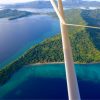French Polynesia Travel Guide
Welcome to the taste2travel French Polynesia Travel Guide!
Date Visited: August 2018 and June 2024
Introduction
From its dazzling, turquoise-blue, lagoons to its emerald-coloured, razor-back, volcanic peaks, French Polynesia is a veritable south Pacific paradise.
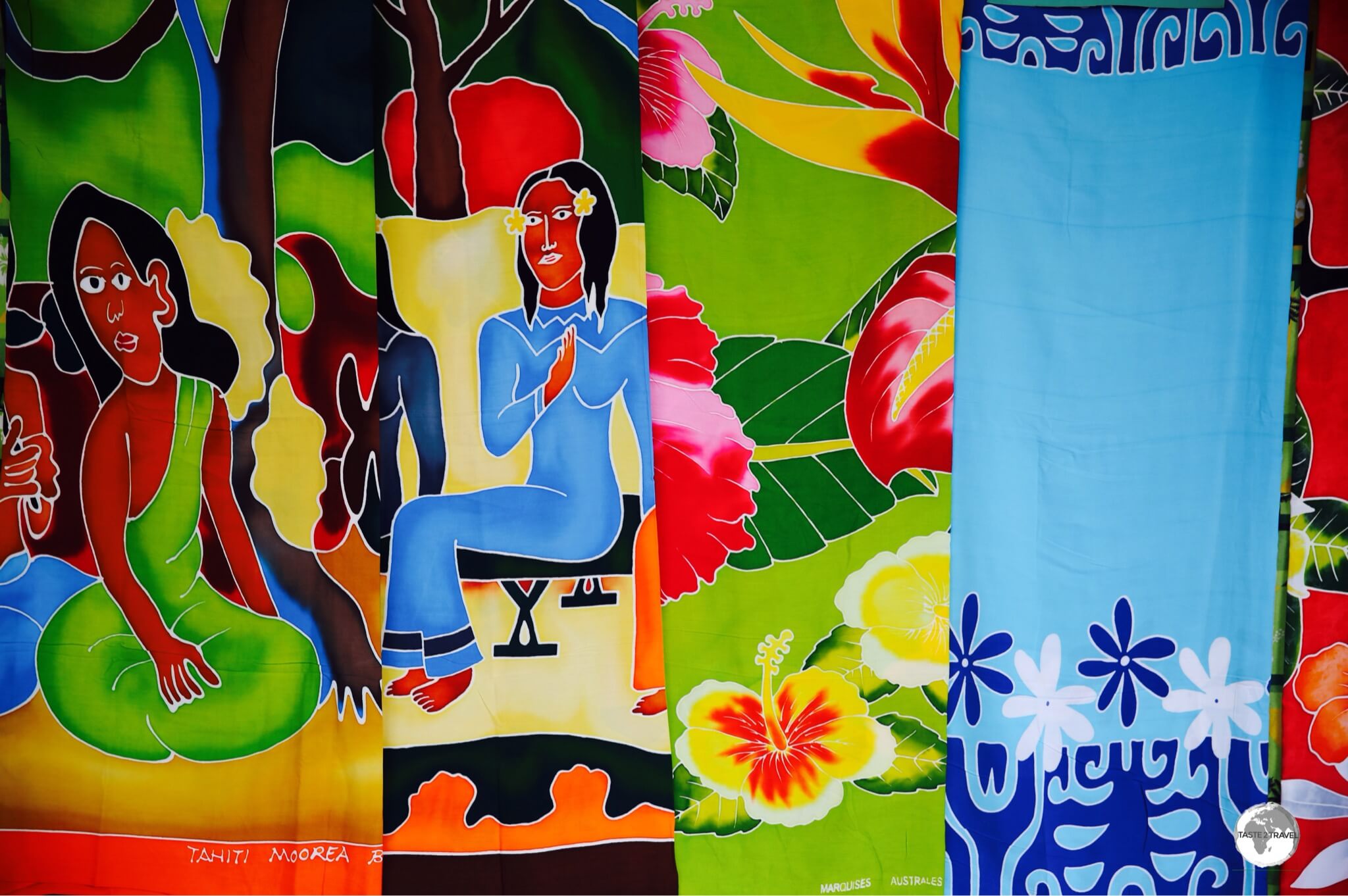
Colourful sarongs on sale at Papeete central market.
For many years, I’d dreamed of travelling to French Polynesia but the cost of flights was always prohibitive.
Then, one day recently, I learned of a little French Bee. In my opinion, the French low-cost carrier, French Bee, is the saviour of tourism in French Polynesia.
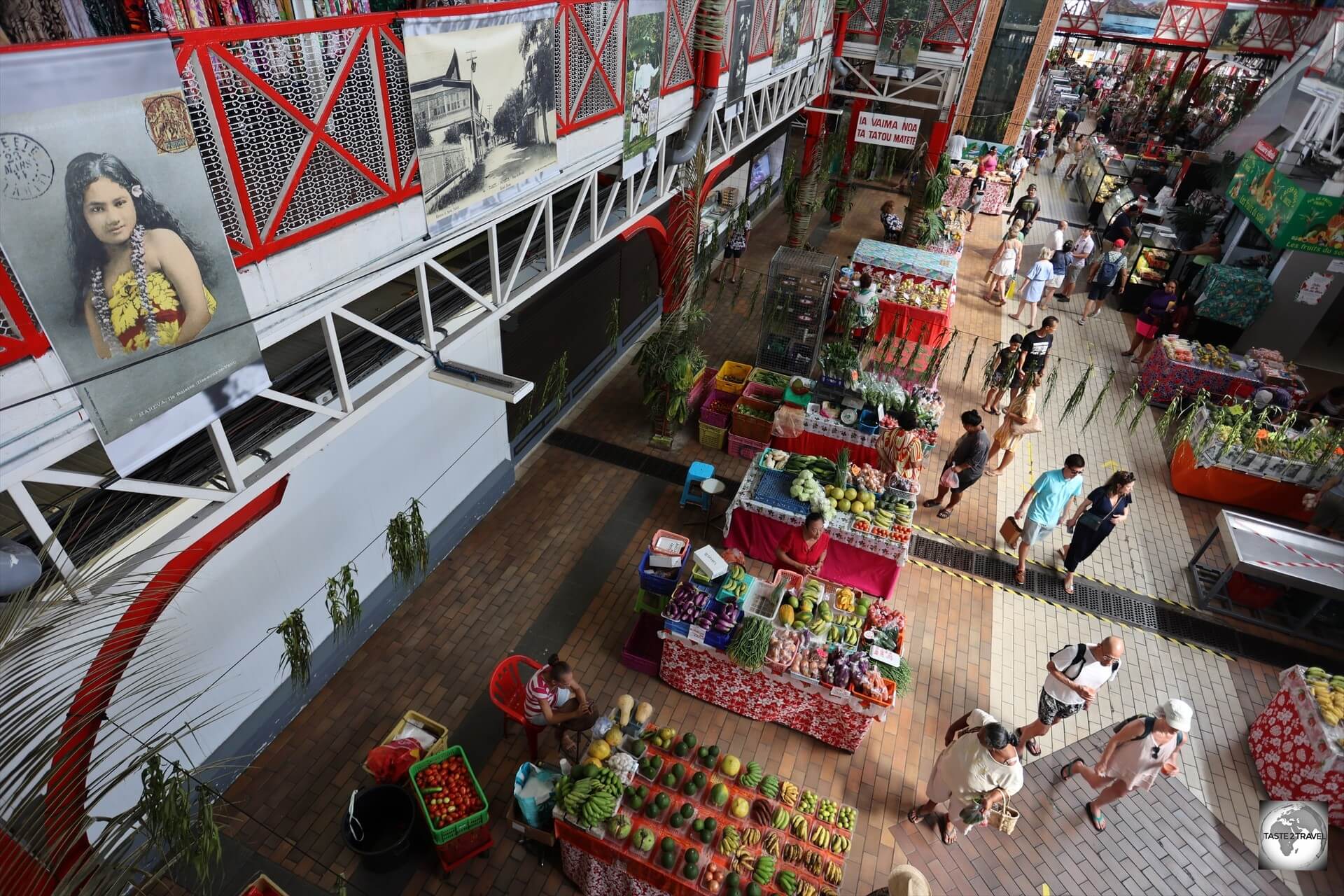
A view of the central market in Papeete, a great place for souvenir shopping.
The airline flies from its base in Paris, to a number of popular holiday destinations around the world, including Tahiti, with flights departing Paris-Orly (with a stopover in San Francisco), every Sunday, Wednesday and Friday.
Refer to the ‘Getting There‘ section below for more details on flights to French Polynesia.
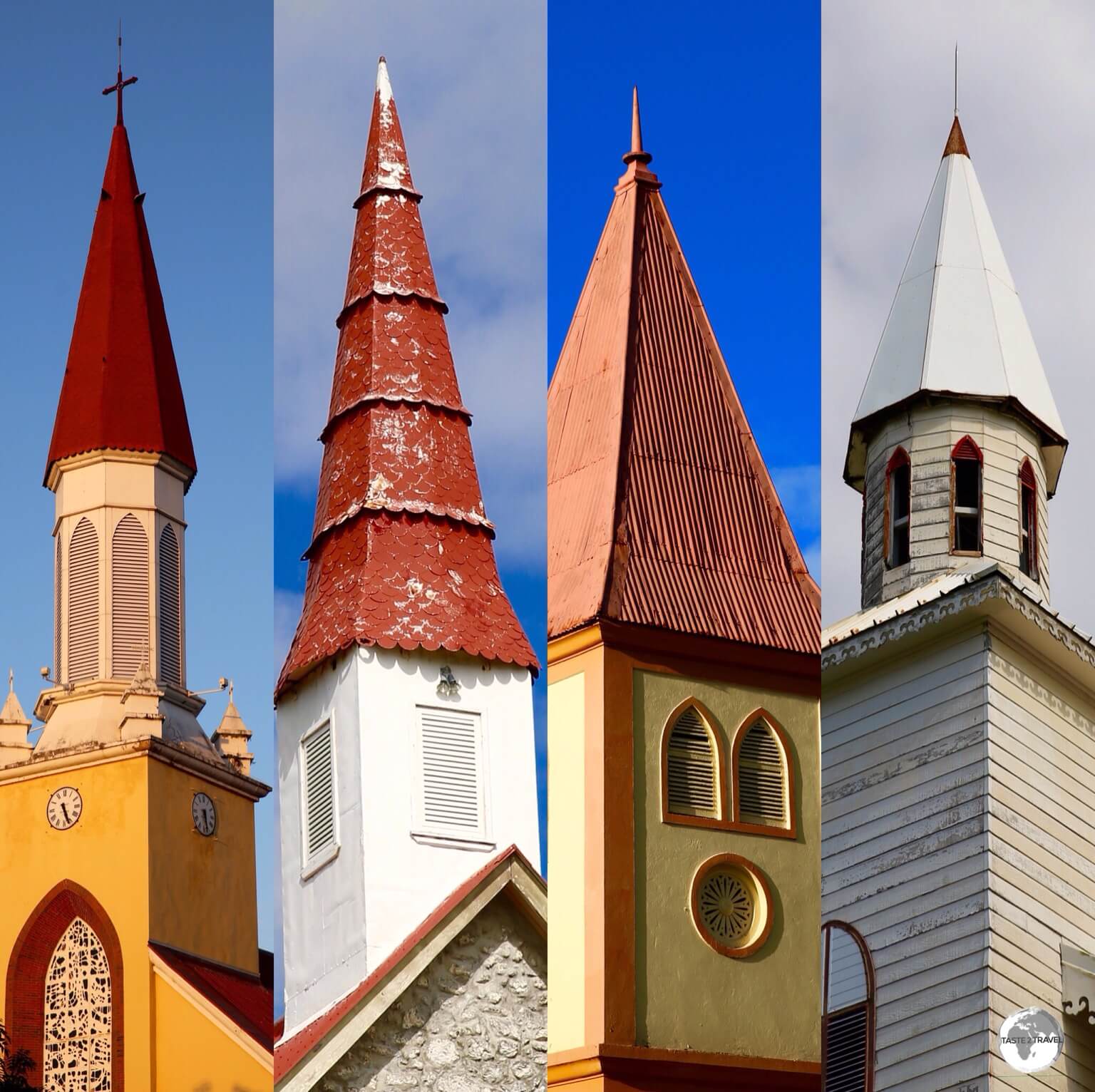
Church steeples on Tahiti.
French Polynesia has never been a cheap destination and while it’s now more affordable to reach, travel costs, once on the ground, are still high.
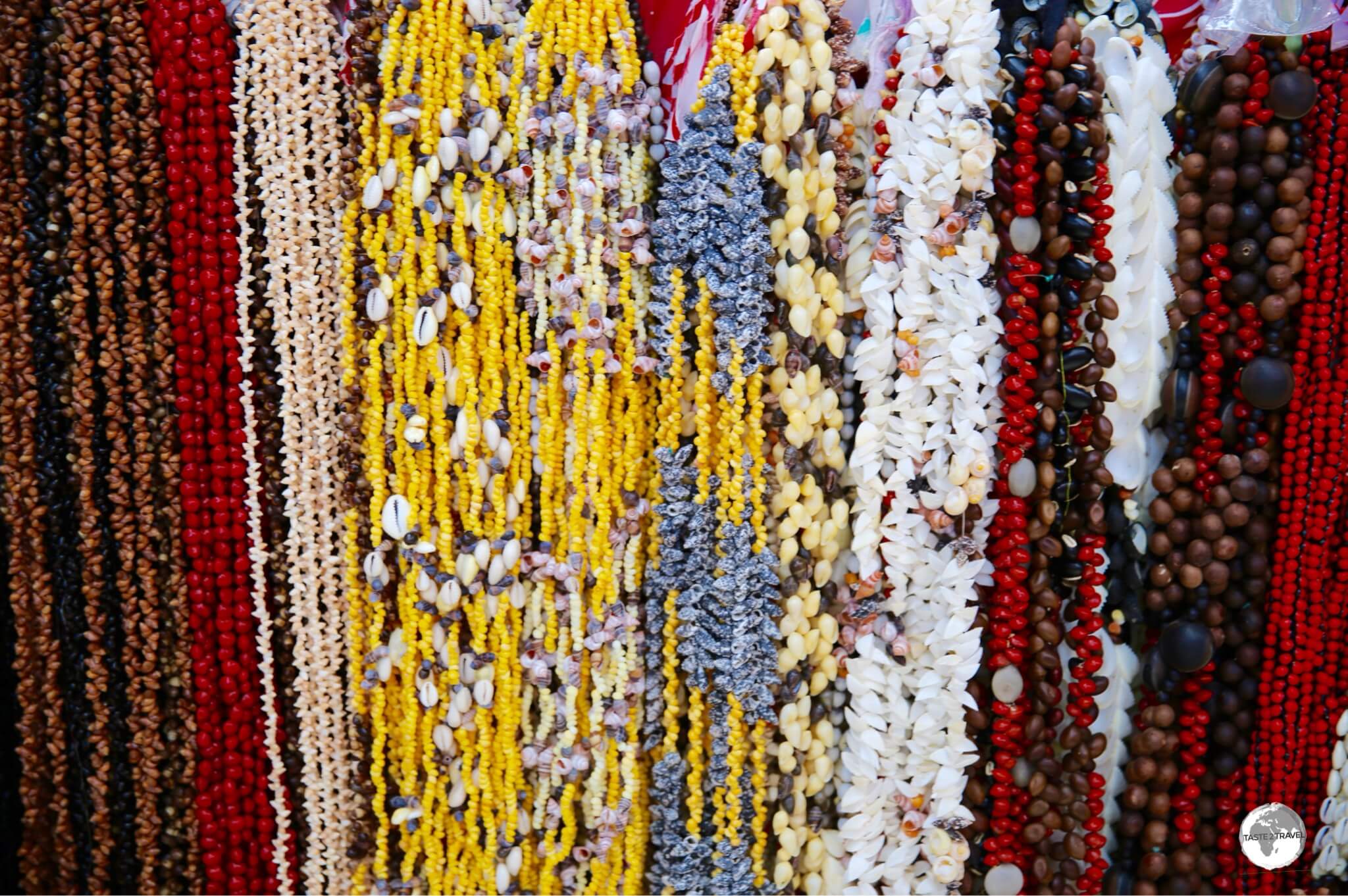
Handmade necklaces for sale at Papeete central market.
While ‘deluxe’ resorts are the mainstay of the tourism industry, there are plenty of smaller lodges and guesthouses which offer affordable accommodation options and the renown, roulottes (mobile food vans), serve up delicious, budget-friendly meals, each evening on the waterfront in the capital – Papeete (pronounced – [PAA] + [PEE] + [AY] + [TEE]).
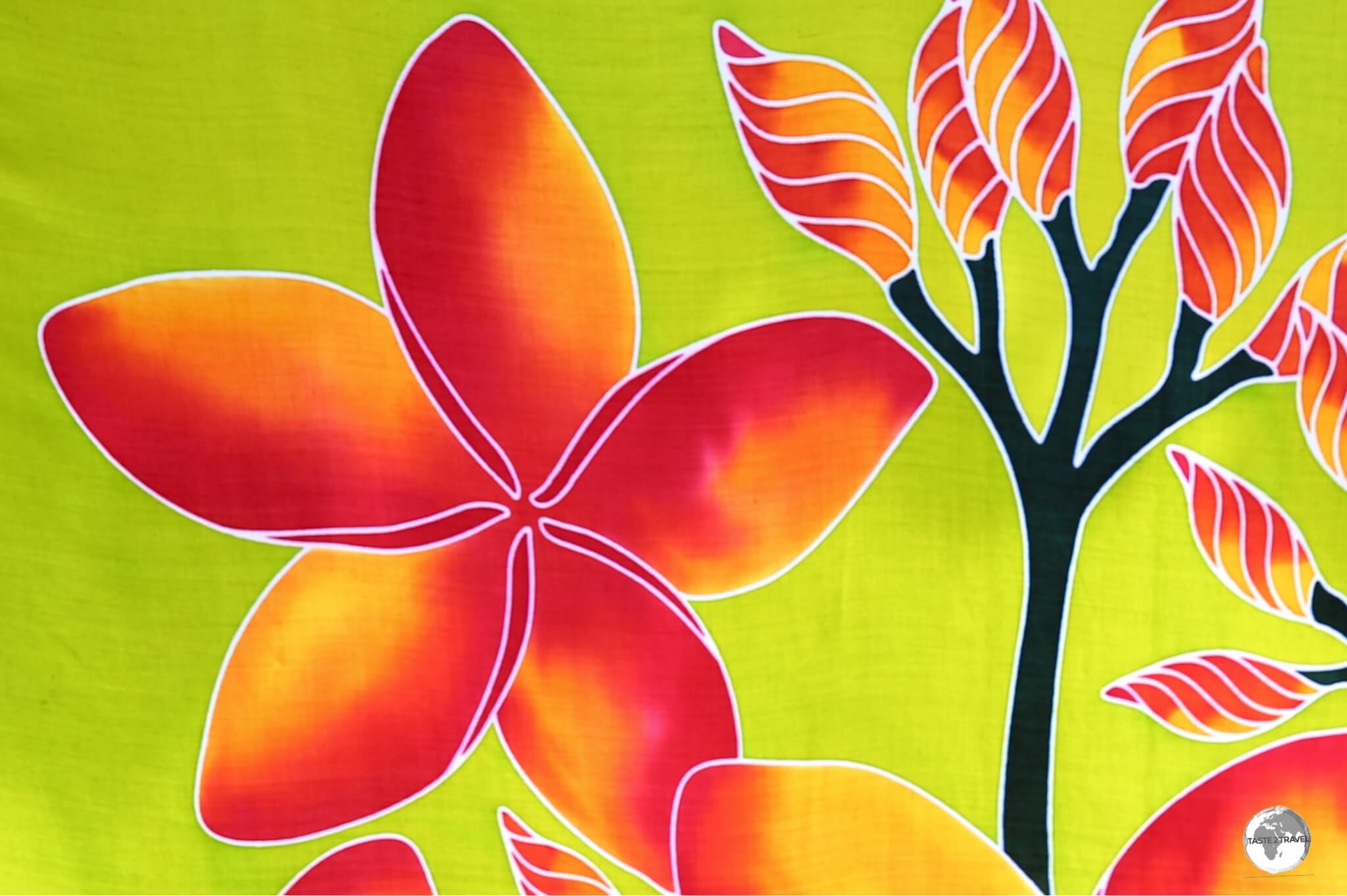
Hand-painted Batik on sale at Papeete Central market.
You could spend months exploring the 4,000 square kilometres of this vast territory, one which contains five separate archipelagos.
I have visited French Polynesia two times.
During my first visit in August 2018, I explored the main island of Tahiti and neighbouring Moorea.
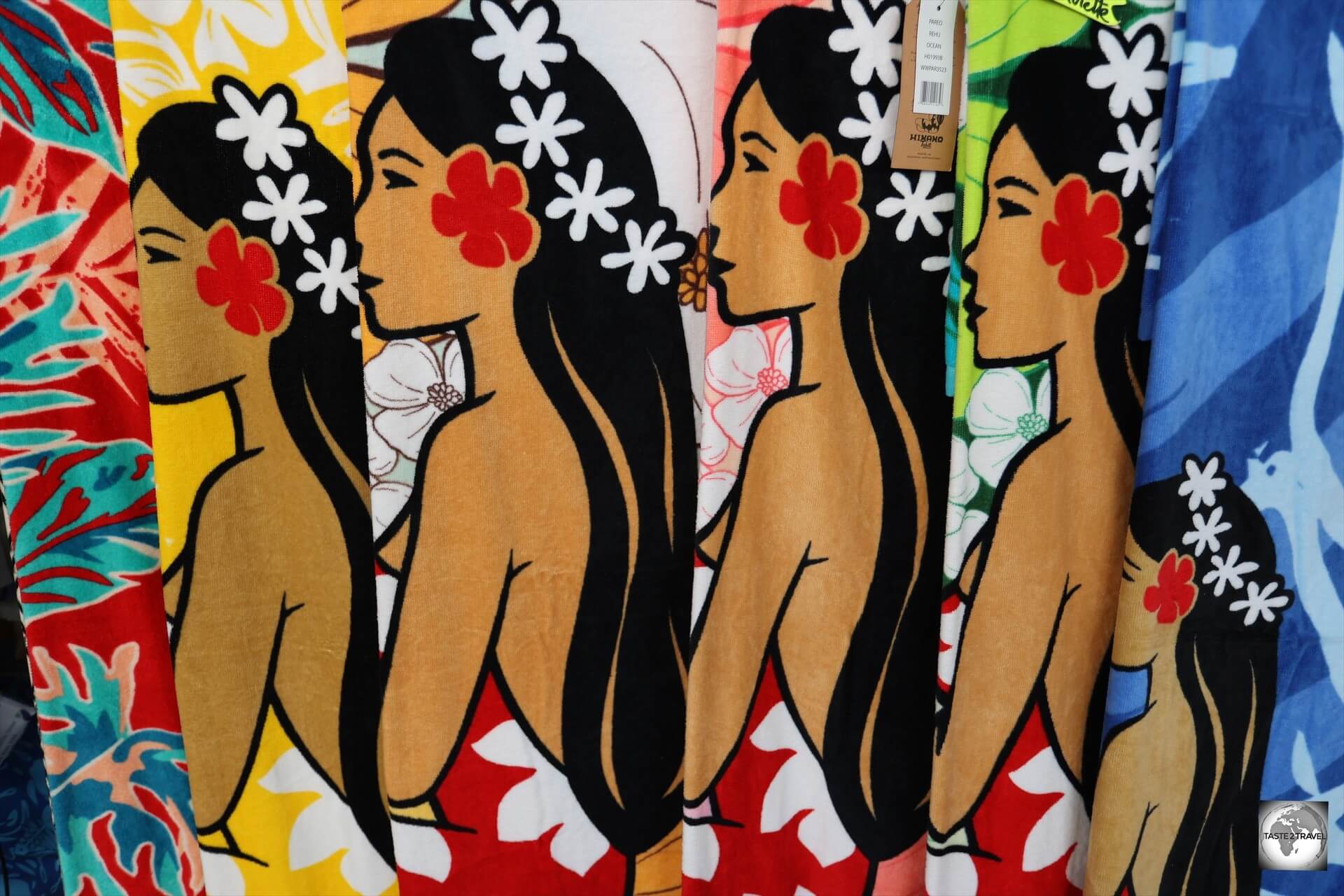
Welcome to Tahiti and French Polynesia!
On my 2nd visit in June 2024, I explored the remote Gambier Islands, while en-route to the even remoter Pitcairn Island.
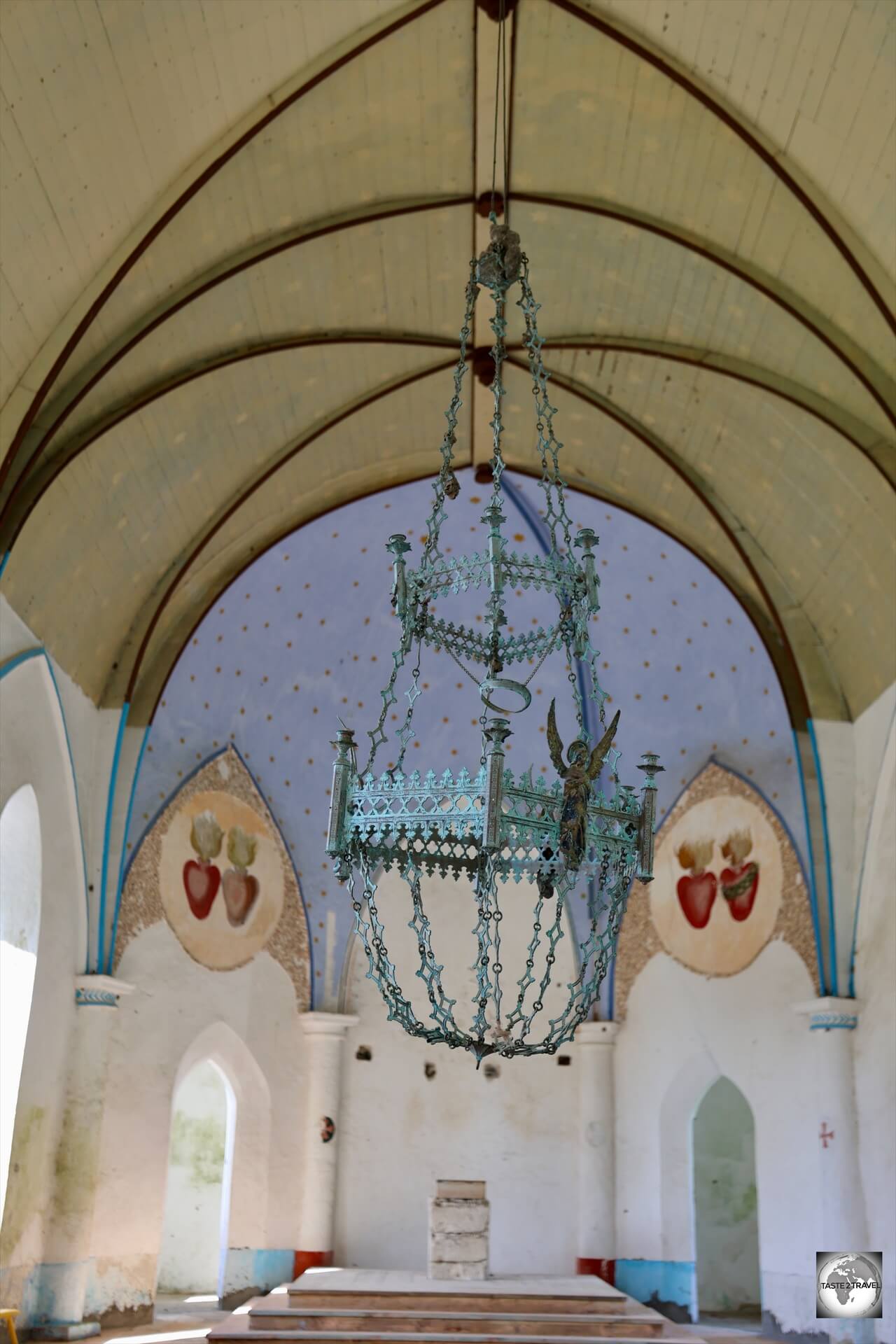
The Church of Saint-Gabriel, one of many historic churches on the remote Gambier Islands.
All of these destinations are covered in this French Polynesia Travel Guide.
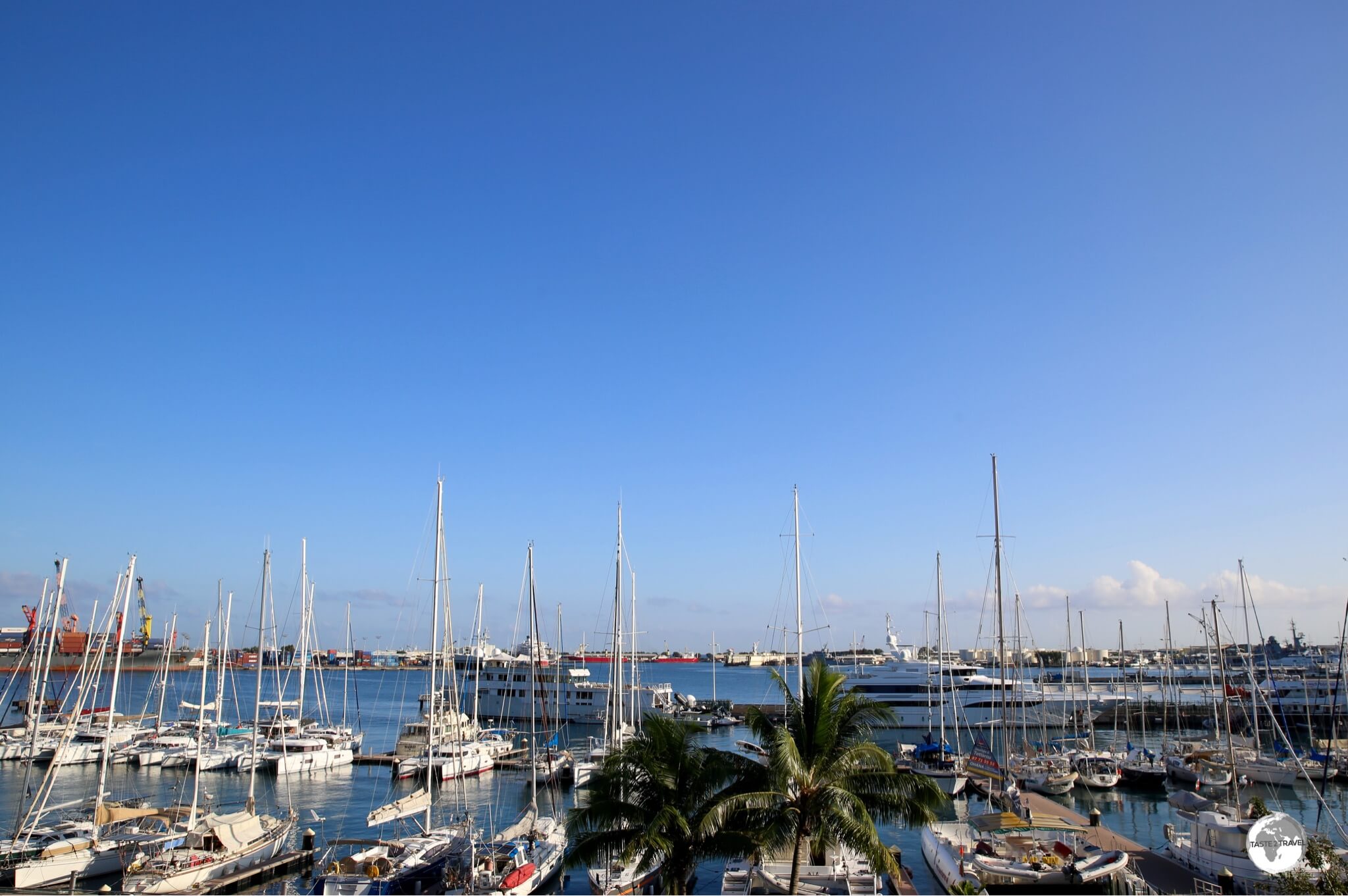
A view of Papeete harbour, the capital of French Polynesia.
I enjoyed my time French Polynesia and look forward to returning one day to explore the other archipelagos.
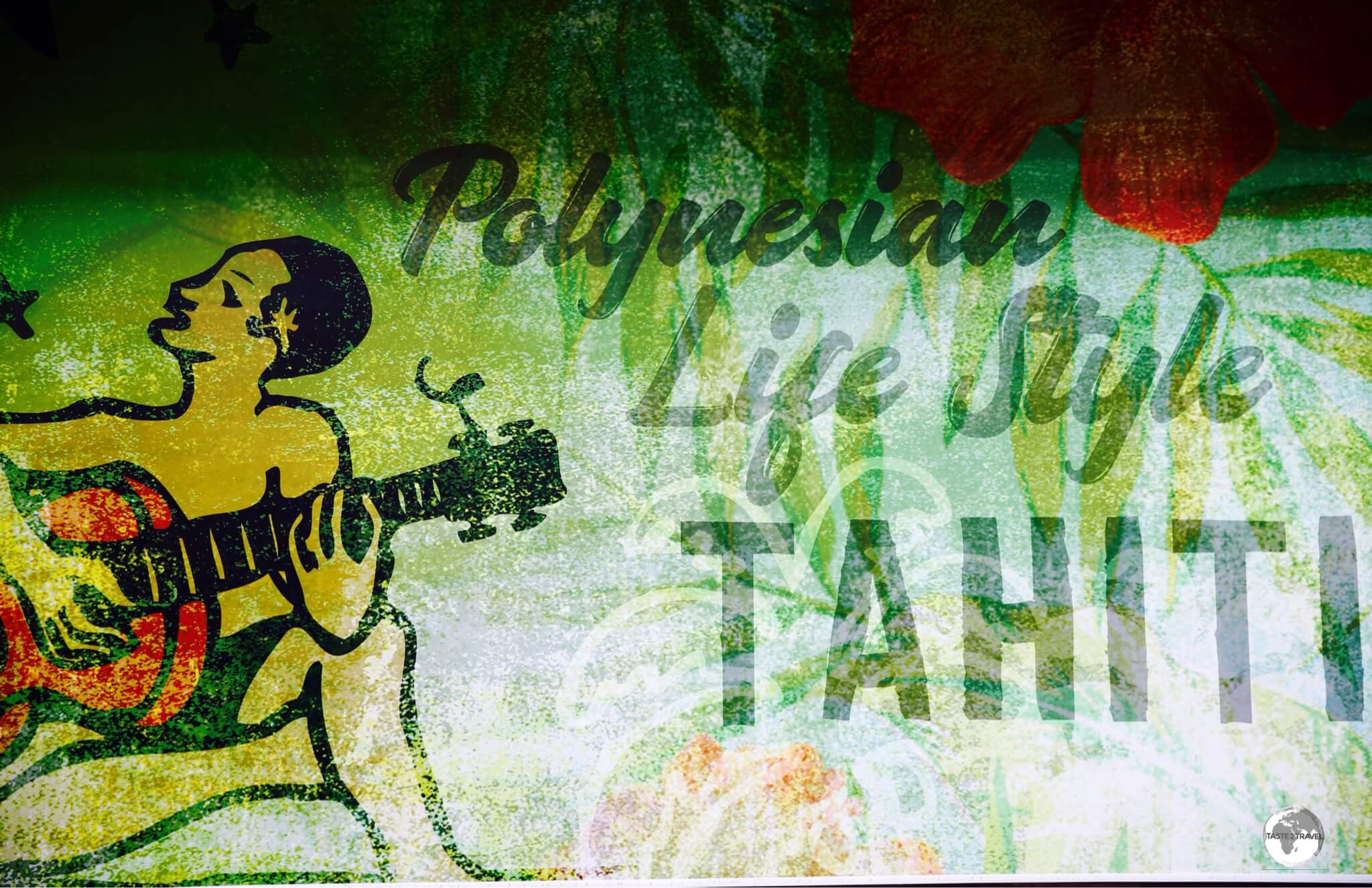
Street art in Papeete.
Location
Papeete 98714, French Polynesia
French Polynesia is located in the South Pacific, almost halfway between Australia (6,000 km to the west) and South America (7,500 km to the east).
Other nearby Pacific Island nations include (click the links to view my travel guides) American Samoa; 2,469 km (1,534 mi) to the northwest, Tonga; 2,733 km (1,698 mi) to the west, Tuvalu; 3,535 km (2,196 mi) to the northwest, New Caledonia; 4,717 km (2,931 mi) to the west and Pitcairn Island; 2,330 km (1,447 mi) to the south-east.
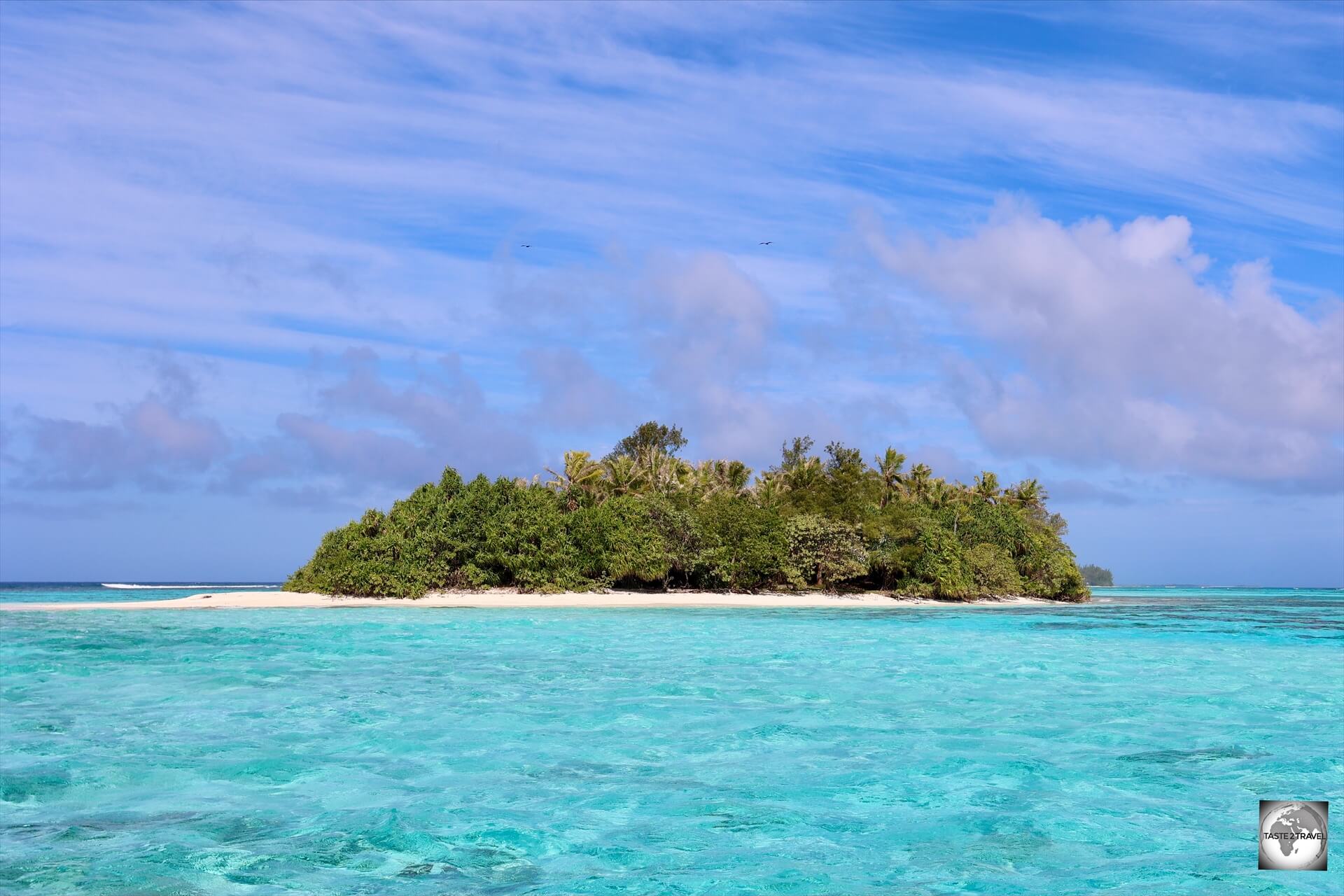
Bird Island, one of many islands in the Gambier Islands archipelago.
French Polynesia is comprised of 118 islands, of which 67 are inhabited.
The territory is divided into the Austral, Gambier, Marquesas, Society (home to the main island of Tahiti) and Tuamotu archipelagos, covering more than 4,000 square kilometres of Pacific Ocean – about the size of Europe!
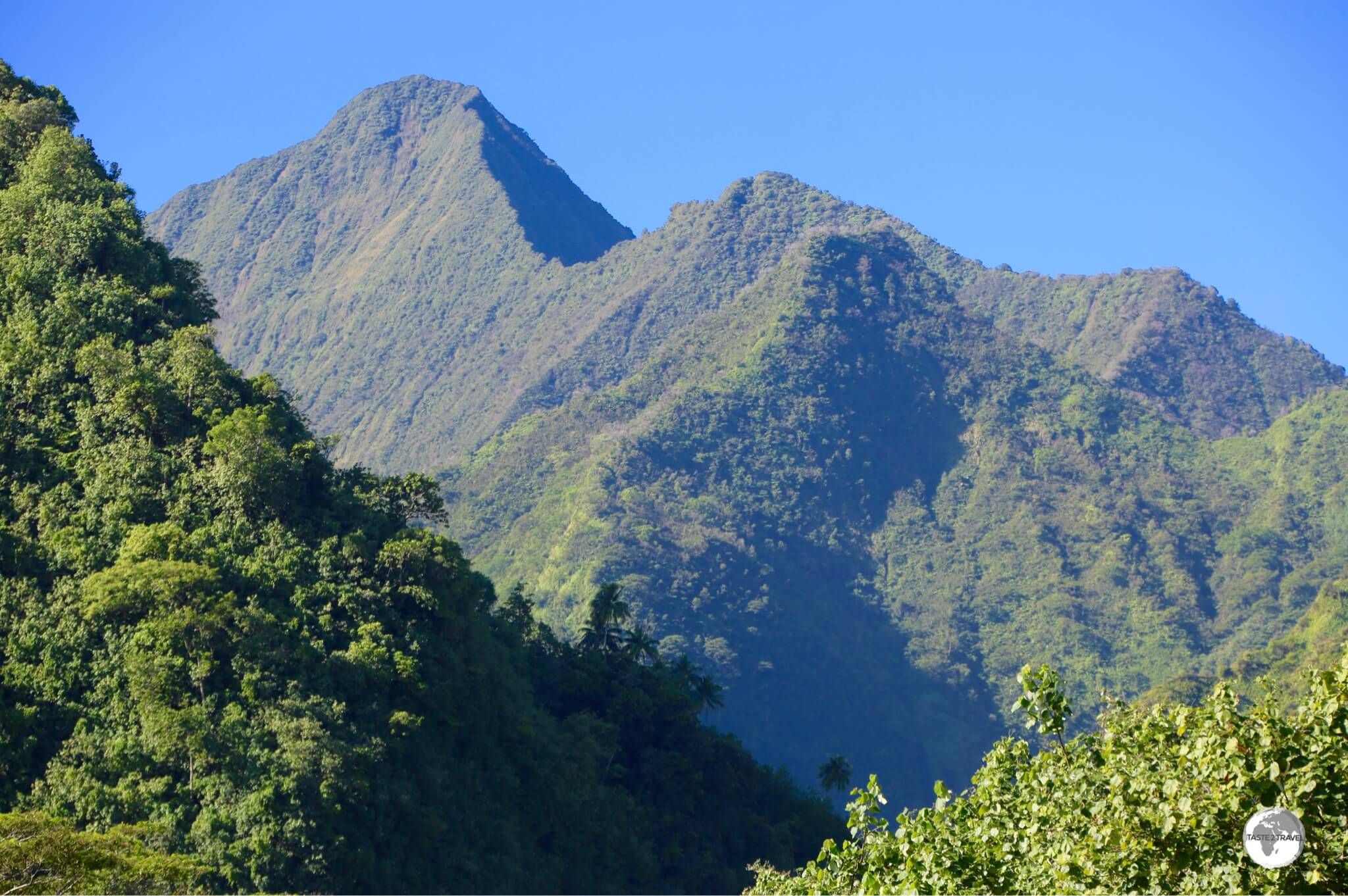
The many islands of French Polynesia are volcanic in origin, including the main island of Tahiti Nui.
People
Polynesian Settlers
The original settlers to French Polynesia were Polynesian peoples who first migrated from Southeast Asia and Taiwan into present-day Polynesia.
It’s believed the original ancestors of the Polynesians left Taiwan 3,000 years ago, stepping from island to island across the Pacific, eventually reaching Easter Island around 700-800 AD.

A map showing the three distinct cultural regions of the Pacific.
Source: Wikipedia.
These Polynesian explorers first reached the Marquesas Islands in about 200 BC, later ventured southwest, discovering the Society Islands around AD 300.
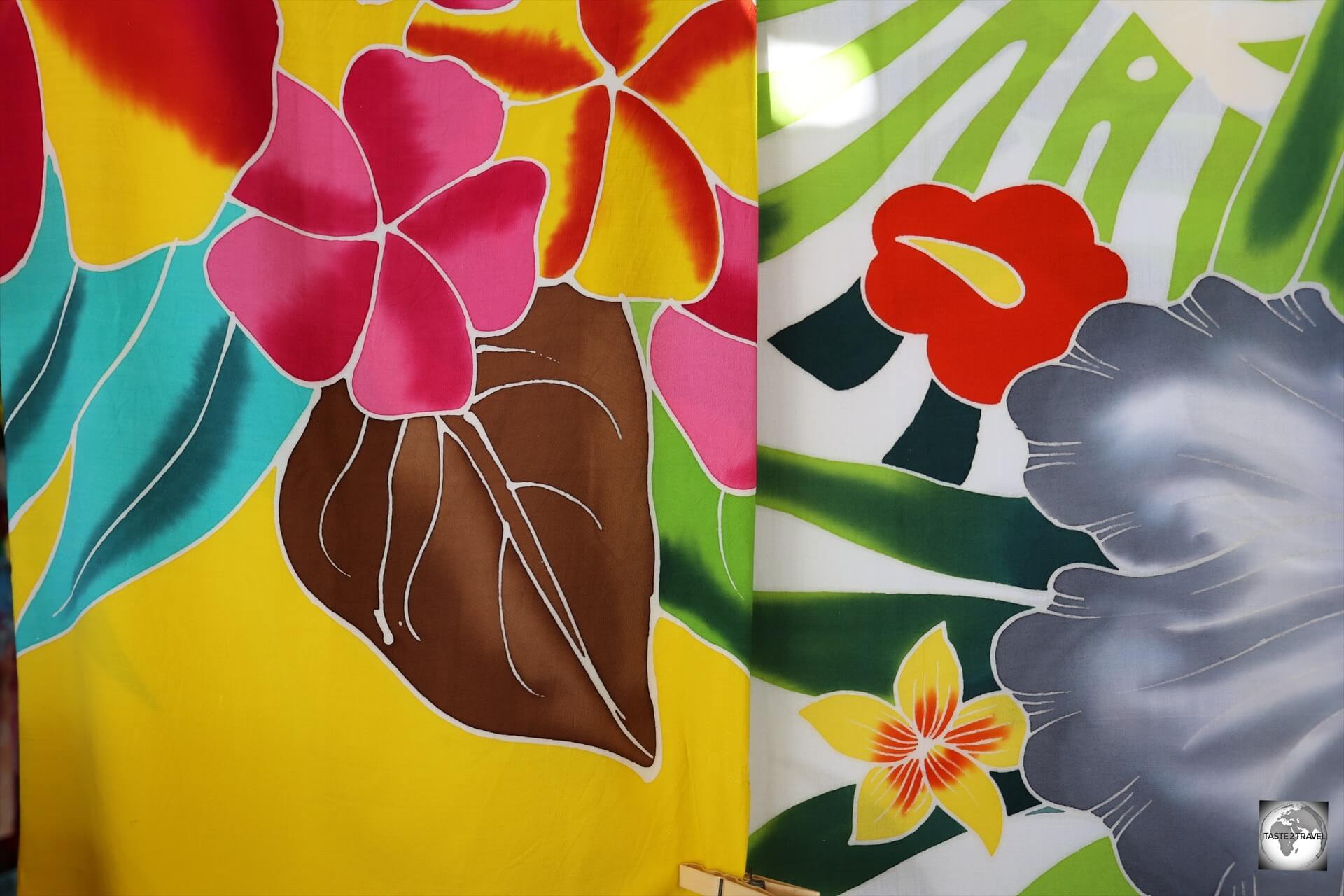
Colourful sarongs for sale in Papeete central market.
They are one of three distinct cultural groups in the Pacific Ocean, the other two being Micronesians and Melanesians.
Following are a list of travel guides I have written for each of these three regions:
Melanesia
Micronesia
Polynesia
Population
The 283,000 inhabitants of French Polynesia are mostly (82%) Polynesian with the remainder of the population composed of European (i.e. French) and Asian immigrants.
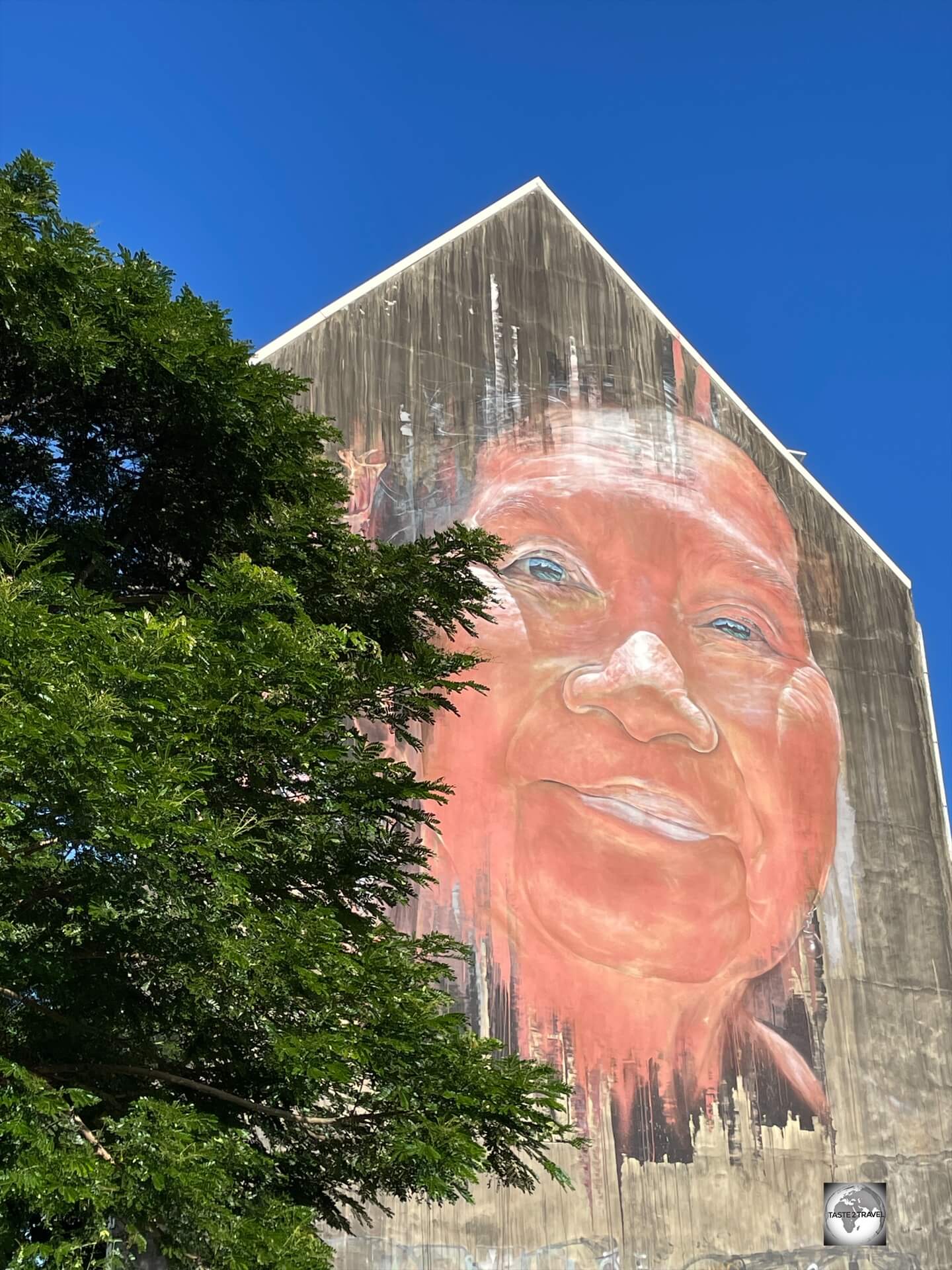
Street art in Papeete.
According to the last census, 68.5% of the population lived on the main island of Tahiti with 50% of the territory’s population living in Papeete.

The buildings of the capital Papeete, feature street art which depict the local Tahitians.
Currency & Costs
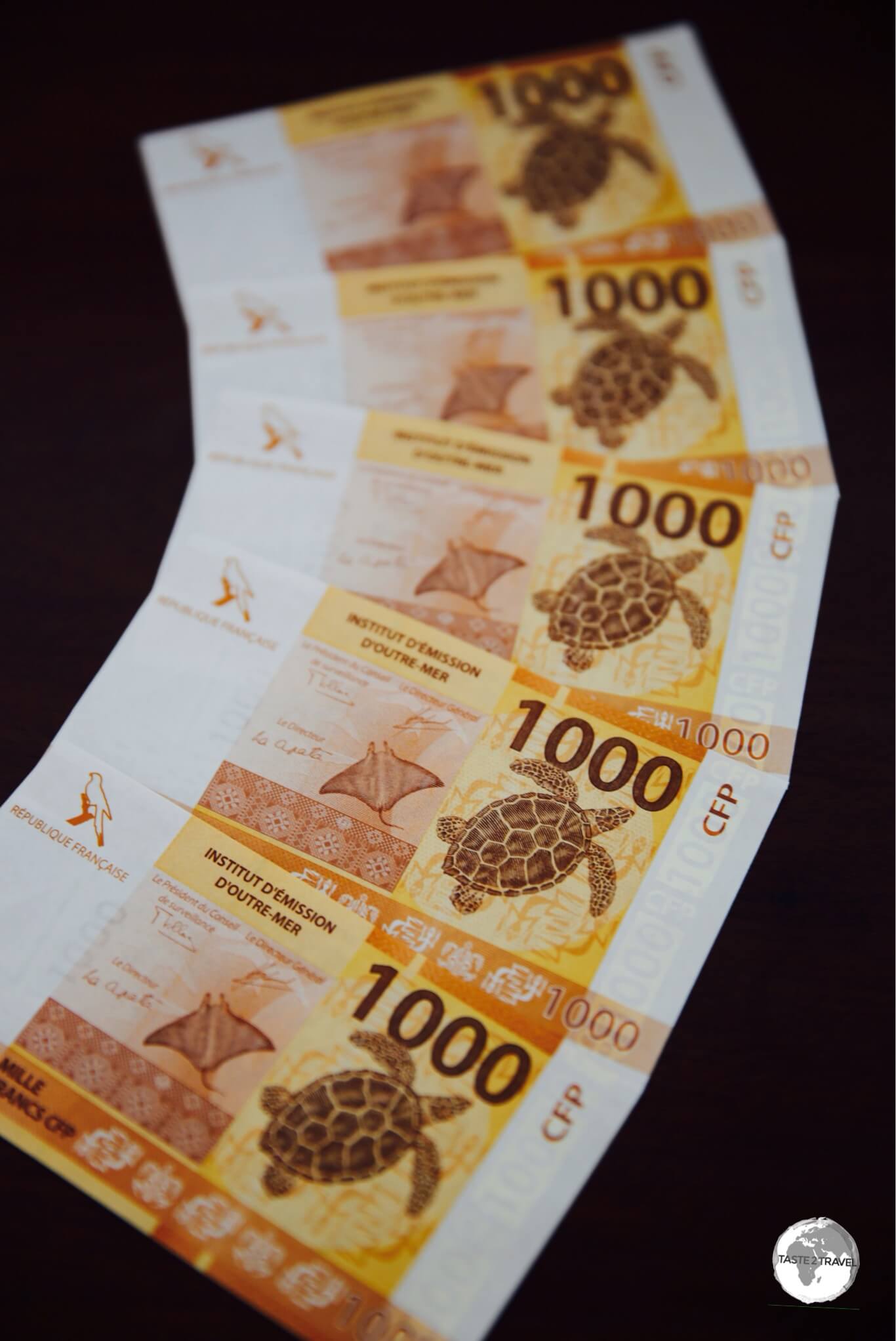
The Pacific Franc.
Currency
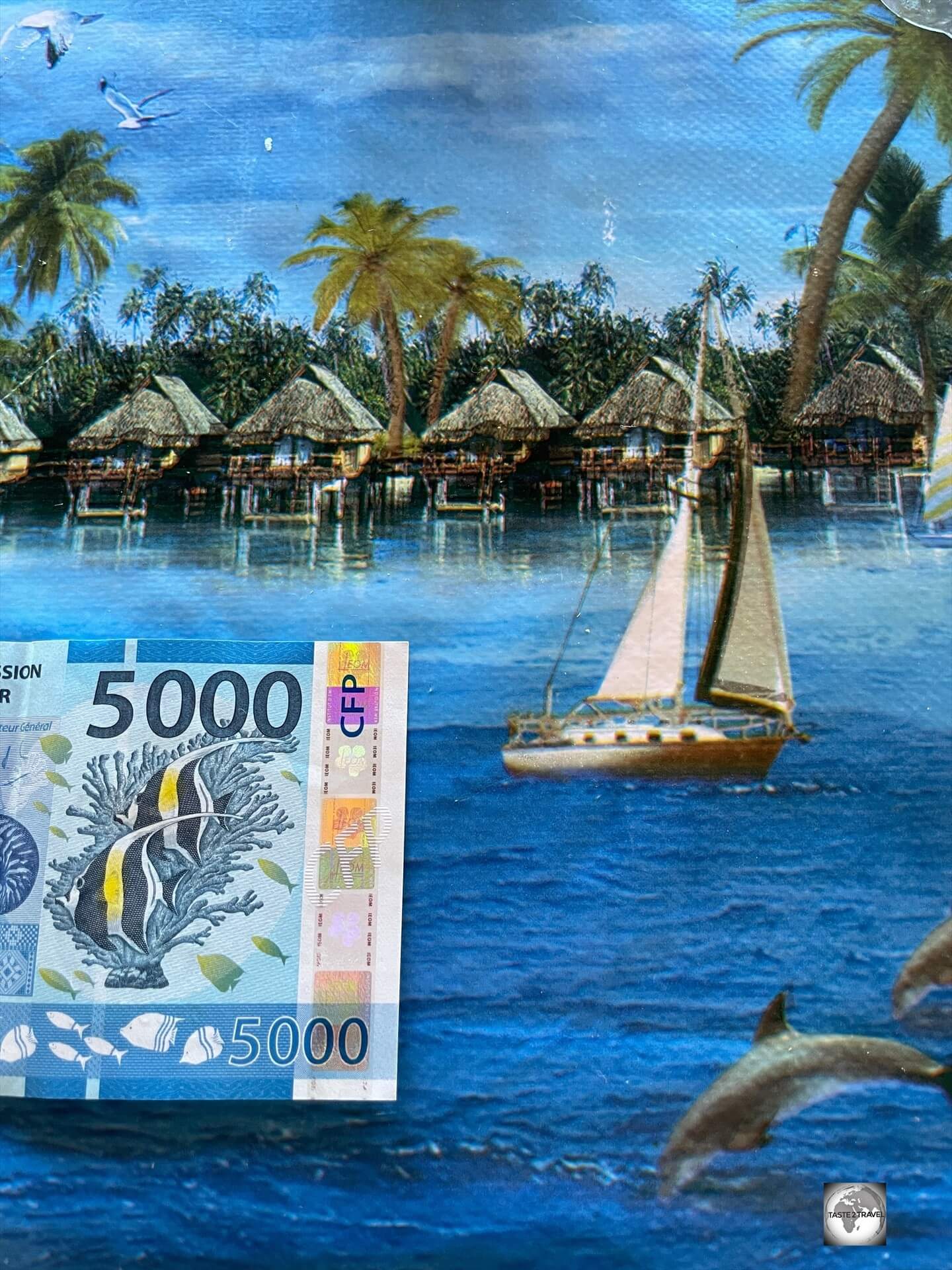
The Pacific Franc (CFP) is the currency of French Polynesia.
The unit of currency in French Polynesia is the cours de franc Pacifique (CFP), which is referred to as the ‘Pacific franc’.
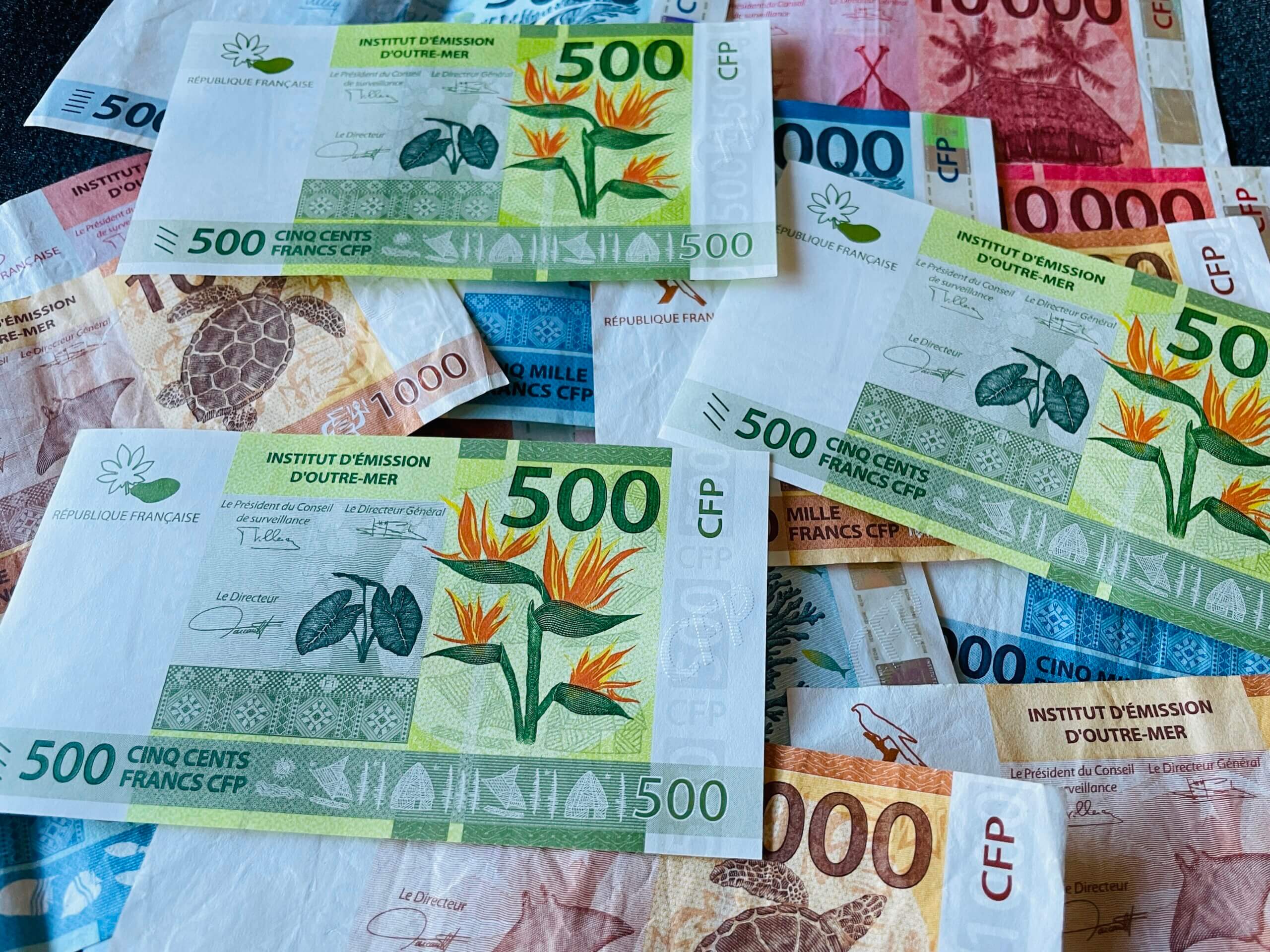
The unit of currency French Polynesia is the Pacific franc.
Financial institutions abbreviate the currency “XPF“, but in this report I use ‘CFP’.
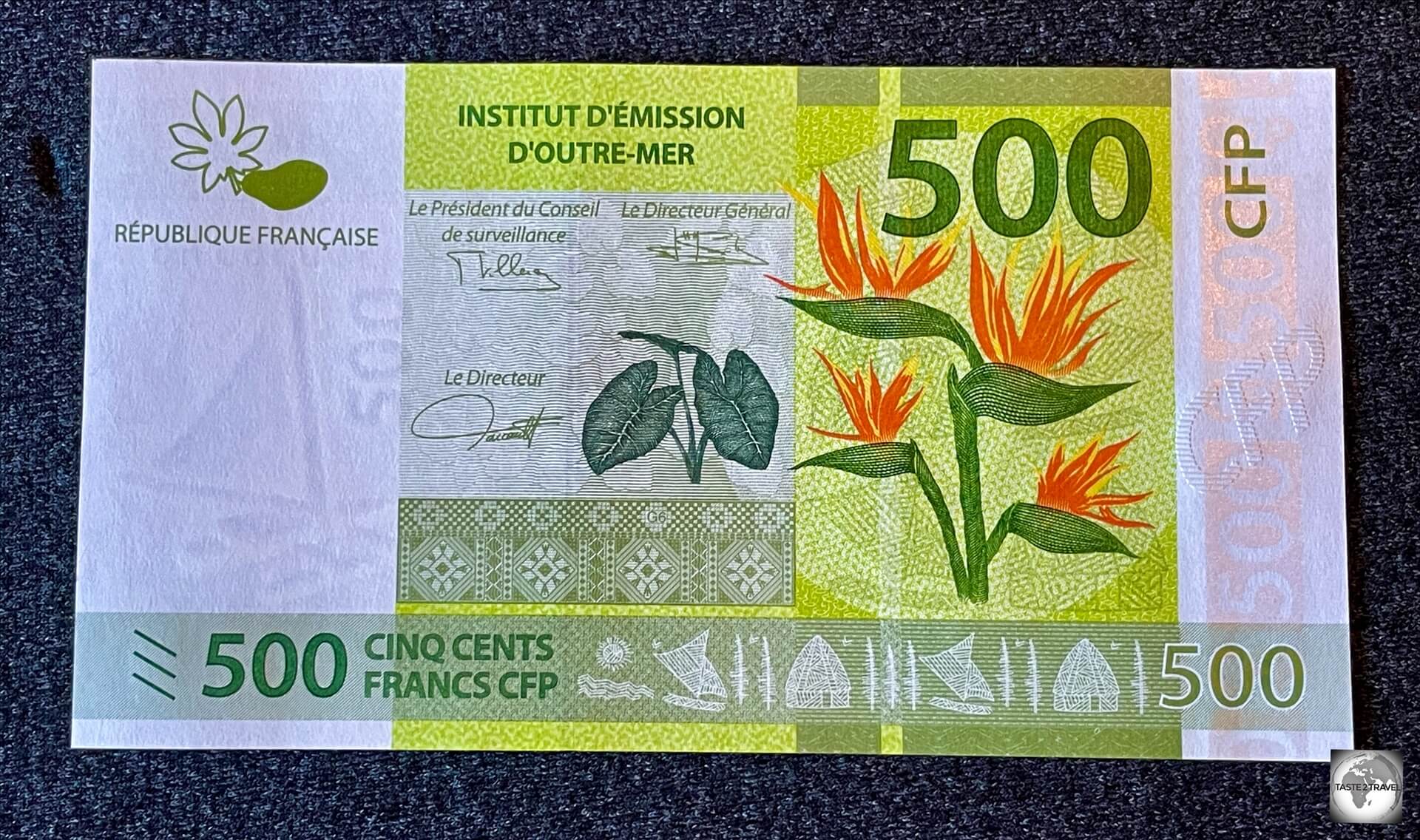
The 500-franc banknote is the lowest value note – equivalent to
US$5/ EUR 5.
The same currency is used in the other French Pacific territories of New Caledonia and Wallis and Futuna.
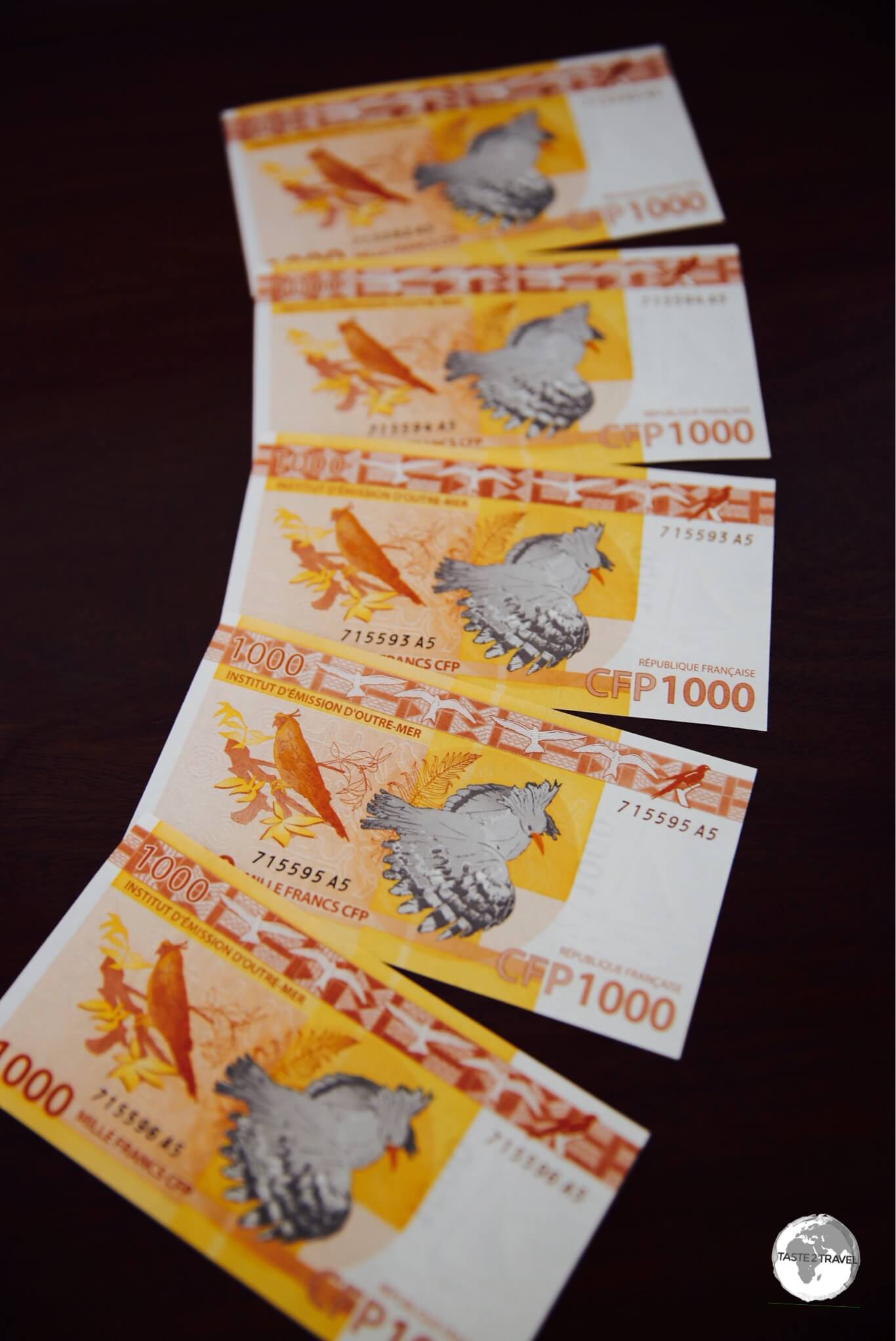
The Pacific Franc.
Exchange Rates
The franc is pegged to the euro at a rate of 1 Euro = 119.33 CFP.
- $1USD = 110.28 CFP
- $100USD = 11,000.28 CFP
Costs
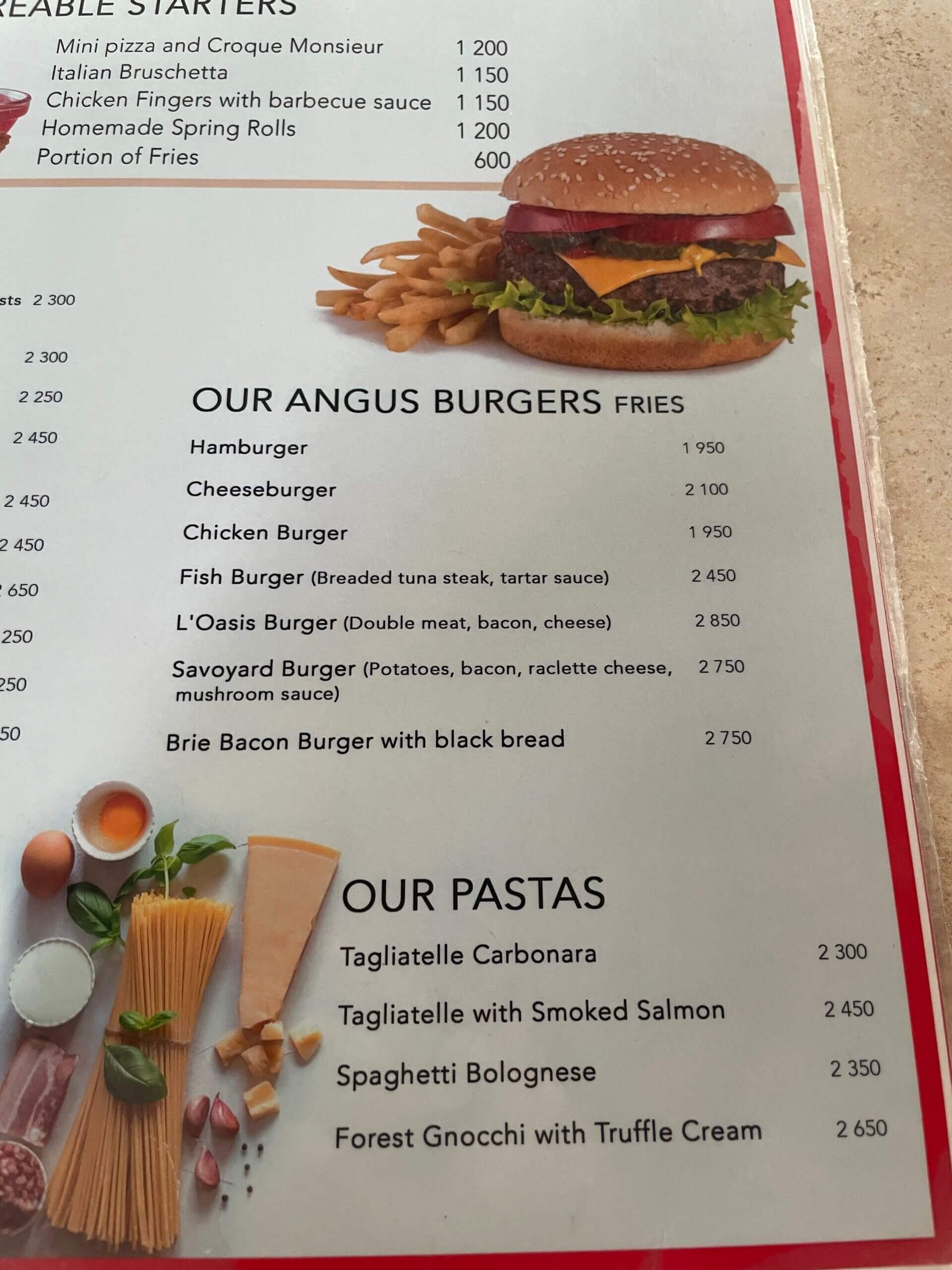
Menu prices at the Urban Café in Papeete.
Not cheap!
I met few budget travelers in French Polynesia and for good reason – travel costs are very expensive.
To really enjoy the territory, you’ll need a hefty travel budget.
Sample travel costs:
- Room in a hostel: 7,000 CFP (USD$67)
- Room in a Papeete apartment: USD$100
- Room at the top-end Hilton Moorea Resort: 42,000 CFP (USD$400)
- Entrée in a tourist restaurant: 1,800 CFP (USD$17)
- Main course in a tourist restaurant: 2,800 + CFP (USD$27)
- A pint (.5 L) of local beer: 900 CFP (USD$8.60)
- A can of Coca Cola (.33 L): 475 CFP (USD$4.50)
- Water (.33 L): 325 CFP (USD$3.10)
- Cappuccino: 550 CFP (USD$5.26)
- A combo meal at McDonald’s: 1,450 CFP (USD$14)
Flag
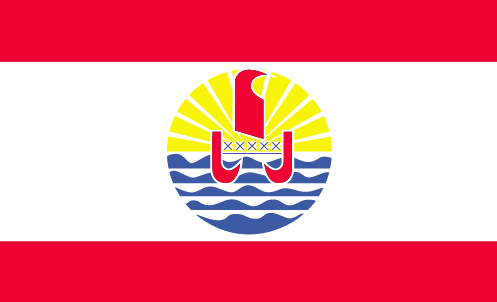
The flag of French Polynesia.
First adopted in 1984, the flag of French Polynesia consists of two horizontal red bands which surround a wider white band – the two colours being traditional Polynesian colours.
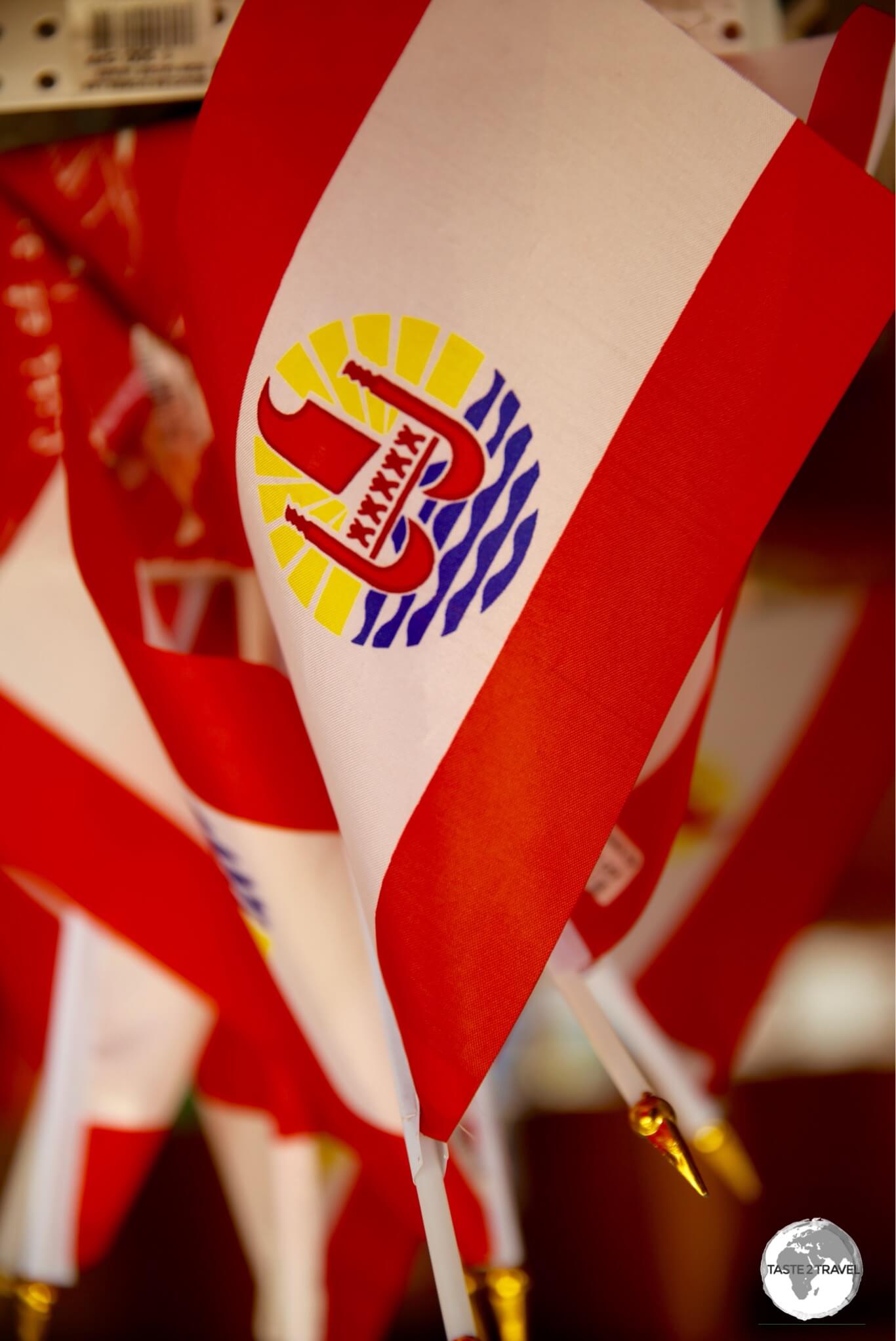
Souvenir flags of French Polynesia on sale in Papeete.
In the centre is a disk with a blue and white wave pattern depicting the sea on the lower half and a gold and white ray pattern depicting the sun on the upper half.
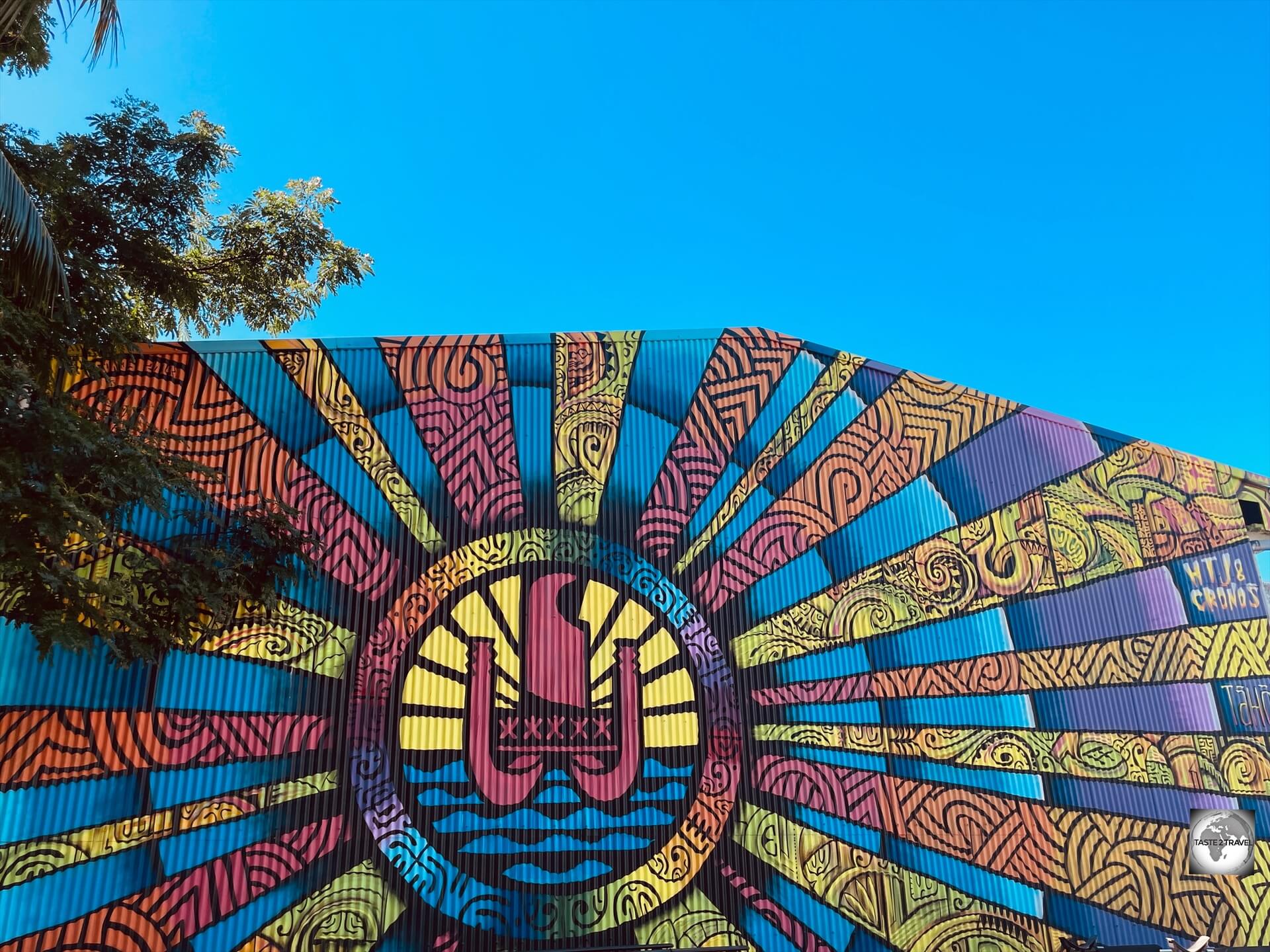
A Polynesian canoe, featured as street art in Papeete.
A Polynesian canoe (piroque) rides on the wave pattern; the canoe has a crew of five, represented by five stars, that symbolise the five island groups (Austral, Gambier, Marquesas, Society and Tuamotu) of French Polynesia.
Philately
Postal services in French Polynesia are provided by the Office des Postes et Télécommunications (OPT), who produce colourful local stamps featuring the fauna, flora, culture (and pretty girls) of the territory.
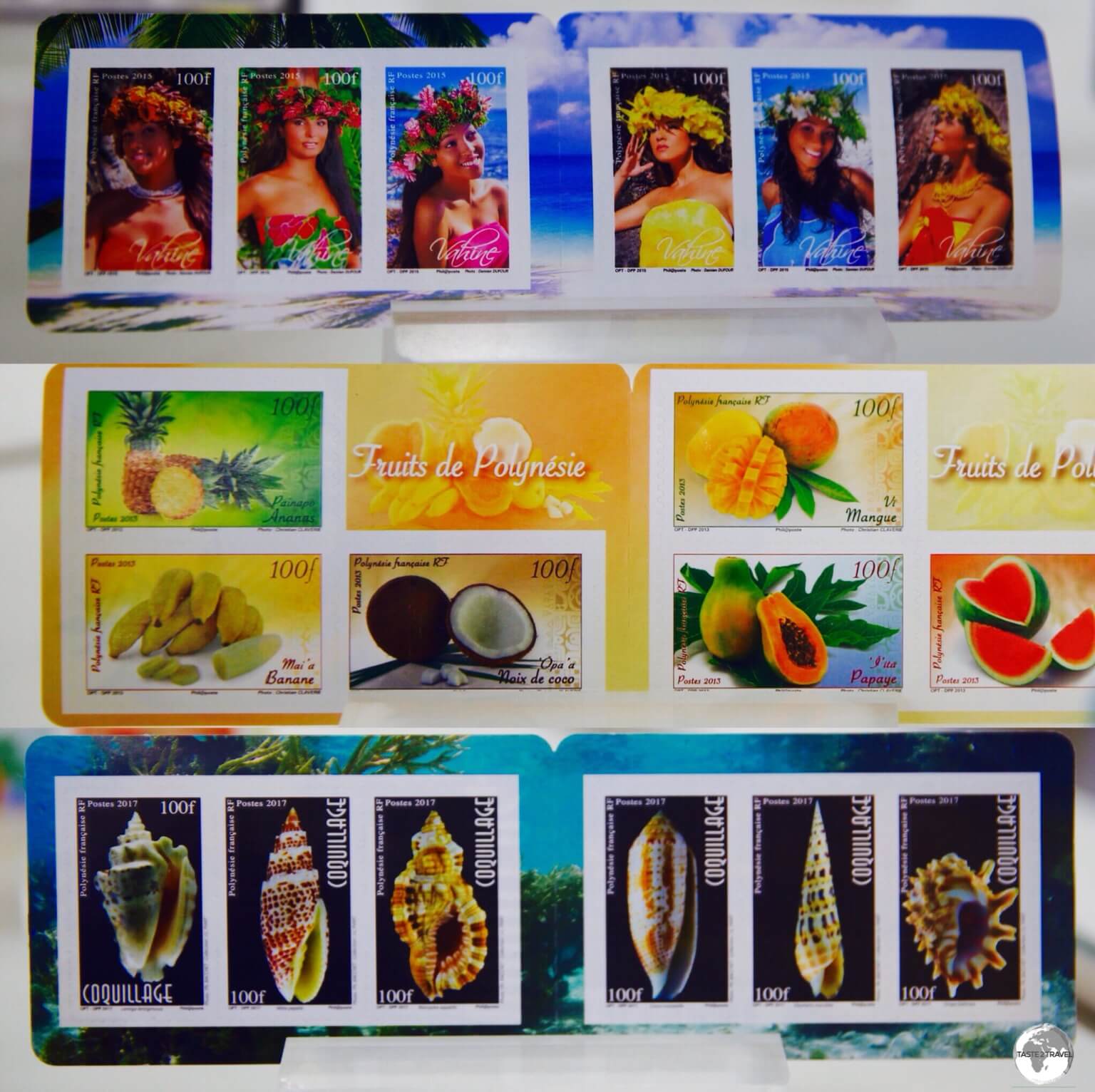
The colourful stamps of French Polynesia feature local culture, fauna and flora.
Stamps can be purchased from the philatelic department of the main post office (OPT) in Papeete or online from the Tahiti Philately website.
SIM Cards
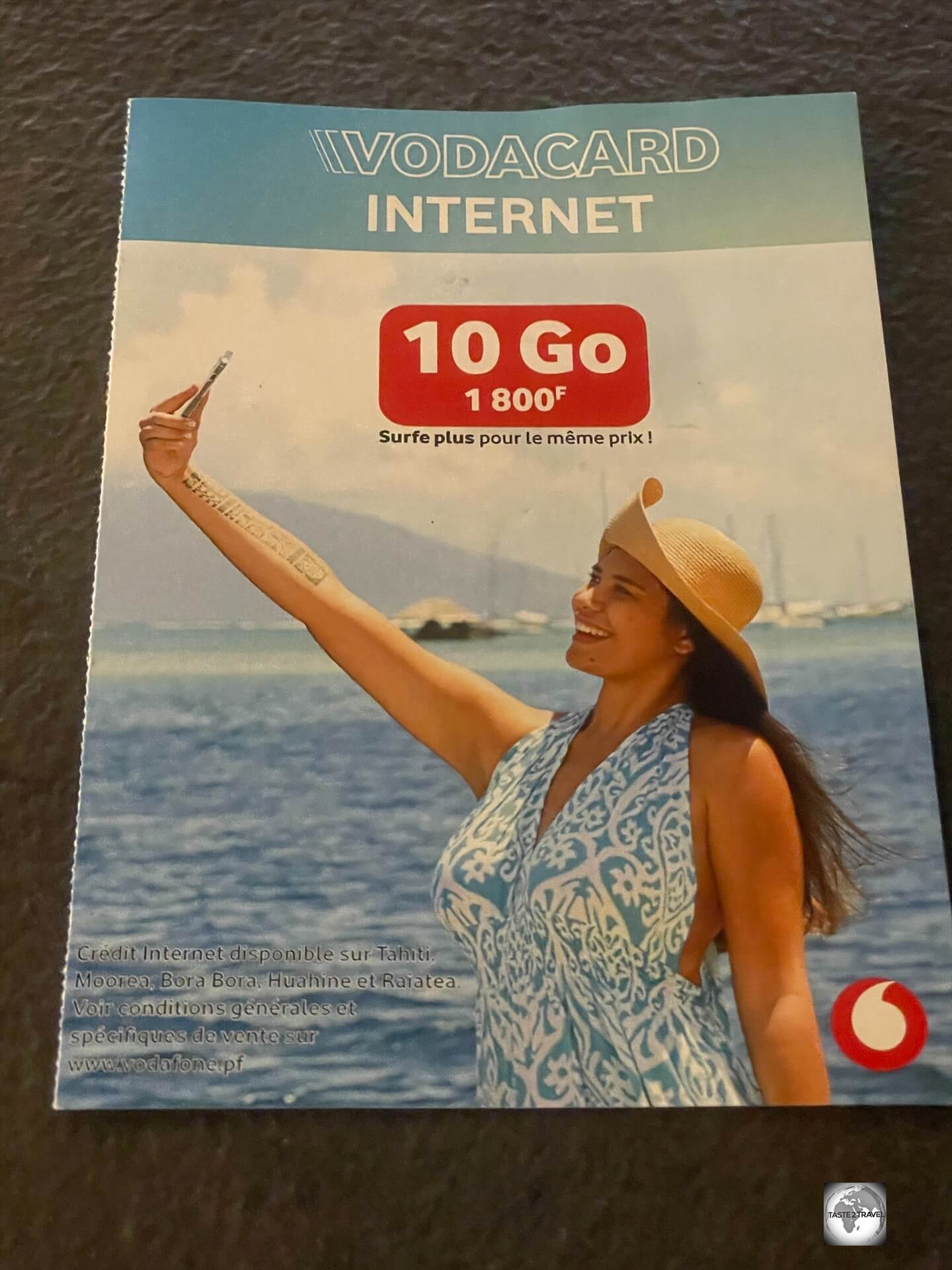
A 10Gb Vodaphone SIM card can be purchased at the airport for 1,800 francs.
Local network connectivity is a must in French Polynesia, especially if you’ll be driving a rental car and using navigation.
The best deal is offered by Vodaphone who sell a 10Gb SIM card outside the arrivals area at Papeete International Airport, for 1,800 CFP.
Sightseeing
Tahiti
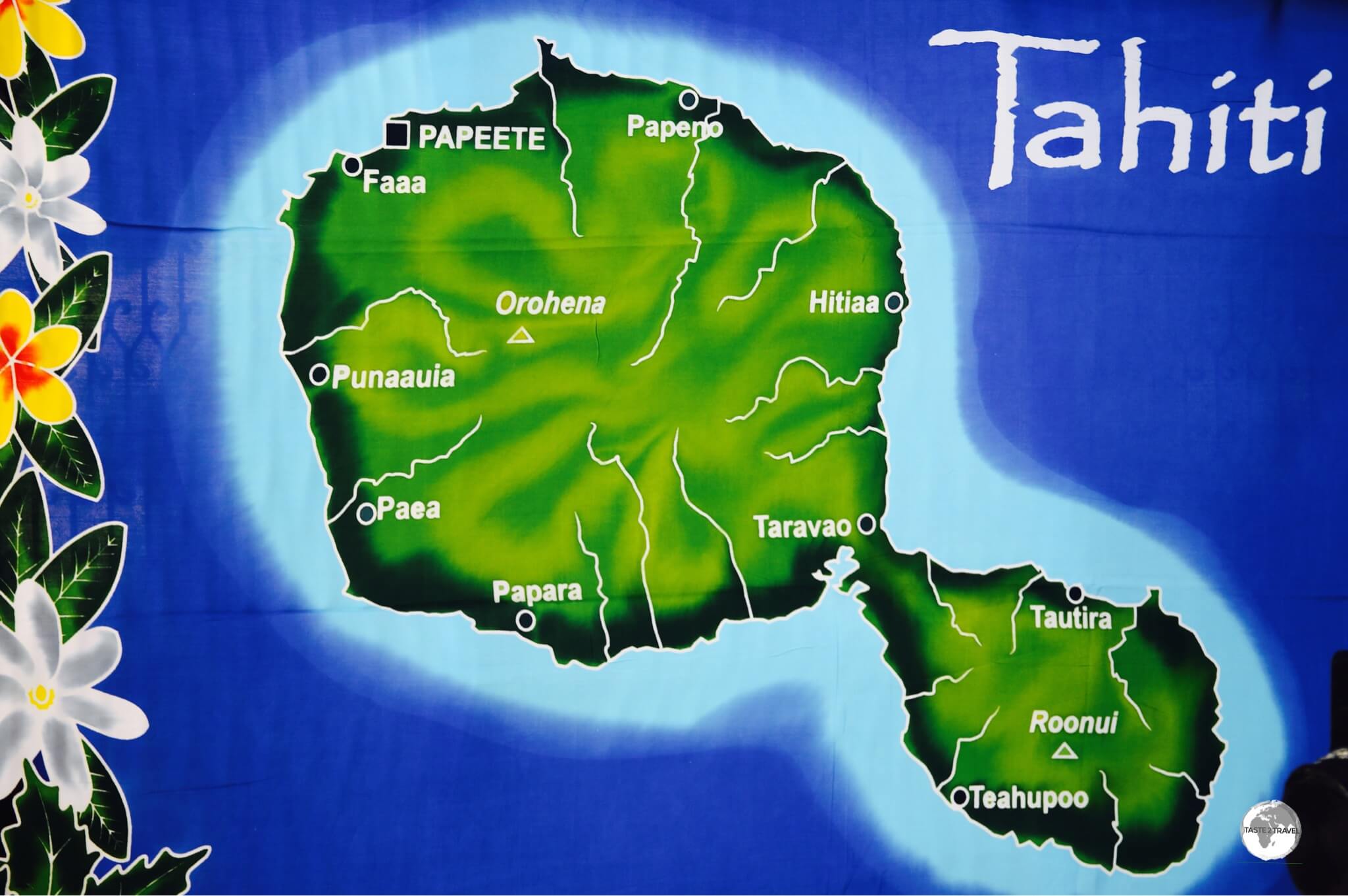
A map showing the larger ‘Tahiti Nui’ and ‘Tahiti Iti’ printed onto a sarong.
Tahiti is the largest island in French Polynesia and home to almost all the population. Shaped like a figure-8 (to me it looks like a turtle with Tahiti Iti forming the head), it’s divided into Tahiti Nui (the larger, western section) and Tahiti Iti (the smaller, eastern peninsula).
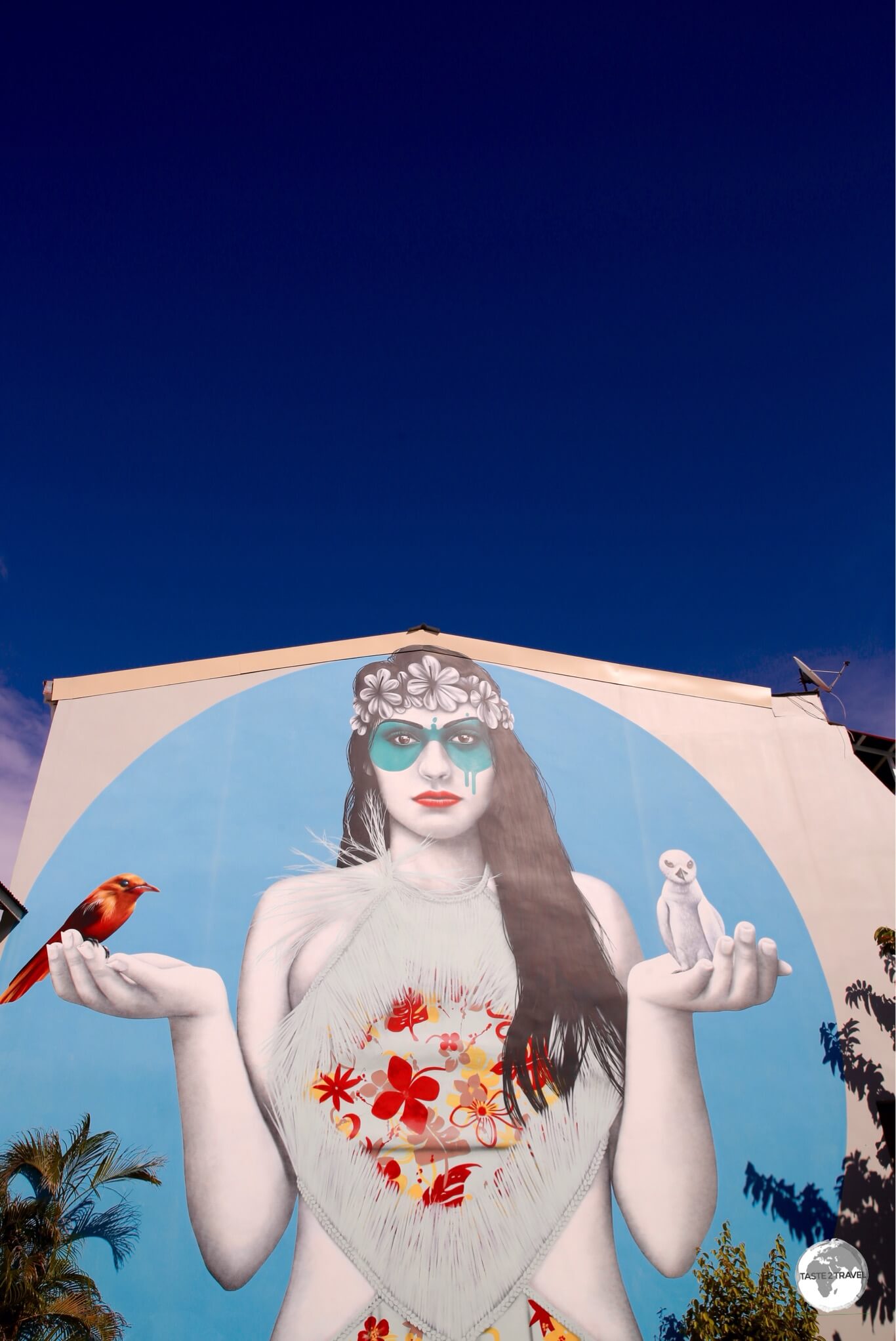
One of the many examples of incredible street art which adorn the buildings of Papeete.
One of the highlights of Tahiti Iti was being able to climb up into the central plateau which offers panoramic views of both islands and lots of bucolic, rural scenes which are unexpected in this part of the world.
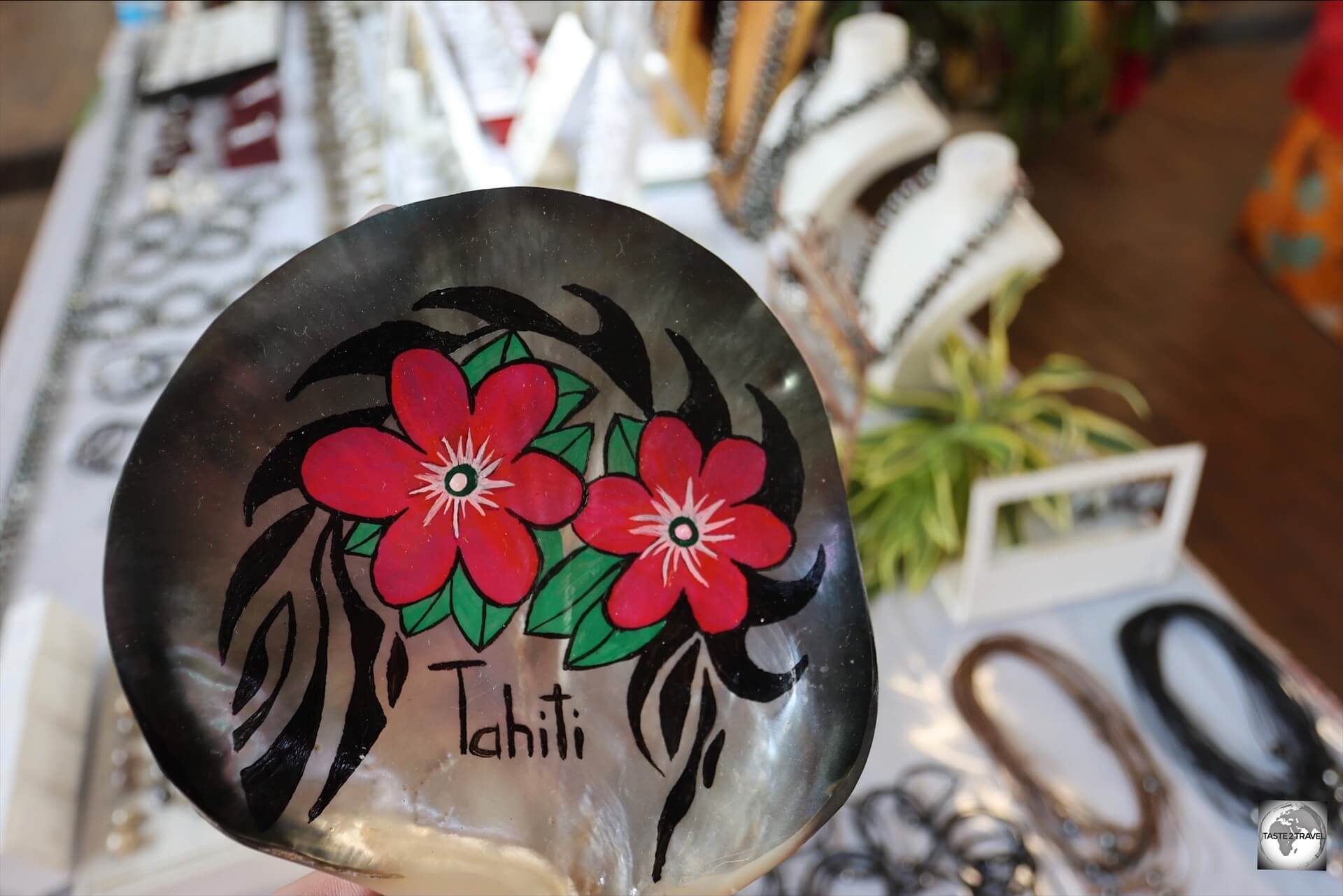
Souvenir shopping, at Papeete central market.
Papeete
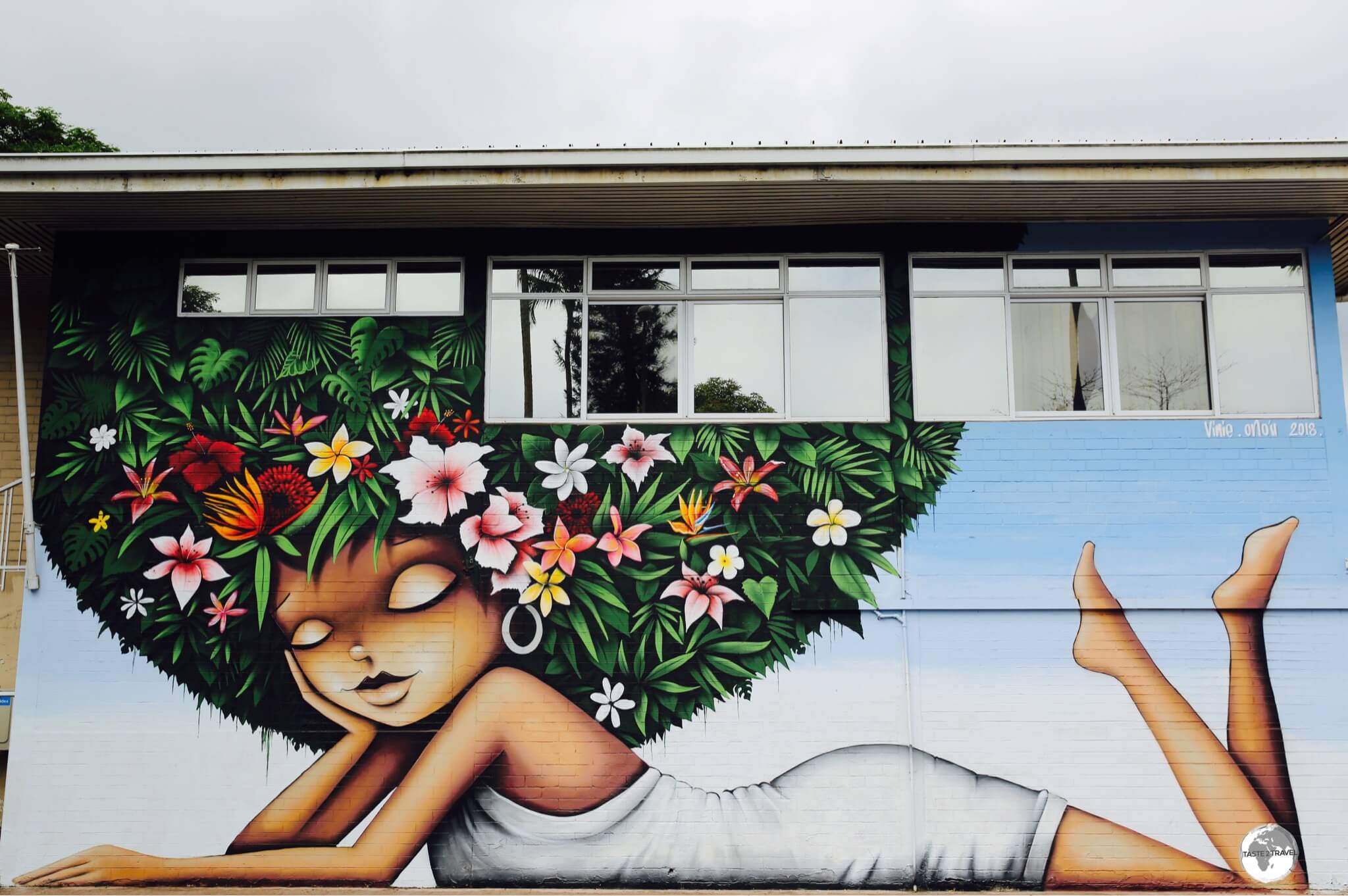
Funky street art in Papeete.
With a population of 136,771 in its greater urban area, Papeete is home to 50% of the population of French Polynesia.
The city serves as the capital of the main island of Tahiti, and also as the capital of French Polynesia.
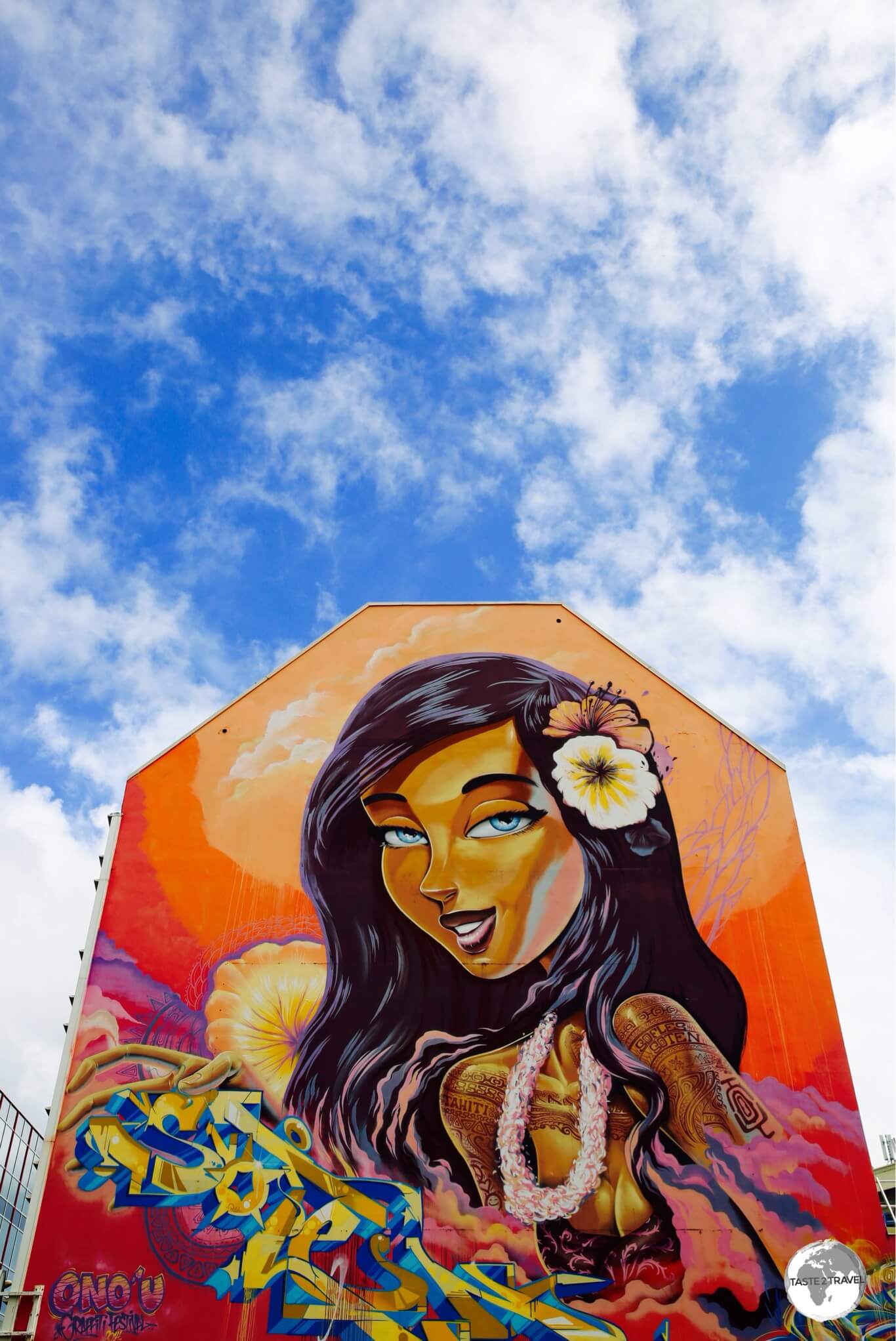
Street art adorns many buildings in downtown Papeete.
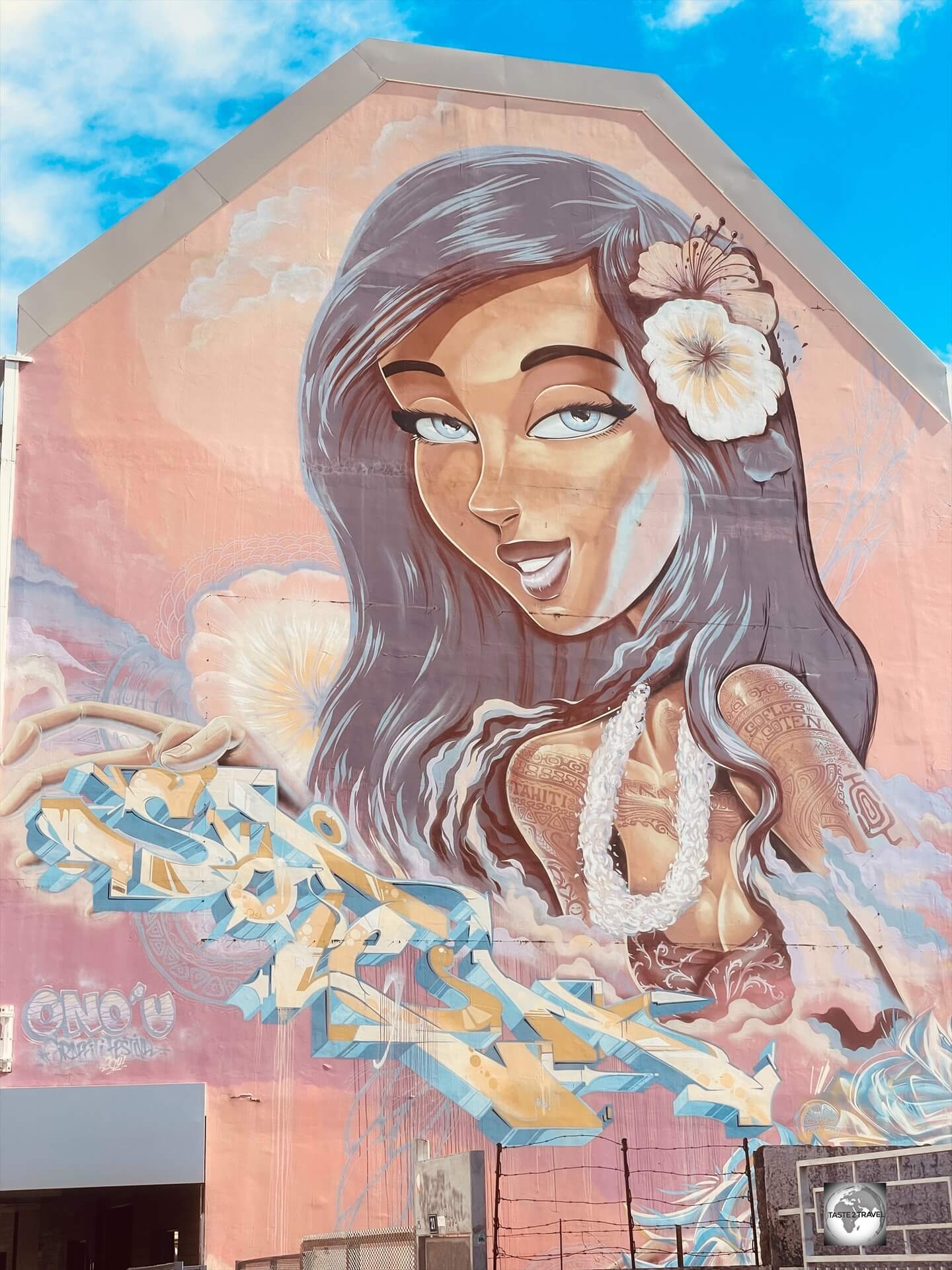
The same artwork six years later.
Offering good shopping, markets, gardens, a picturesque waterfront and a variety of cultural activities, this compact capital can easily be explored in half a day on foot.
Papeete Central Market
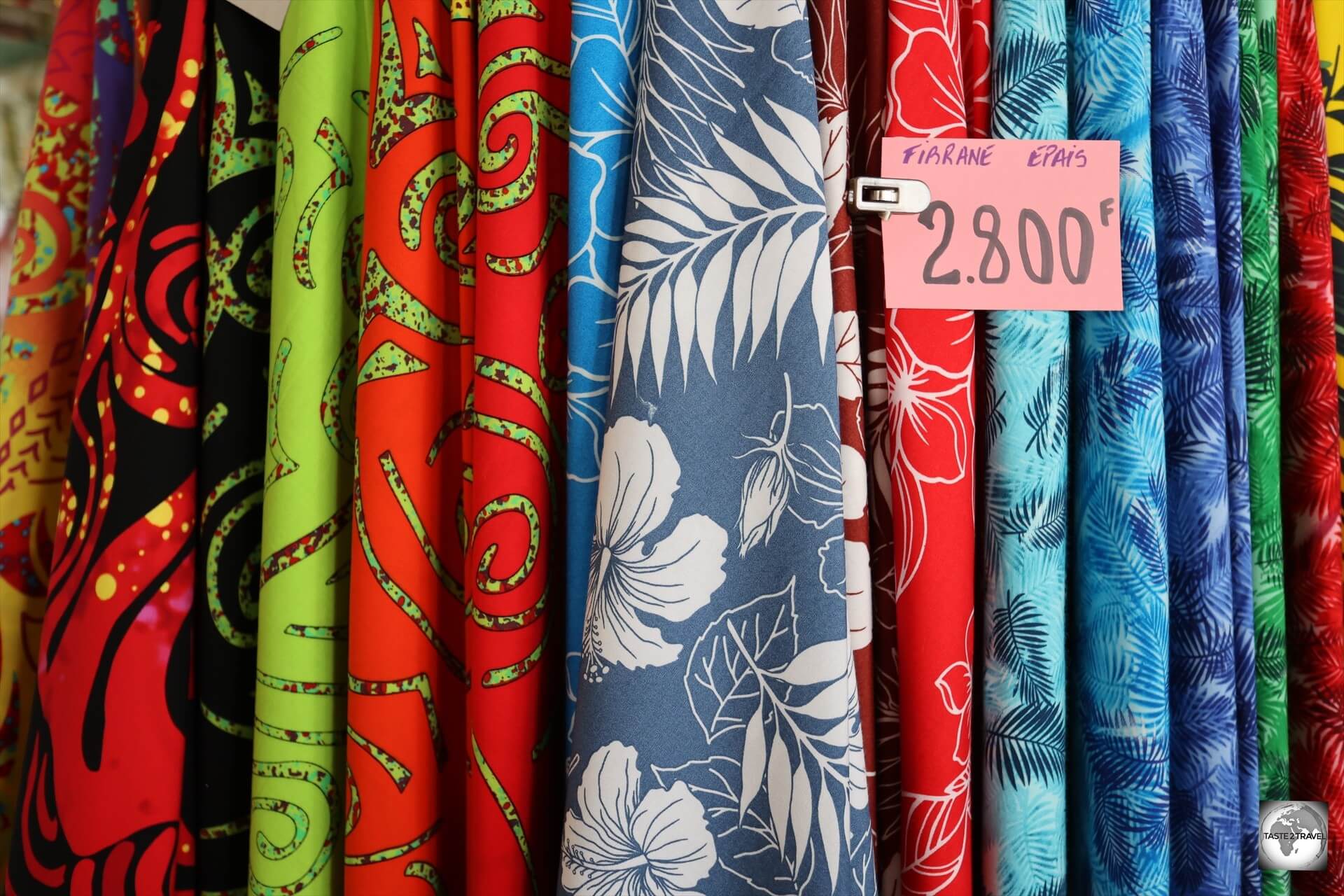
Locally made sarongs for sale at Papeete Central Market.
In the heart of the capital, Papeete central market should be the first stop on any walk around town.
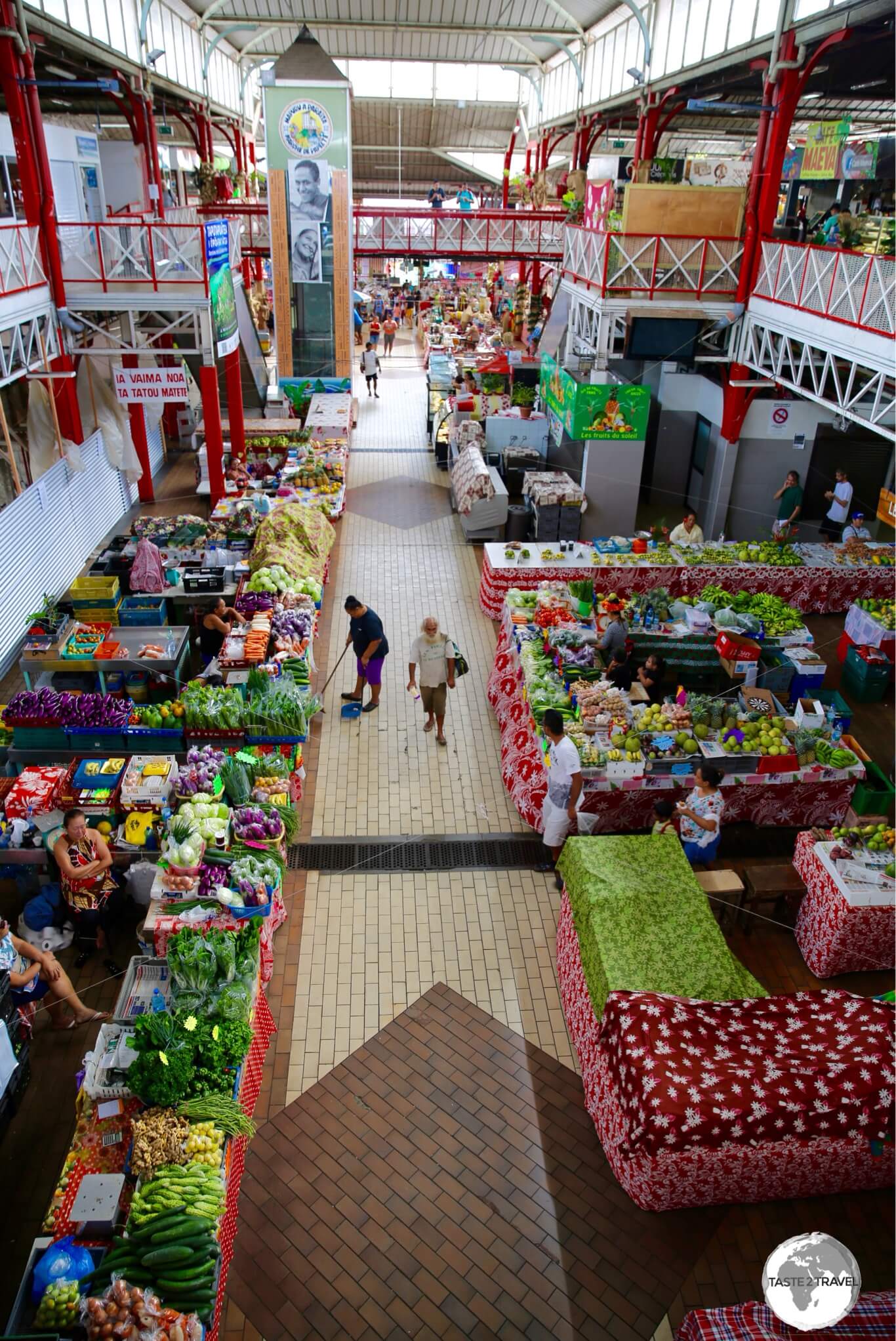
A view of Papeete central market.
Apart from the usual fresh produce, there are plenty of souvenir stands, an upstairs foot court and flowers sellers who create spectacular boutiques using local tropical flowers and plants.
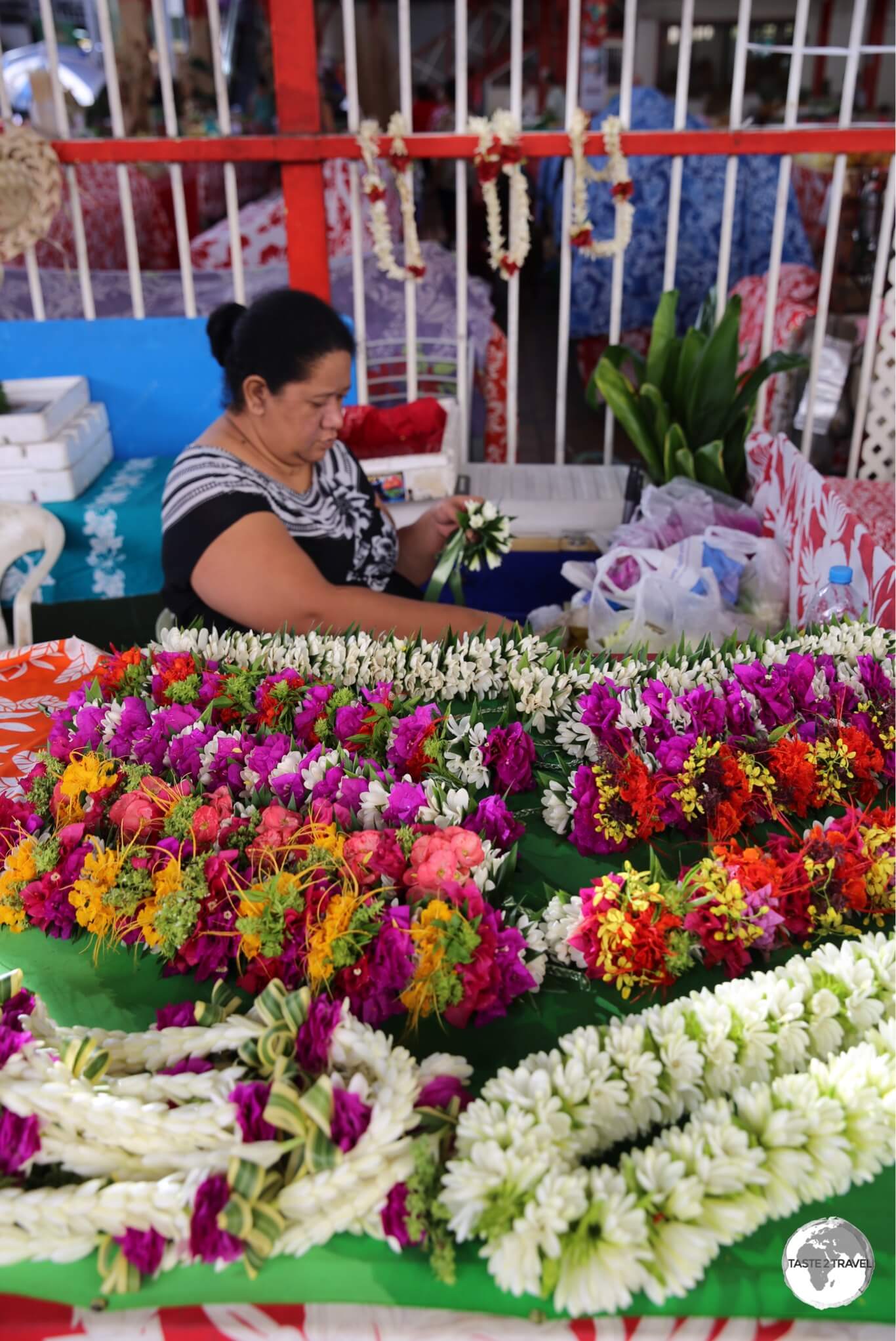
Flower seller at Papeete Central Market.
The market is lively and vibrant and a good place to meet friendly locals and is open on Sunday morning, when everything else in town is closed.

Souvenir shells on sale at Papeete Central Market.
If you wish to buy local souvenirs, clothing, fruit, vegetables, flowers, or a kilo of fresh tuna, this is the place to do it.
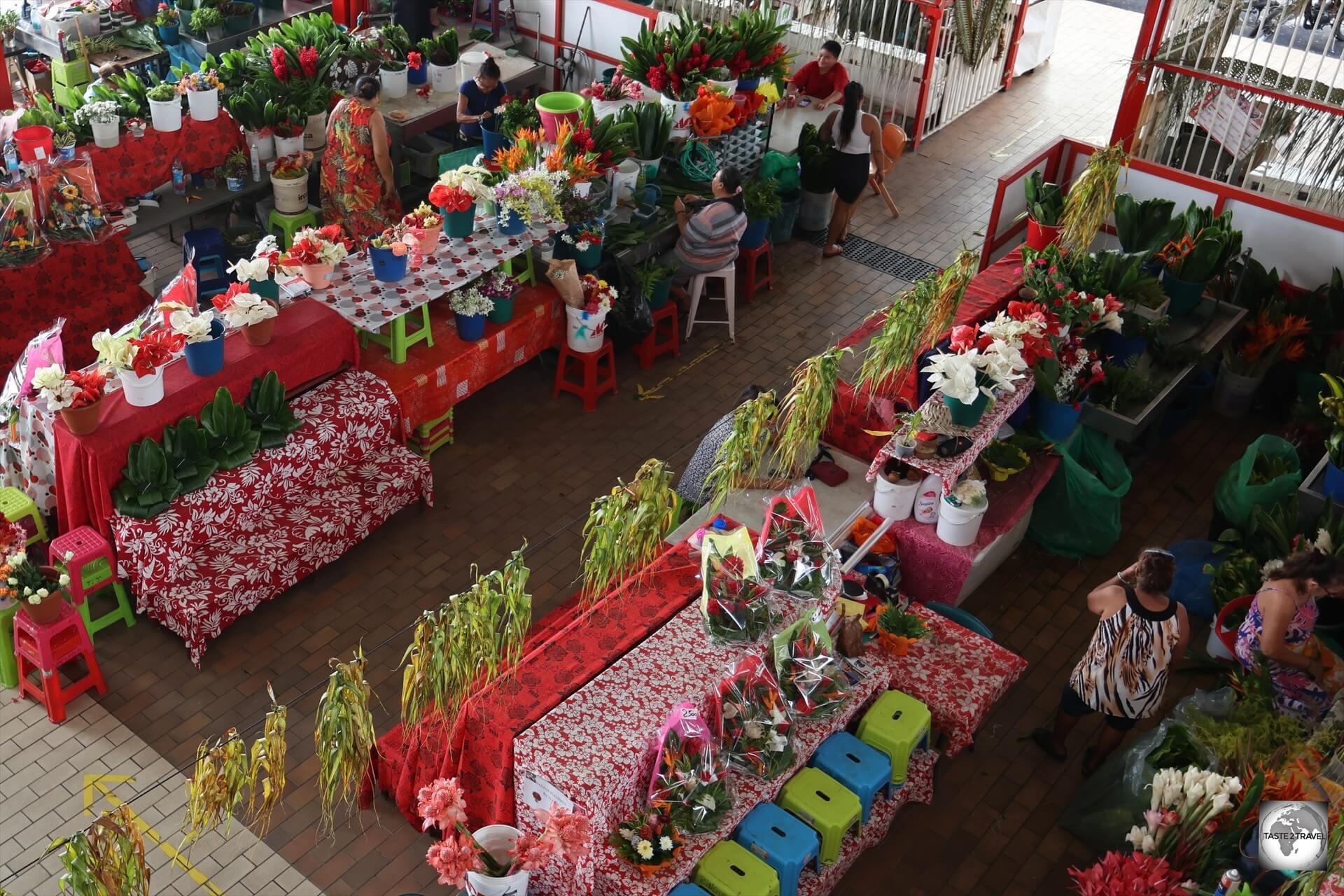
Flower sellers at Papeete central market.
As with everything else in this Pacific paradise, nothing is cheap, with a locally made sarong costing around US$28!
Papeete Catholic Cathedral

Papeete Catholic Cathedral.
Across the road from the market, the Papeete Catholic Cathedral, known as Cathédrale Notre-Dame de Papeete, has a modest exterior which belies its richly decorated interior.

A wooden statue inside the Cathedral features ‘Madonna and Child’, the latter of whom is clutching a breadfruit.
Named after its famous Parisian counterpart, the cathedral, which was completed in 1875, includes artwork that features both European and Polynesian influences.
Notable is the statue of the Madonna and Child which includes the child clutching a Breadfruit, an integral part of the Polynesian diet.
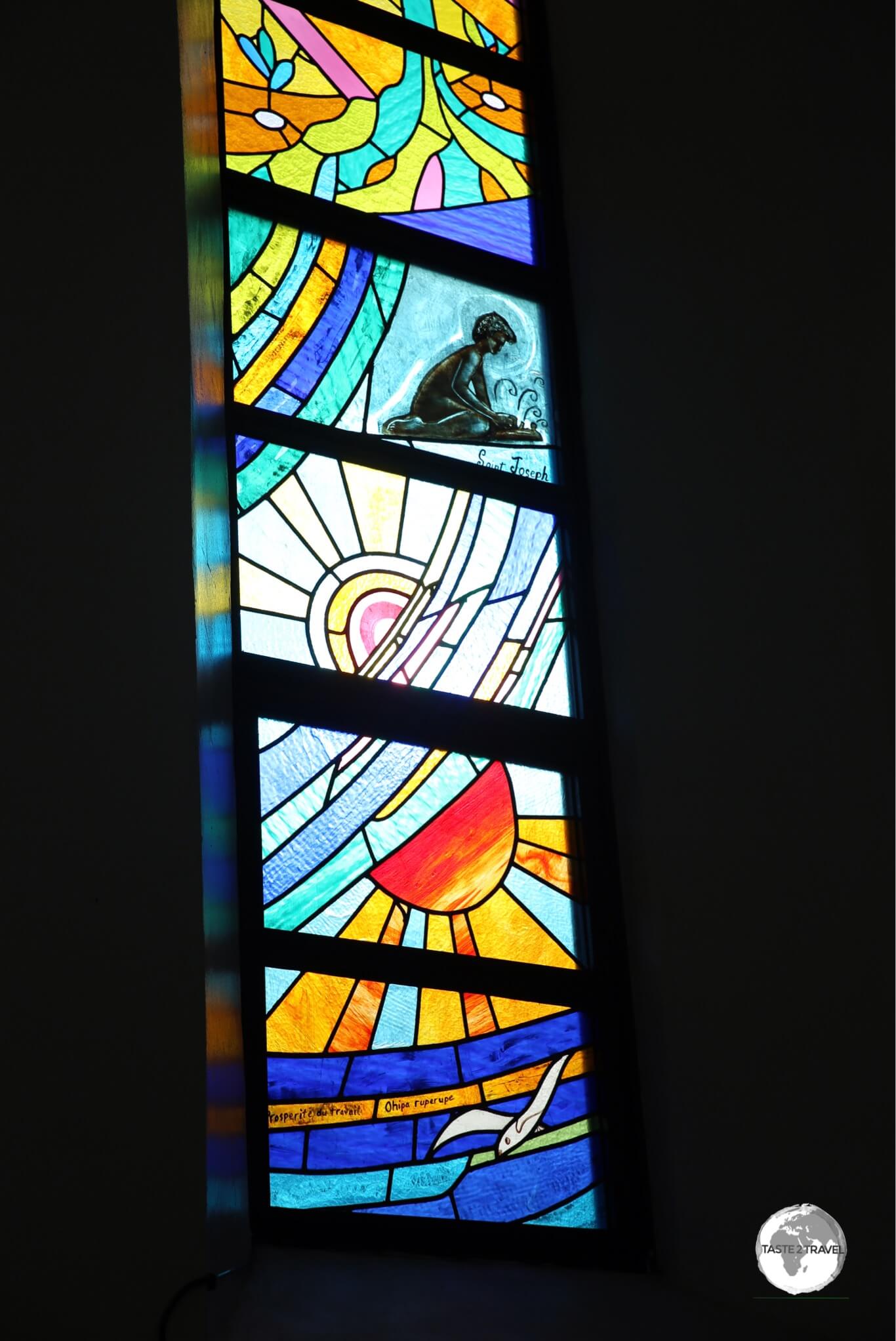
Stained-glass windows inside Papeete Catholic Cathedral.
Stained-glass windows include artistic representations of the Stations of the Cross, which incorporate both Tahitian and Roman cultures but include only Polynesian people.
The artistic style of the artwork was influenced by Paul Gauguin.
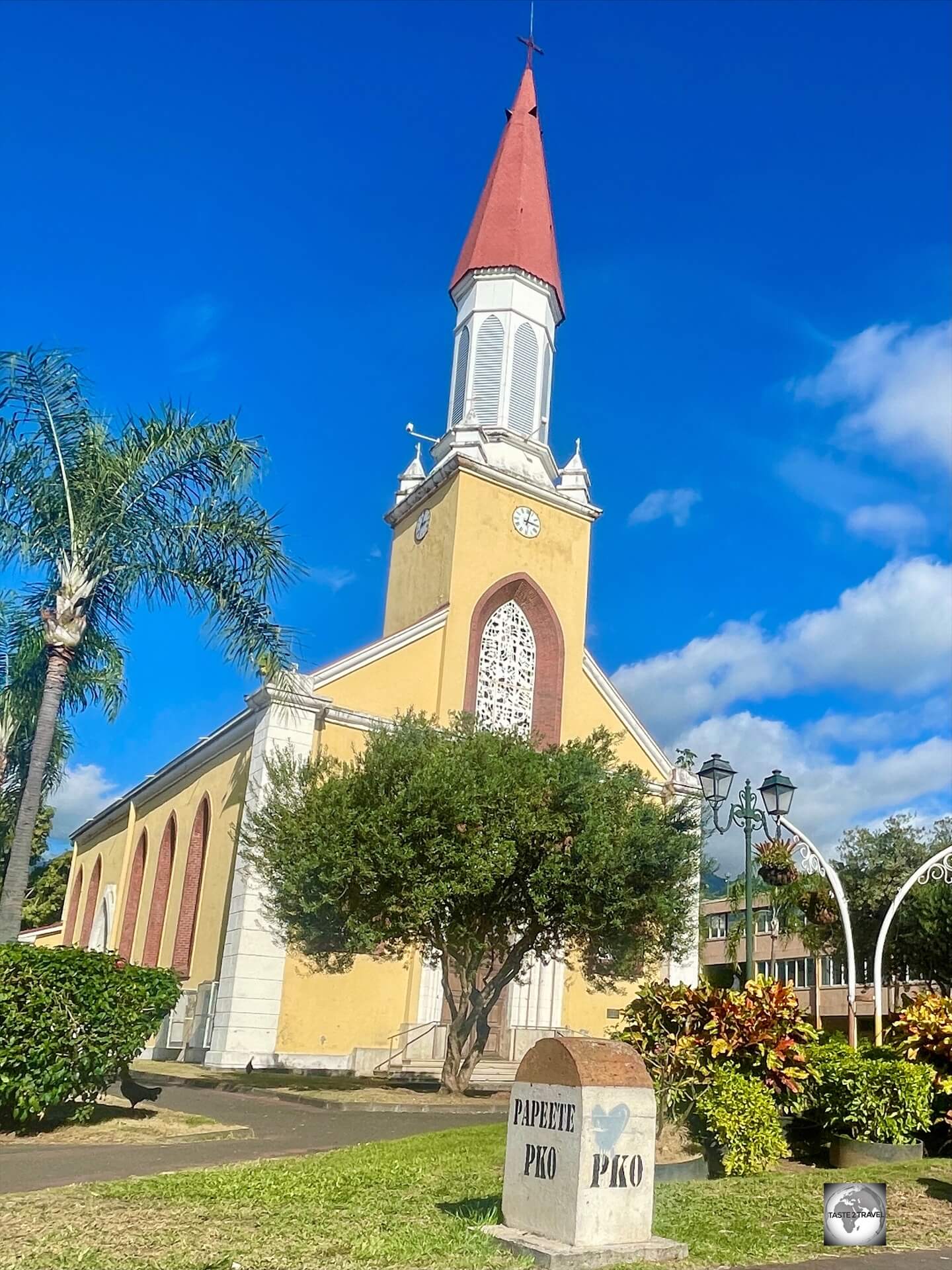
Papeete cathedral.
Bougainville Park
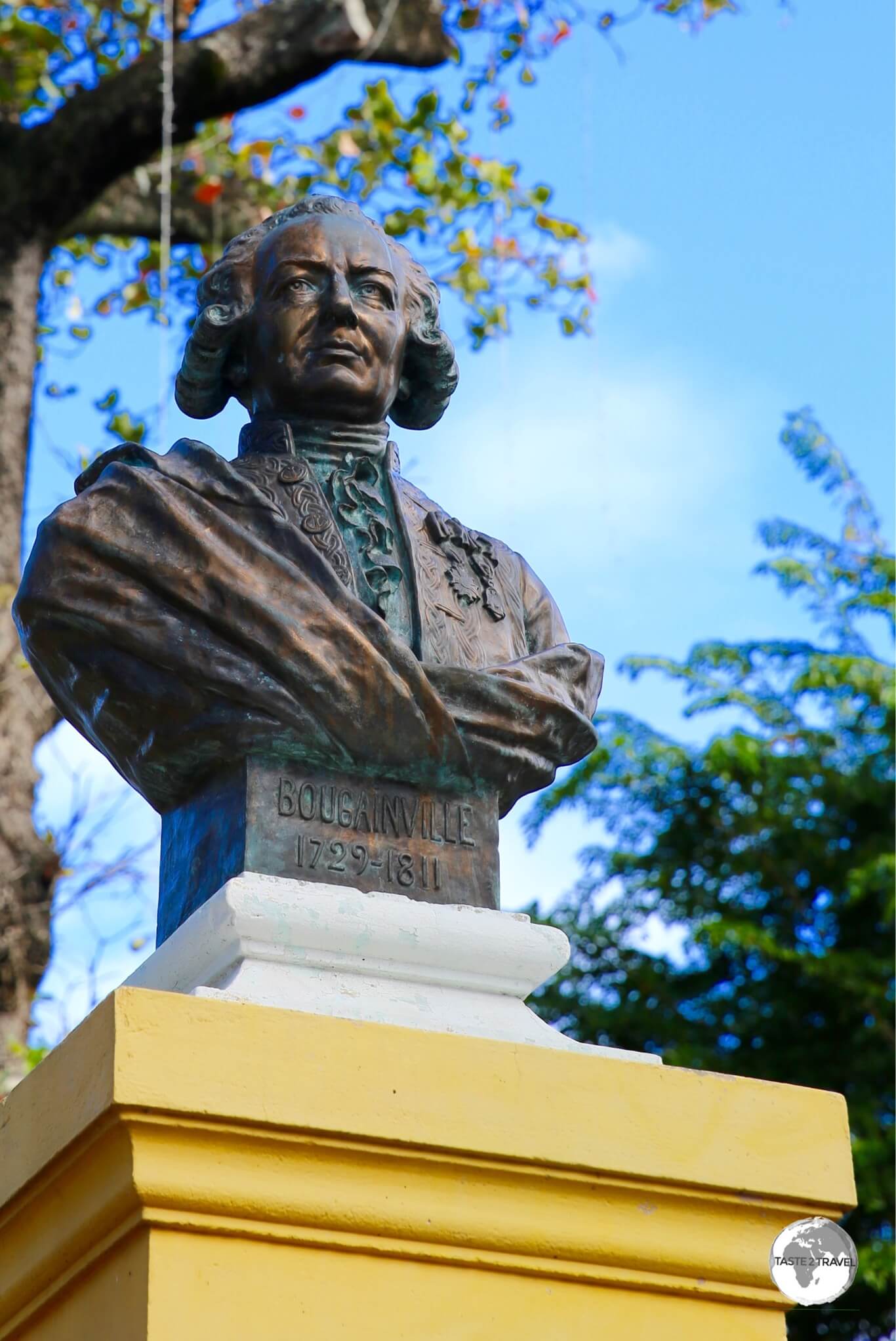
A bust of French explorer Louis Antoine de Bougainville, in the park named in his honour.
A short walk from the cathedral is Bougainville Park, which is dedicated to Louis Antoine de Bougainville – a French explorer who believed he had discovered Tahiti and claimed it for France, unaware that less than a year prior it had been discovered by the British explorer, Samuel Wallis.
In a strange twist of geographic-naming-irony, Wallis’s name is now used for one half of the French Territory – Wallis & Fortuna and Bougainville’s name is used for a key island in Papua New Guinea (formerly British New Guinea).
The park features a bust of Bougainville, a giant Banyan tree which provides ample shade, a tranquil stream, benches and lush vegetation.
A nice place to escape the midday heat!
Parliament House
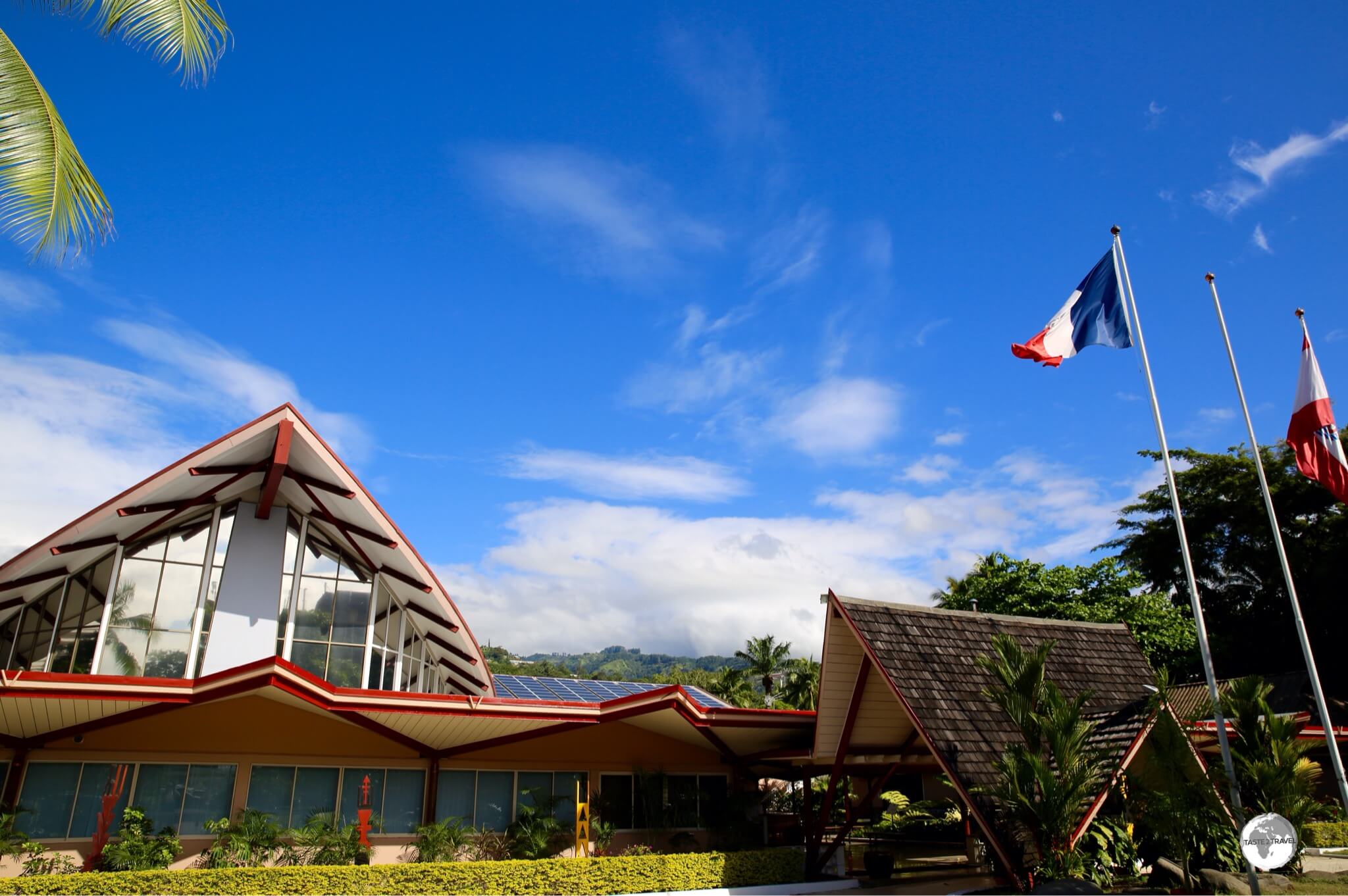
The parliament of French Polynesia – the Territorial Assembly.
Across the road from the park is the Territorial Assembly building, the Parliament house for French Polynesia.
Around Tahiti Nui
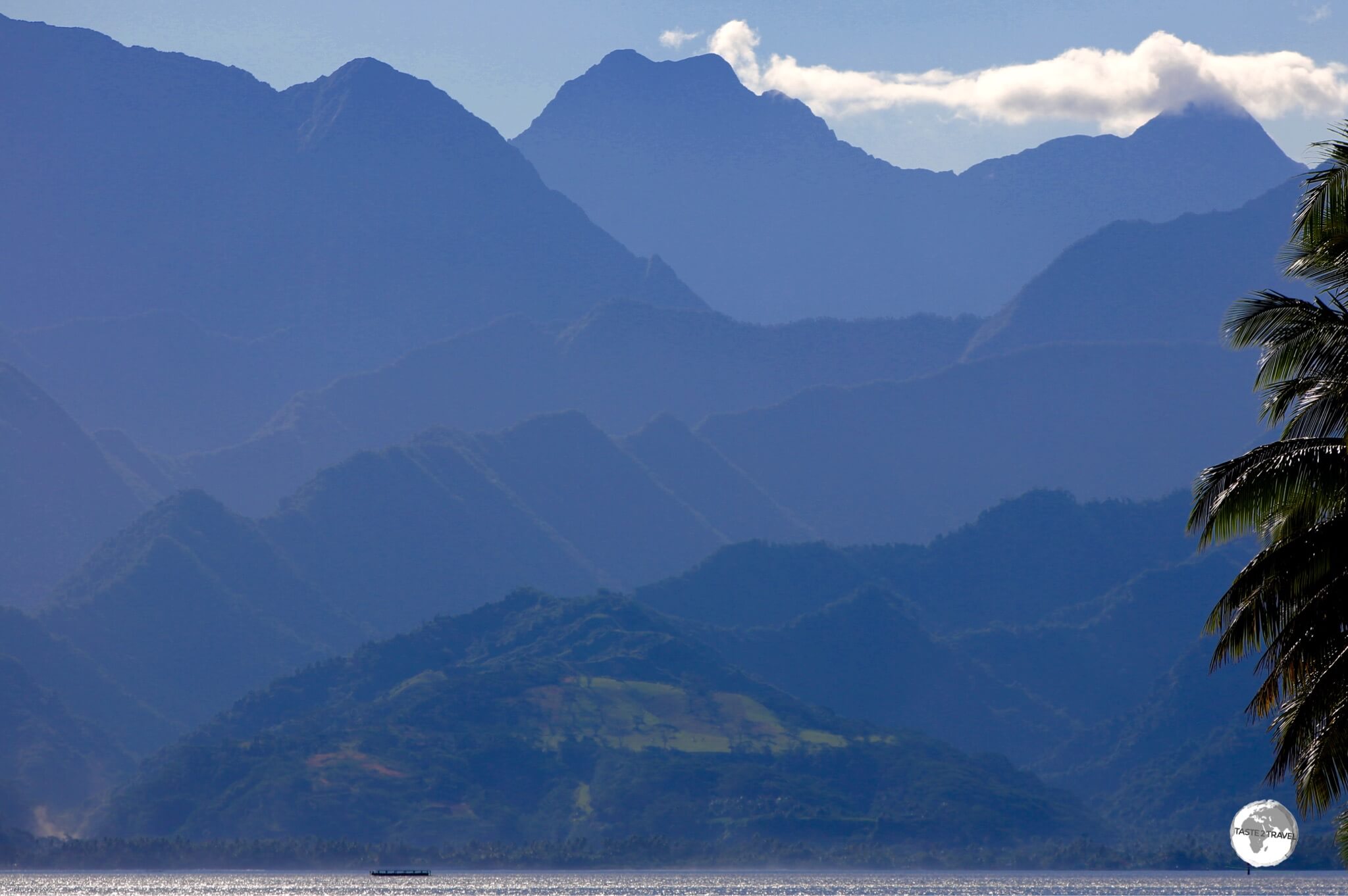
The mountainous, volcanic interior of Tahiti Nui is almost impenetrable.
Traveling around the main island is simply a matter of following the one ring road which circumnavigates the island.
The rugged and impossibly steep interior is almost without roads, which makes sightseeing very easy as everything is located along, or close to, the main ring road and everything is well signposted.
I drove a car around the island for two days which allowed ample time to visit all sights.
Traveling in an anticlockwise direction from Papeete, I visiting the following sights:
Arahurahu Marae

The Arahurahu Marae is located on the west coast, a short drive south of Papeete.
Located in the district of Pa’ea, the relaxing and beautifully maintained Arahurahu Marae is the largest Marae in French Polynesia.
Marae’s in French Polynesia consist of raised stone, rectangular platforms with a raised stone altar, ahu, at the centre of the rectangle.
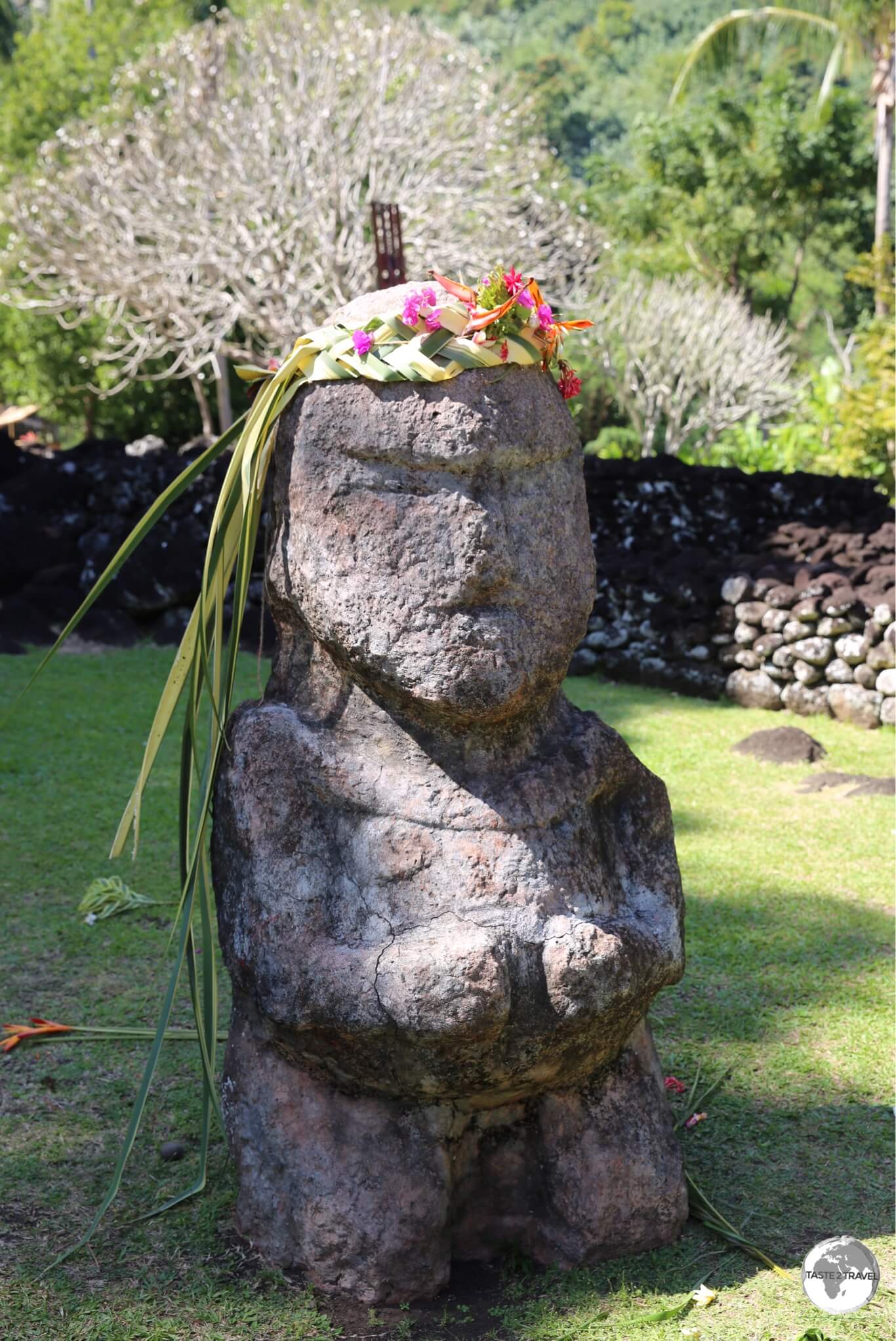
A Tiki at the entrance to the Arahurahu Marae.
Marae’s were used by Polynesians for ceremonial gatherings, religious rituals and other important events.
Maraa Grotto
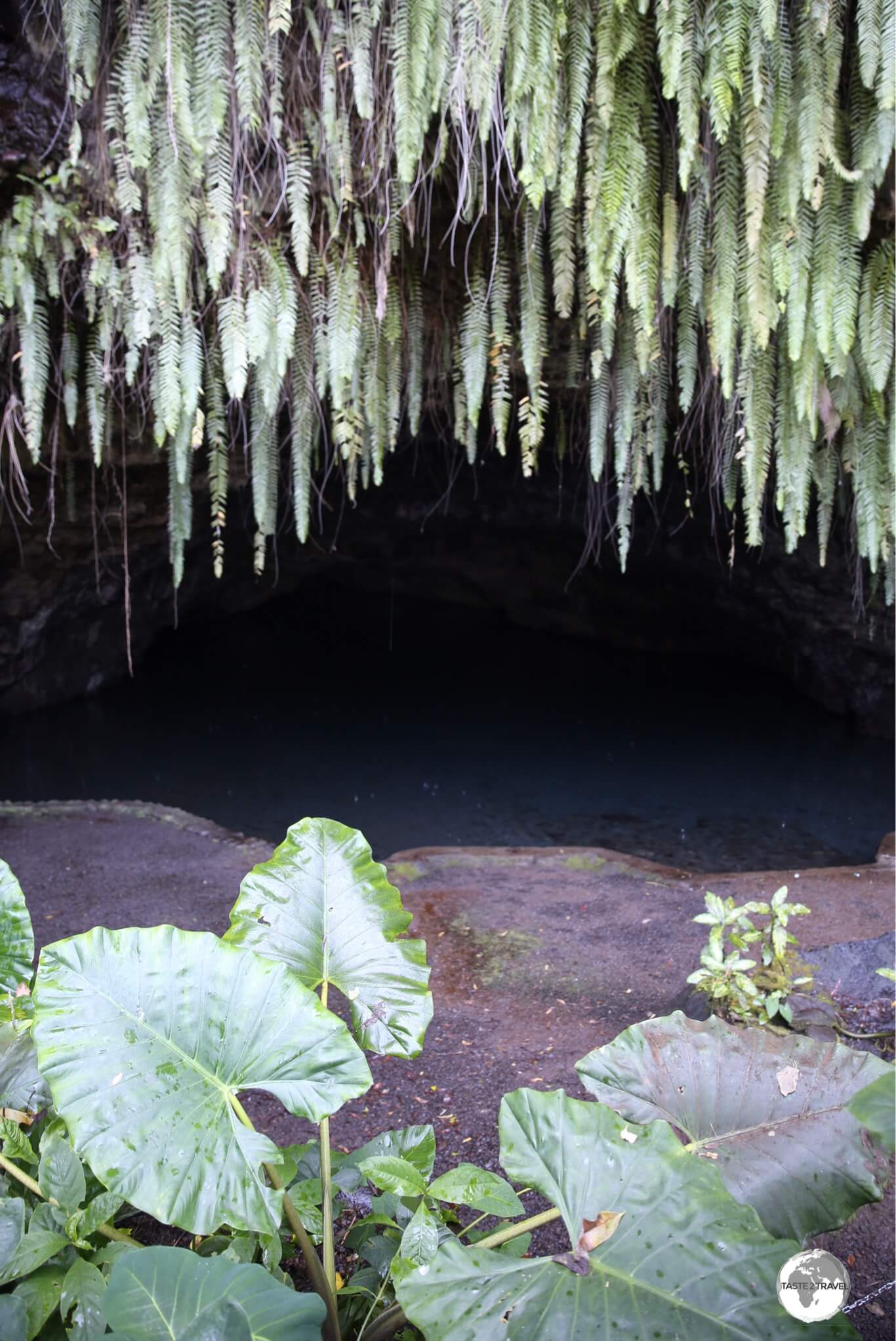
The incredibly lush Maraa Grotto.
Continuing south along the west coast, my next stop was the beautiful Maraa Grotto.
Located directly on the side of the main road, a short walking trail leads you to this gloriously beautiful and lush freshwater grotto, the ceiling of which is covered with ferns dripping with water.
Paul Gauguin was also impressed, mentioning the grotto in his letters home.
Harrison Smith Botanical Garden
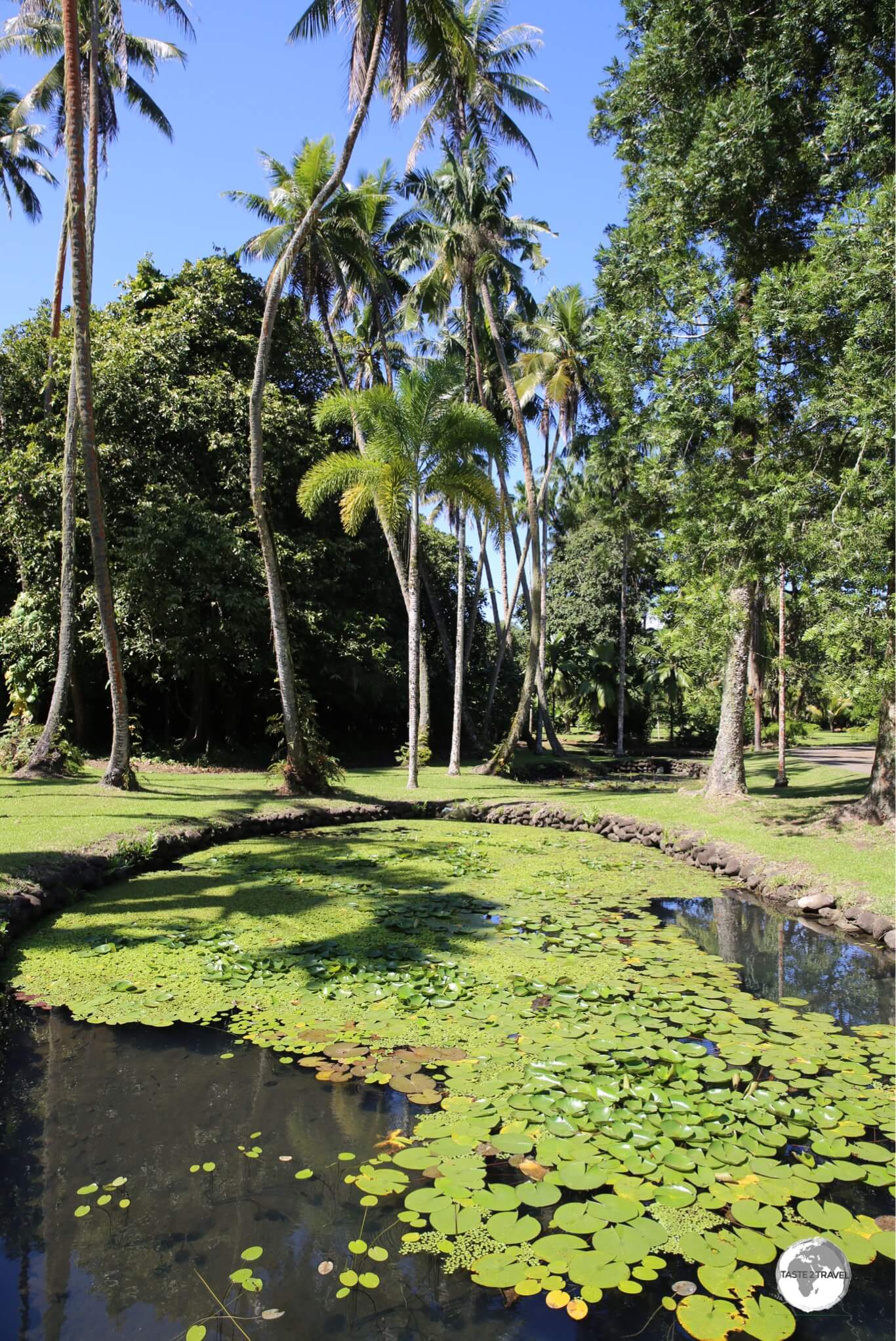
The grounds of the Harrison Smith Botanical Garden.
Located at the 51 km mark, the Harrison Smith Botanical Garden is a little forlorn and unloved but does boast a Giant Galapagos Turtle, which is apparently 90 years old.
You can photograph the poor captive turtle through the wire fence of its enclosure, but if you prefer your turtles ‘free-range’, you can view photos of happier ones in my Galapagos Islands Travel Guide.
Paul Gauguin Museum (Permanently Closed)
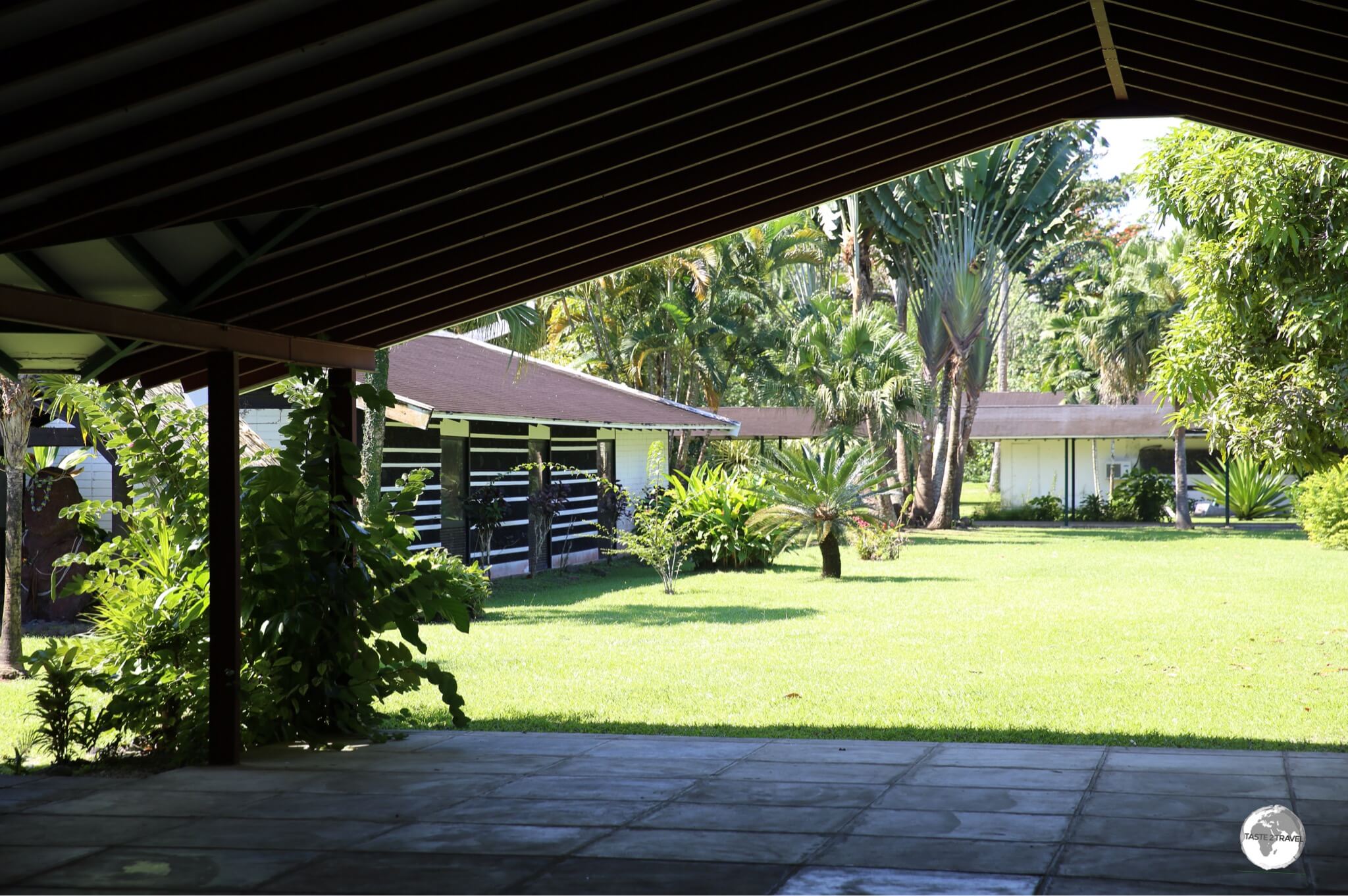
A sneak peek through the front gate of the now closed Paul Gauguin Museum.
Located next to the entrance of the botanical garden is the Paul Gauguin Museum, which closed its doors in 2015 and is not scheduled to reopen.
There is a security guard posted at the main gate, who kindly allowed me to take a photo of the museum grounds (from the gate).
Taravao
After the botanical garden, I reached the southern town of Taravao, which provides access to the adjoining island of Tahiti Iti (refer to the next section for more on Tahiti Iti).
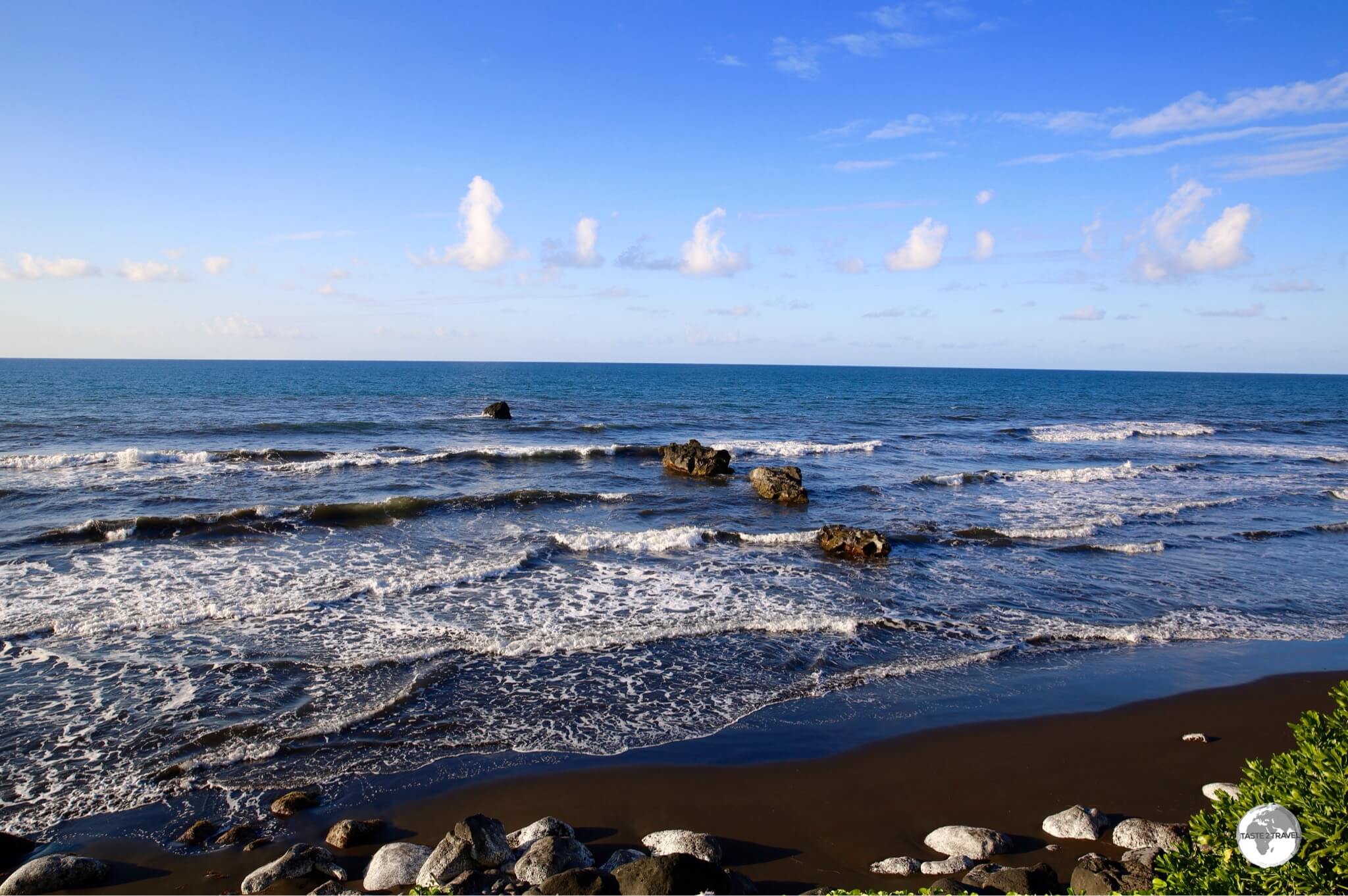
A black-sand beach on the east coast of Tahiti.
Continuing beyond Taravao, now traveling north, along the east coast of Tahiti Nui, a left turn past the village of Tiarei, leads to the parking lot of the incredibly high – Faarumai Waterfall.
Faarumai Waterfall
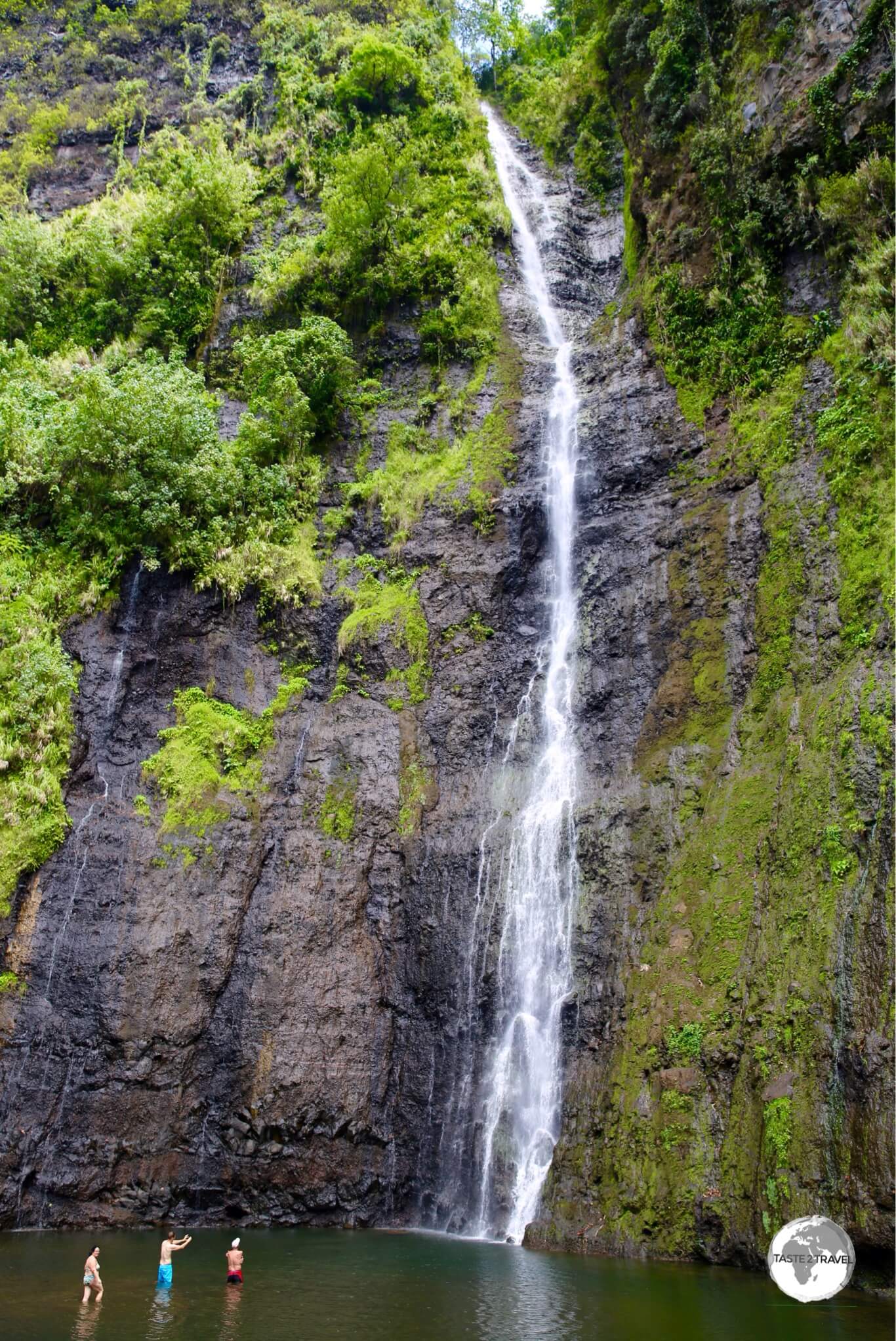
The incredibly high Faarumai waterfall is a spectacular sight.
The falls are a short walk from the car park along a well-maintained track but, since a tourist was hit on the head by a falling rock a few years ago, swimming is not allowed.
Venus Point

A marker at Venus Point commemorates the visit by Captain James Cook in 1769.
The last stop before returning to Papeete was Venus Point, which is located at the tip of a peninsula, 8 km east of Papeete.
The location was visited by Captain James Cook, who, on his first voyage to the Pacific, was tasked with observing the 1769 Transit of Venus from the South Pacific.
Cook’s expedition was funded by the Royal Society of London for the primary purpose of viewing the transit of Venus.
After viewing this astronomical event, Cook got on with his ‘other’ mission which was to find the legendary Terra Australis Incognita – the great southern continent.
Less than a year later, on the 29th of April 1770, Captain Cook first set foot on Australia at Botany Bay in New South Wales and the rest is history.
Tomb King Pōmare V Tahiti
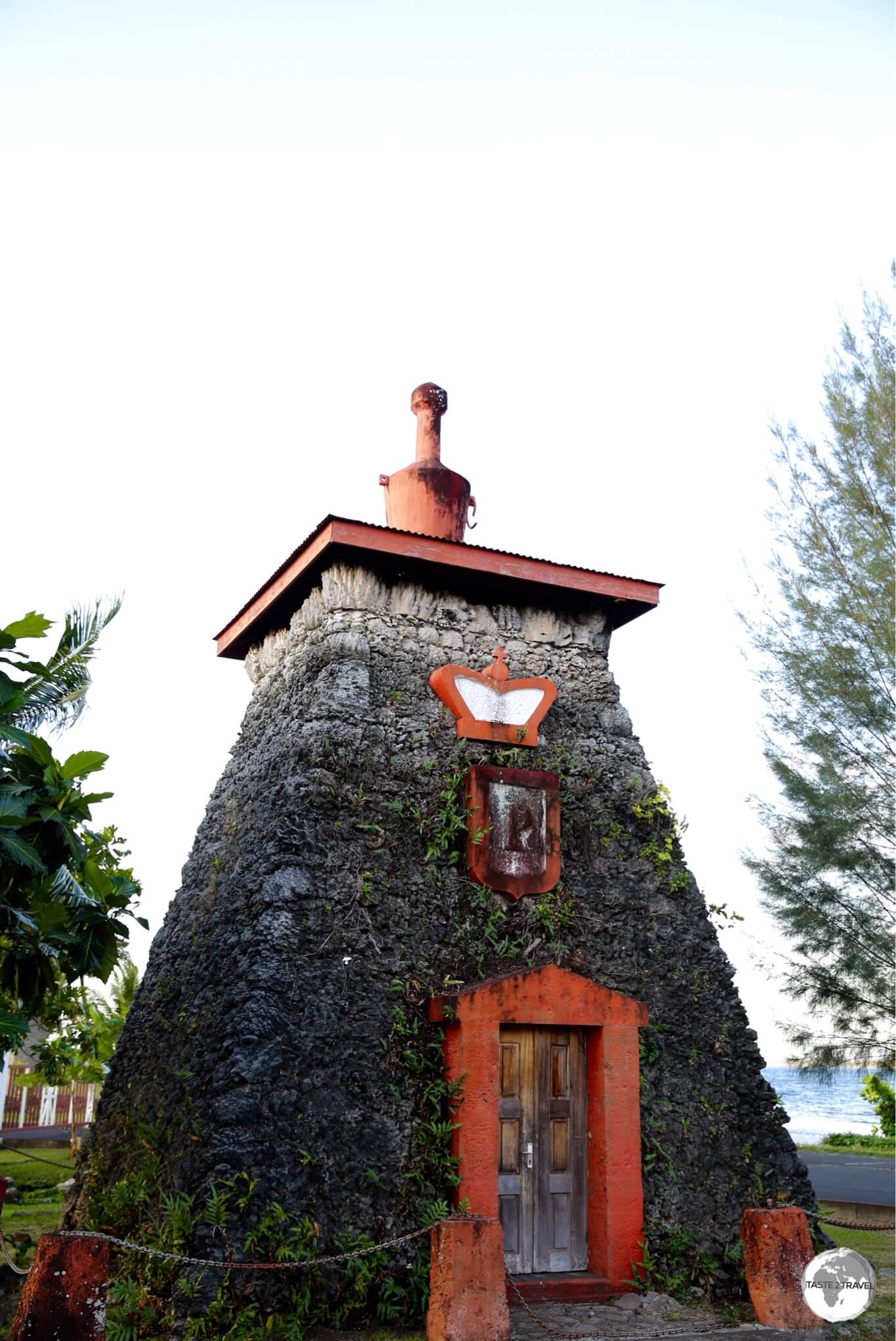
The Tomb of King Pōmare V on Tahiti.
Located a short drive east of Papeete, the tomb of Tahiti’s last king, Pomare V (1839–1891), is built of coral stones in the shape of a small lighthouse, which has a red door and is topped with a red Grecian urn.
The tomb stands on a point at Arue just off the coastal road. Originally built for his mother Queen Pomare IV, Pomare V had her remains exhumed and his were interred instead when he died only a few years later.
Around Tahiti Iti
Tahiti Iti has two coastal roads which extend halfway down the east and west coast and one road which travels up to a central plateau, providing access to a very different part of the country – one which is rural and bucolic.
Teahupo’o
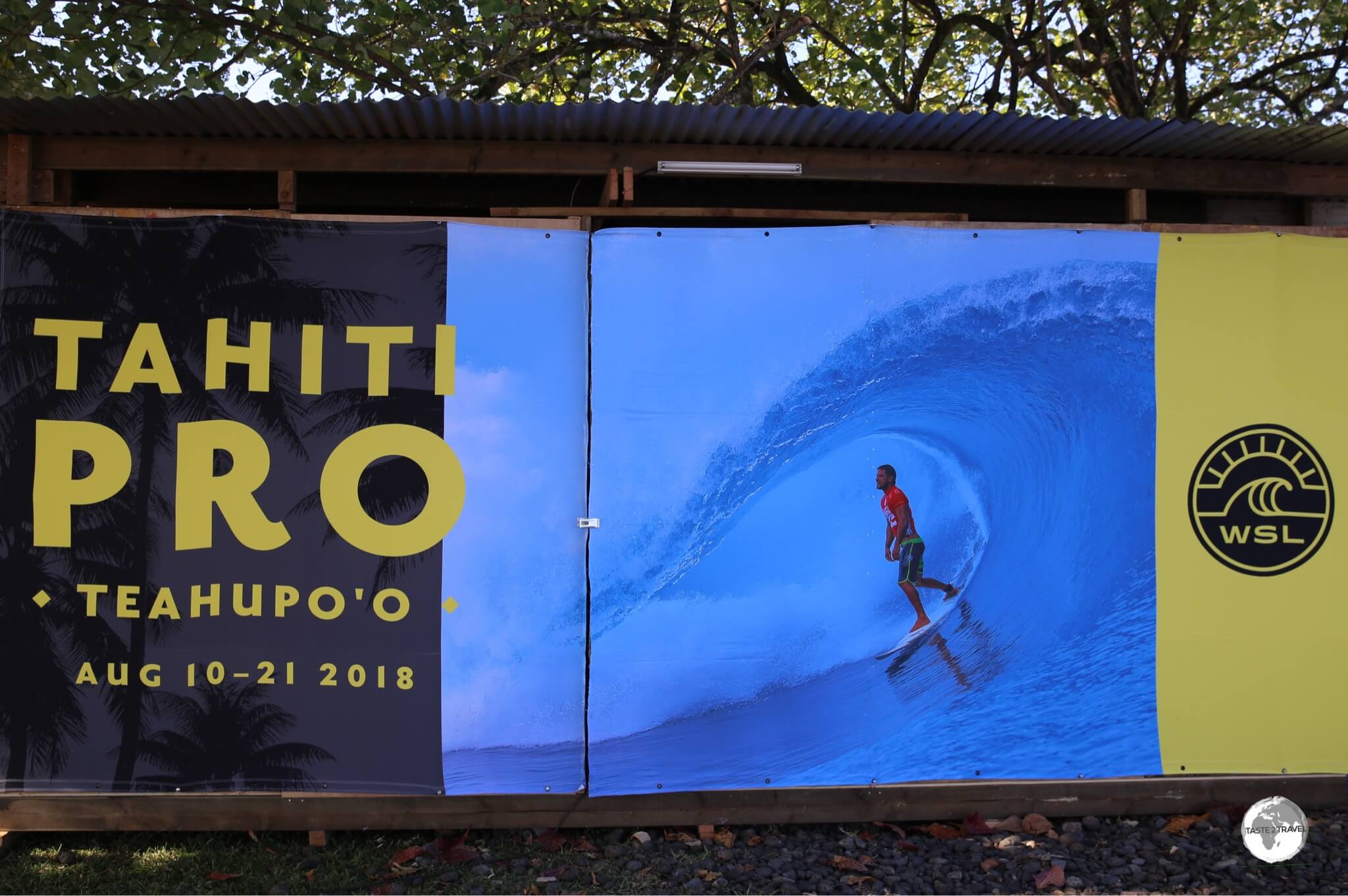
Getting ready for the Tahiti Pro surf competition which is held in August of each year.
The west coast road terminates in the village of Teahupo’o which is a famous surf spot and the venue for the annual Tahiti Pro surf competition which was due to commence a week after my visit.
Tautira
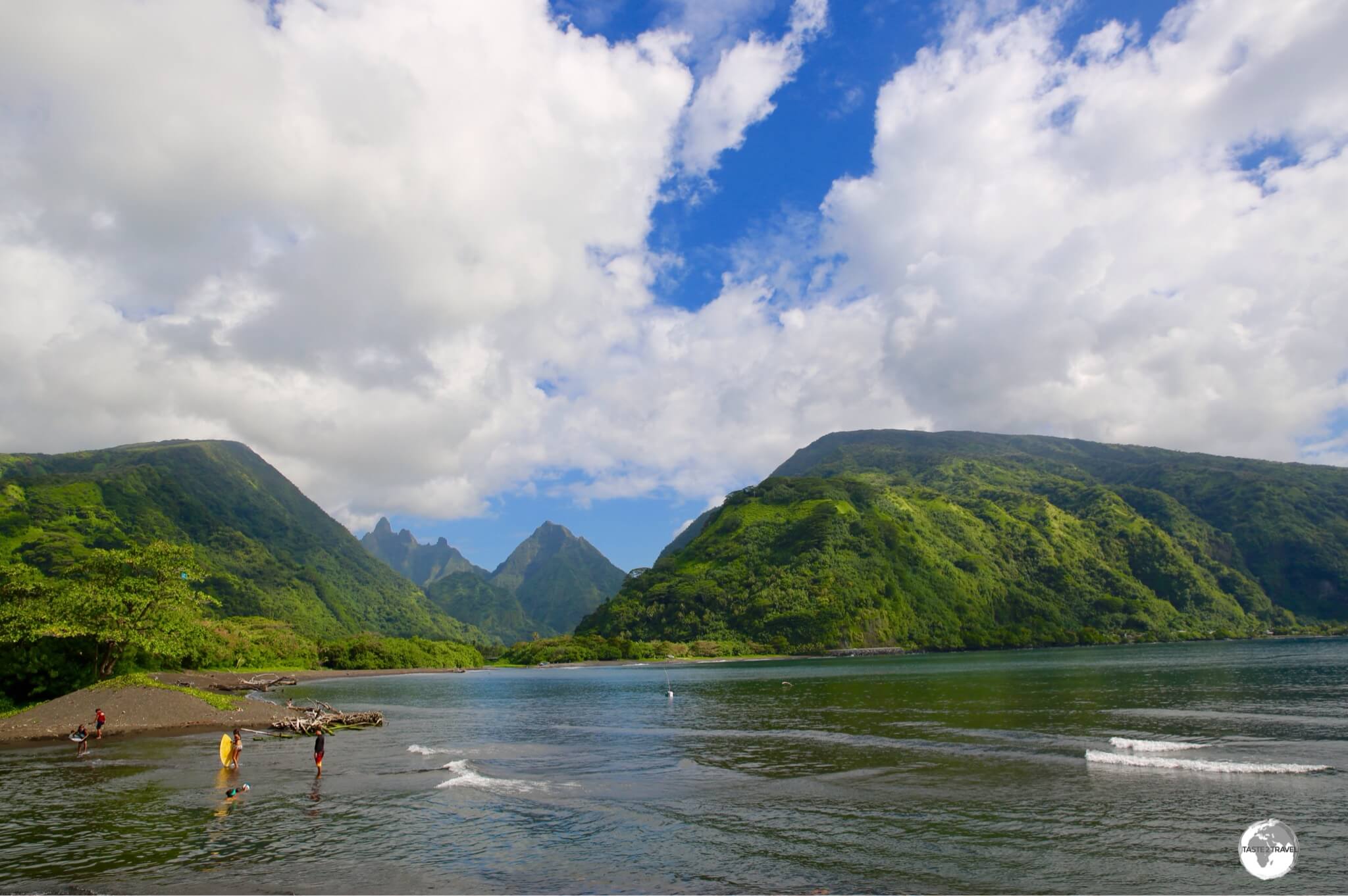
The magnificent views from the village of Tautira.
The east coast road terminates in the picturesque, beachside village of Tautira, which is 49 km southeast of Papeete.
The village offers spectacular views of the surrounding mountains and was once used as a place of convalescence by Scottish author, Robert Louis Stevenson, who referred to it as “The Garden of the World”.
Belvédère de Taravao
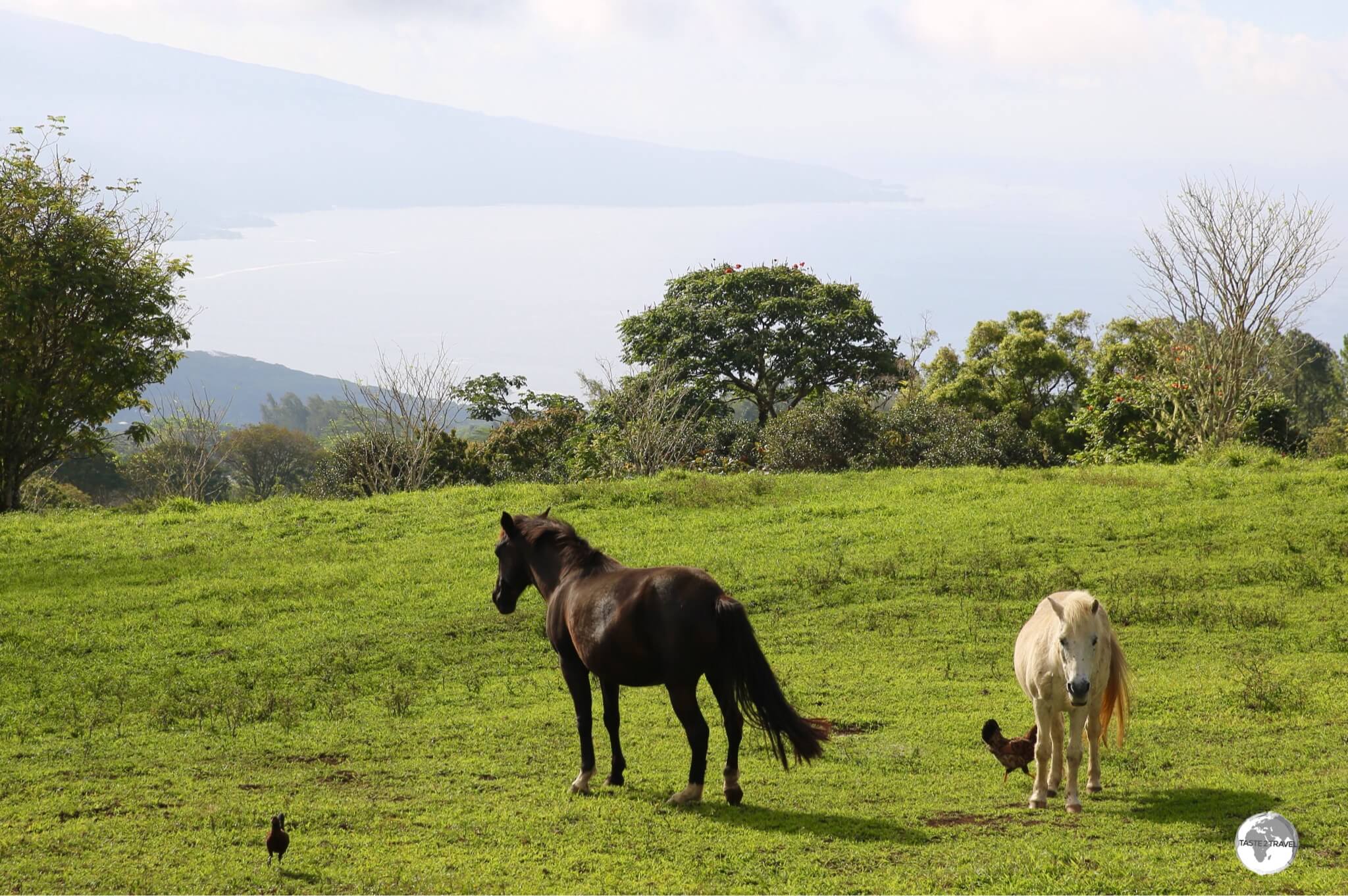
A different view of Tahiti from the plateau on Tahiti Iti.
Before departing Tahiti Iti, it’s worth taking the one other road on the island which climbs up onto a large, central plateau (from Taravao), eventually arriving a panoramic lookout – the Belvédère de Taravao.
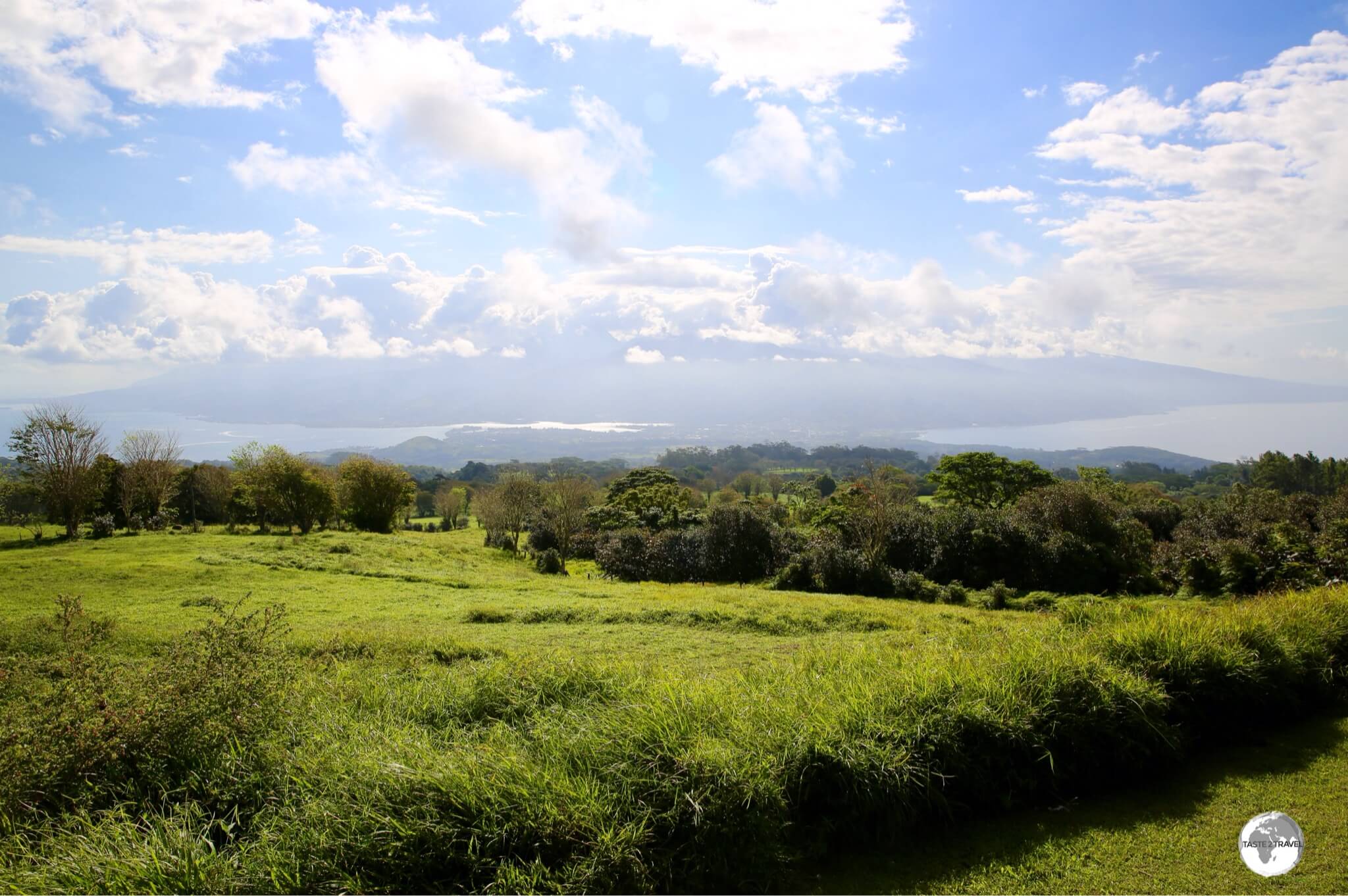
Belvédère de Taravao offers sweeping views of Tahiti Nui and Iti.
Moorea
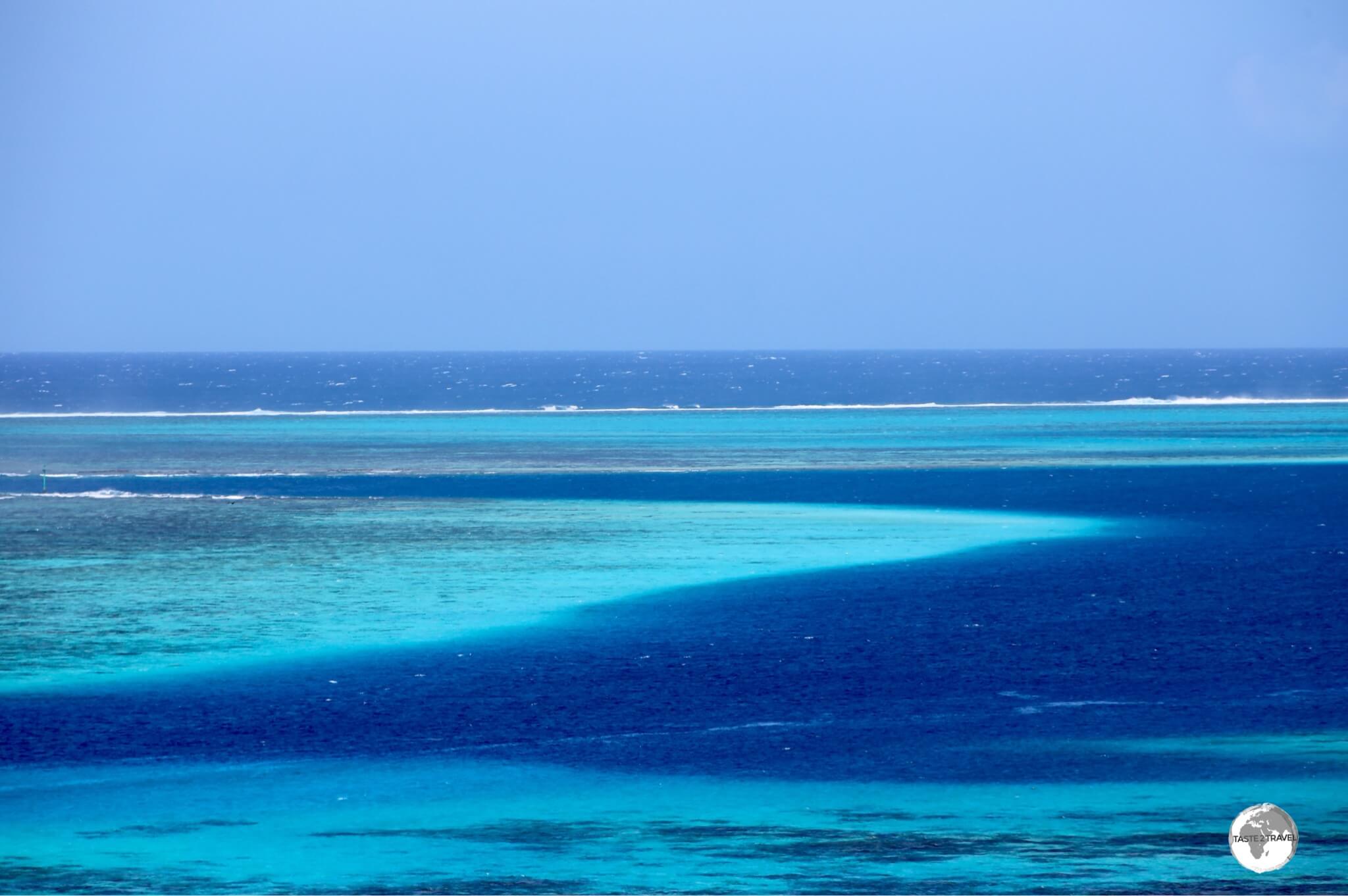
The magical Moorea Lagoon.
Like Tahiti, exploring Moorea is made easy thanks to the islands impossibly steep interior.
A single ring road circumnavigates the island with a couple of short roads providing a glimpse of the interior.
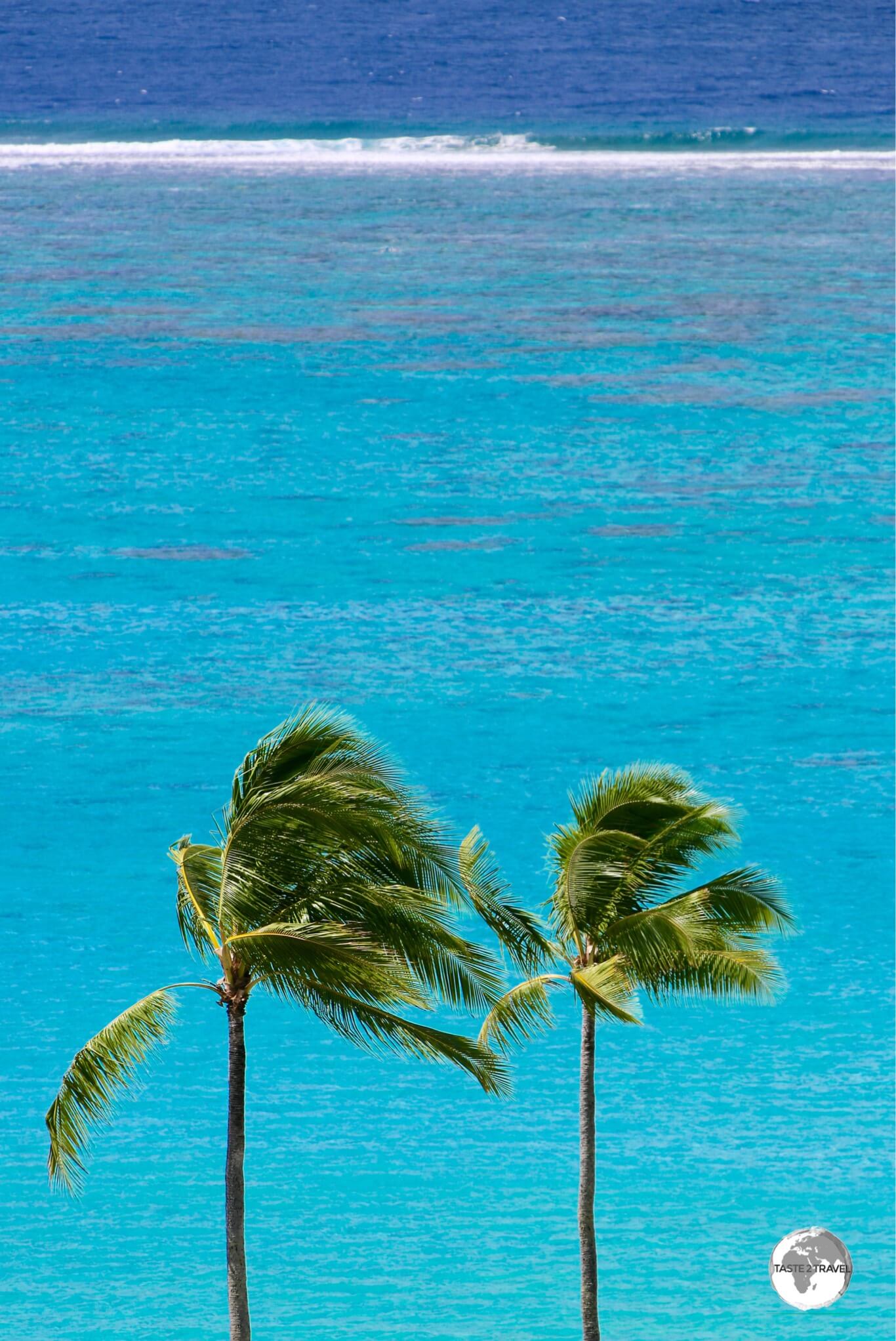
Easy on the eye – the turquoise waters of the Moorea lagoon.
There is almost no public transport on Moorea so I hired a car (not cheap!) for the duration of my stay on the island.
Following the ring road in an anticlockwise direction from the ferry terminal in Vai’are, I visited the following sights:
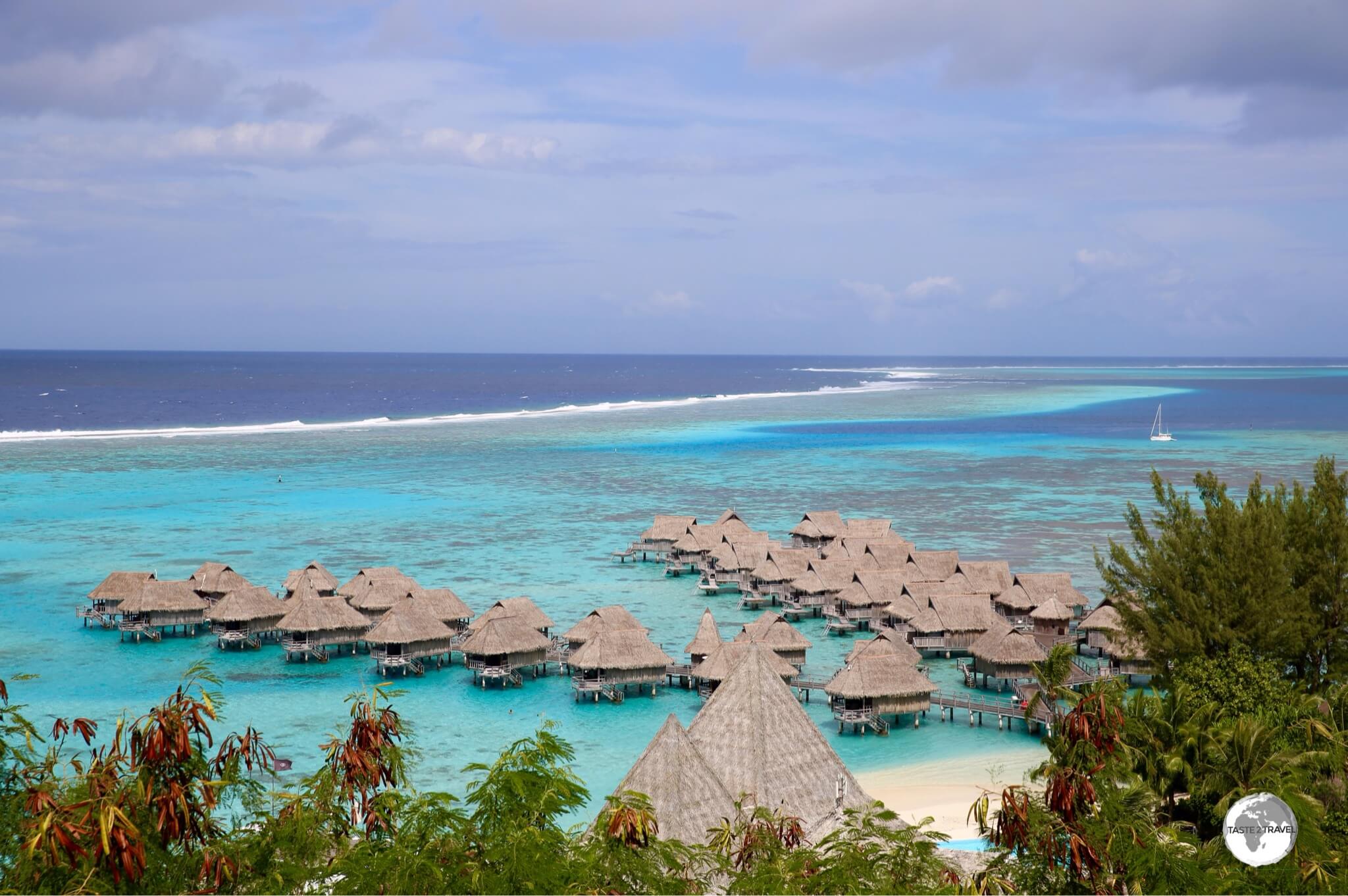
A view of the Sofitel Moorea resort and the stunning lagoon from the lookout.
The first stop was the roadside lookout above the Hotel Sofitel Moorea which provides panoramic views of neighbouring Tahiti, the turquoise lagoon and the over-water bungalows of the resort.
A right-hand turn to a popular public beach lies just beyond the lookout.
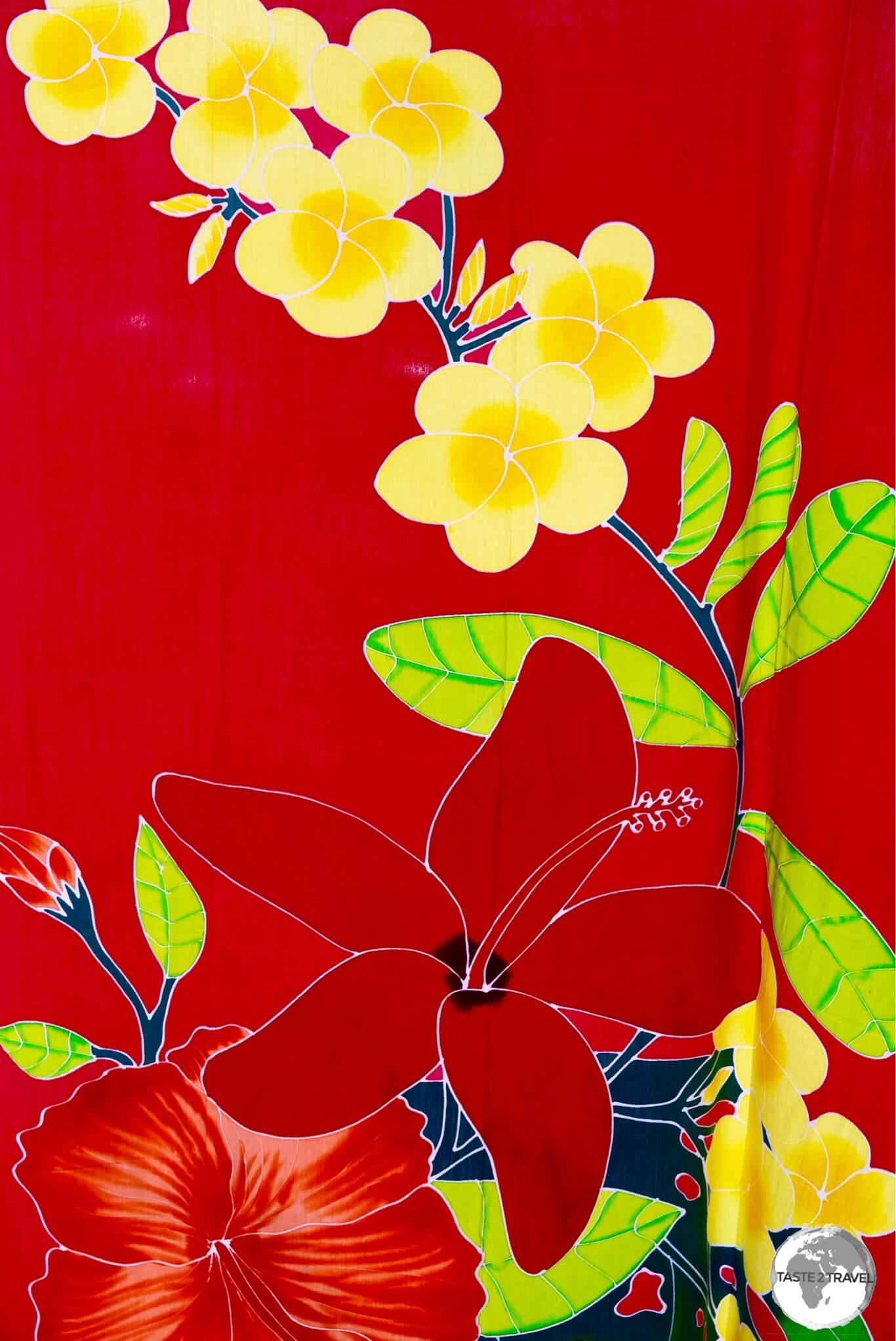
Hand-printed sarong for sale on Moorea.
Beyond the lookout, the road curves to the left, passing the airport before arriving in the small village of Maharepa where I stopped (more than once) to eat at the amazing Café Caraméline (see the ‘Eating Out‘ section below for more on this delicious place).
After Maharepa, the road sweeps to the left, entering the incredibly scenic and narrow Cooks Bay (named after the man himself).
A Detour into the heartland of Moorea
Route des Ananas
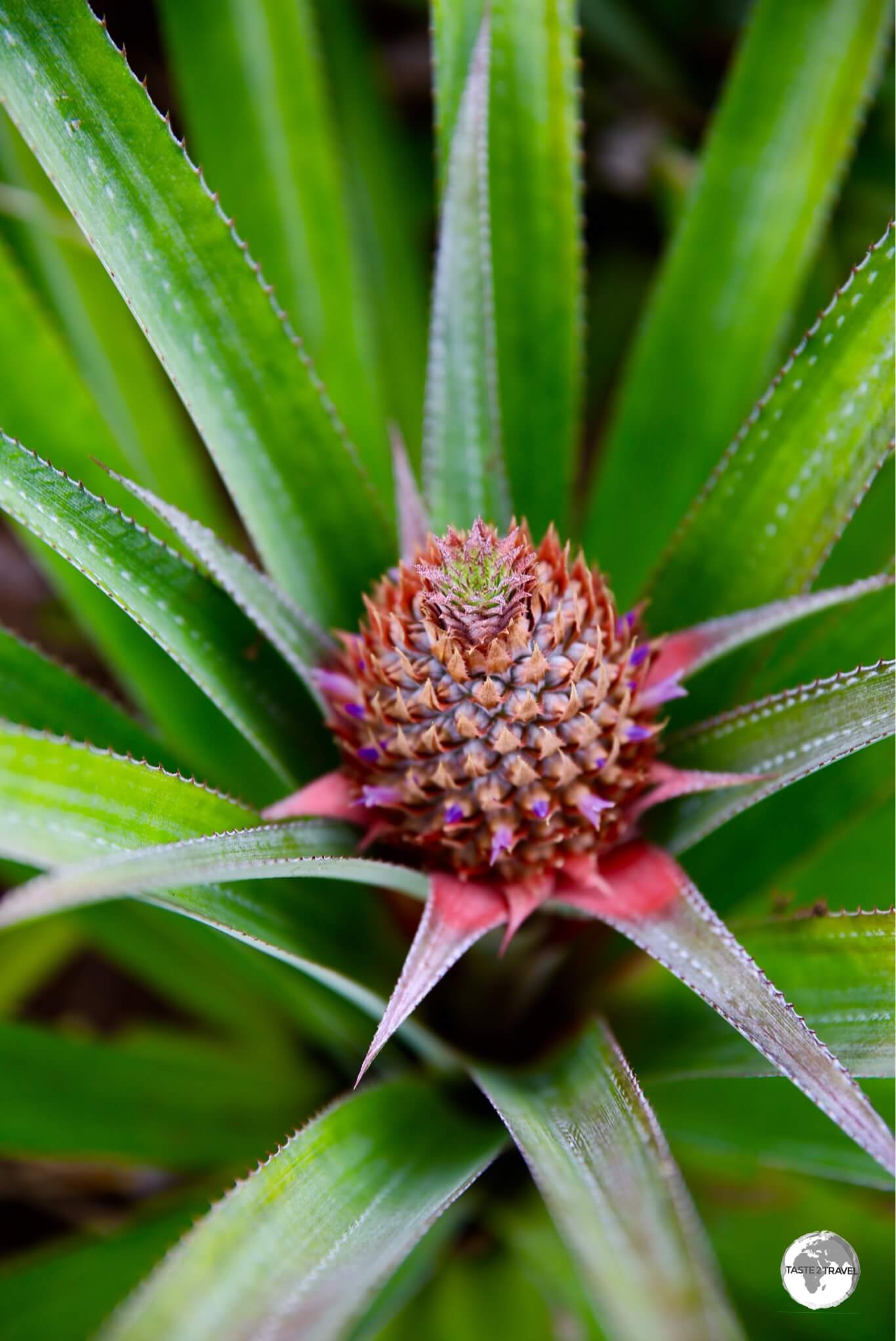
A young pineapple on one of the plantations that line the ‘Route des Ananas’.
From Cooks Bay, a left-hand turn leads off the main ring road and onto the signposted Route des Ananas (The Pineapple Route).
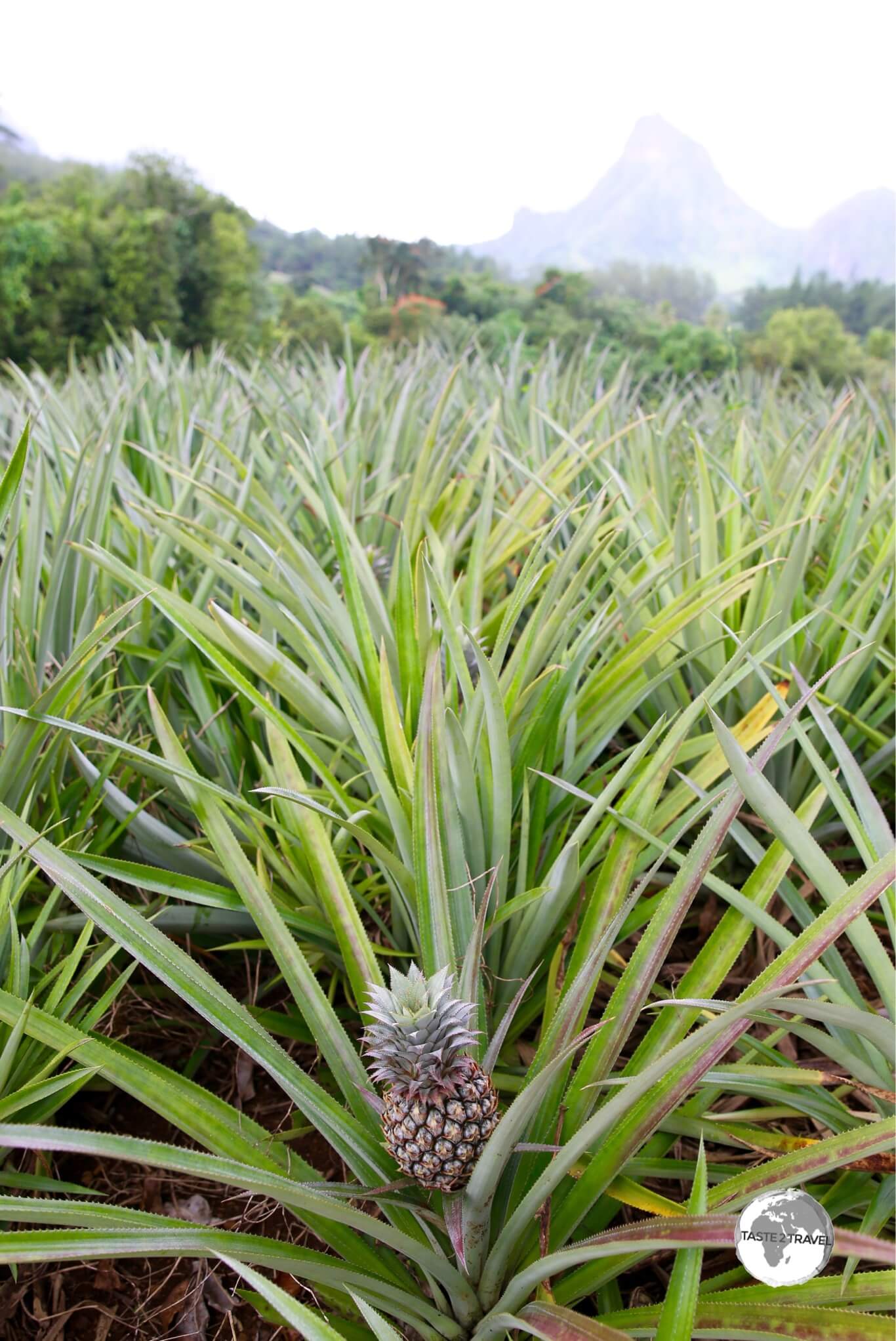
A pineapple plantation on the ‘Route des Ananas’.
Belvedere Lookout
This is one of two roads which provide access to the interior of the island, with the route passing through huge pineapple plantations before joining up with the one other interior road – which winds its way up through many switch-back turns to the lofty Belvedere Lookout.

Created by ancient volcanoes, Moorea is incredibly rugged and beautiful.
The lookout offers breath-taking views of the north coast of Moorea and is the starting point of numerous walking trails which provide access to the jagged peaks and ridges which form the craggy backbone of the island.
Marae Titiroa

The eerily beautiful Marae Titiroa.
Below the lookout, in the densely forested Opunohu Valley, lie an impressive collection of ruins, the largest of which is the (signposted) Marae Titiroa, which is located next to a roadside car park.
The marae, which is surrounded by overgrown Tahitian Chestnut trees, features a stone altar at one end; with small standing stones in the centre of the platform where the chiefs and priests once sat.
When I visited, I had the complex to myself since most visitors to the island are there to enjoy the beach.
Rotui Juice Factory & Distillery
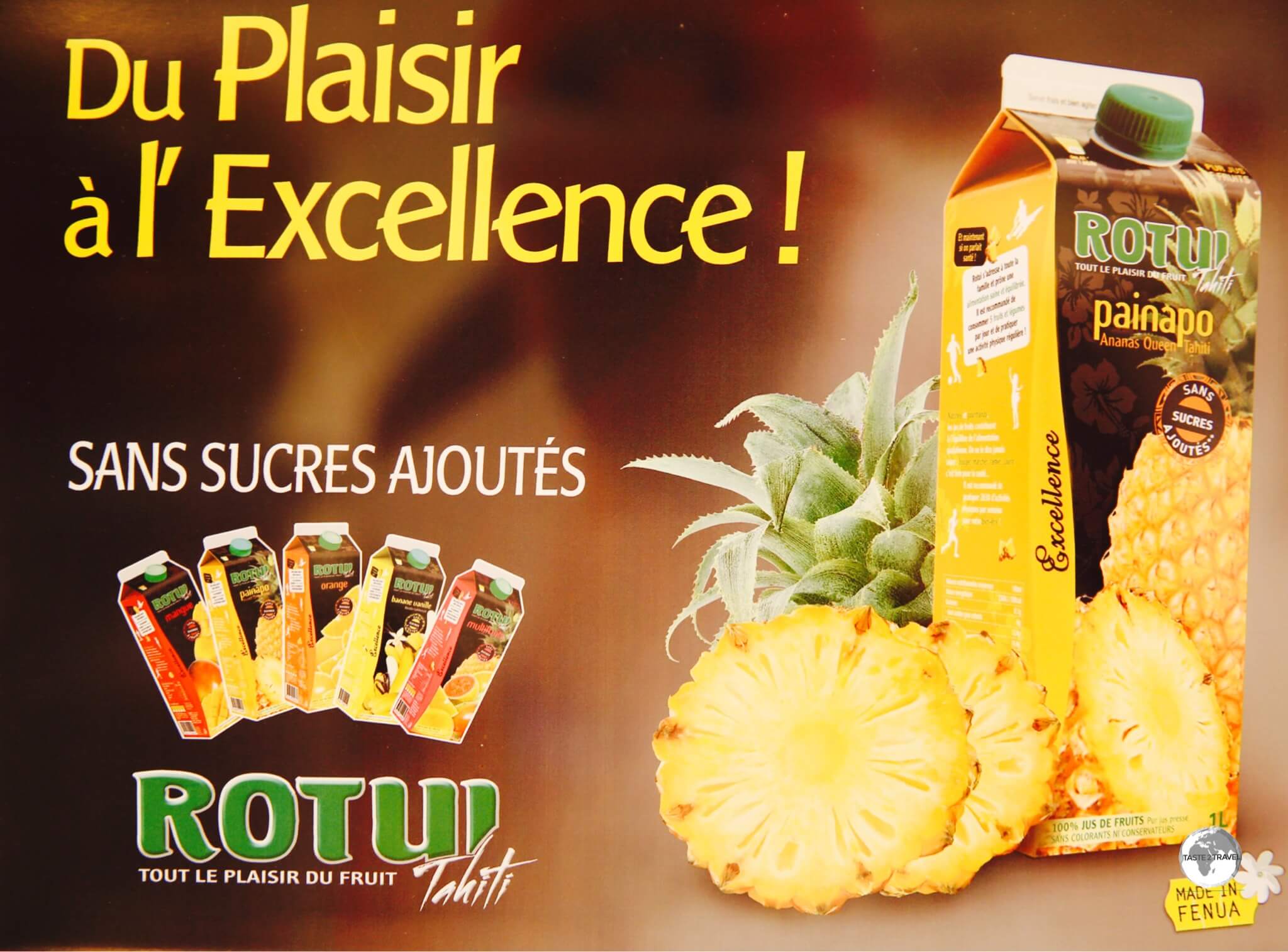
Promotional material at the Rotui Juice Factory.
Back on the main ring road beyond Cooks Bay, a side road in the village of Piha’ena leads to the foot of Mount Rotui and the industrial complex which is the Manutea Tahiti – Rotui Juice Factory & Distillery.
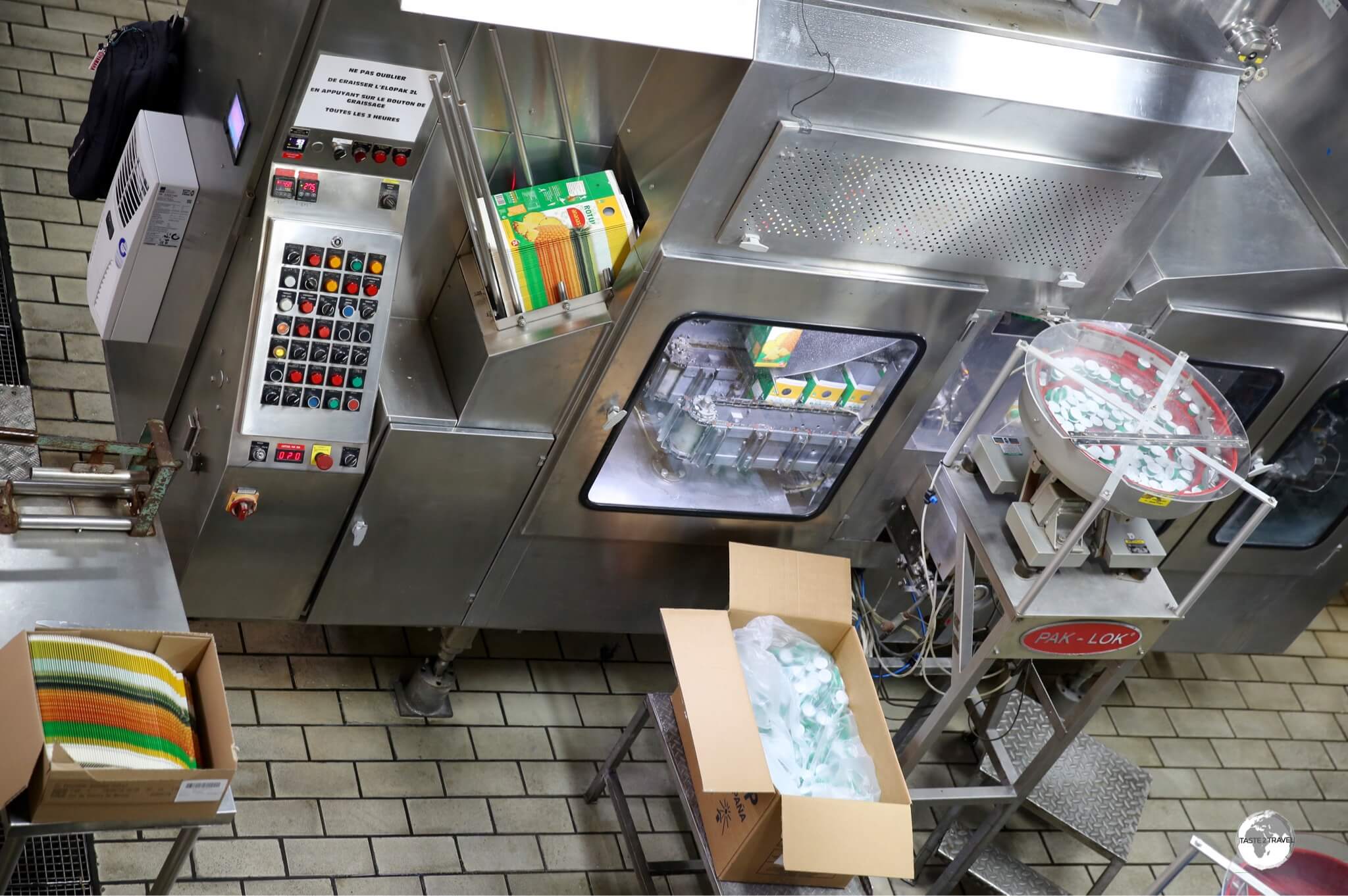
The production line at the Rotui Juice Factory.
This is the company responsible for all the concentrated fruit juice served throughout the territory and a factory visit will shed light on how fresh fruit is turned into carton juice.
Papetoai
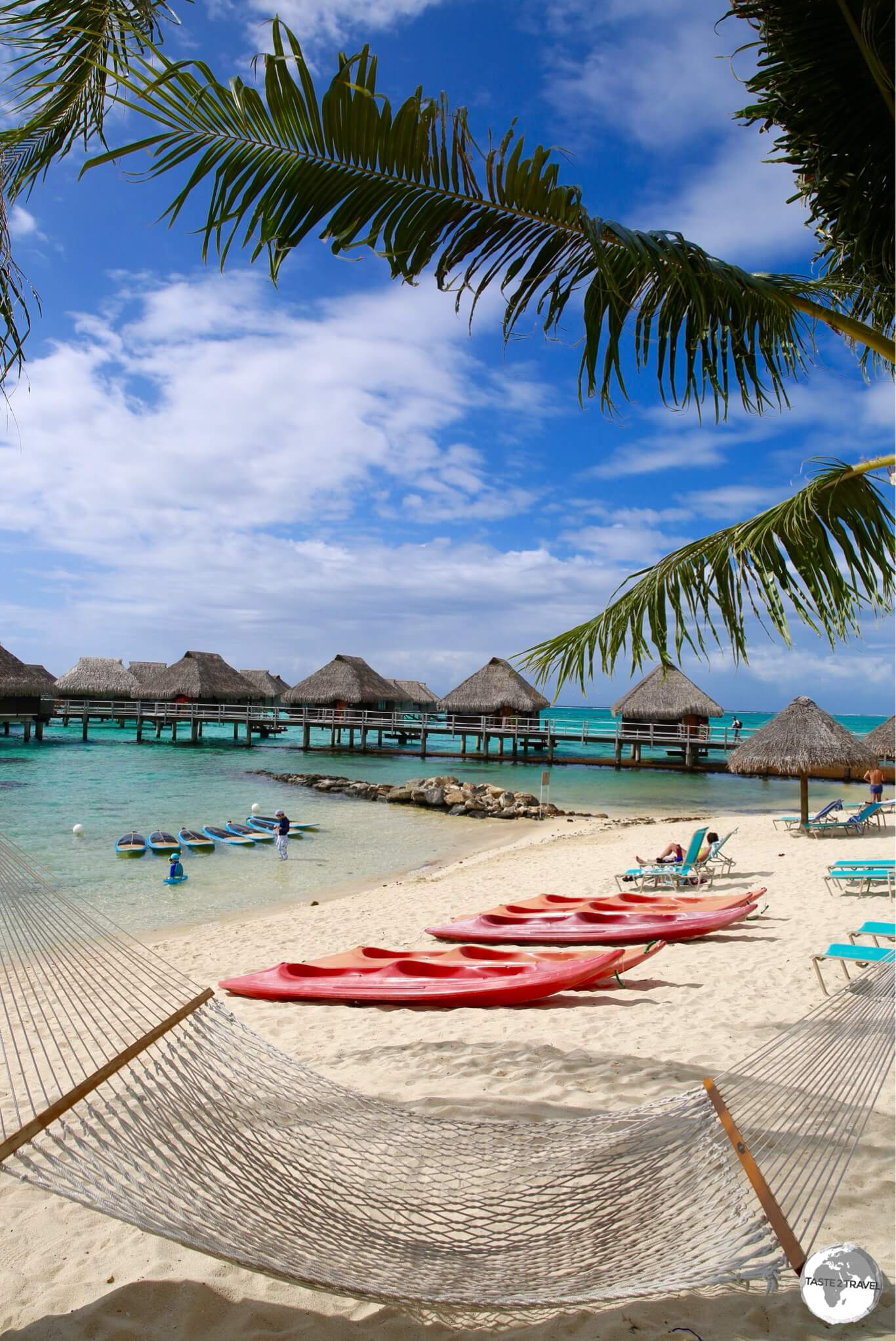
The Hilton Moorea Lagoon Resort.
Back on the ring road, the next deluxe, ‘over-the-water bungalow’ accommodation option is the stunningly located Hilton Moorea Lagoon Resort which is located in the village of Papetoai.
If your budget can’t cover the Hilton, there are some backpacker lodges in the neighbourhood.
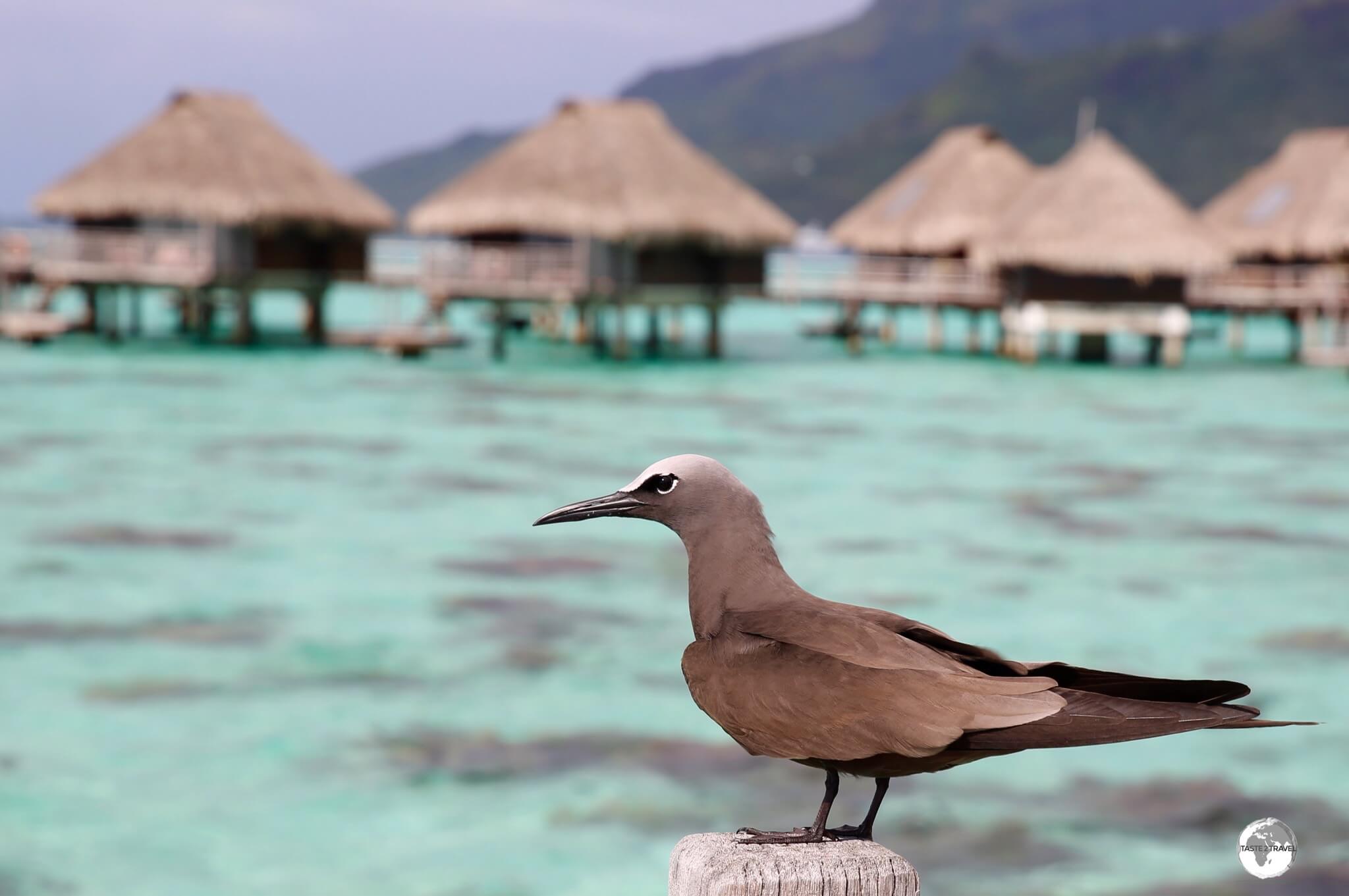
A Brown Noddy at the Hilton Moorea Lagoon Resort.
Further along the north coast, in the village of Tiahura, is the equally impressive Intercontinental Resort Moorea which is home to the highly recommended scuba diving operation – Top Dive (see the following section for more on Scuba diving).

Sunset on Moorea.
Scuba Diving
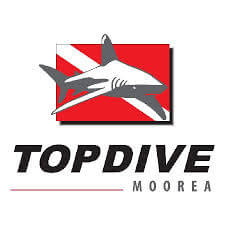
‘Top Dive’ did provide a top diving experience.
While on Moorea, I went scuba diving with the professional and competent team from Top Dive, who operate out of the Intercontinental Resort Moorea.
The warm waters of the lagoon offer an abundance of marine life, including Lemon sharks, lots of colourful coral and visibility that has to be seen to be believed – excuse the pun!
Video:
I filmed the following video of a cruising Lemon shark on one of my dives with Top Dive – magic stuff!
Gambier Islands
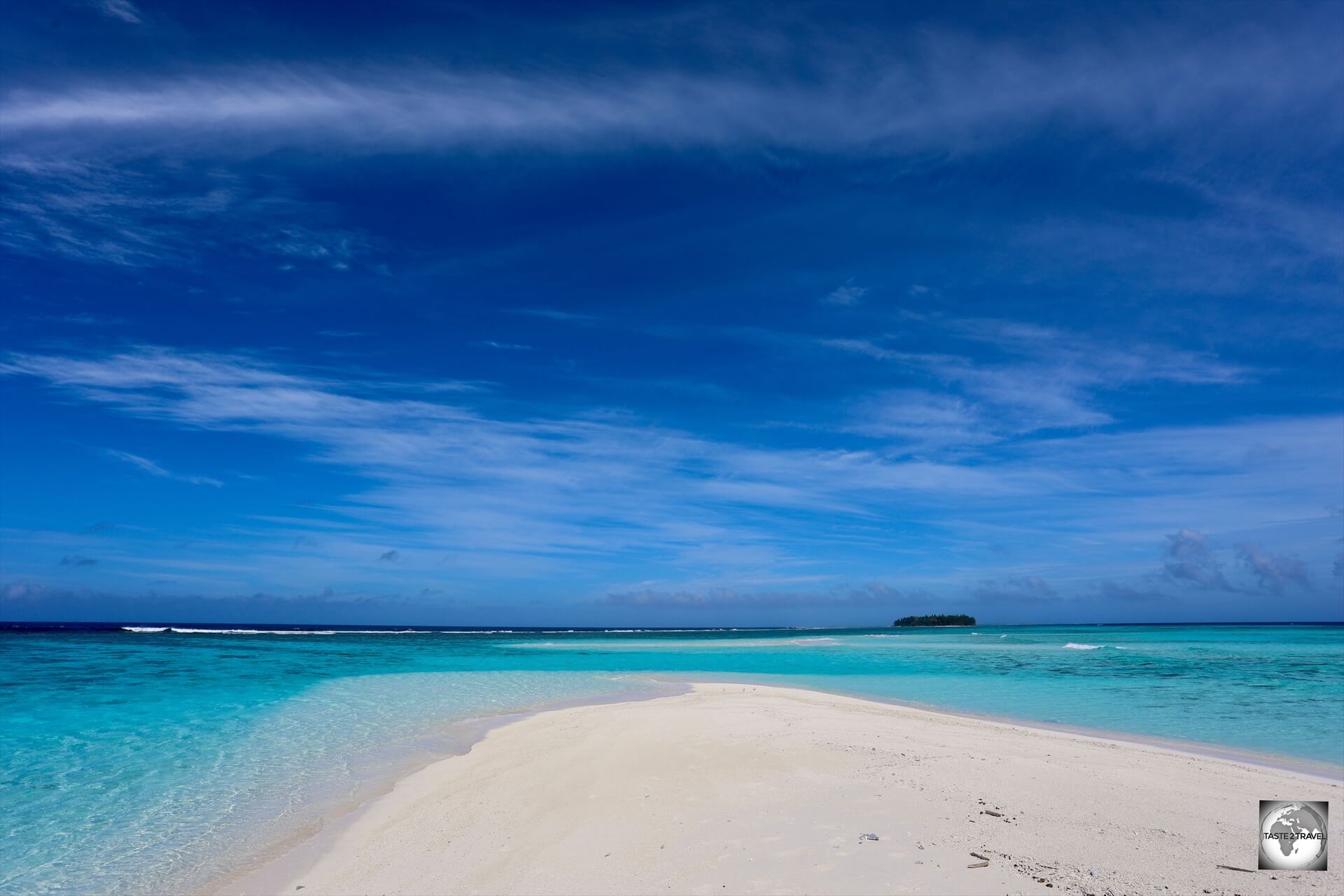
Bird Island, a small coral atoll, is one of the 14 islands which comprise the Gambier Islands.
Lying 1,674 km to the east of Papeete, the Gambier Islands are the furthest archipelago from Tahiti and the most isolated.
There is a one-hour time difference between the Gambier Islands (UTC-9) and Tahiti (UTC -10).
This group of, small, mostly uninhabited, islands occupy a 24 km2, turquoise, lagoon which is extraordinarily beautiful.
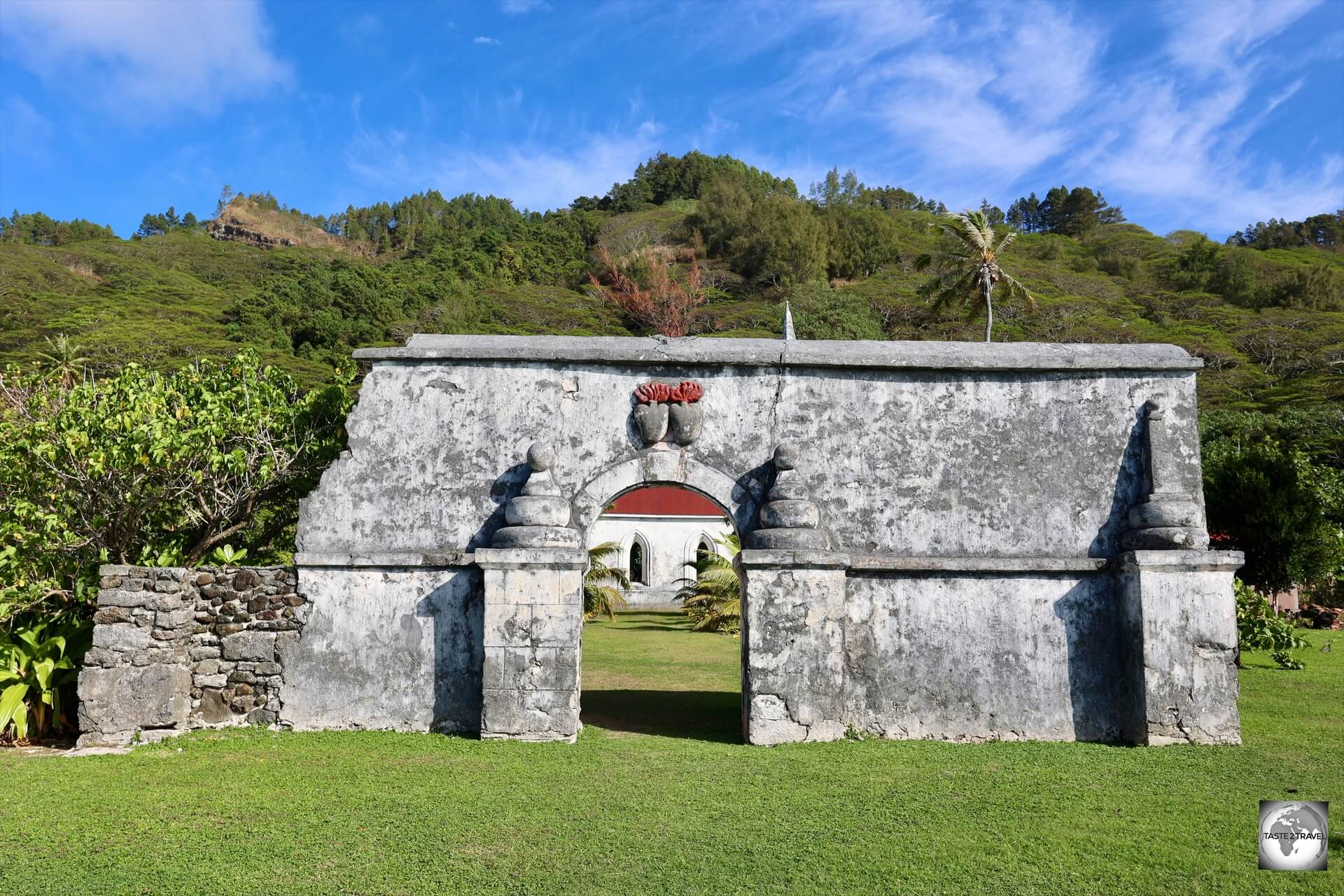
A fragment of an old wall on Taravai Island, which offers a view of the Church of Saint-Gabriel and the twin hearts of Les Sacrés-Coeurs de Picpus.
The lagoon is the centre of black pearl production in French Polynesia.
The only town in the archipelago is Rikitea (pop: 1,300 souls) which is located on the main island of Mangareva.
In terms of tourism, the Gambier Islands are the least visited islands in French Polynesia.
Reached on twice weekly flights (Tuesday and Saturday) from Papeete, the US$886 (return) flight ticket ensures that only the most dedicated visit this remote corner of French Polynesia.
The archipelago is served by Totegegie Airport (IATA: GMR) which is located on an uninhabited coral atoll, a 40-minute ferry ride from Mangareva.
There is also a complete lack of accommodation options on the islands, with just a few basic homestays available on Mangareva.
Mangareva Banking Services:
Bring all the cash you’ll need from Papeete.
There are no banks or ATM’s anywhere in the Gambier Islands and credit cards are not accepted anywhere.
Tip:
Since there’s no access to cash anywhere on Mangareva, it’s best to book and pay for your accommodation online, using Airbnb, thereby taking care of your major expense on Mangareva.
For more information, please refer to the ‘Accommodation‘ section below.
Mangareva Island
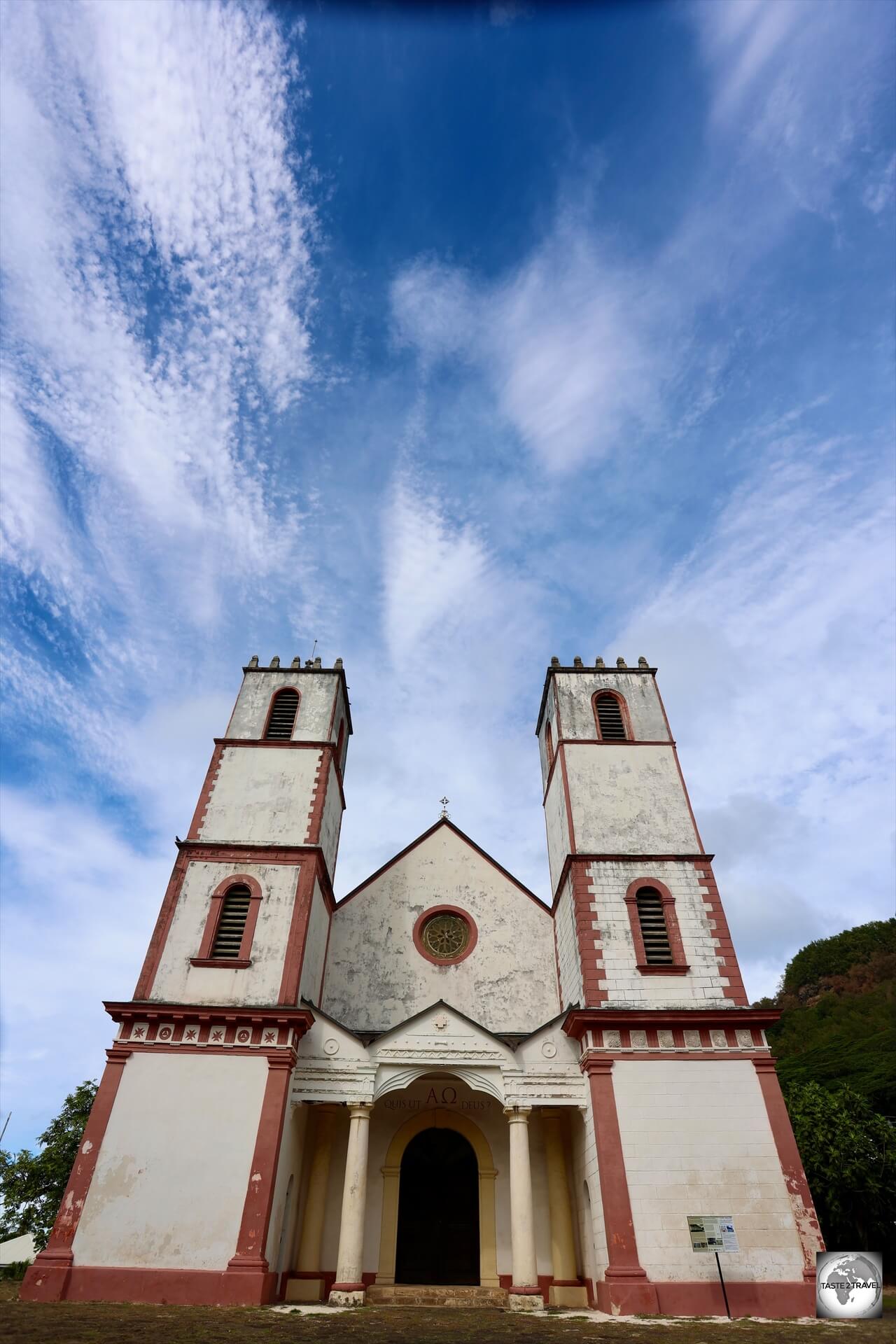
St. Michael’s Cathedral, the largest church in the South Pacific is a highlight of Mangareva.
Sleepy Mangareva is the central and largest island of the Gambier Islands in French Polynesia.
The island is approximately eight kilometres (5 mi) long and, at 15 km2 it comprises about 56% of the total land area of the Gambier Island group.
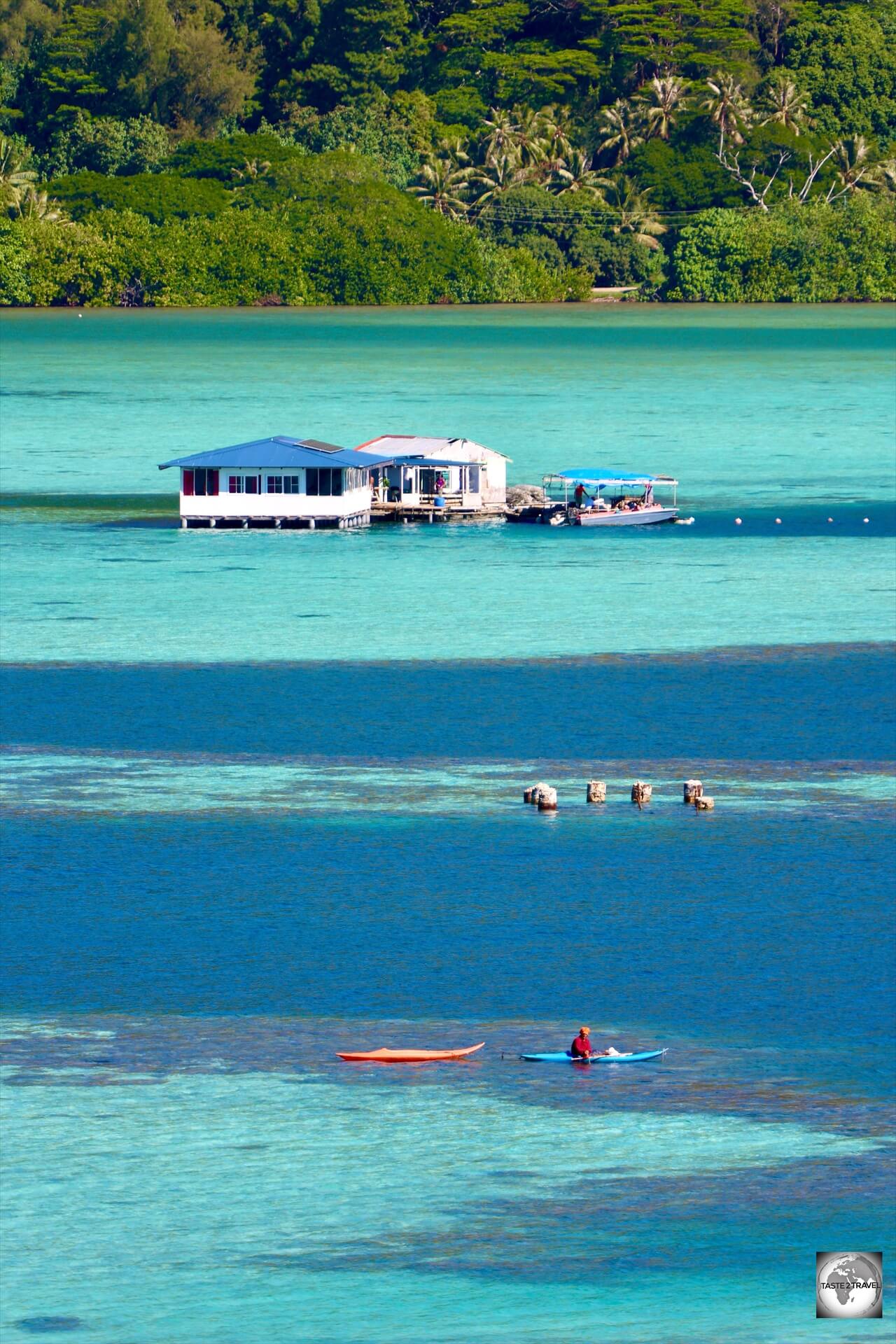
A view of the lagoon at Mangareva Island, the main island of the Gambier archipelago.
A single, 28-km long, road follows the coast around the island, offering stunning views of the lagoon and the many distant motu’s (flat reef islets).
Mangareva has a permanent population of 1,300 – with almost everyone living in the one town of Rikitea.
Everyone knows everyone here. It’s one big family!
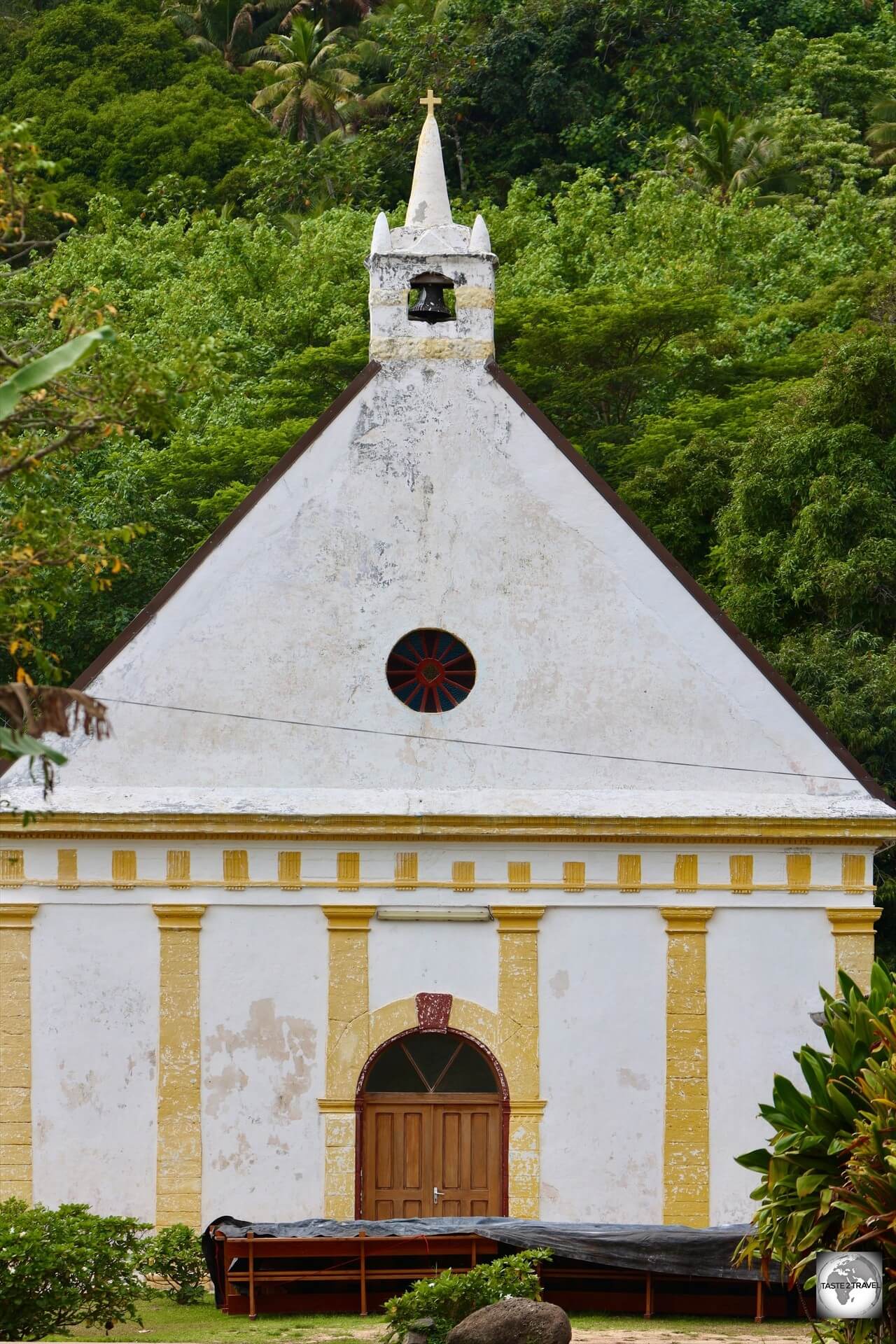
One of many historic churches on Mangareva Island.
In terms of tourist infrastructure, there is hardly any!
A few family homestays provide basic accommodation, while the only dining options are a couple of rudimentary snack shops in Rikitea which close up at 1 pm.
If you are looking for an authentic French Polynesian travel experience, in a place far from the commercial trappings of Tahiti, then the Gambier Islands are the perfect destination.
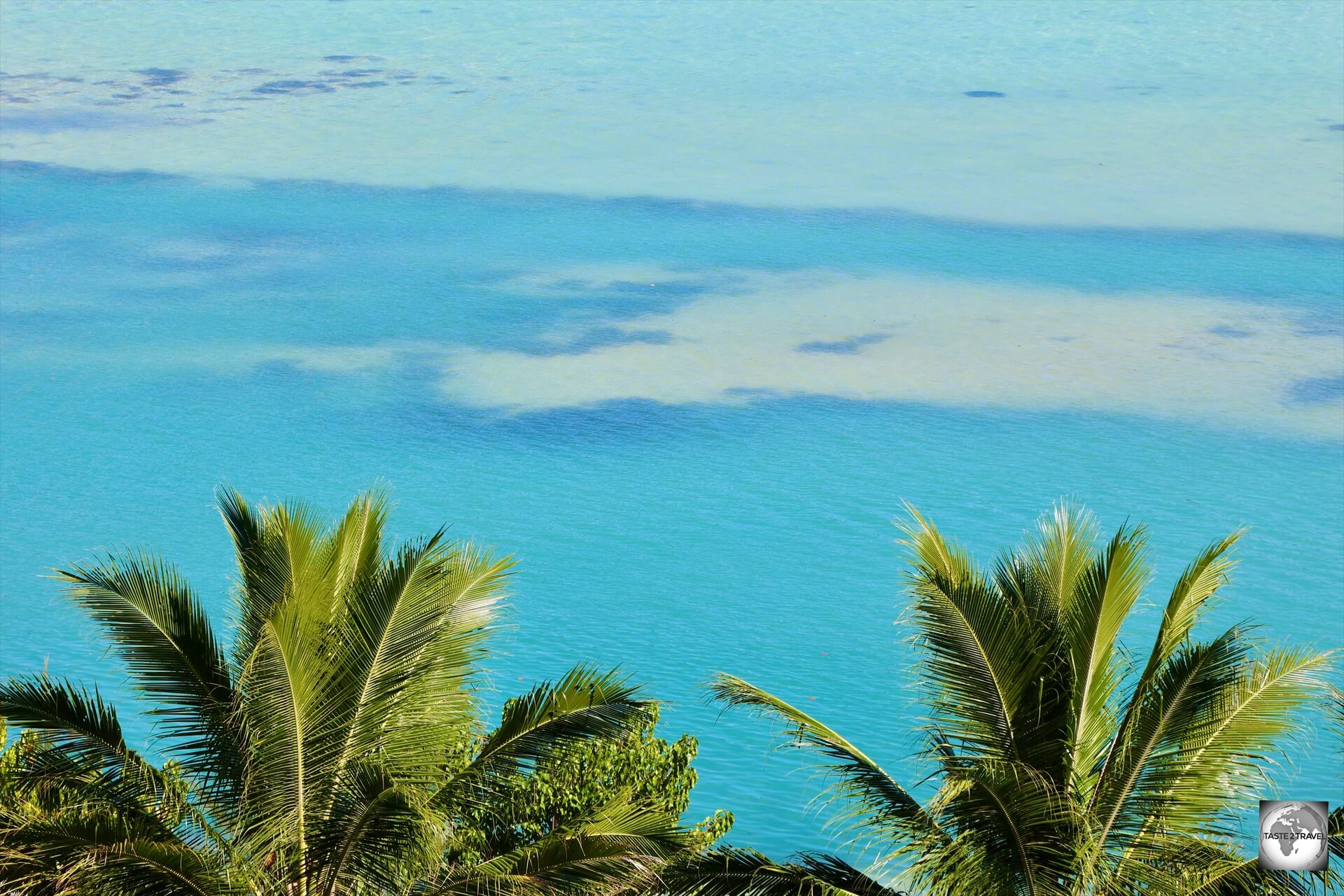
A view of the turquoise waters of Mangareva Lagoon.
The easiest way to explore Mangareva is with a rental car which will cost €50 per day. I hired a car through my guest house.
The sights of the island can be easily covered in half a day.

Exploring the island of Mangareva in my rental car.
The highest point in the Gambier’s is Mount Duff, on Mangareva, rising to 441 metres (1,447 ft) along the island’s south coast.
Video:
Driving on Mangareva Island in my rental car.
The island is heavily wooded and is a favourite nesting site for migratory seabirds such as White terns, Frigate birds and Brown noddy’s.
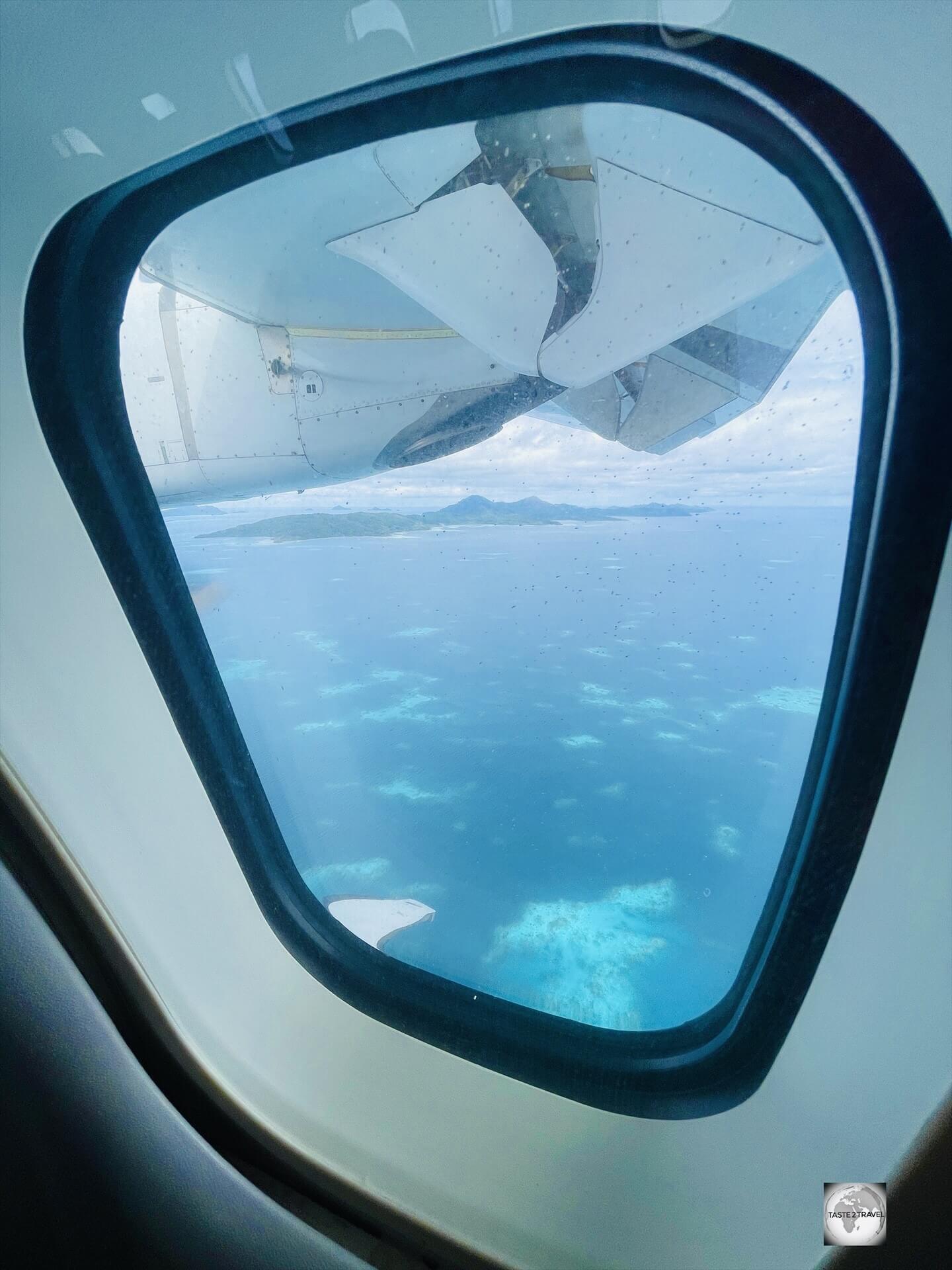
A view of Mangareva Lagoon from my Air Tahiti flight.
Mangareva is surrounded by a lagoon which is 24-km (15 mi) in diameter, containing reefs whose fish and shellfish helped ancient islanders survive much more successfully than on nearby islands with no reefs.
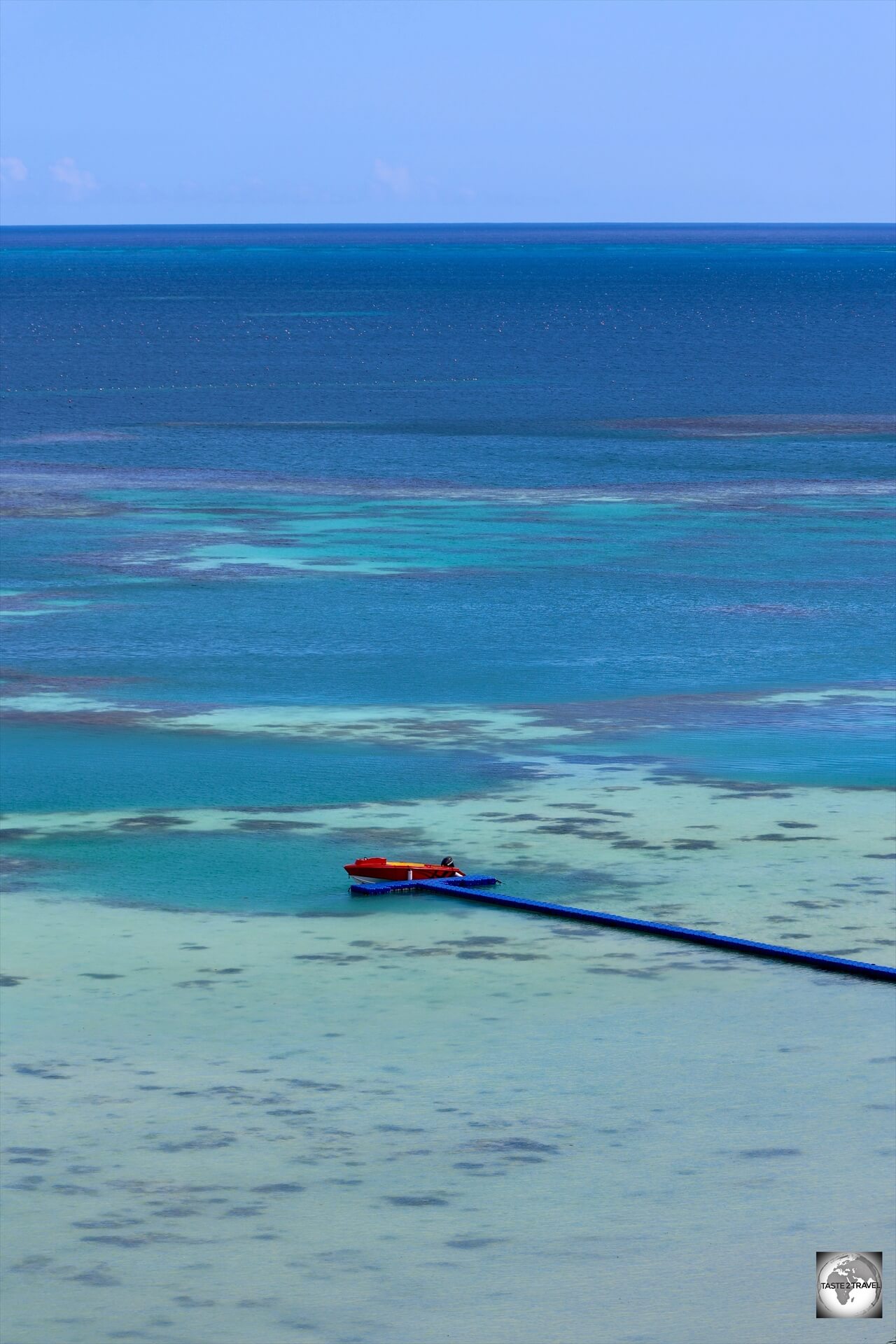
A view of the lagoon at Mangareva Island, the centre of black pearl production in French Polynesia.
The lagoon is the main centre of black pearl production in French Polynesia, with most pearls finding their way to expensive shops in Papeete.
A small number of retailers in Rikitea (opposite the Gendarmerie office) sell black pearls for prices much lower than what you’ll pay in Papeete.
European Influence
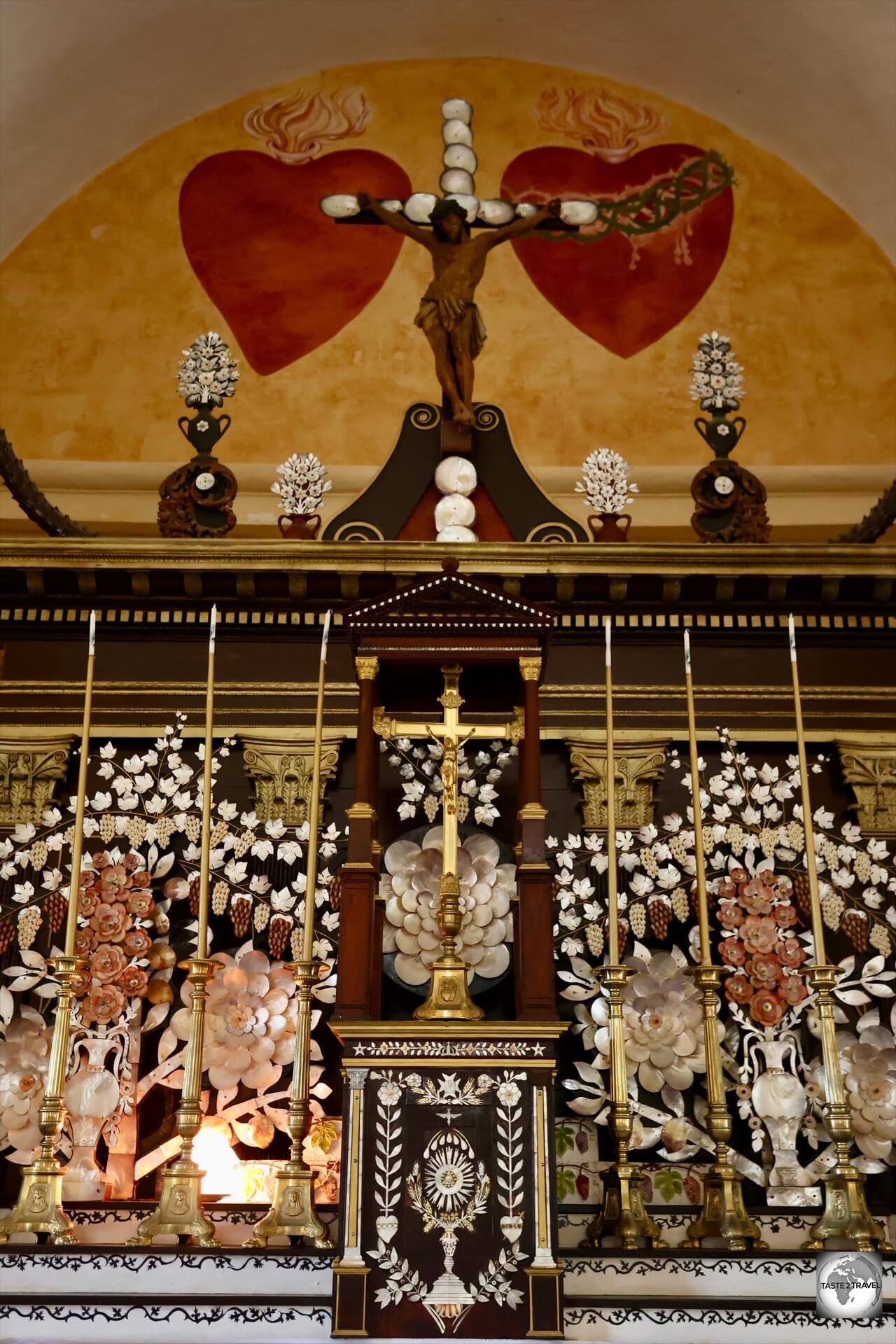
A highlight of Mangareva is the ornate altar at St. Michael’s Cathedral, which is adorned with mother-of-pearl and black pearls.
A significant change in the culture of the local Polynesian population in the Gambier archipelago was inaugurated by the French-Catholic missionaries, Father Honoré Laval and Father François Caret, of the Congregation for the Sacred Hearts who came to Mangareva in 1834.
When the missionaries arrived, they counted 2,124 souls. Increasing contact with the outside world brought contagious diseases to Mangareva savagely decimating the population.
There had already been several major epidemics before 1863, including one which is said to have killed half the population.
At first the missionaries met with opposition, but after King Te Ma-puteoa and his chiefs became converted, the whole population followed suit.
Father Laval acquired an extraordinary influence over the people. The traditional open temples were dismantled and the wooden images of their gods were burnt, except a few that were sent back to Europe.
Father Laval built 116 stone buildings and arches, and roads were laid.
Buildings included schools, convents, churches, a fortified palace as well as St. Michael’s Cathedral which has been characterised as a folly.
The structures were built with shaped coral stone blocks.
On the site of the former Te Keika marae in Rikitea, St. Michael’s Cathedral (the largest church in the South Pacific), was constructed in stone, and the cut coral blocks that had formed the bench along the front of the marae were included.
The local people became expert stone masons, and the chiefs had stone houses built for themselves.
Whenever Father Laval wanted to construct of a new church, in order to gain approval from King Te Ma-puteoa, he would offer to build the king a stone palace next to the church.
Such palaces can be seen today in Rikitea (in the adjacent school yard) and on Akamaru Island.
Stone is a fitting material for temples and churches but not for dwelling houses in the hot and humid climate of Polynesia.
St. Michael’s Cathedral still functions, but today the stone palace of Te Ma-puteoa and the stone houses of the chiefs in the various villages are roofless and deserted.
Father Caret is buried inside St. Michael’s Cathedral in Rikitea.
Sights
St. Michael’s Cathedral
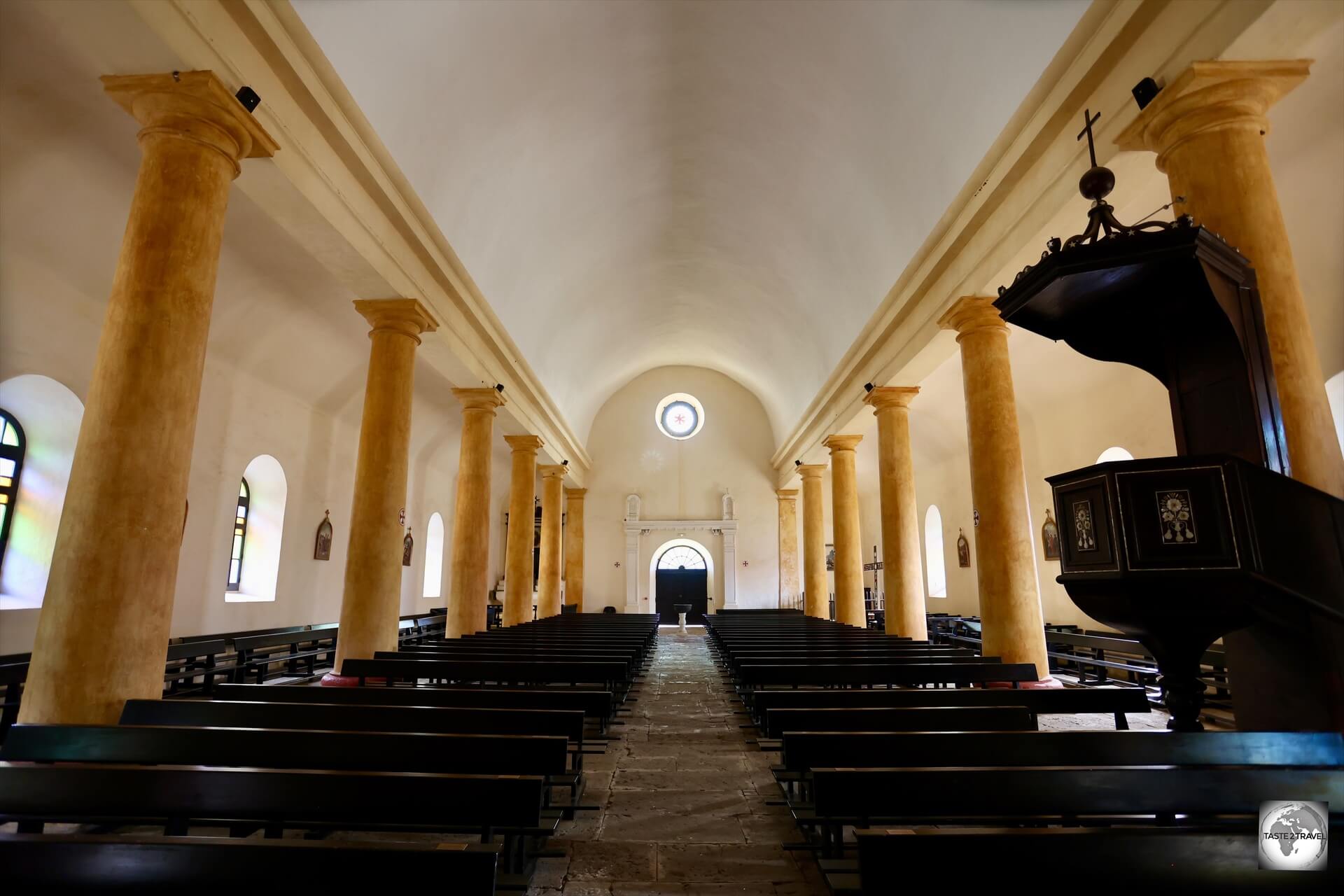
The largest church in the South Pacific, St. Michael’s Cathedral features 18 ochre columns which support the central vault.
The highlight of Rikitea is St. Michael’s Cathedral, the largest church in the South Pacific and the first church to be built in French Polynesia.
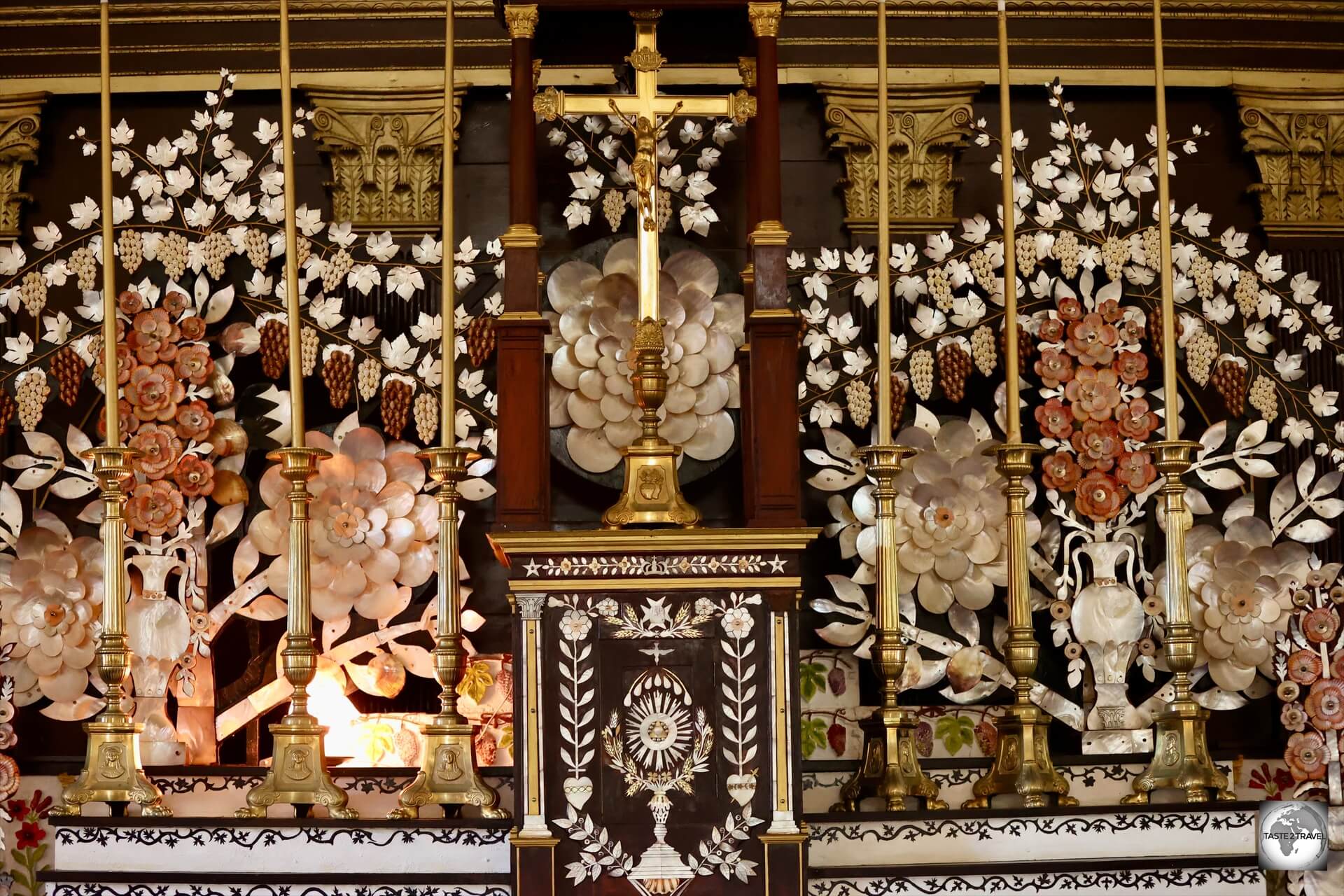
A highlight of St. Michael’s Cathedral in Rikitea is the ornate altar, which features Mother-of-pearl, shells and black pearls.
The islands are home to many historic churches, which were constructed by Father Laval and Father Caret, of the Congregation of the Sacred Hearts of Jesus and Mary.
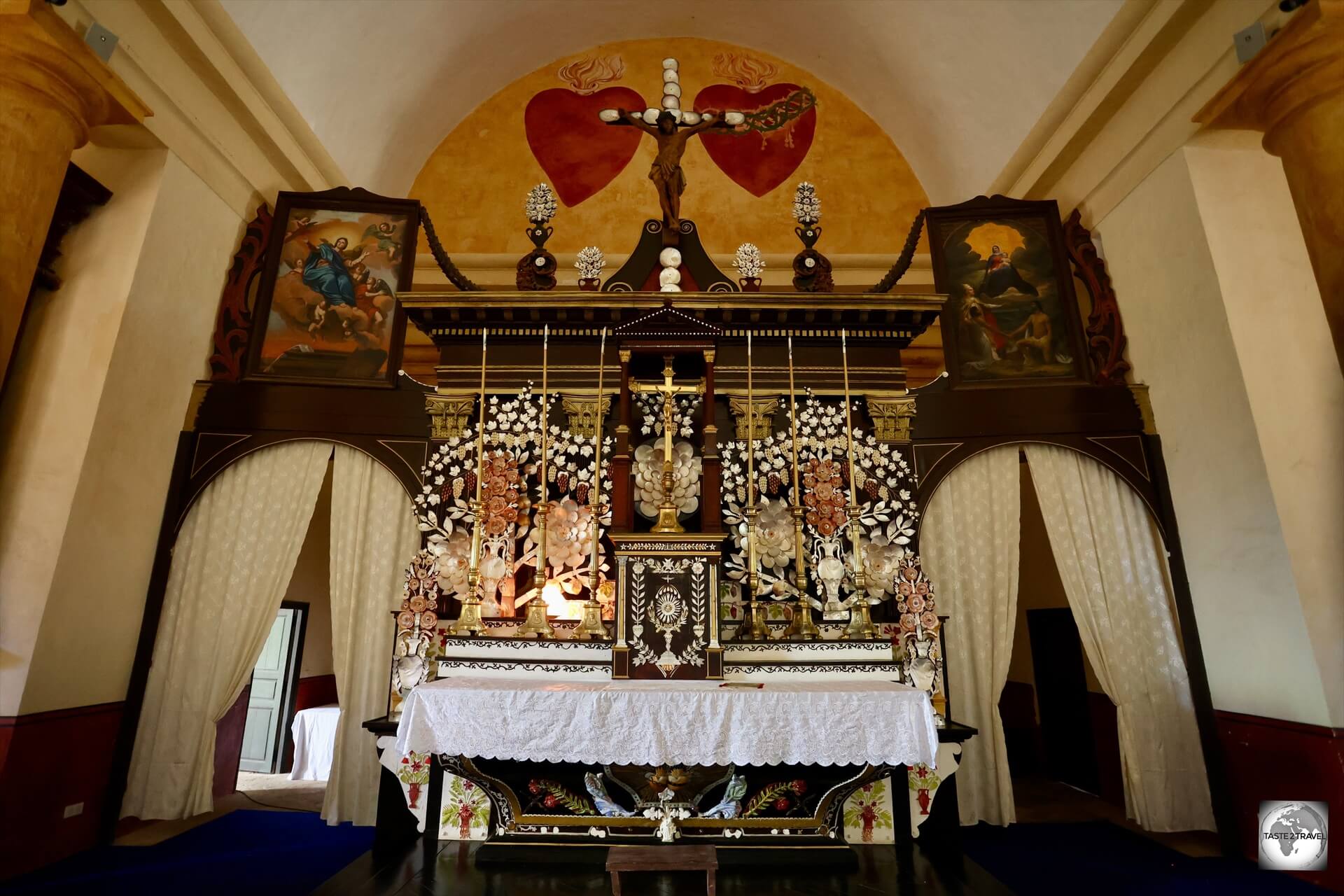
The prized altar at St. Michael’s Cathedral features mother-of-pearl, black pearls, shells and more.
St. Michael’s Cathedral was built at a brisk pace between 1839 and 1848 and served as the principal church in the Gambier Islands and in all of French Polynesia.
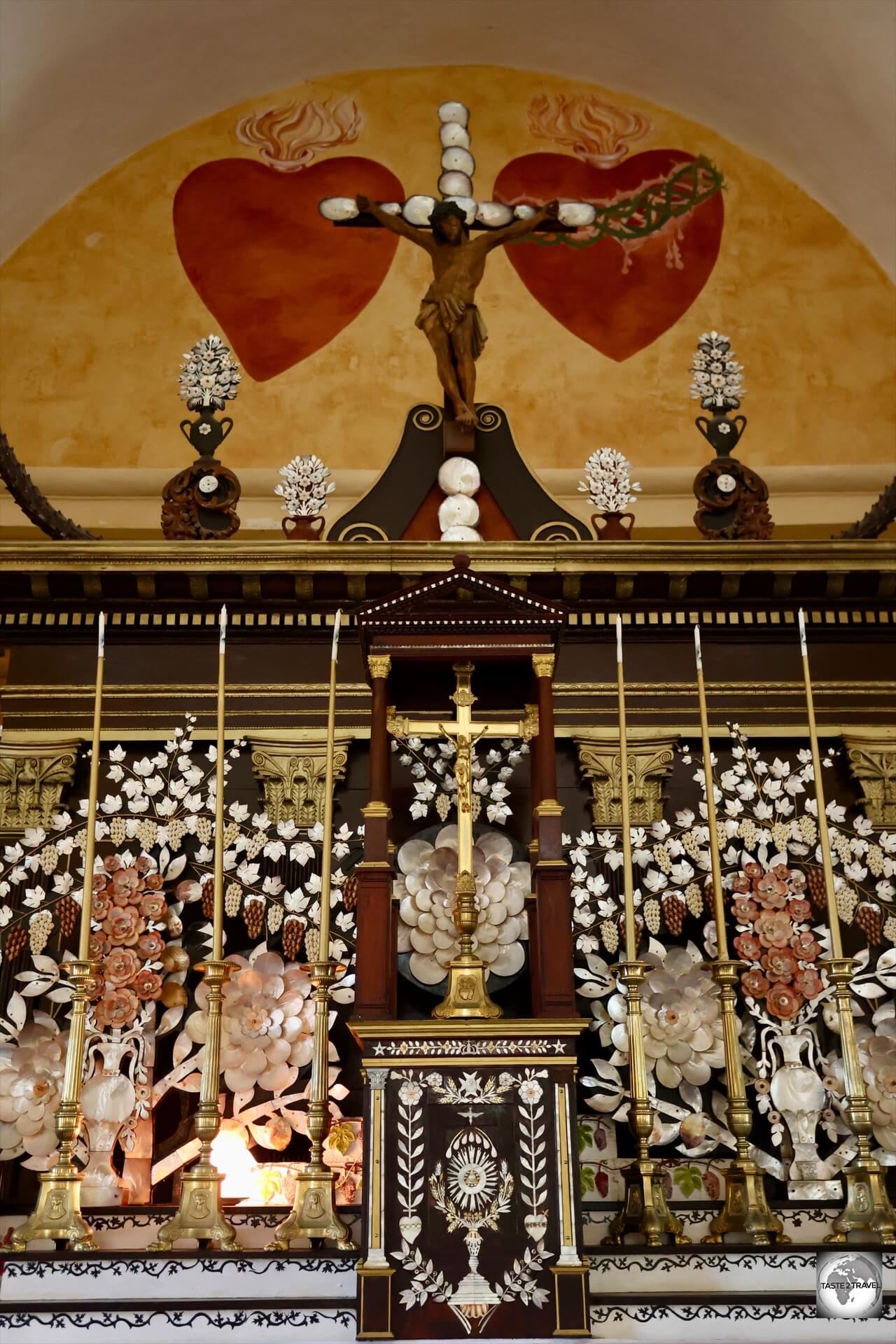
St. Michael’s Cathedral was constructed by missionaries of the Congregation of the Sacred Hearts of Jesus and Mary.
Father Laval’s intention was to be able to gather the entire population of Mangareva under one roof for mass.
Laval managed to convince the local chief, King Te Ma-puteoa, of its necessity by using its construction to also erect the nearby palace.
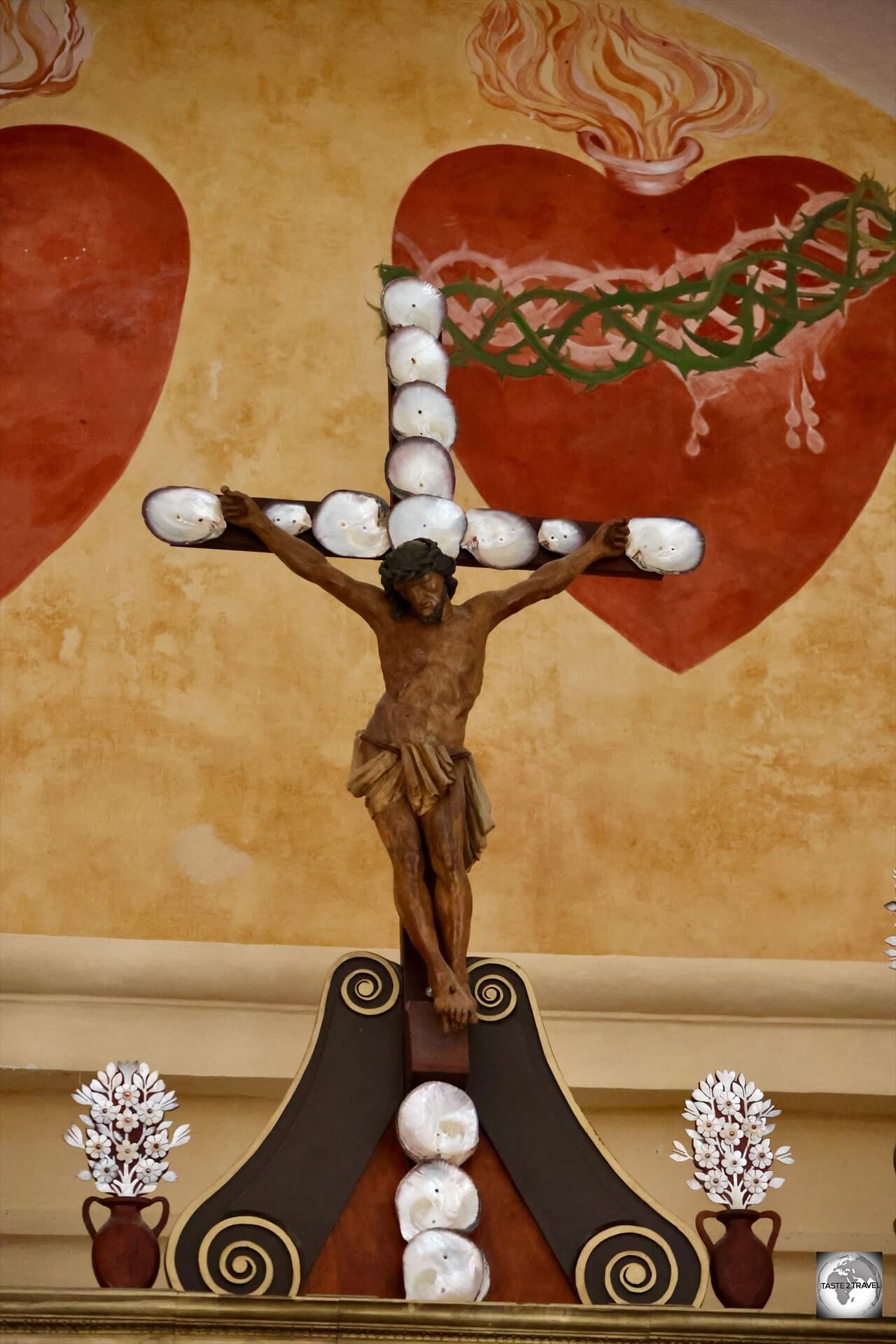
The cross which adorns the altar of St. Michael’s Cathedral is covered in oyster shells.
The cathedral is built entirely out of coral stone and lime from a quarry 16 km from Rikitea.
The building, which is built from coral rock, measures 48 metres (157 ft) in length, is 18 metres (59 ft) wide, and rises to a height of 21 metres (69 ft). It can seat 1200 people.
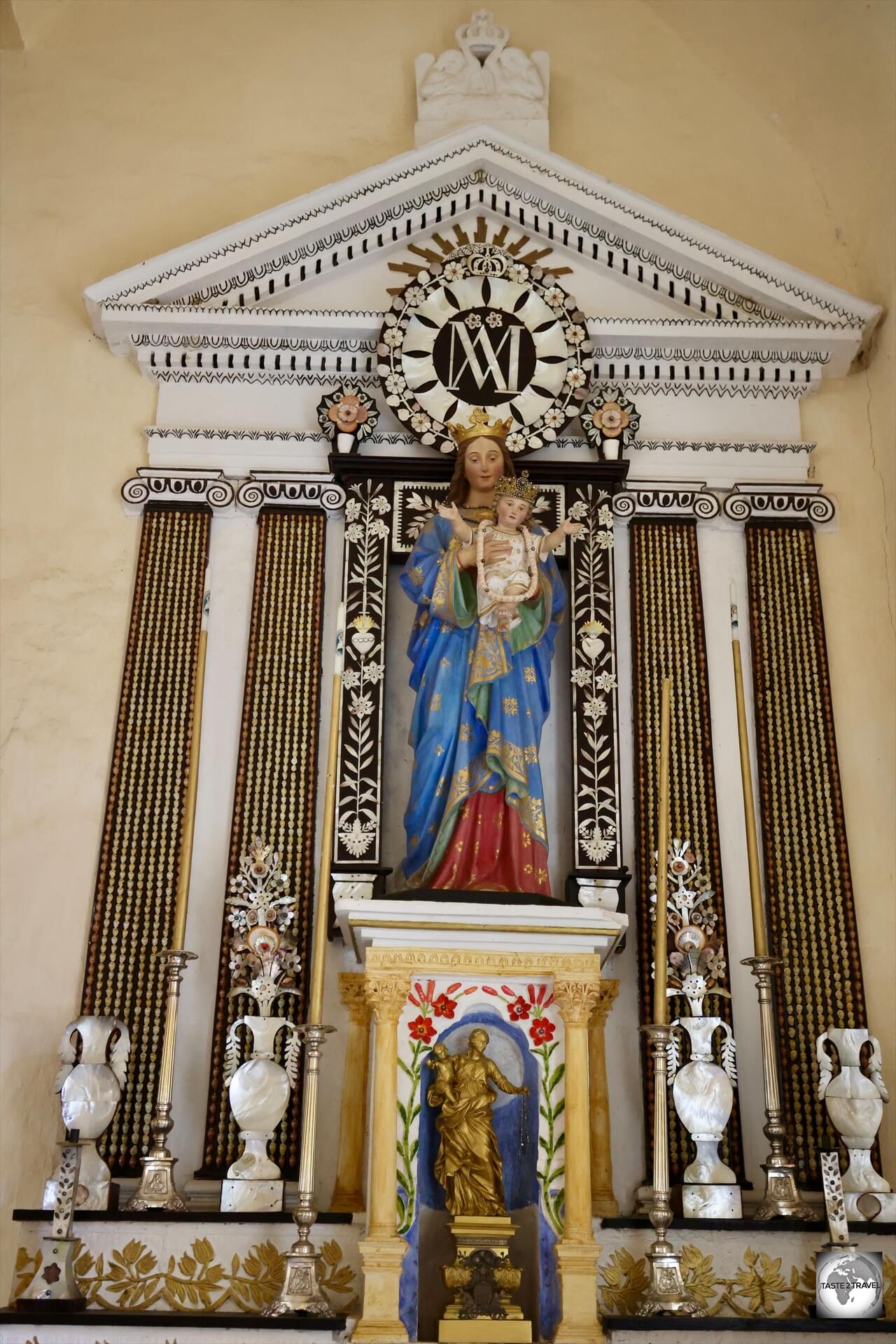
A statue of the Virgin Mary at St. Michael’s Cathedral, surrounded by mother-of-pearl, shells and black pearls.
The church is thrice the size of the Notre Dame Cathedral in Papeete!
The interior is composed of an impressively large vault which is constructed from reeds, coconut husks and coral lime.
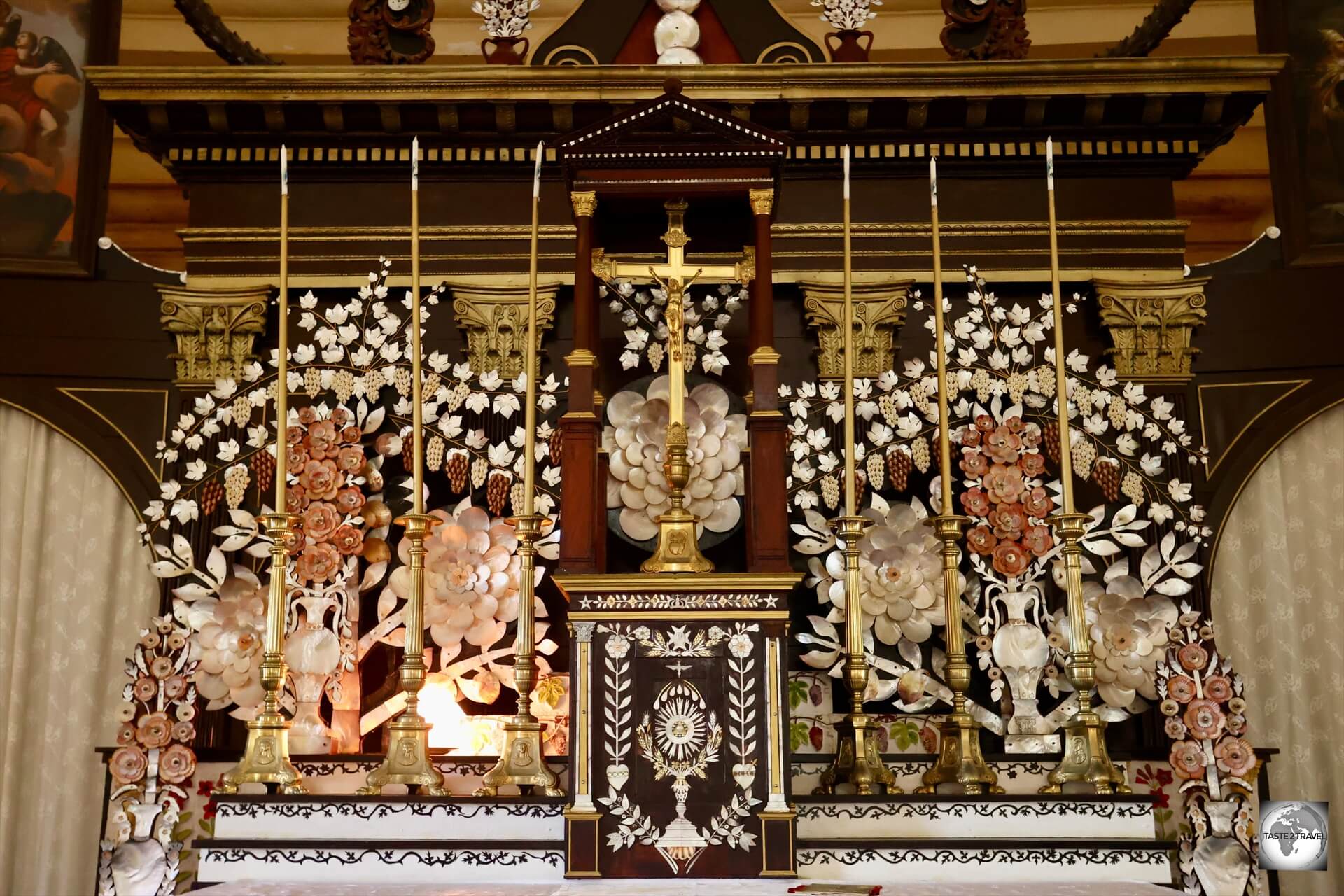
A view of the ornate altar at St. Michael’s Cathedral on Mangareva.
What is especially striking about the cathedral is the decoration of its truly ornate altar.
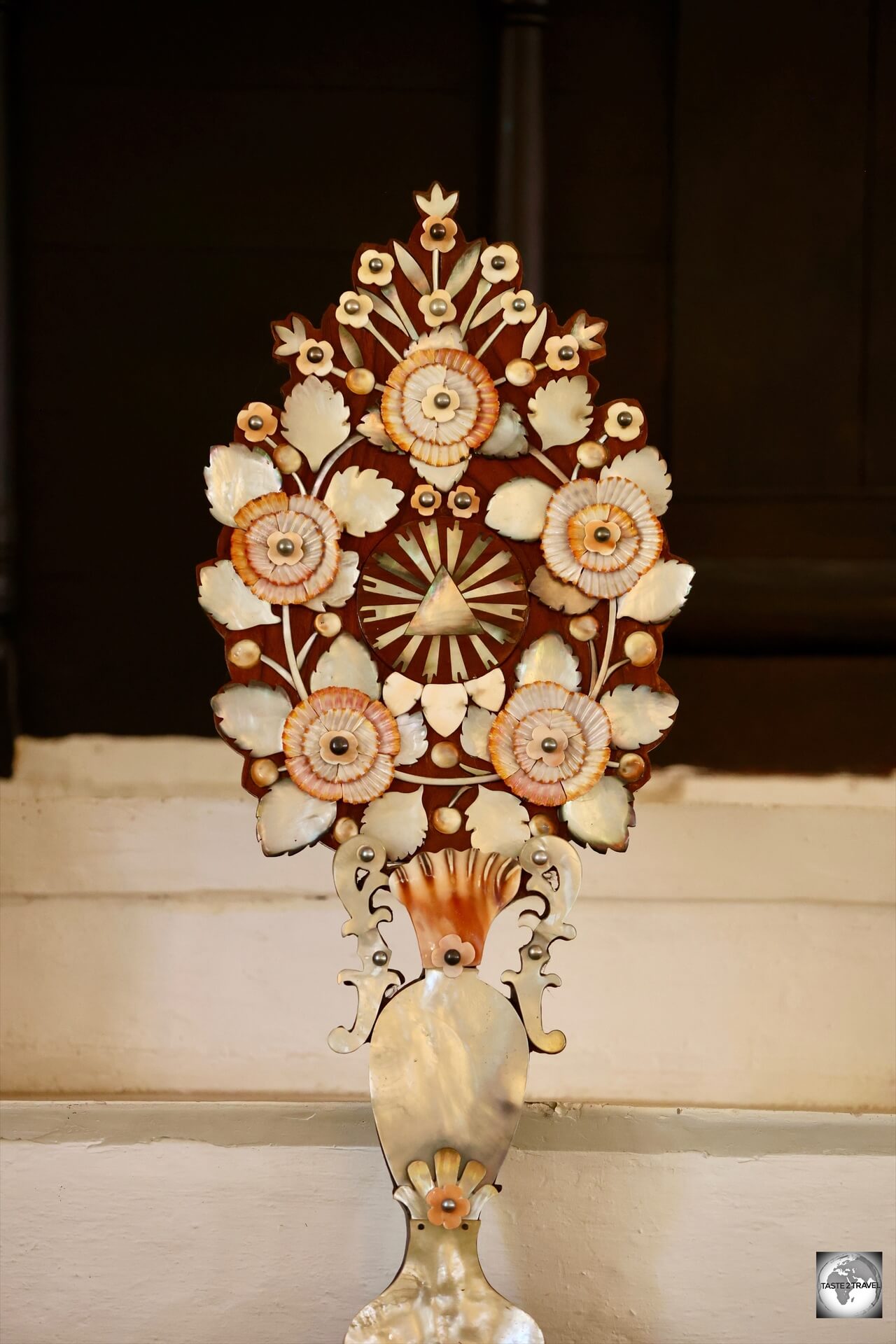
Mother-of-pearl flowers, with black pearls at their centre, decorate the altar at St. Michael’s Cathedral in Rikitea.
Adorned by hundreds of black pearls and mother-of-pearl shells, there is nothing quite like it anywhere in the Pacific.
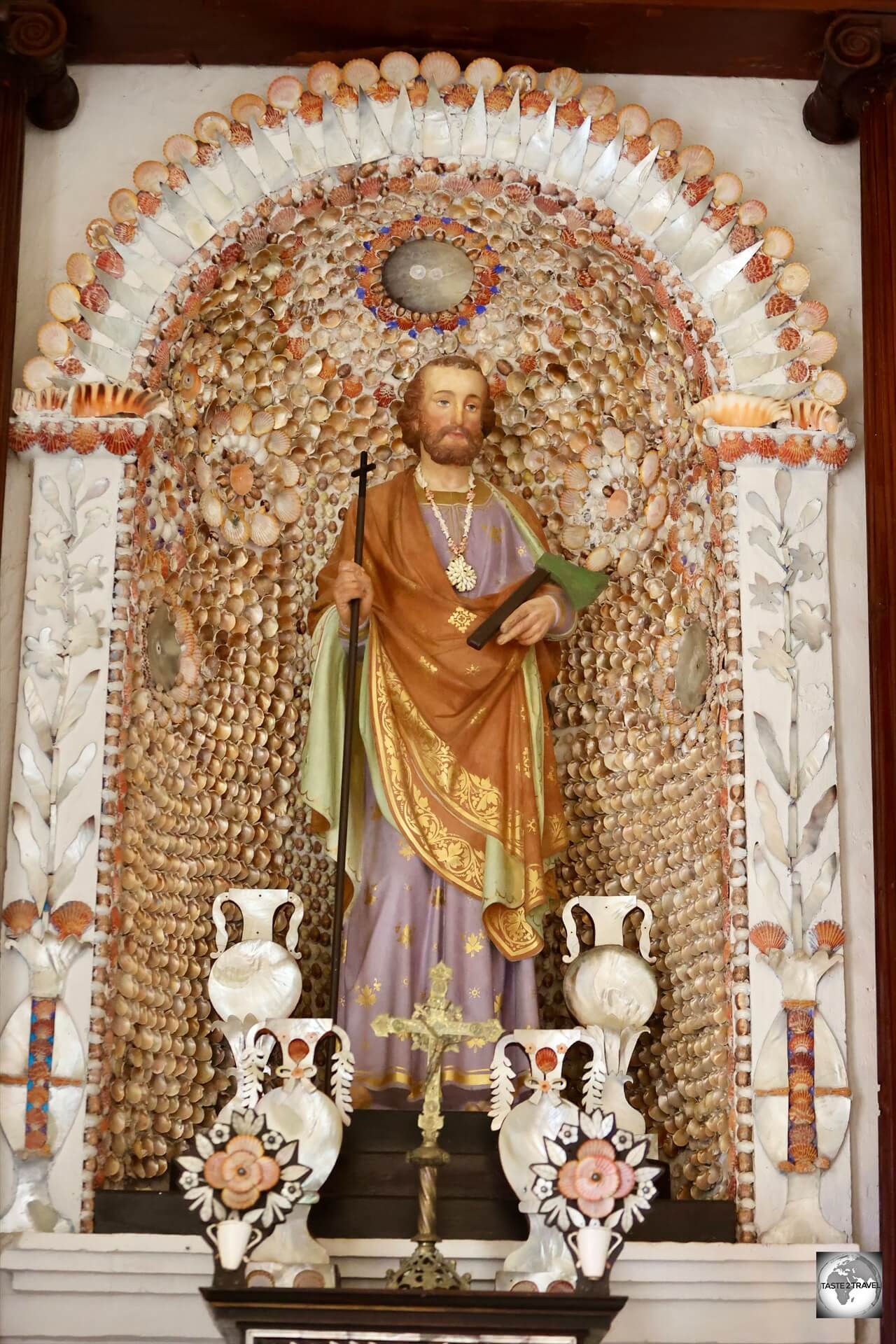
Mother-of-pearl, black pearls, shells and more are used for decoration at St. Michael’s Cathedral.
Originally, the altar was adorned by a 50-carat black pearl given to Laval by King Maputeoa.
When Laval was ordered back to Tahiti in 1871, he had the massive pearl shipped to Rome where it is now part of the Vatican collection, rumored to be the finest pearl in the Pope’s collection.
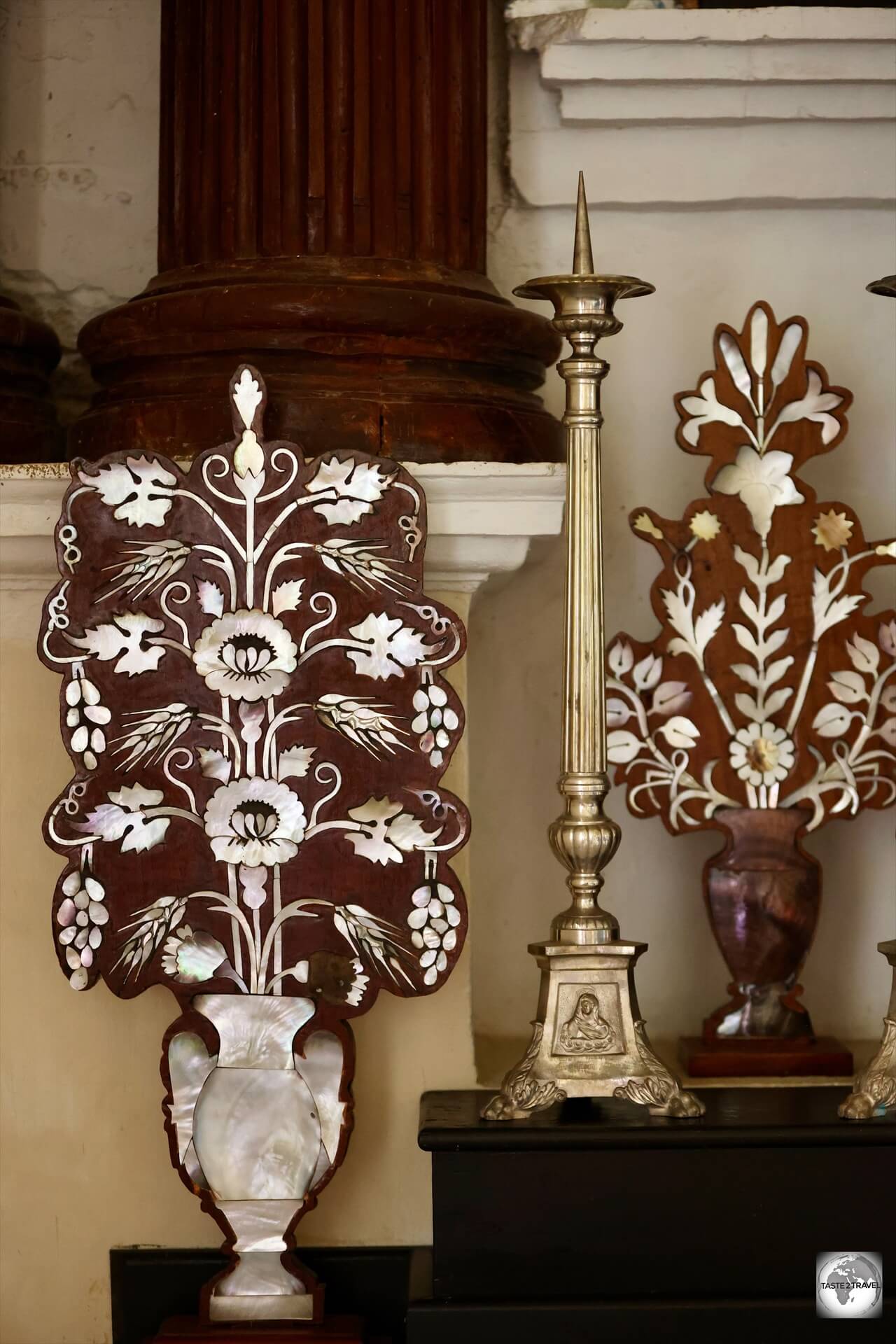
Mother-of-Pearl decoration on the altar of St. Michael’s Cathedral in Mangareva, Gambier Islands.
St. Pierre Cemetery
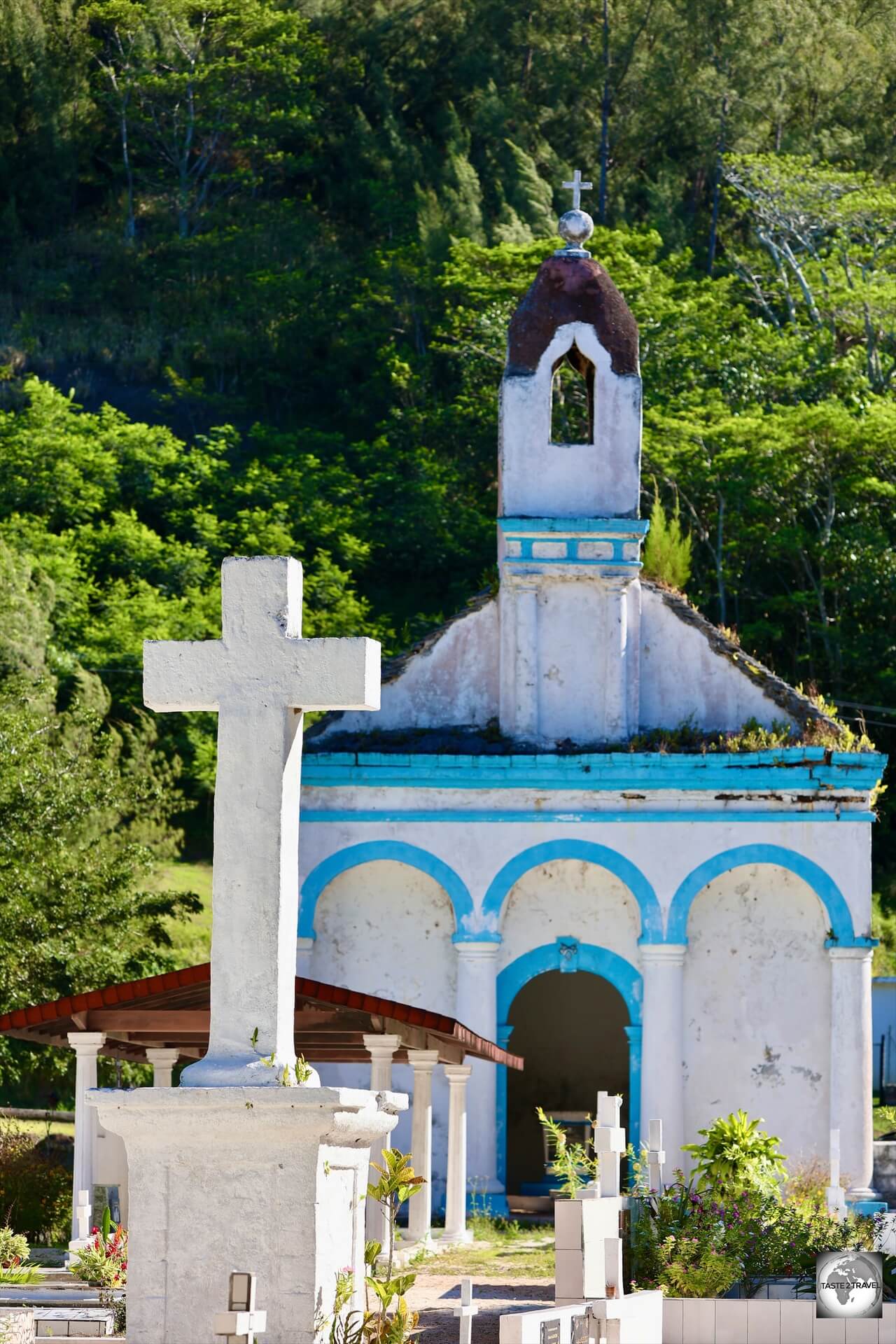
A view of St. Pierre’s Chapel, the burial site of King Te Ma-puteoa, and the cemetery in Rikitea.
The last King of the Gambier Islands, King Te Ma-puteoa, is buried in a crypt in St. Pierre’s Chapel which is located on a hill above Rikitea, near to the meteorological station.
During Ma-puteoa’s reign, the country, which was deeply rooted in native beliefs and even cannibalism, became a Roman Catholic community.
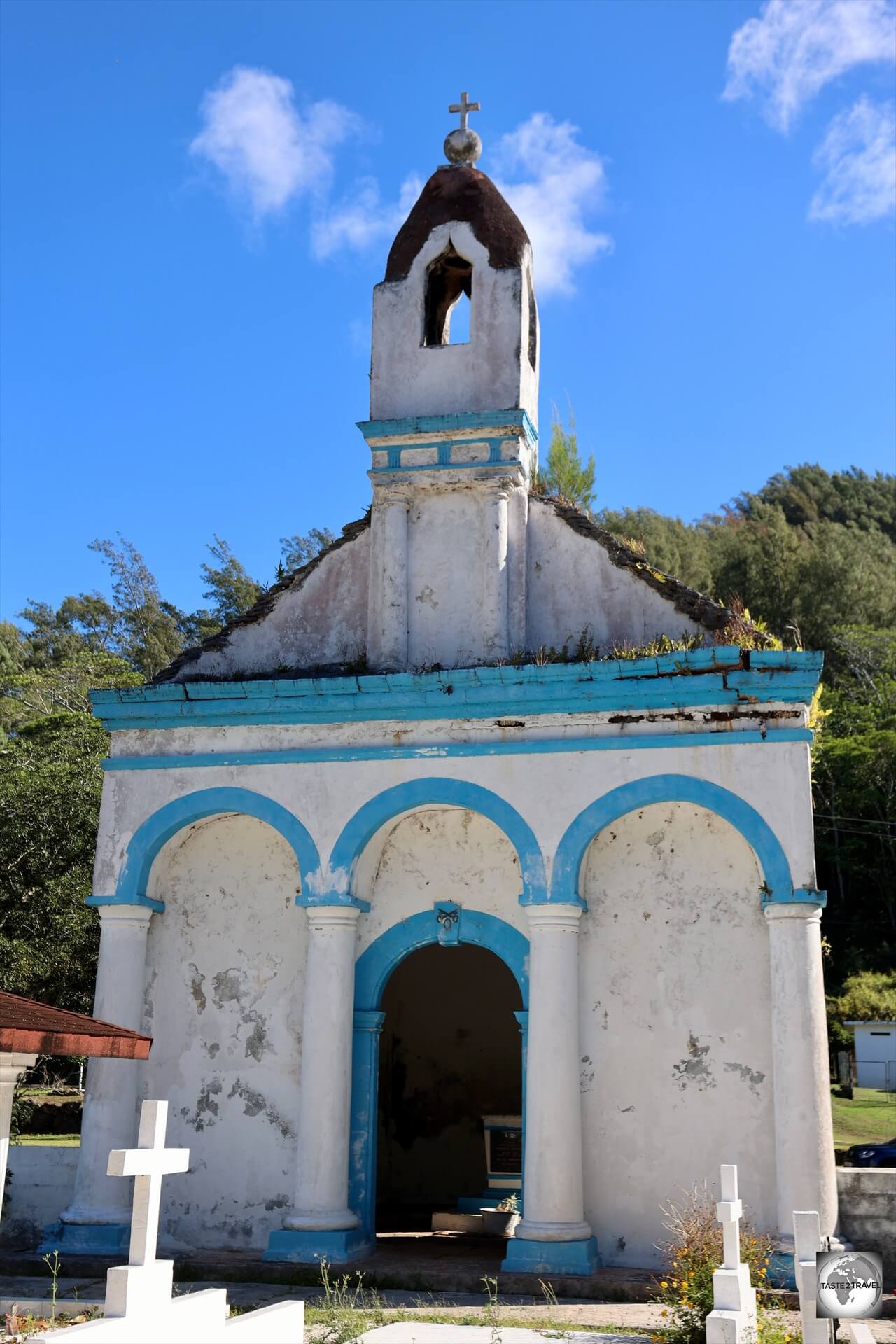
St. Pierre’s Chapel, the burial site of King Te Ma-puteoa.
This was accomplished by removing all vestiges of native beliefs, including the building of churches over the top of native marae’s (meeting houses).
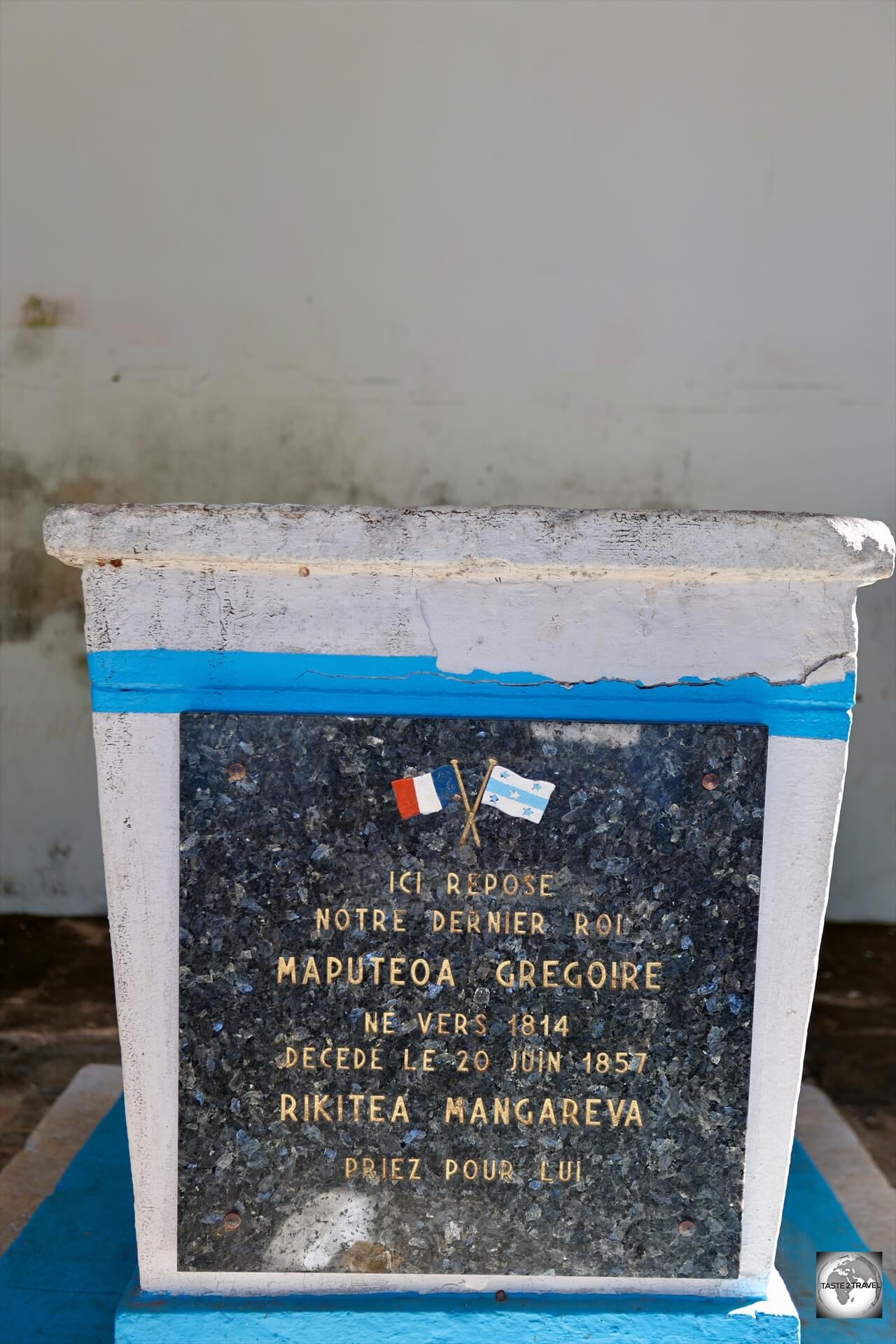
The tomb of King Te Ma-puteoa, who, after baptism changed his name to Gregorio in honor of Pope Gregory XVI.
The king was baptised into Catholicism on 25 August 1836.
He took the name Gregorio after baptism in honor of Pope Gregory XVI who had deputed the missionaries to eastern Oceania, and solemnly placed his islands under the protection of the Blessed Virgin Mary.
He learned about Christianity from the island’s missionaries, headed by Fathers Honoré Laval and François Caret.
Following the death of his father, King Te Ma-puteoa became King at the age of 10, but, due to poor health died at the age of 21!
St. Anne’s Chapel
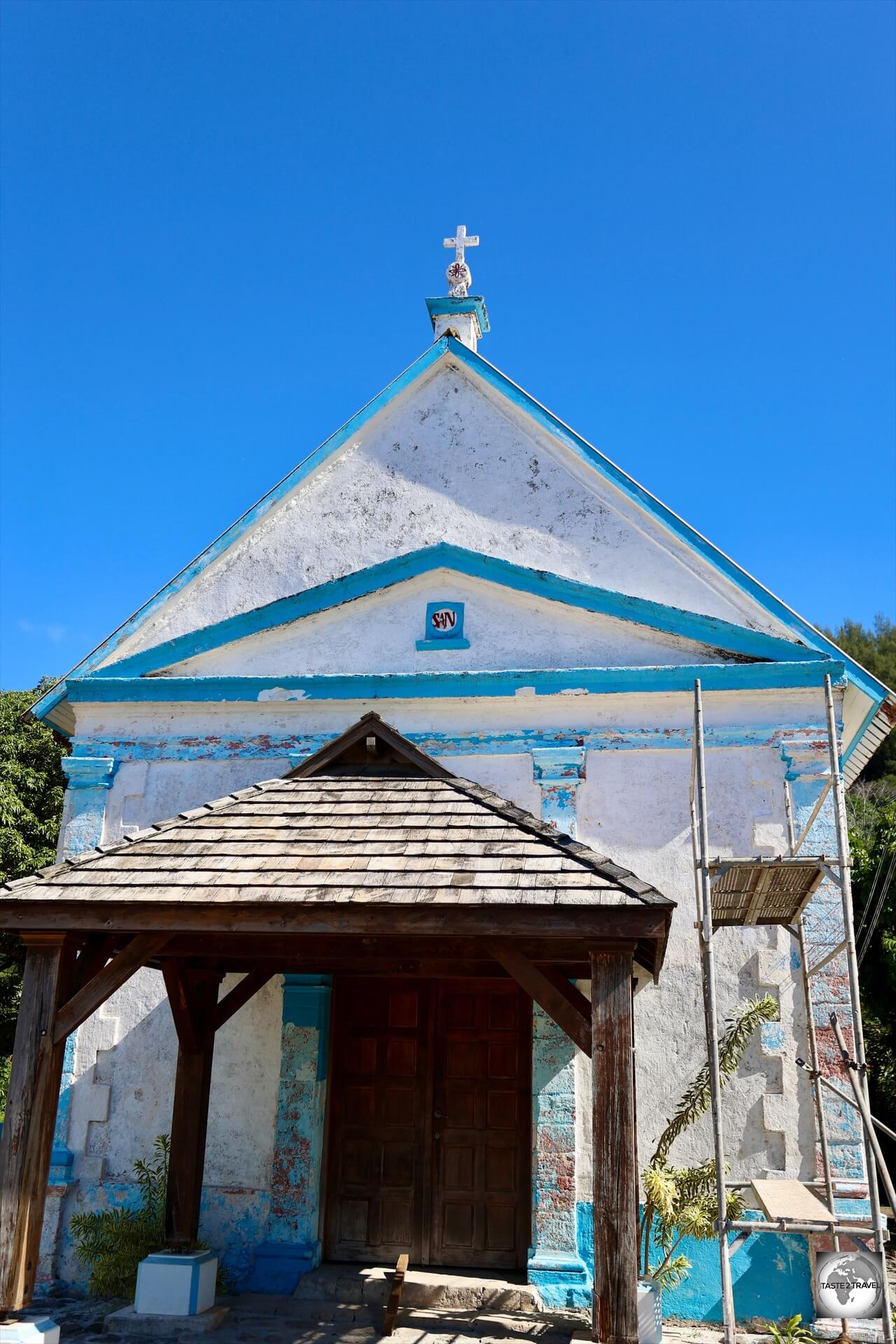
Built in 1847, the gift-box sized St. Anne’s Chapel measures just 7×7 metres.
The smallest of all the churches in the Gambier Islands, the very cute St. Anne’s Chapel in Rikitea was constructed in 1847 and measures just 7×7 metres.
The chapel is located a short stroll from the port (turn right when leaving the port).
During my visit, it was closed for renovations.
Mangareva Lagoon Boat Trip
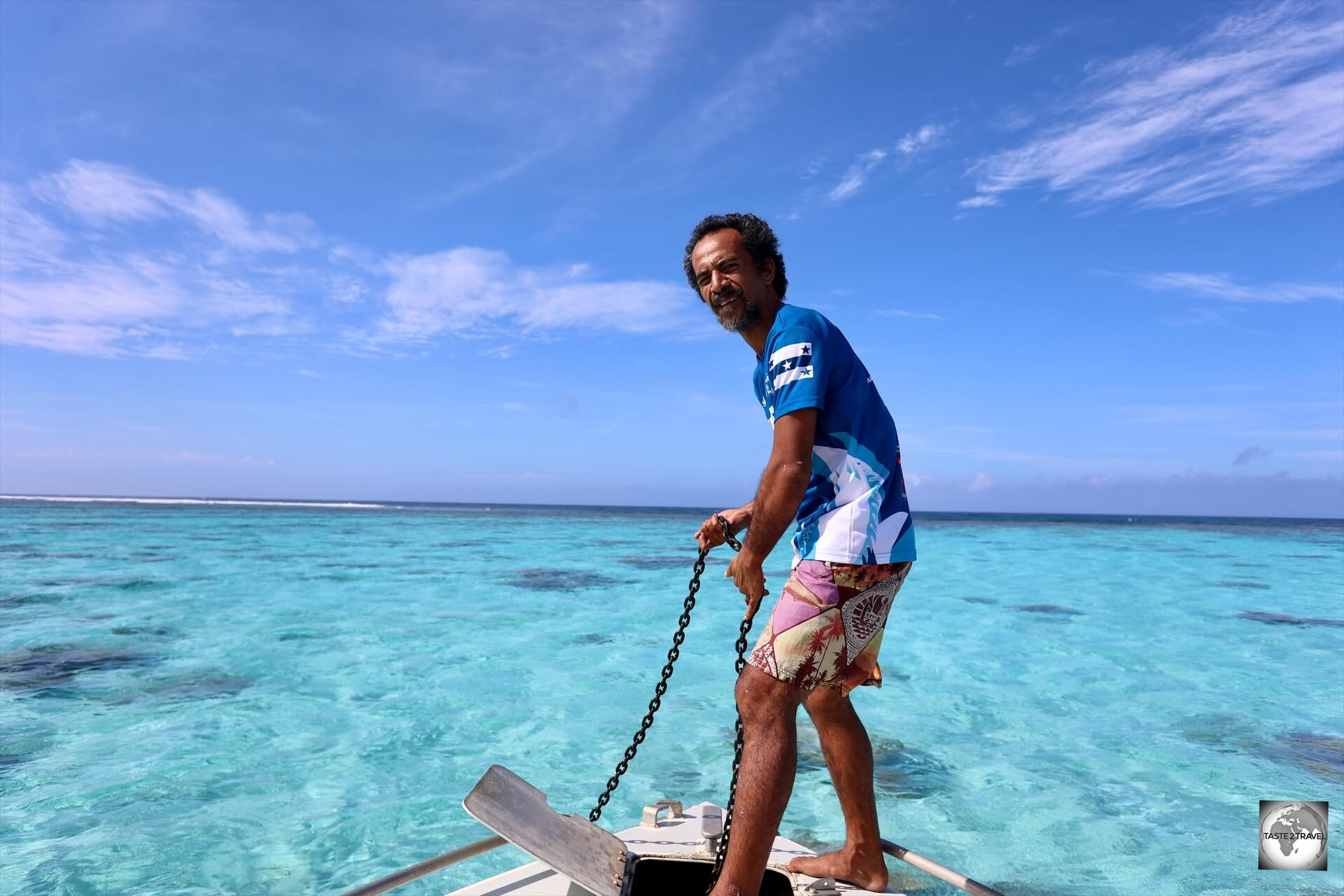
Exploring the sights of stunning Mangareva Lagoon, on a day trip with the friendly crew from Pension Maro’i.
A highlight of my visit to the Gambier Islands was a full day spent on a small speed boat, exploring the various islands, and sights, of the stunningly beautiful Mangareva lagoon, with the incredible team from Pension Maro’i.
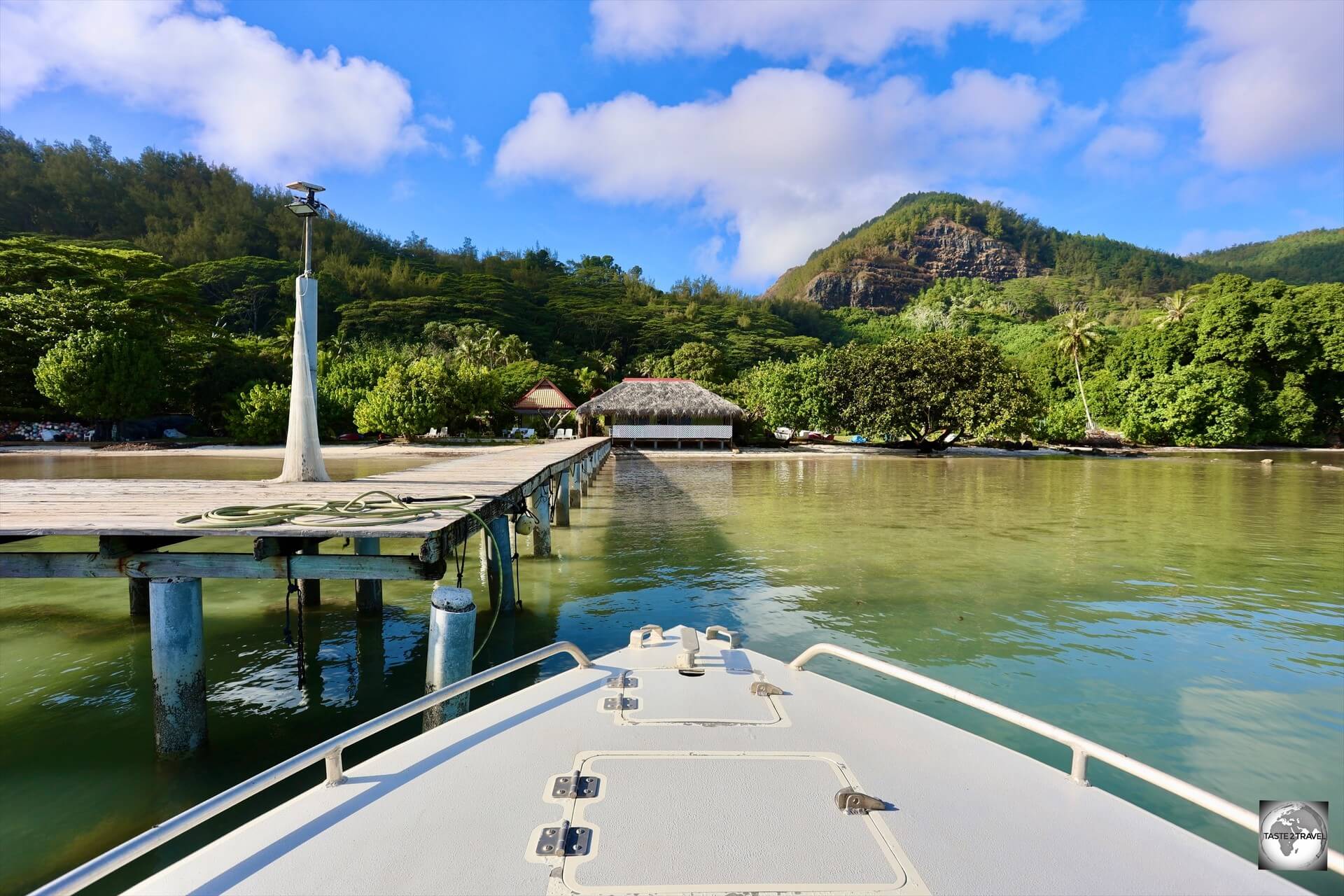
A weekly boat trip which visits the islands of Mangareva Lagoon is offered every Thursday by Pension Maro’i.
The tour is conducted every Thursday and will normally be joined by any of the small number of tourists on Mangareva.
On my trip, there were 5 other passengers.
The trip costs 13,500 CFP (US$122) and includes a full day of touring, visiting all of the islands which are described below, plus a delicious lunch of BBQ fresh fish, salads and other local island specialties.

Our daytrip included an excellent lunch of BBQed fish on Bird Island.
In terms of foot wear, I would recommend bringing both flip flops and sturdy walking shoes as activities range from relaxing on stunning beaches, to hiking on some of the islands.
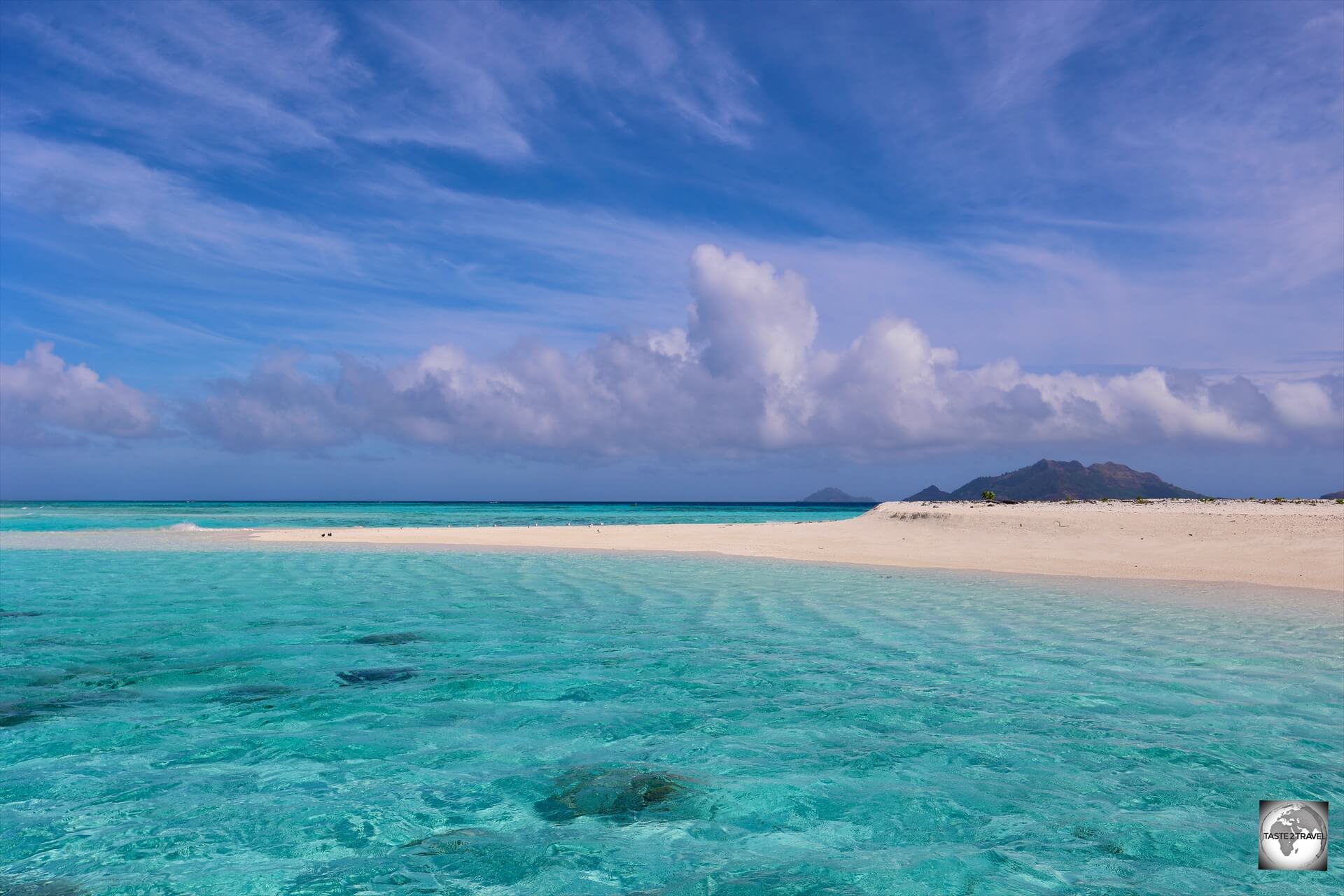
The beautiful beach at Motu Tauna (Bird Island).
Snorkeling equipment would also be beneficial as there are many amazing snorkeling spots. The boat didn’t carry any snorkeling equipment.
The 2-man crew provided commentary in French (of course!) with some basic English.
Highly recommended!
Taravai Island
The first island we visited on our boat trip was Taravai.
Taravai is the second largest of the Gambier Islands. Once home to over 2,000 inhabitants, today, it is home to one family who act as caretakers on the island.
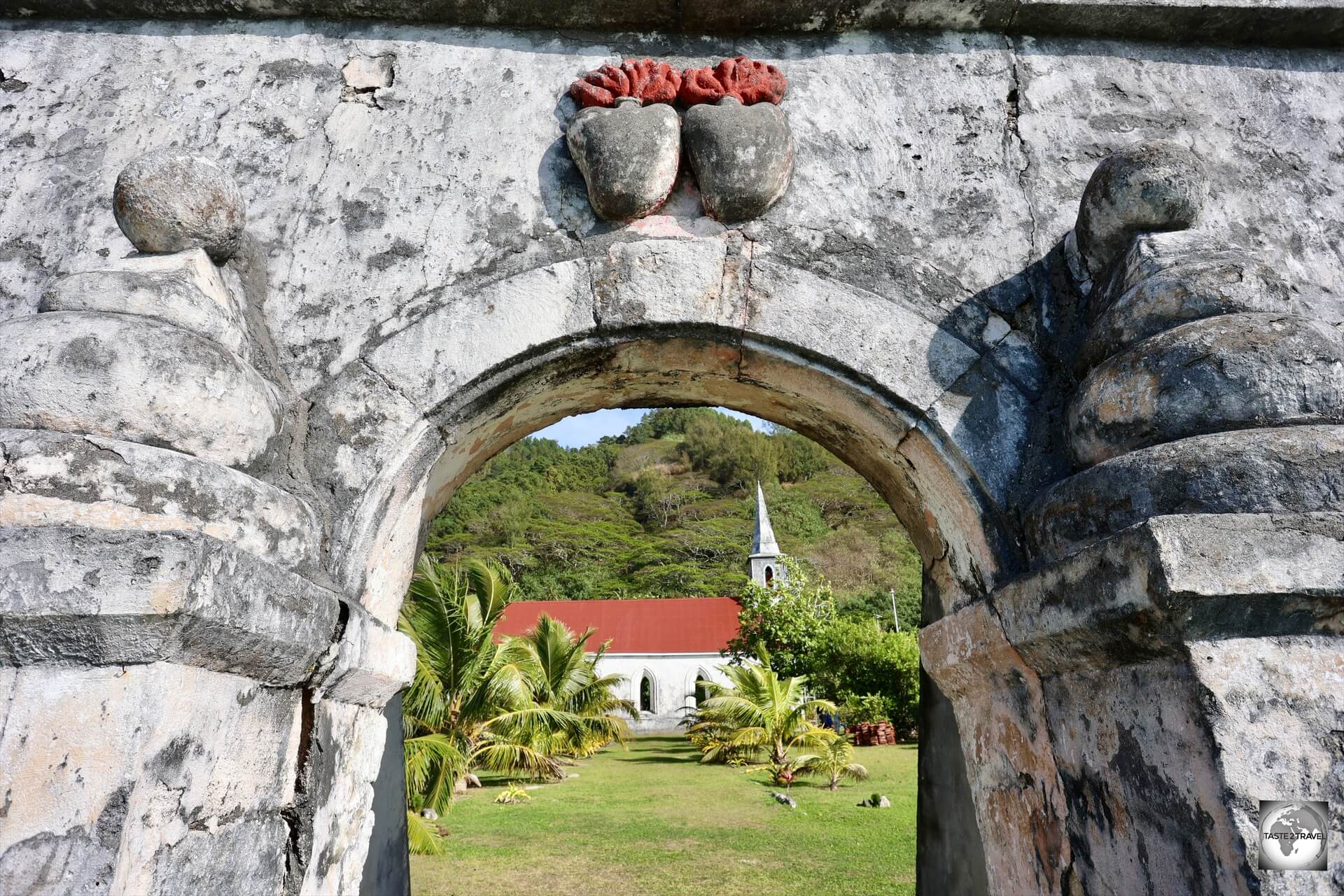
Church of Saint-Gabriel, and the archway with the twin hearts from ‘Les Sacrés-Coeurs de Picpus’, Taravai Island.
The island boasts a magnificent white sandy beach and a rather strange archway in the remains of an ancient wall.
Above the arch are two red hearts, the emblem of a religious order ‘Les Sacrés-Coeurs de Picpus’.
Church of Saint-Gabriel
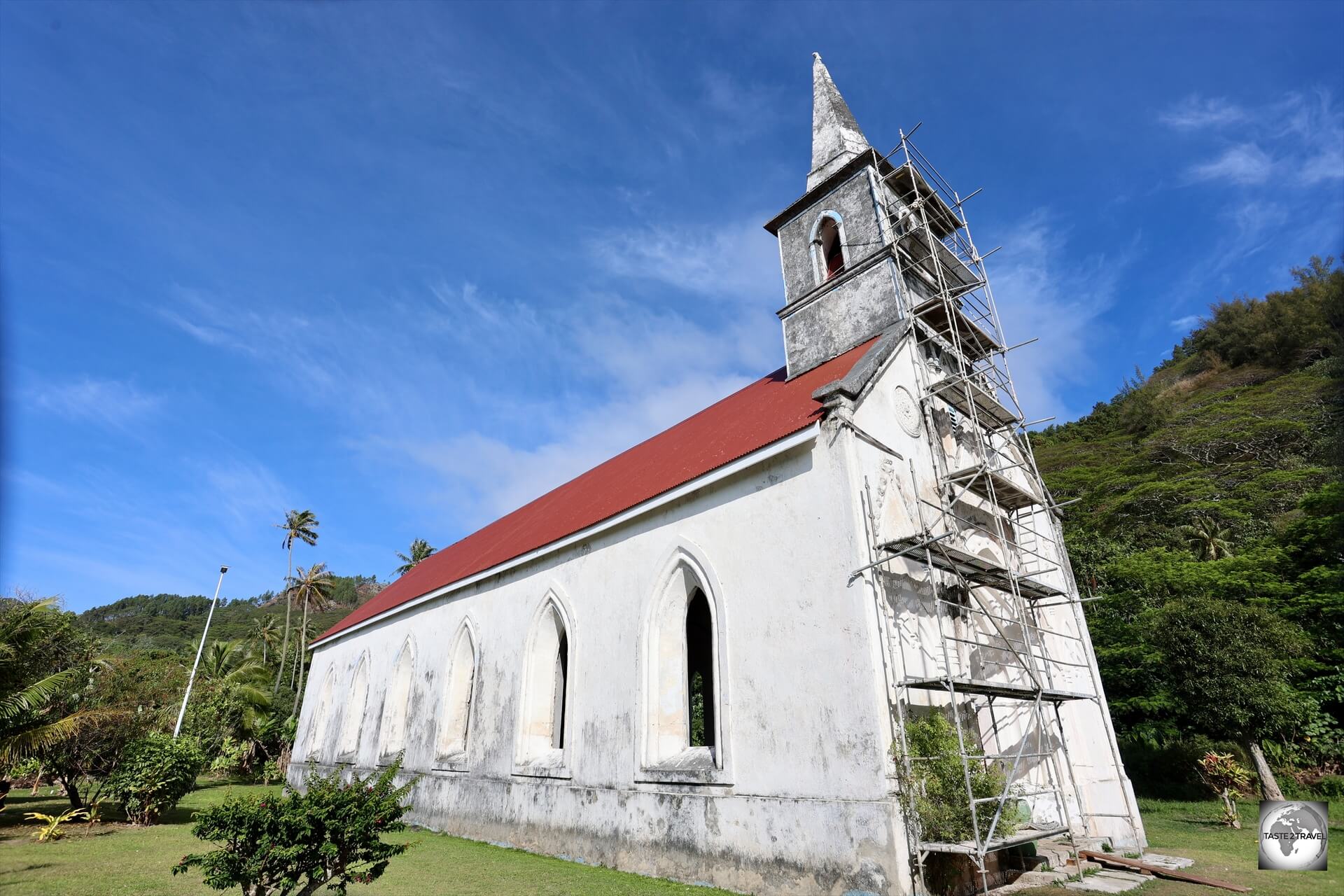
A highlight of Taravai Island, the Church of Saint-Gabriel, which was under renovation at the time of my visit.
The gothic-style Church of Saint-Gabriel was built in 1868 by Mangarevan islanders, under the direction of the Picpus missionary fathers, the same folks who built all the other churches in the Gambier Islands.
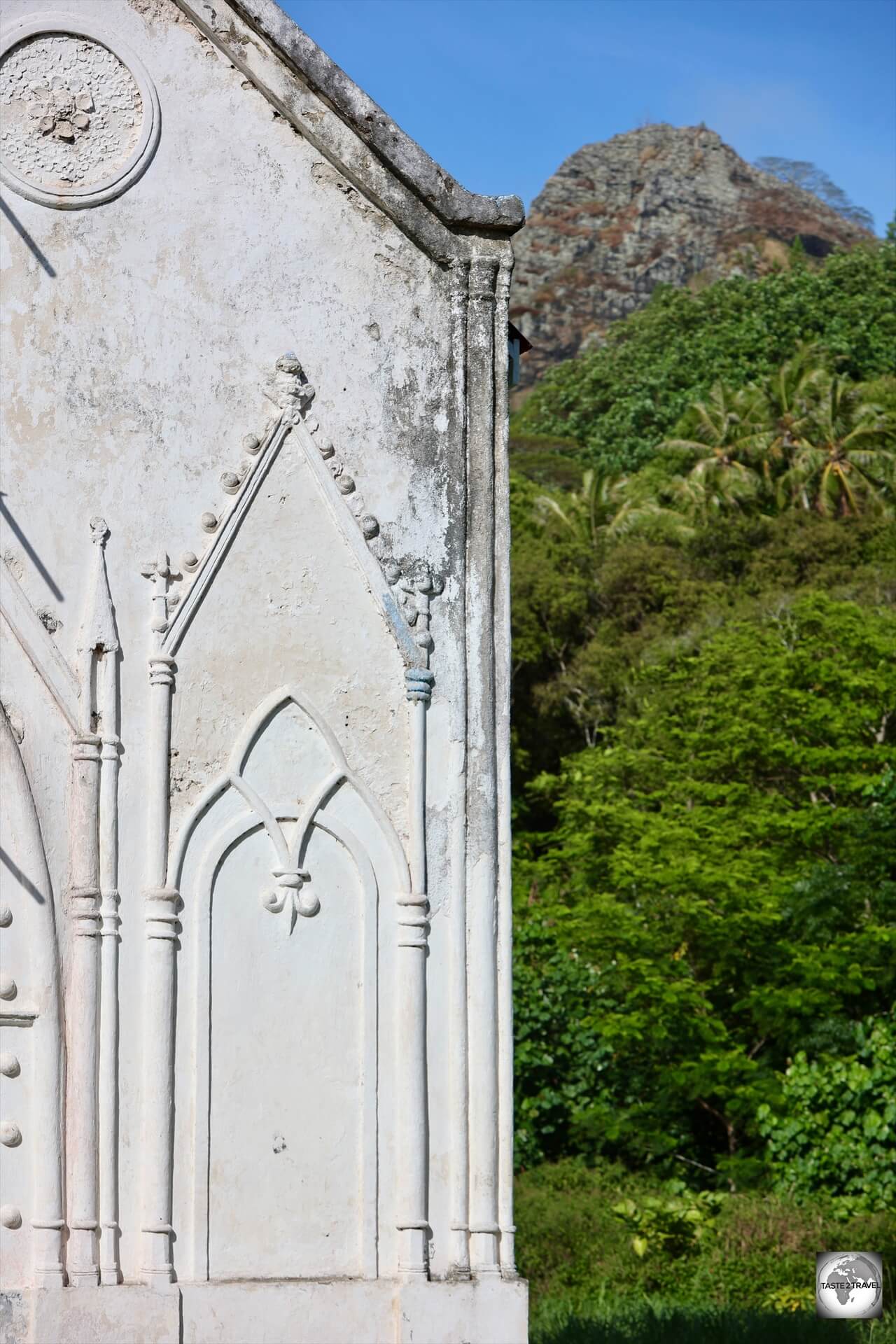
The white washed walls of the church contrast against the lush green scenery of Taravai Island.
At the time of my visit, the church was undergoing a very slow restoration and all of the furniture, including the altar, had been removed while the interior walls were being painted.
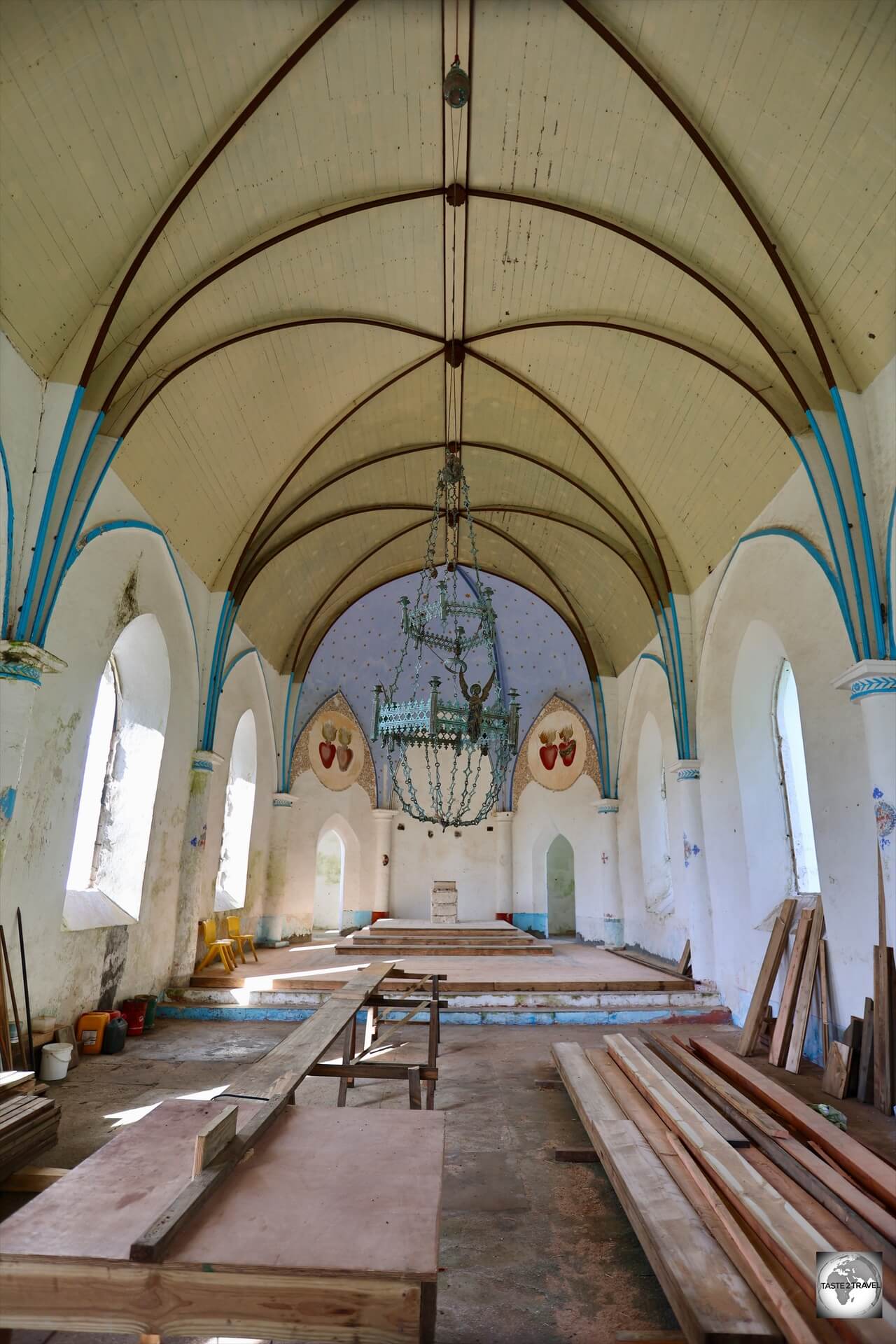
At the time of my visit in 2024, the Church of Saint-Gabriel was undergoing a slow renovation.
The interior of the Church of Saint-Gabriel is truly magnificent with the twin hearts of the religious order ‘Les Sacrés-Coeurs de Picpus’, displayed prominently behind the altar (currently removed due to the renovation).
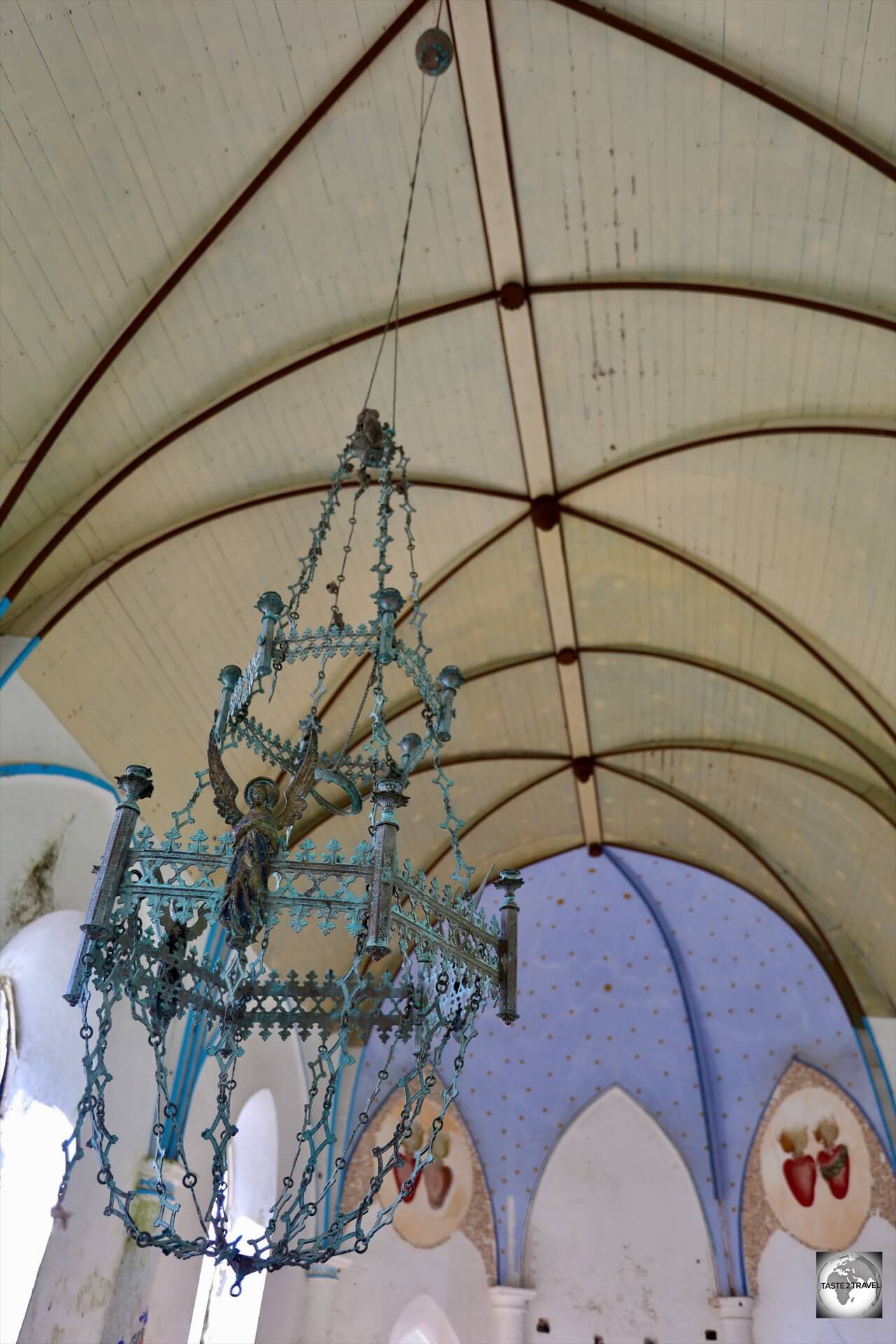
The interior of the Church of Saint-Gabriel, Taravai Island.
The Gambier archipelago is the cradle of Catholicism in French Polynesia.
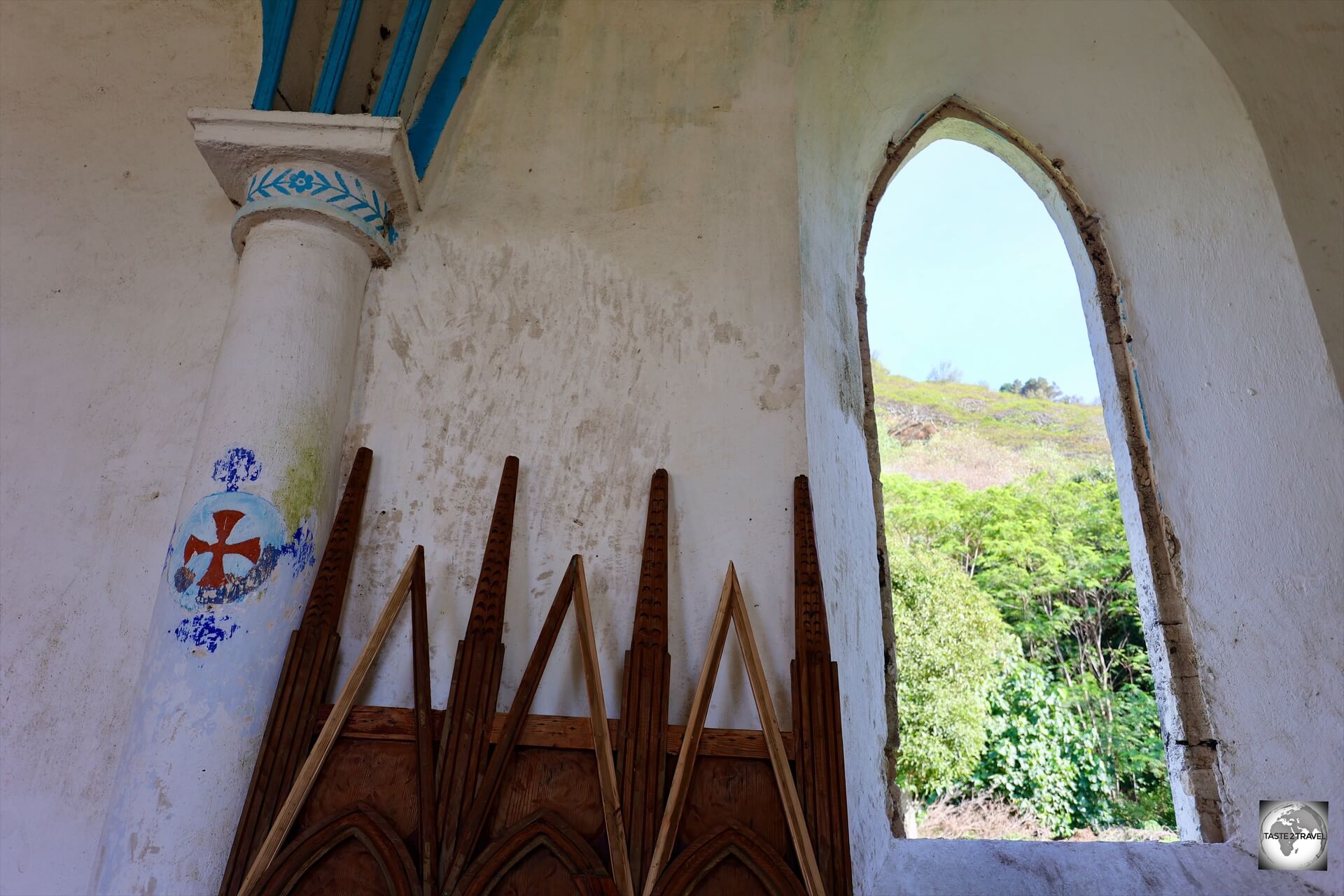
A view of the interior of the Church of Saint-Gabriel, Taravai Island.
The islands feature more than one hundred stone buildings of the eighteenth and nineteenth century: churches, presbyteries, convents, schools, weaving workshops, bread ovens, lime ovens, and watchtowers.
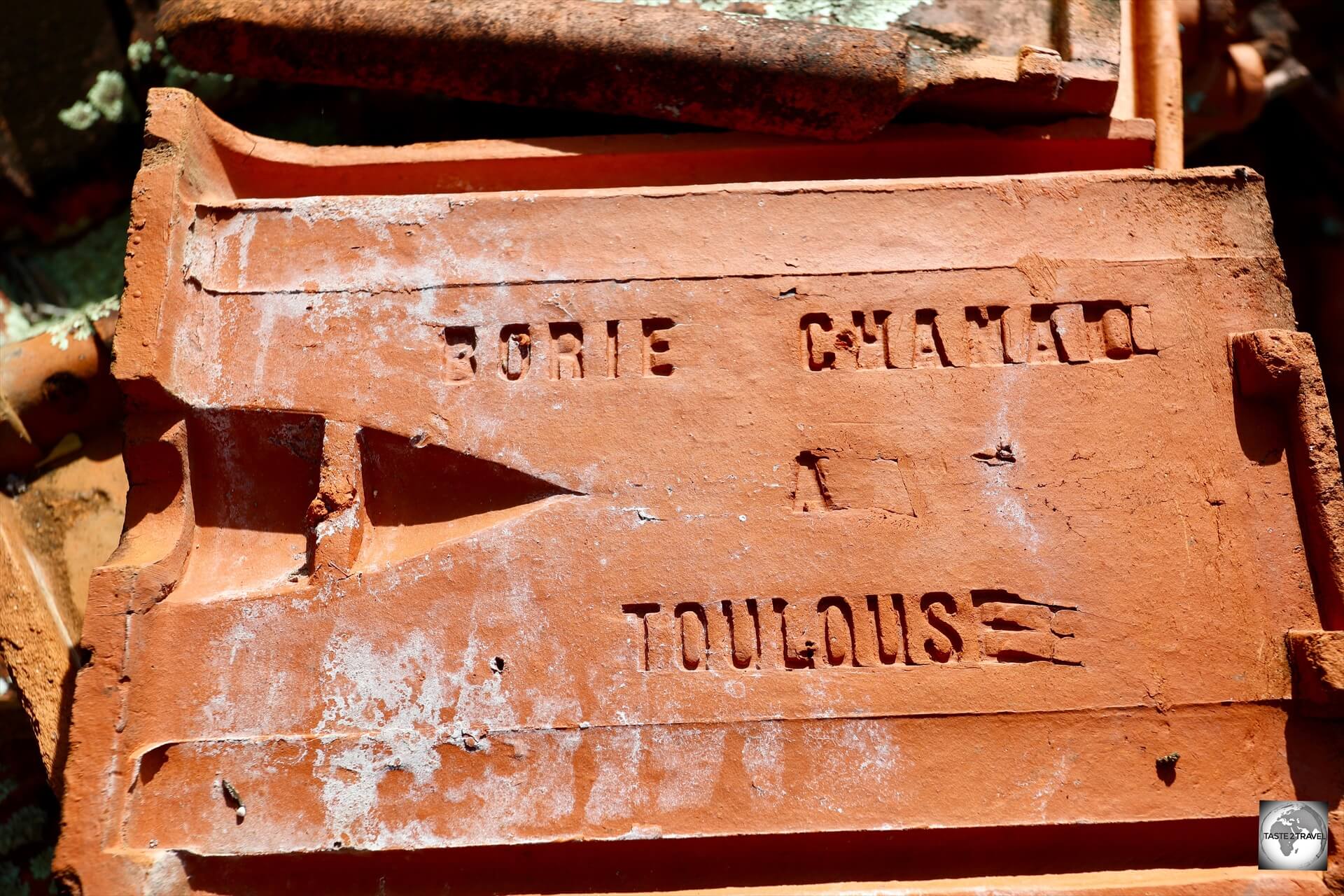
“Made in Toulouse’ – tiles from the roof of the Church of Saint-Gabriel, Taravai Island.
Mekiro Islet
The second island we visited on our boat trip was tiny Mekiro Islet.
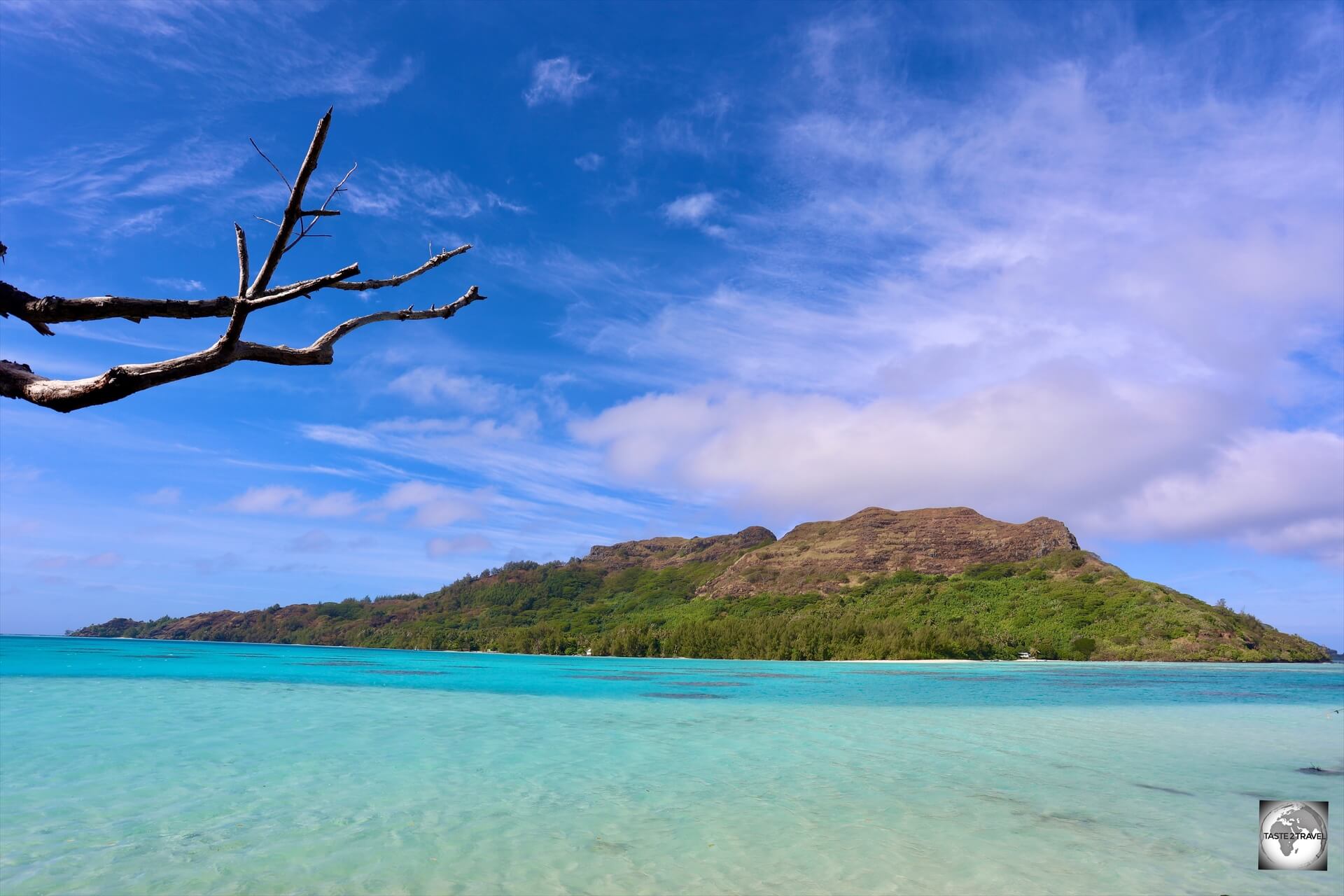
A view of Akamaru Island from Mekiro Islet.
Mekiro is a small, hilly islet right next to Akamaru.
This lonely islet is inhabited by a herd of wild goats who can be observed, scaling the cliff-faces in search of food.
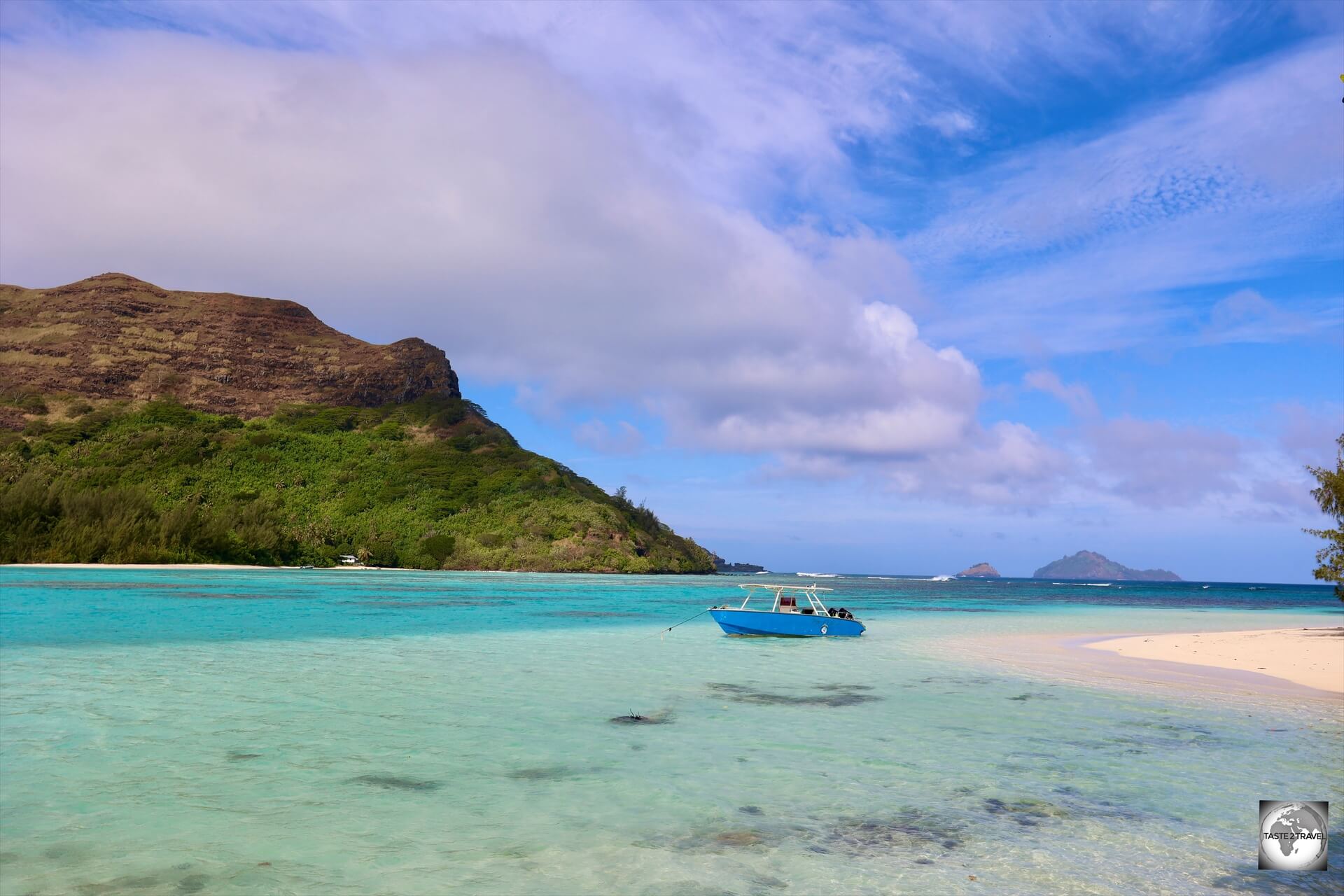
Our boat, from Pension Maro’i, anchored on a beautiful beach at Mekiro Islet with Akamaru Island in the background.
During our day trip of the lagoon with the folks from Pension Maro’i, we spent time at Mekiro Islet where I was able to swim on a beautiful white sand beach.
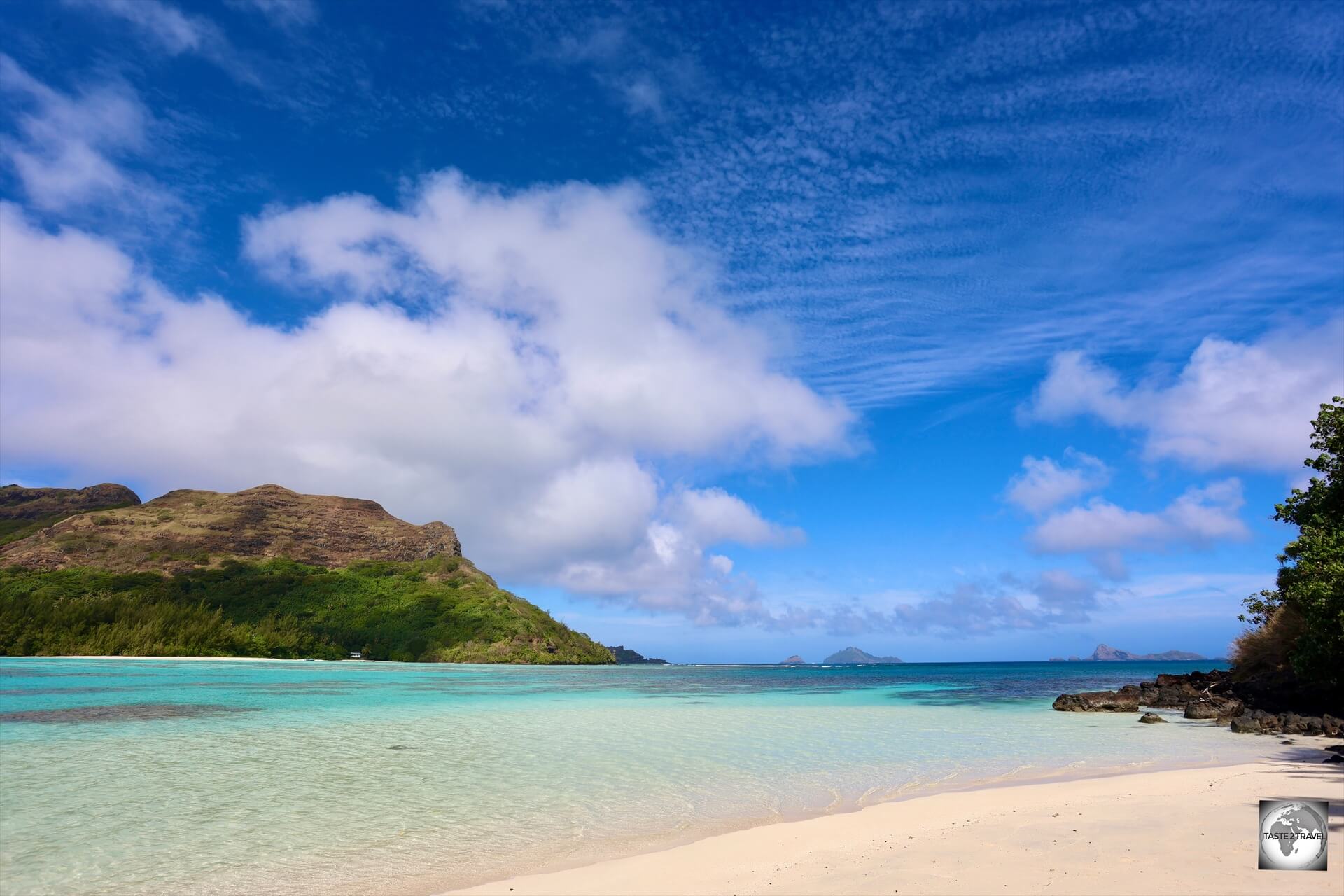
A lonely beach at Mekiro Islet, with Akamaru Island in the background.
If you have sturdy walking shoes (highly recommended for the day trip of the islands), a fabulous view of the lagoon can be seen from the top of Mekiro Islet.
I unfortunately only had my less-than-sturdy flip-flops so I spent my time relaxing on the beautiful beach pictured above.
Akamaru Island
The third island we visited on our boat trip was Akamaru.
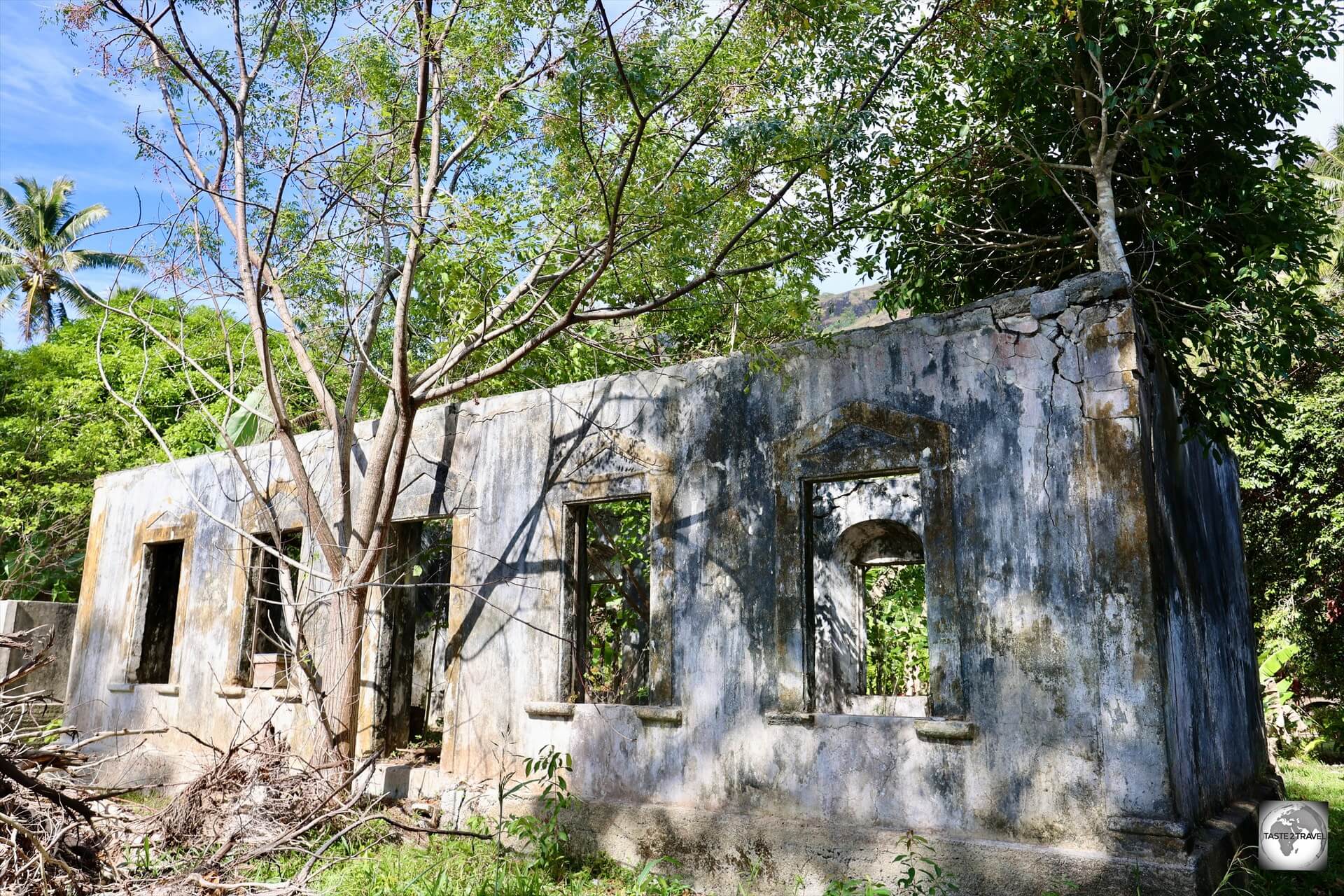
Remnants of the former town on sleepy Akamaru Island, now home to 22 inhabitants.
Akamaru Island is the third largest island in the Gambier Islands.
It is a small, rocky island with an area of approximately 2.6 km2 (1.0 sq mi). The island is located approximately 7 km (4.3 mi) southeast of Mangareva.
A lonely outpost, in a lonely part of the world, Akamaru Island once supported a thriving population but is today home to just 22 souls.
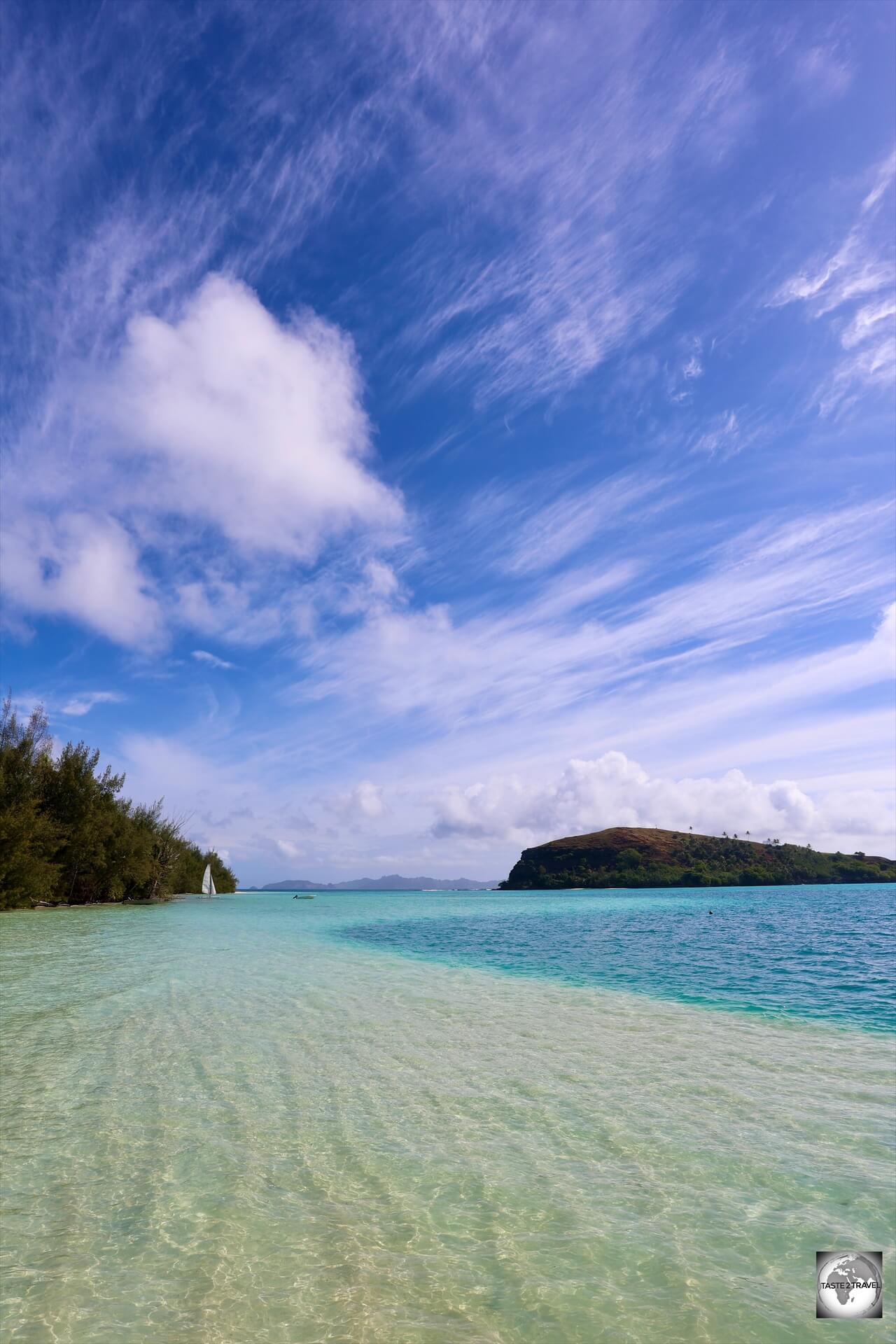
A view of the beach at Akamaru Island with Mekiro Islet in the background.
Akamaru’s highest point rises to an elevation of 247 m (810 ft).
The first European to arrive was the navigator James Wilson in 1797.
Notre-Dame de la Paix Church
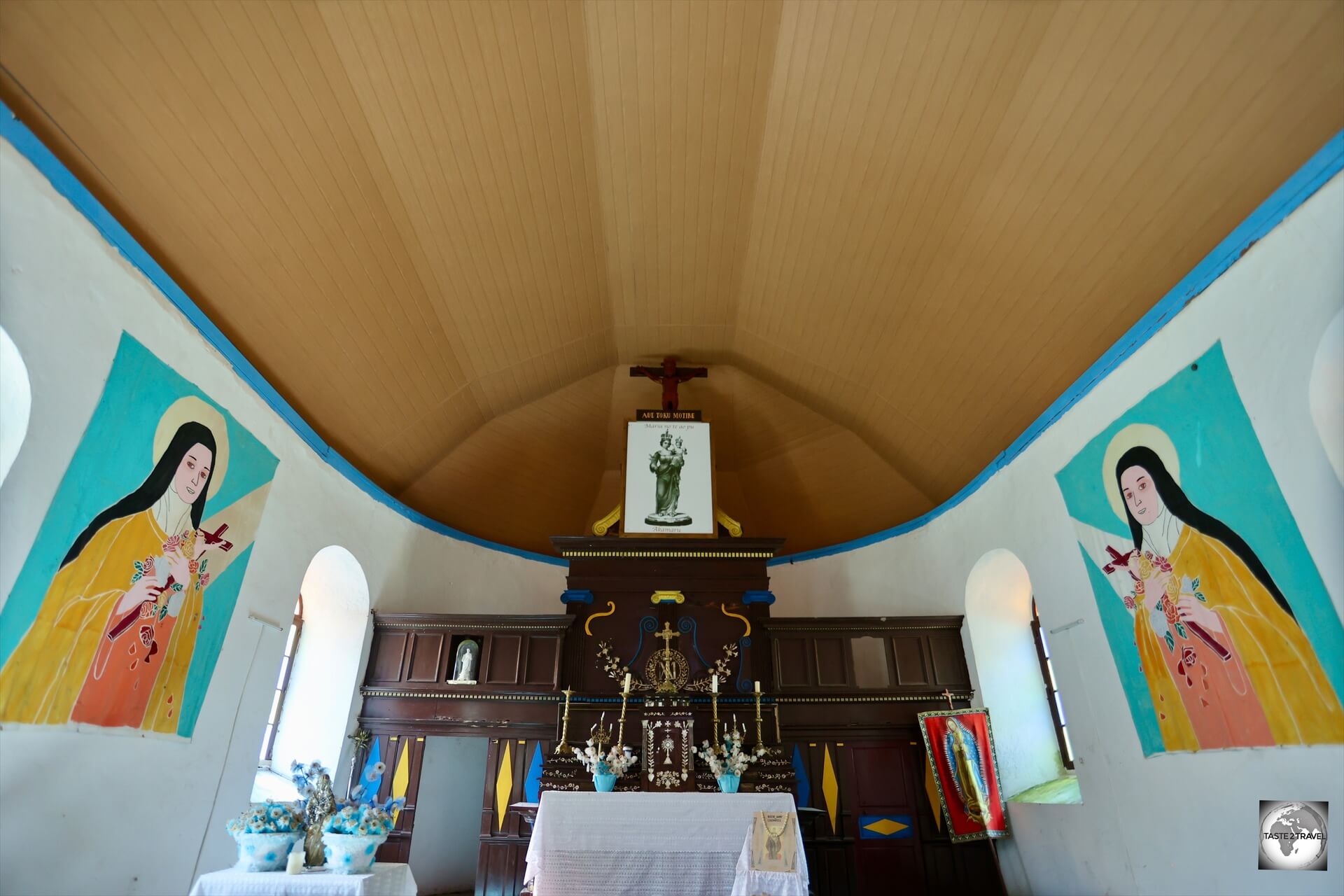
Dedicated to the Virgin Mary, Notre-Dame de la Paix church, is an important and historic Catholic church on Akamaru Island.
In 1834, the French missionary Father Honoré Laval (who built St. Michael’s Cathedral on Rikitea) celebrated the first Mass on the island.
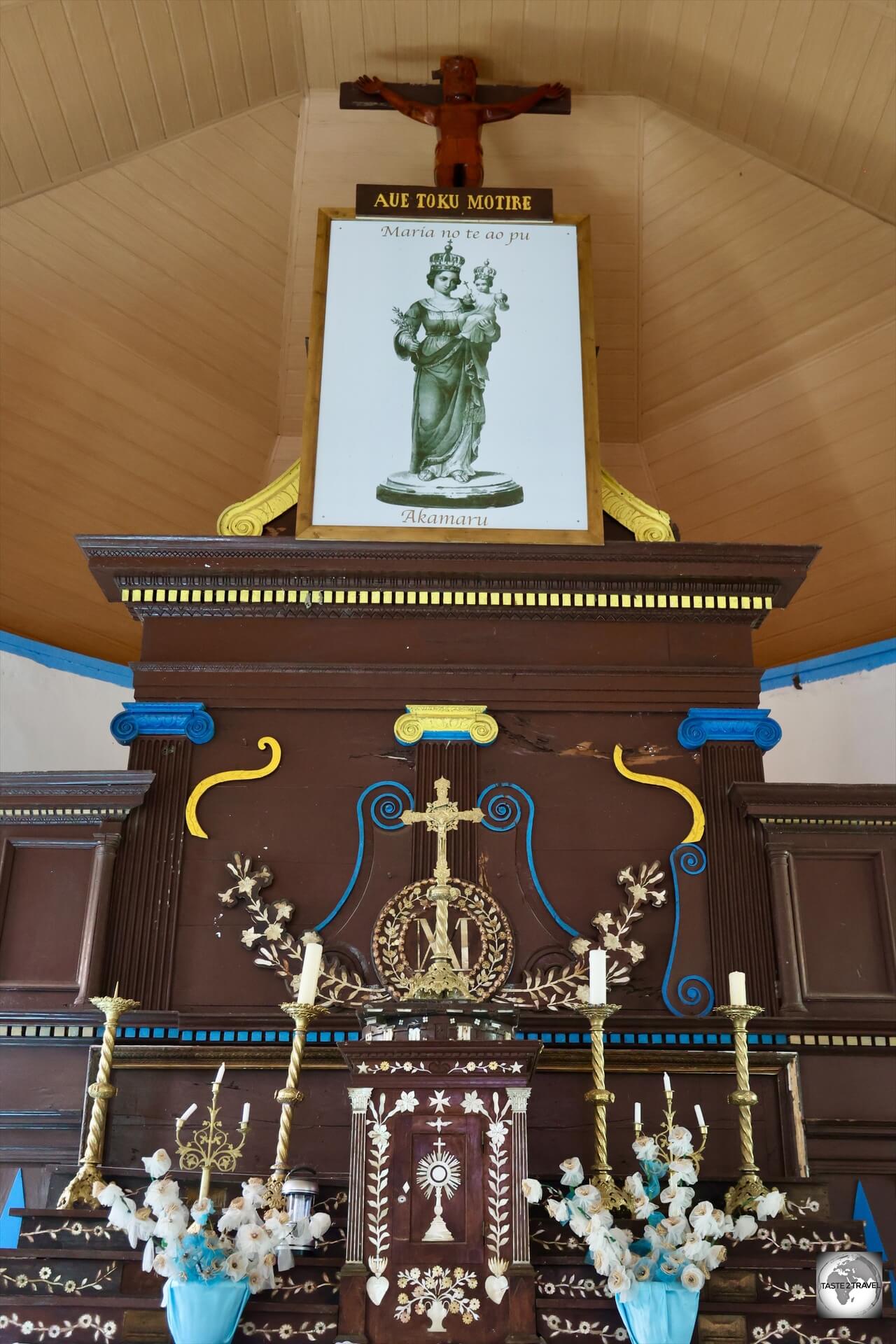
The altar at Notre-Dame de la Paix church, Akamaru Island.
The church of Notre-Dame de la Paix (translates as: Our Lady of Peace) was built between 1835 and 1862 and is dedicated to the Virgin Mary.

Mother-of-Pearl inlay features in the altar of Notre-Dame de la Paix Church.
Notre-Dame de la Paix was another project by the very busy Father Honoré Laval.
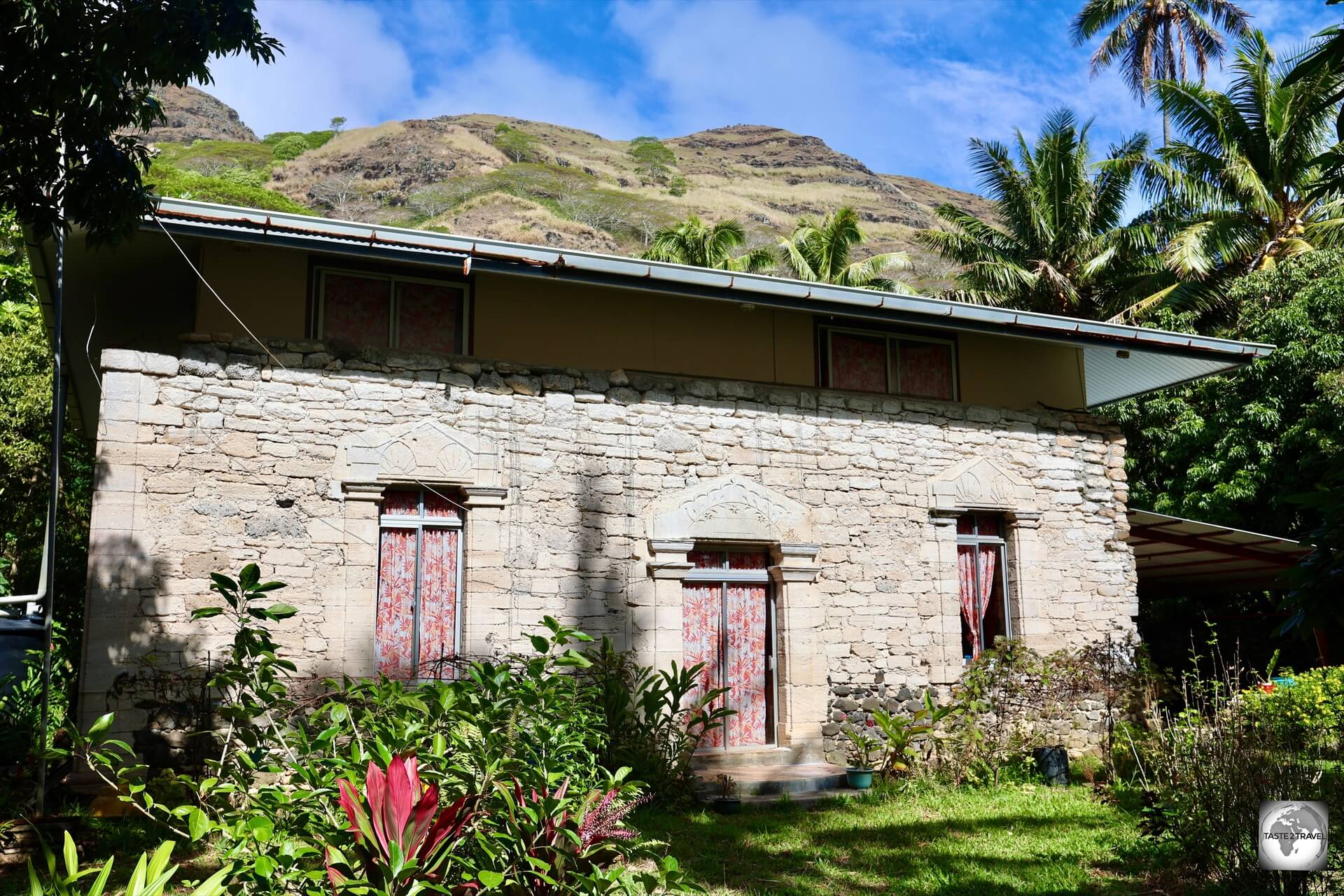
The former palace of King Te Ma-puteoa on Akamaru Island was built in exchange for his support of the construction of the nearby Notre-Dame de la Paix church.
The good father gained support for the construction of the church by offering to build a stone palace for King Te Ma-puteoa, which lies a short distance from the church.
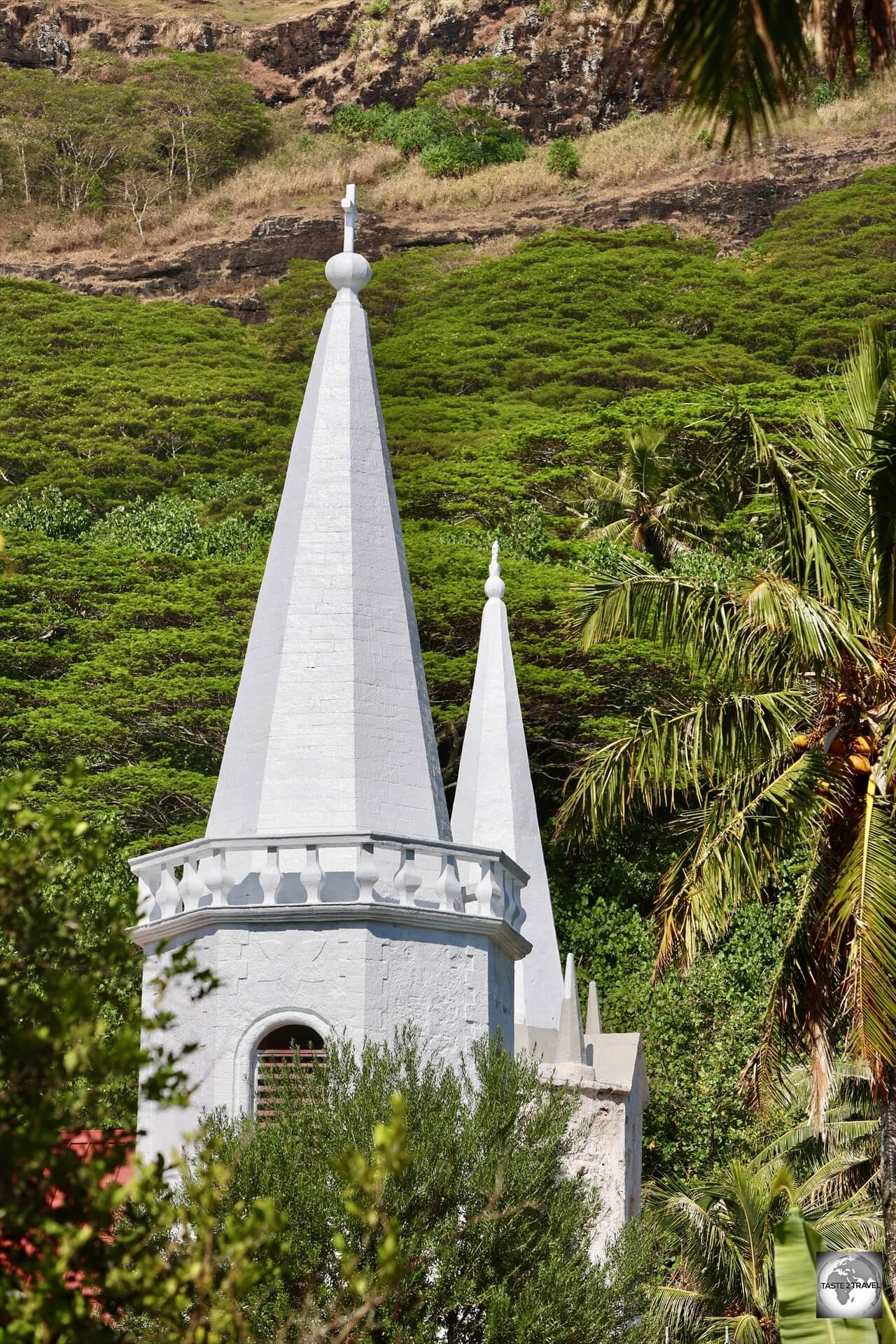
The twin, asymmetrical, spires of Notre-Dame de la Paix church, Akamaru Island.
Constructed from lime-coated coral, its distinctive feature is its two asymmetrical bell towers, which were inspired by the architecture of the French cathedral Notre-Dame de Chartres.

Like other churches in the Pacific region, the ceiling of Notre-Dame de la Paix resembles an upturned boat.
Every year, a pilgrimage takes the Virgin Mary, wearing a necklace of Tahitian pearls, to the cathedral of Saint-Michel de Rikitea at the end of July and brings her back to the church of Akamaru on August 15.
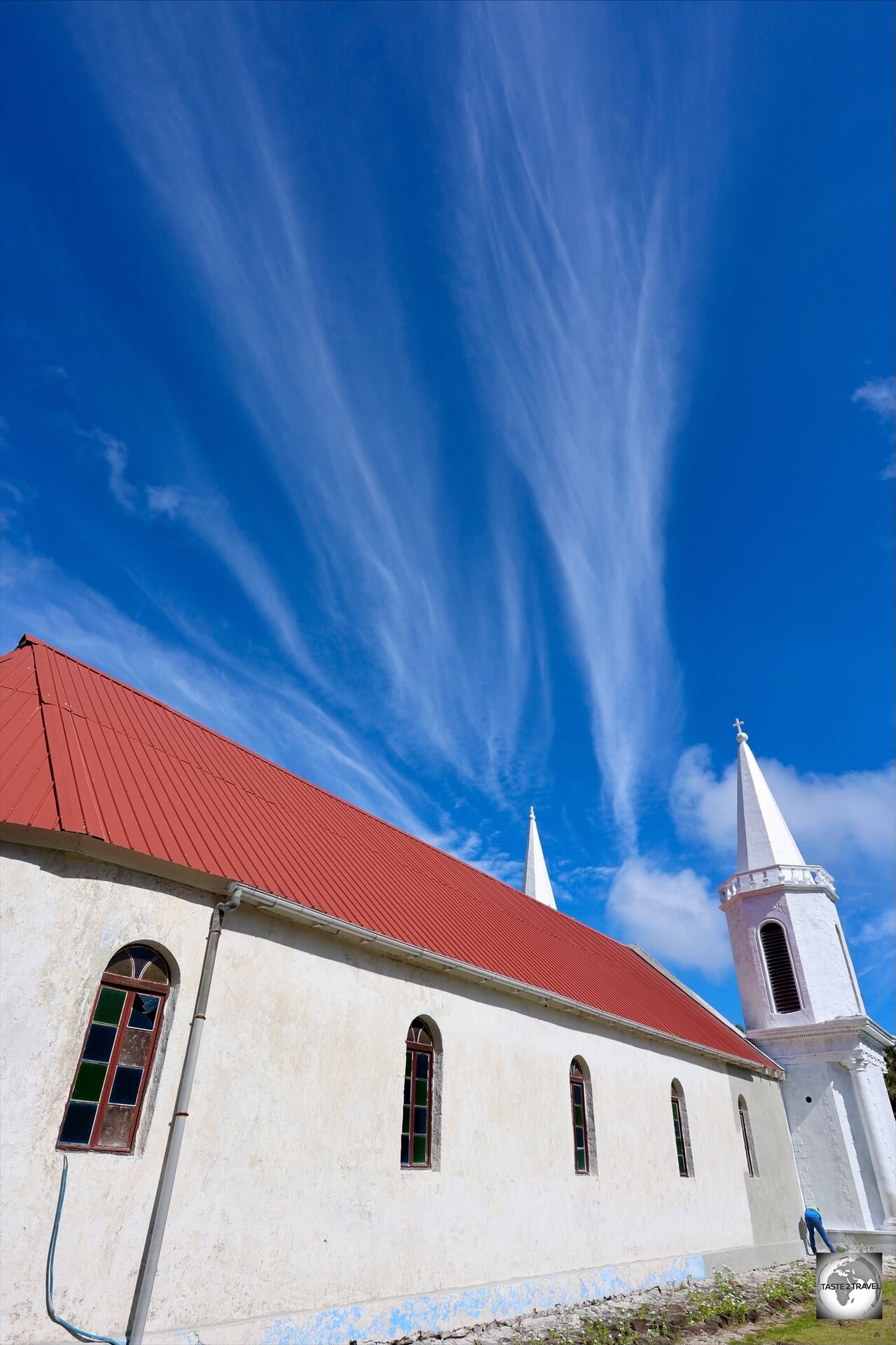
A view of Notre-Dame de la Paix church, on Akamaru Island.
Akamaru Vanilla Farm
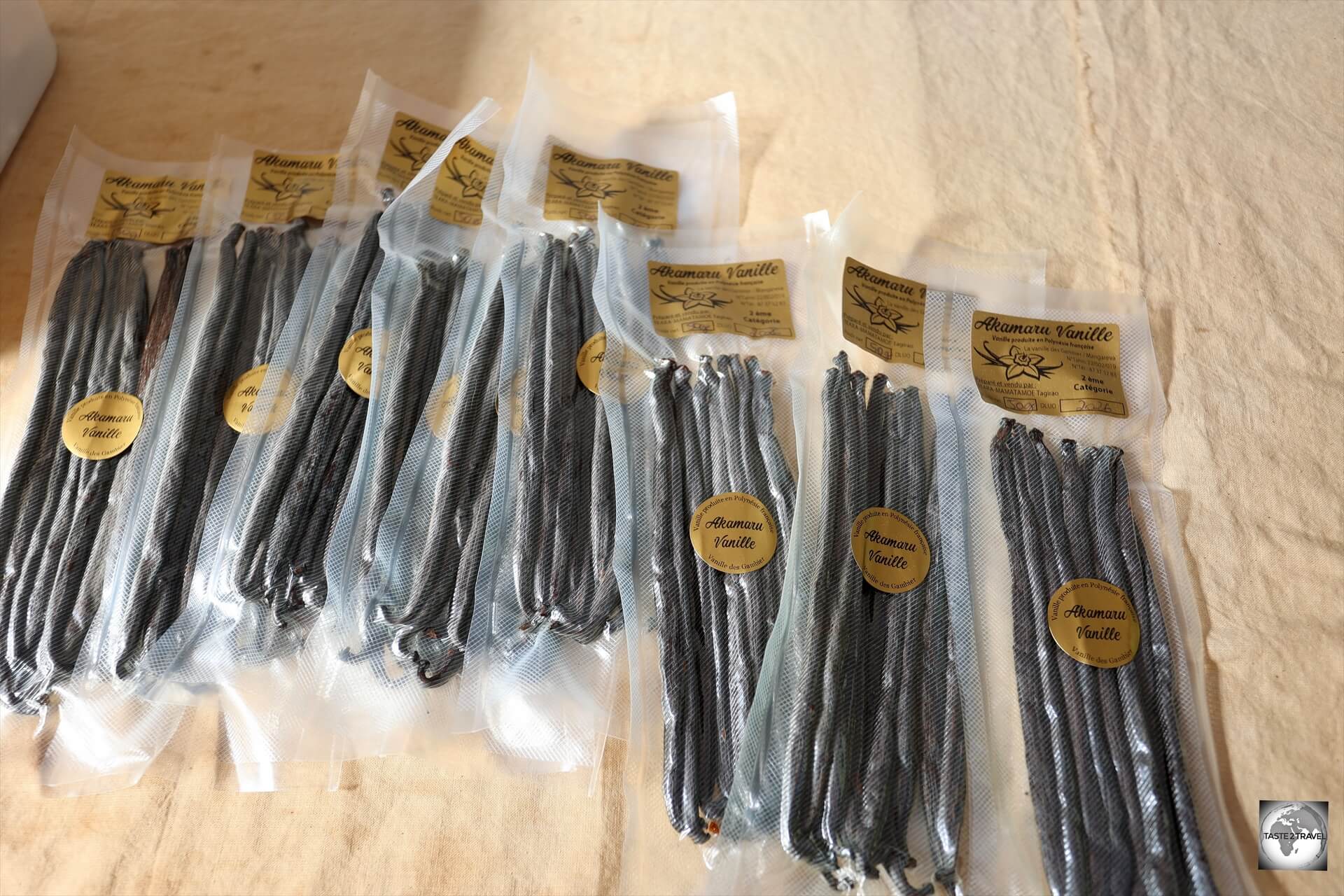
Packets of vanilla for sale at Akamaru Vanilla Farm – 50 grams for US$50.
Tiny Akamaru Island is home to just 22 souls, with several of those involved in the most amazing enterprise – a vanilla farm where the vanilla plants are hand-pollinated.
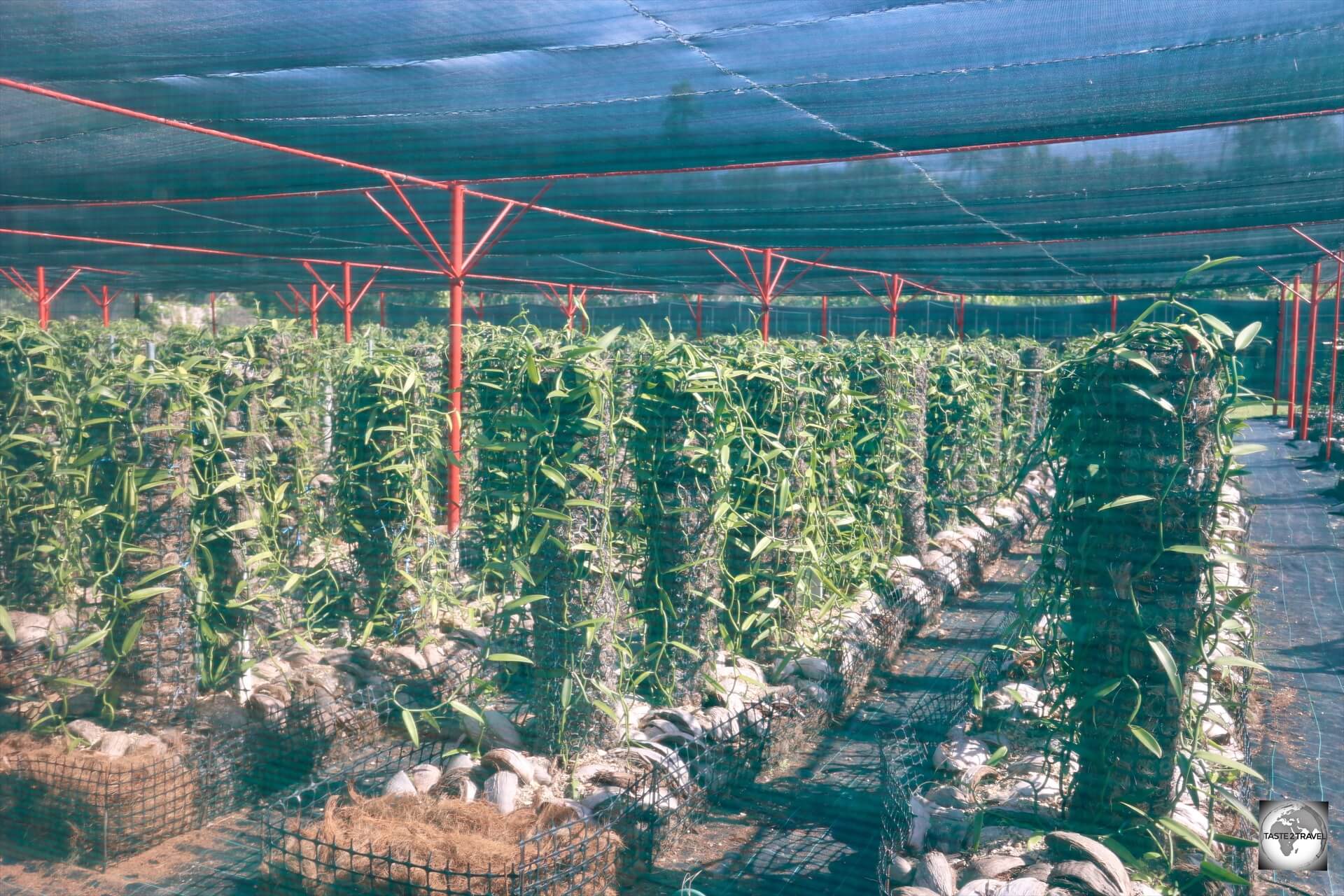
A real gold mine – the immaculate vanilla plantation at Akamaru Vanilla Farm.
Akamaru Vanilla Farm is home to two large greenhouses which are perfectly laid-out and kept perfectly clean and ordered.
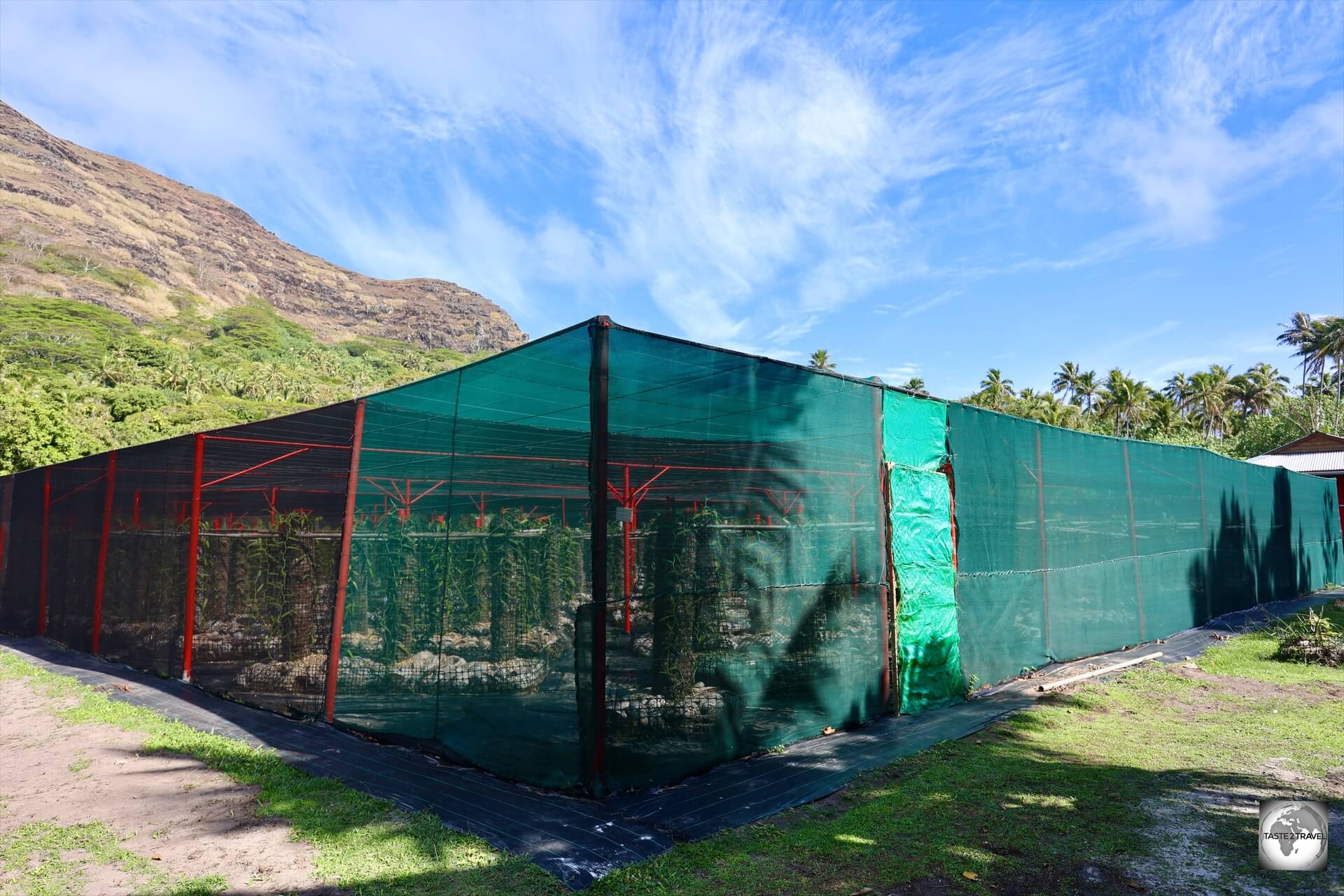
Akamaru Vanilla Farm features two large green houses which are perfectly arranged for the cultivation of vanilla pods.
Vanilla is one of the most expensive spices in the world, with packets of half a dozen pods from Akamaru Vanilla Farm selling for US$50!
This is a veritable gold mine!
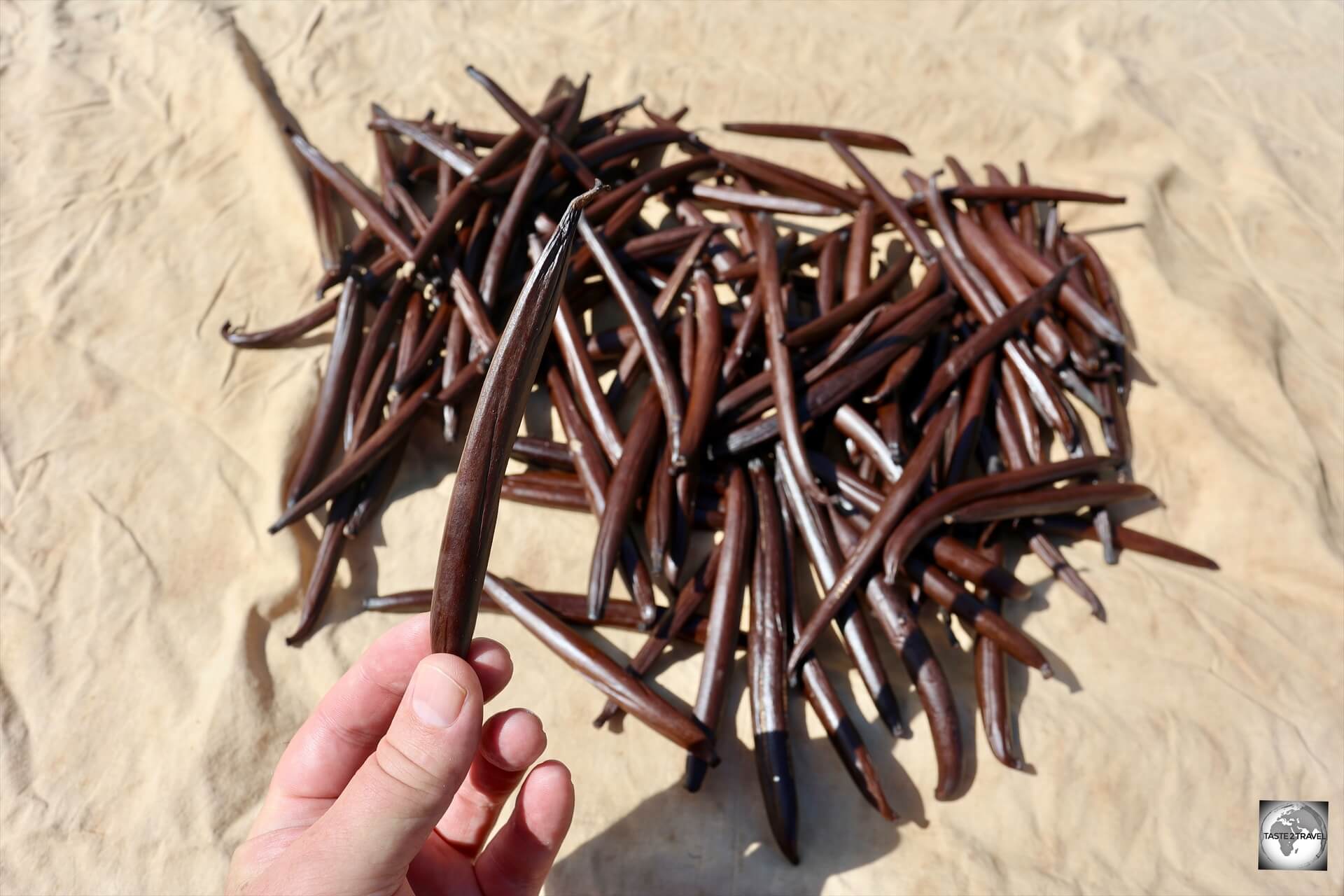
Vanilla pods at Akamaru Vanilla Farm, drying in the sun.
I did ask if I could photograph inside the enclosures but that wasn’t allowed since the plants are highly sensitive to any contamination.
Only a small number of staff are allowed inside the greenhouses.
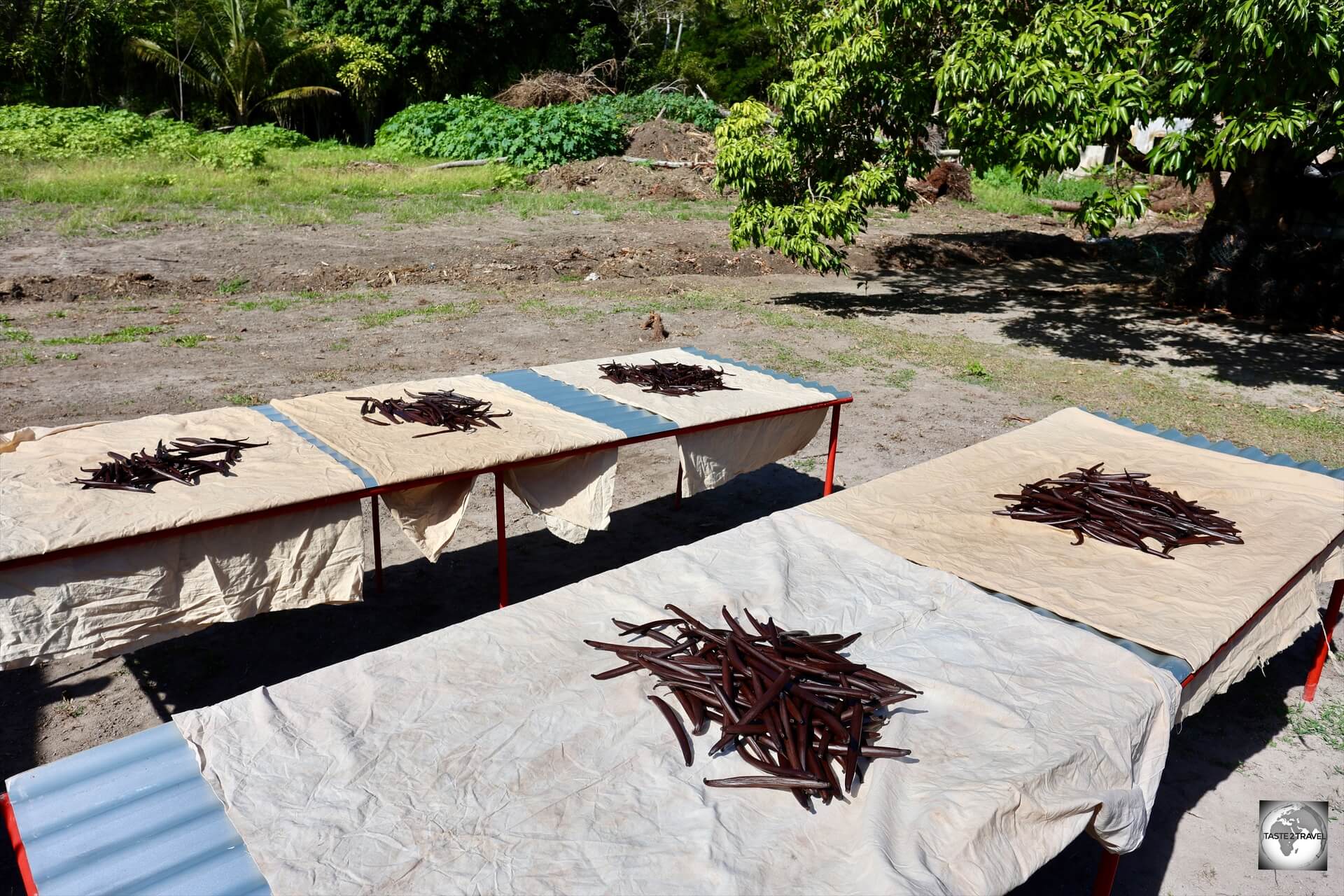
Vanilla pods at Akamaru Vanilla Farm, drying in the sun.
We were however, able to get up close to the pods which had been picked and which were drying in the sun prior to be packaged.
Motu Tauna (Bird Island)
The fourth island we visited on our boat trip was Motu Tauna (Bird Island) which served as our lunch stop.
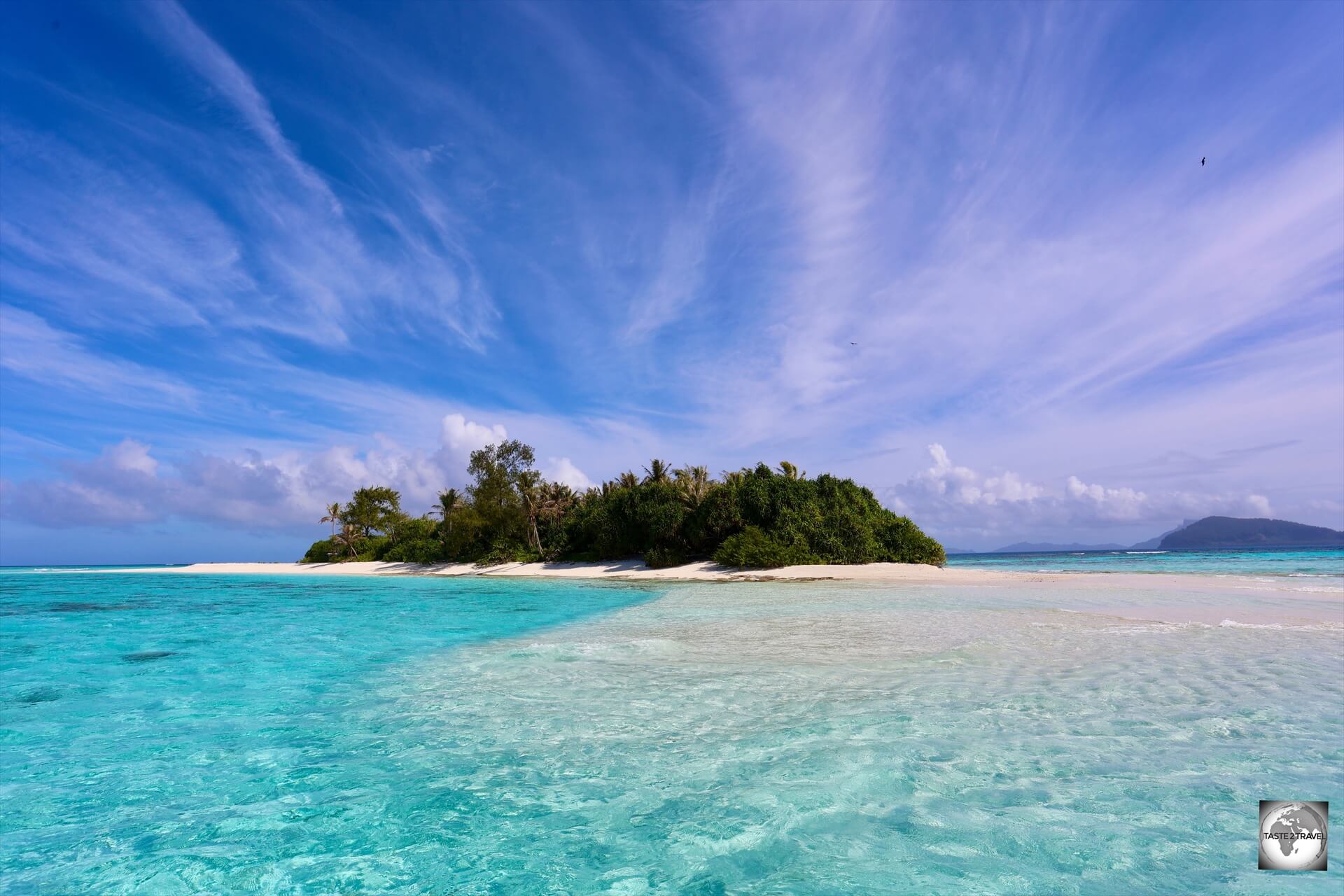
The stunningly beautiful Motu Tauna (Bird Island).
Motu Tauna (aka Bird Island), and pronounced ‘Ta-oo-nah’, is a small coral atoll which is home to nesting seabirds such as White terns and Brown noddy’s.
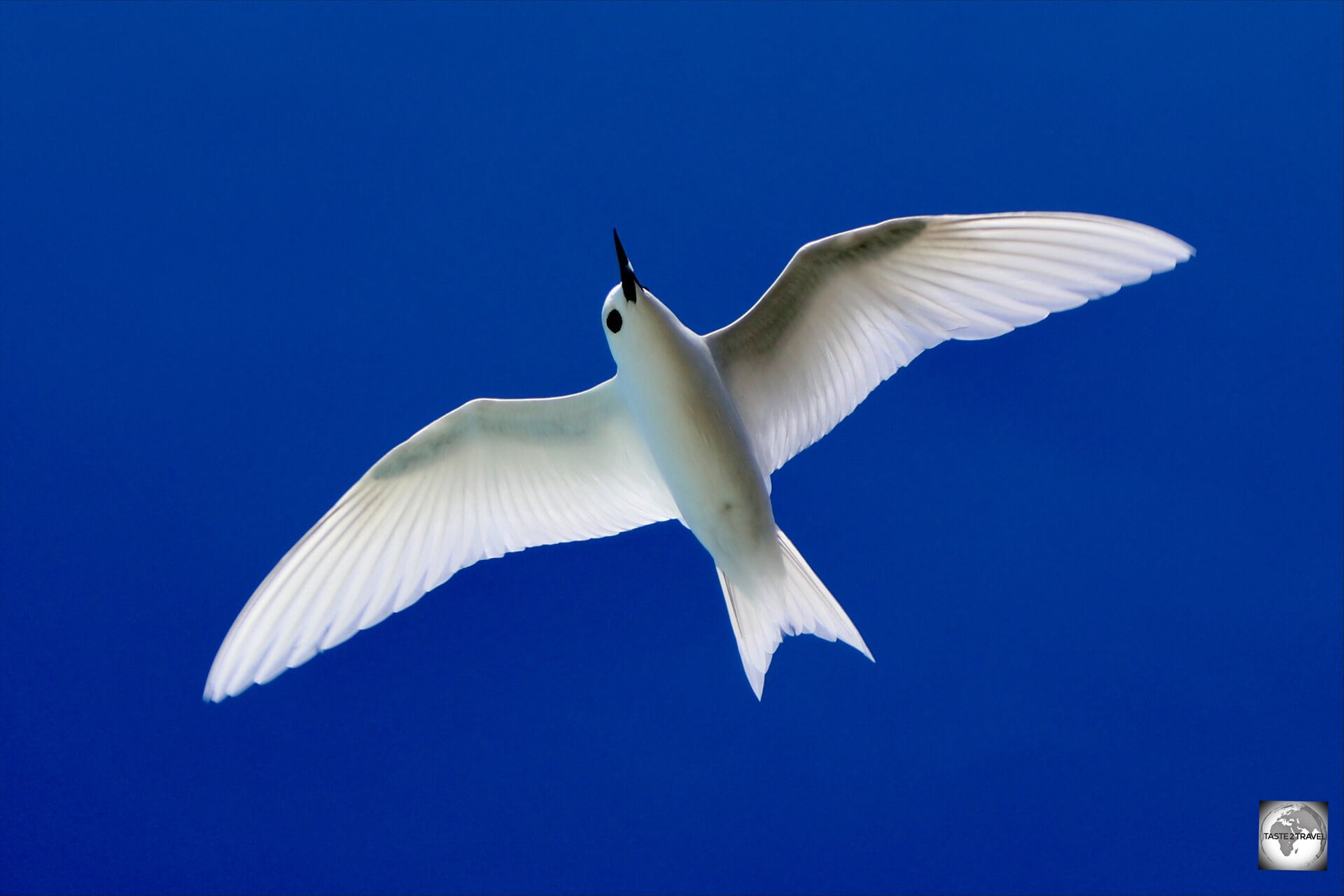
White Fairy tern on Bird Island.
Approaching Tauna is like something out of a dream.
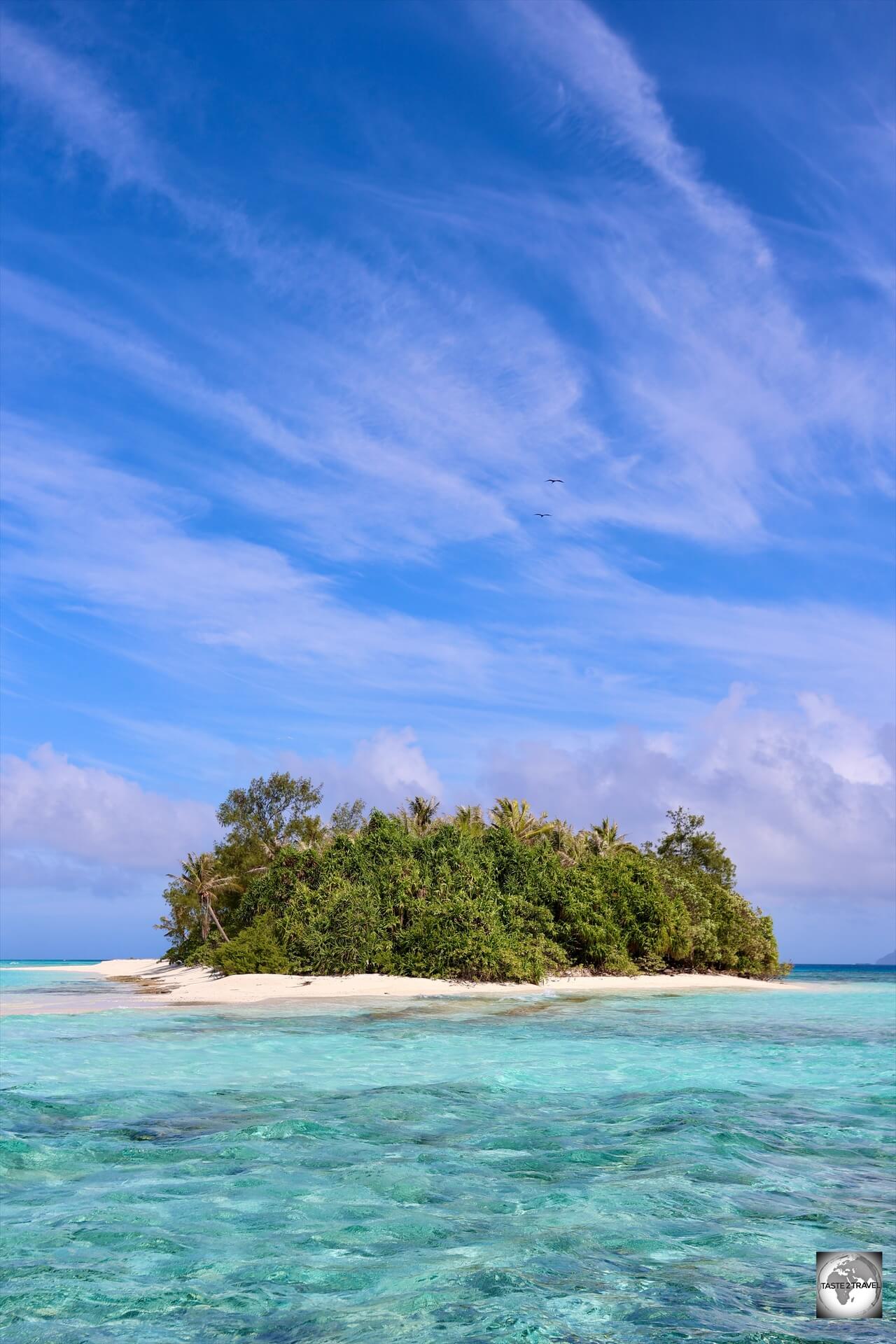
A view of Motu Tauna (Bird Island) – paradise found!
Our boat weaved its way around the fringing coral reef, passing through the most incredible shades of clear blue water: teal, turquoise, cobalt.
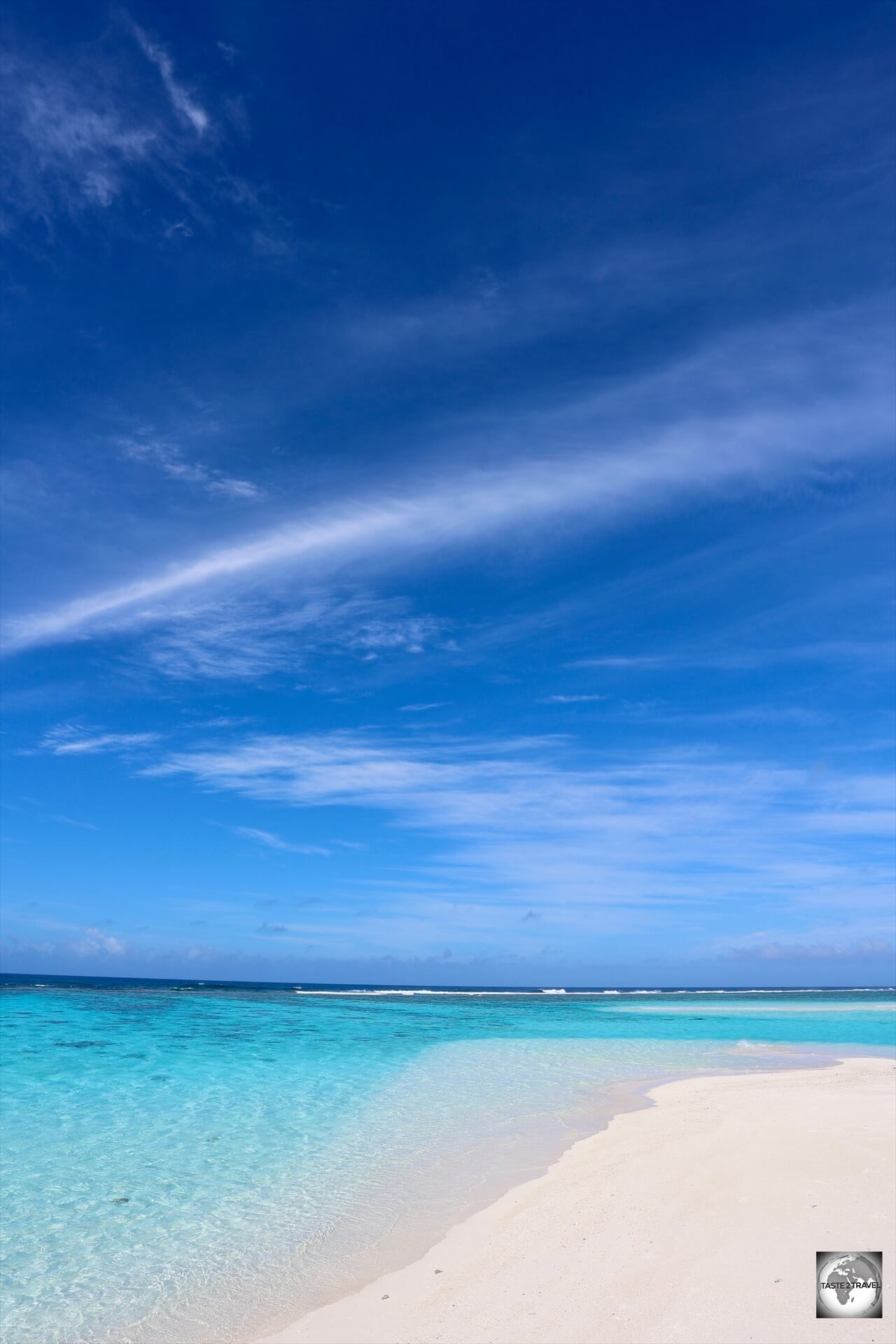
A true paradise – the stunning beach at Motu Tauna (Bird Island).
Rising up in the distance was the lush green vegetation of Motu Tauna.
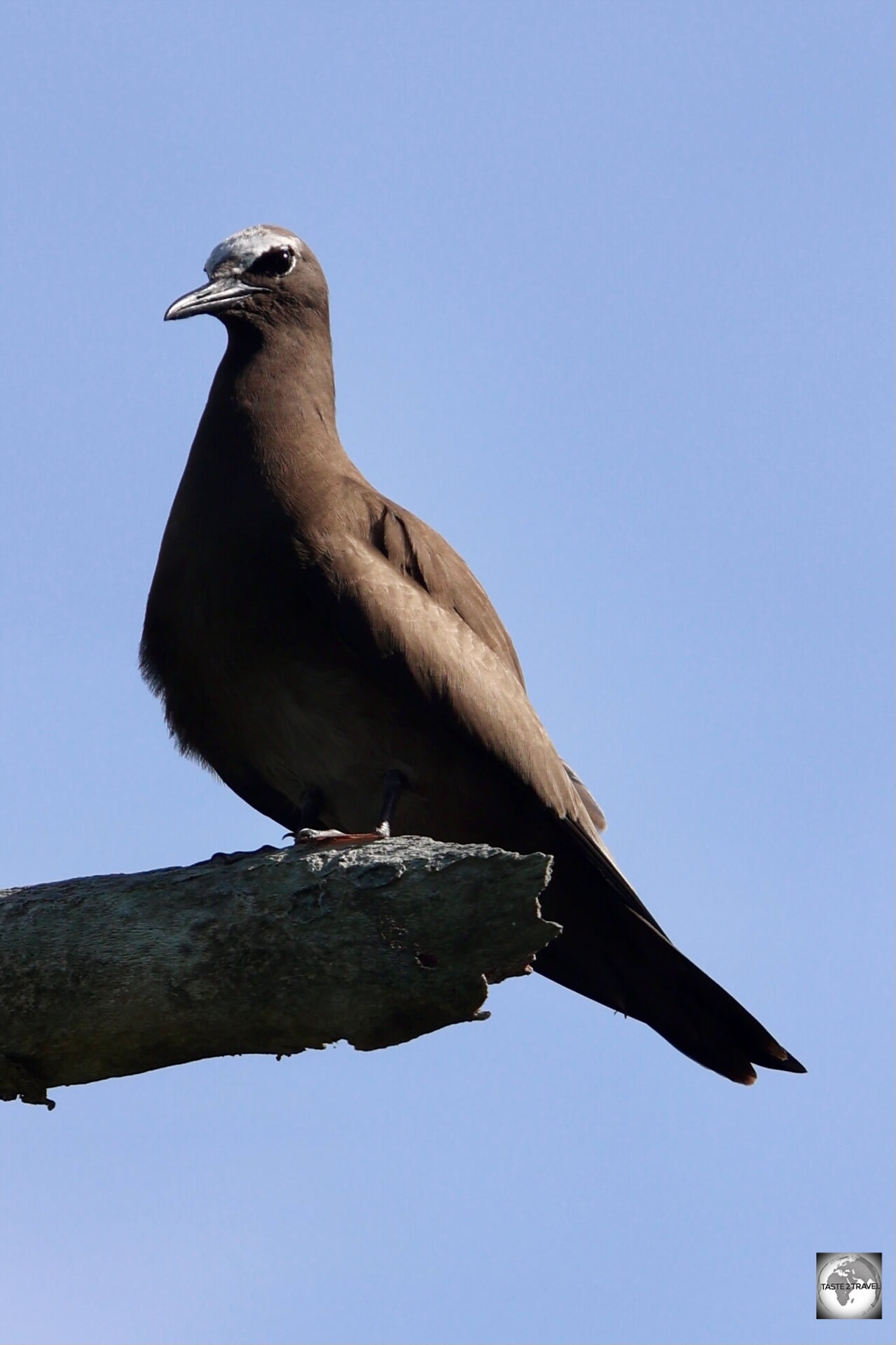
Brown noddy on Bird Island.
This was the definition of a paradise isle!
As we approached the island, we could see flocks of seabirds nesting in the trees.
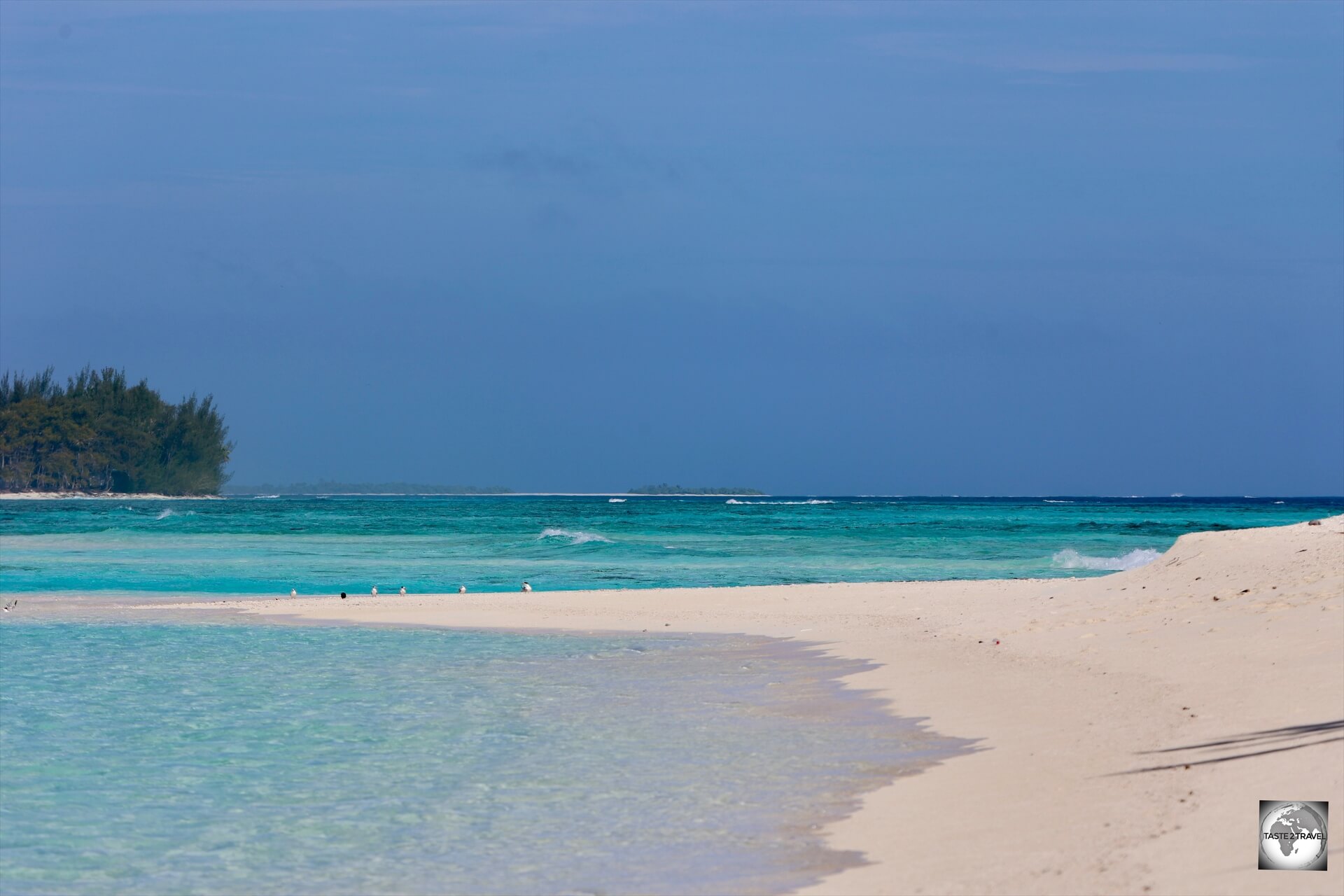
The beach at Motu Tauna (aka Bird Island).
The island served as our lunch stop and was a great place to snorkel, with one juvenile black-tip reef shark swimming close to shore.
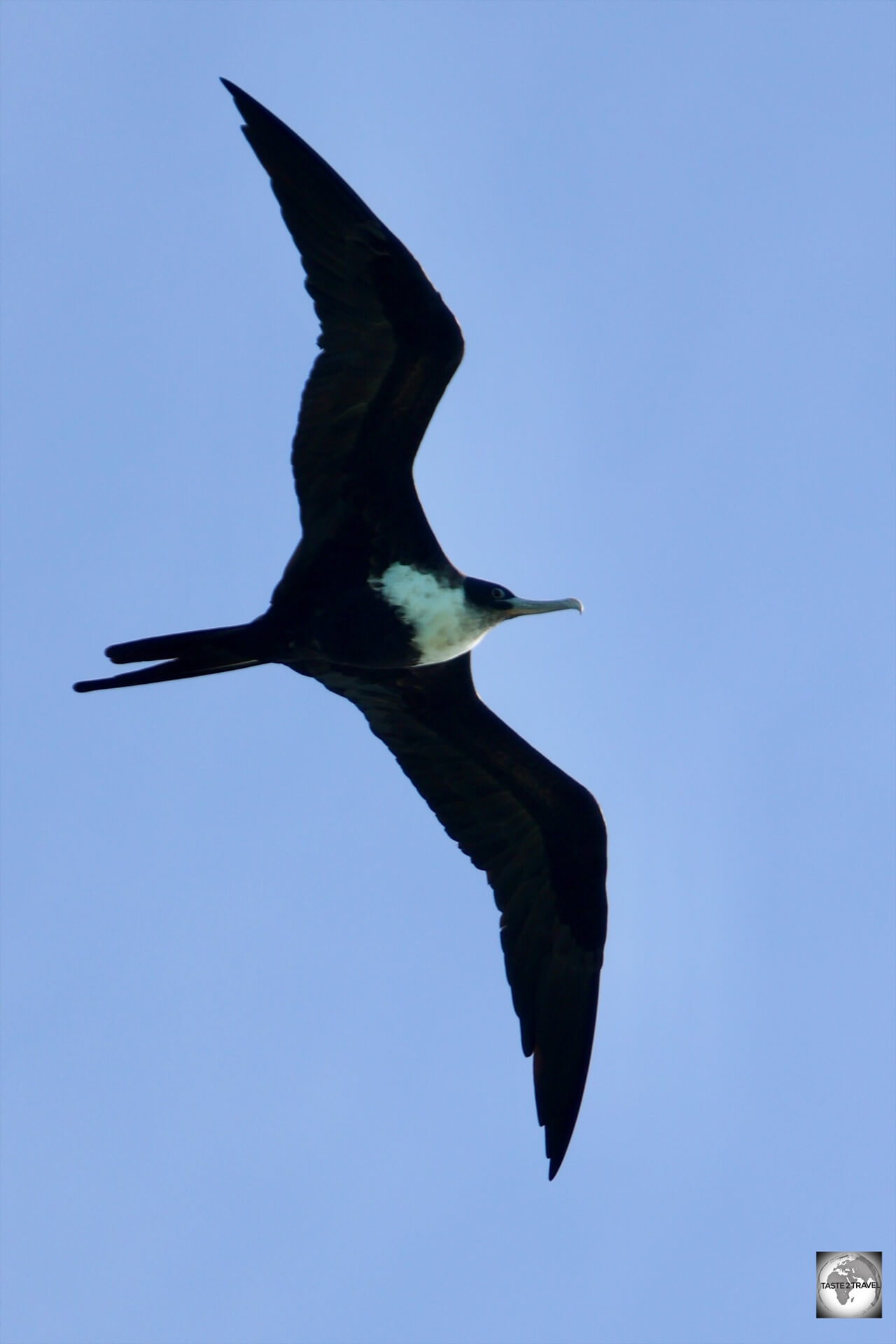
Frigate bird, soaring over Bird Island.
If you enjoy bird photography, the island allows you to get up close to the birds who are nesting in low trees.
Magical!
Aukena Island
The fifth, and last island, we visited on our boat trip was Aukena Island.
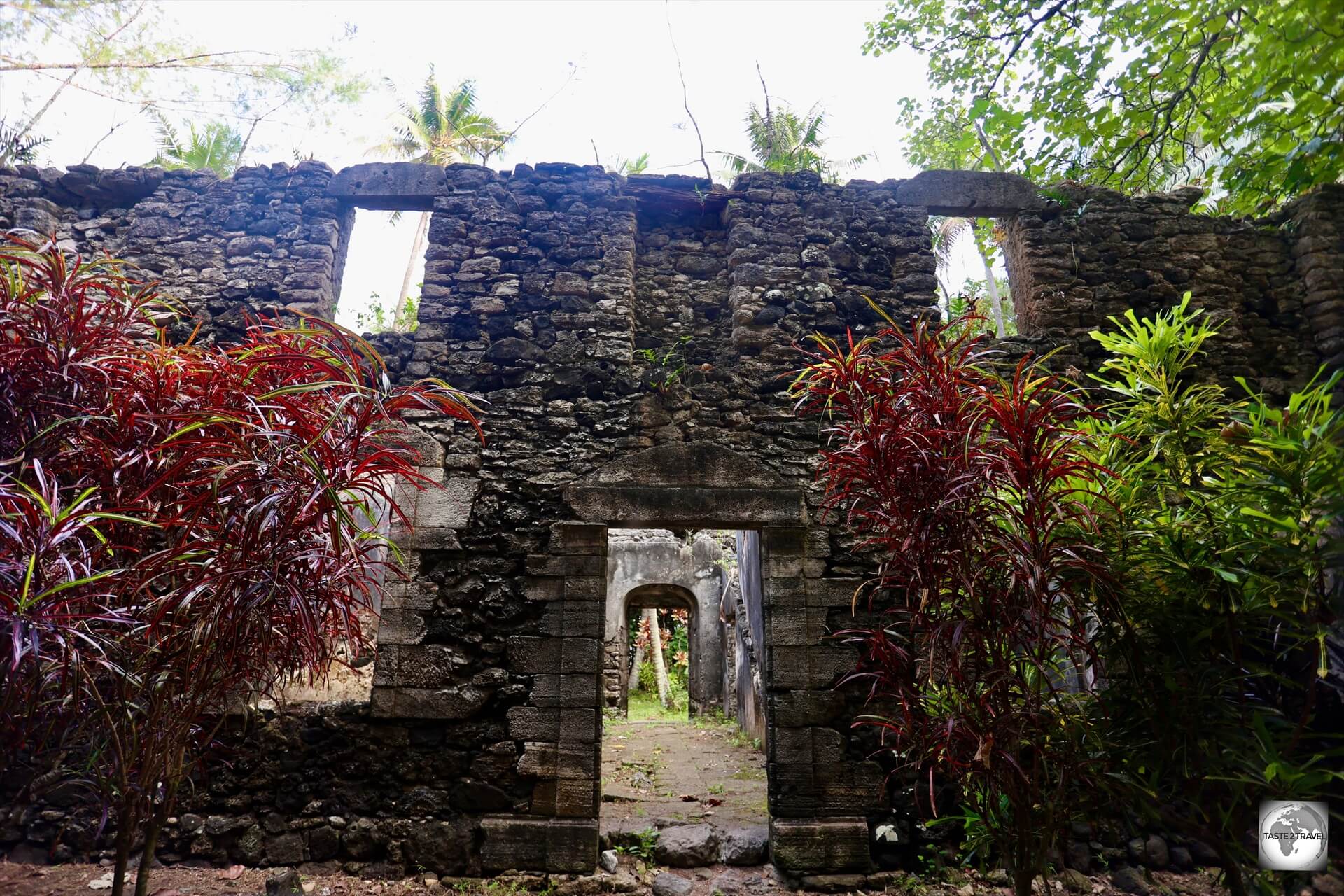
Ruins of Re’e Seminary College, the first college of French Polynesia, Aukena Island.
Located about 5 km southeast of Mangareva, Aukena measures 2.5 km in length and 0.5 km in width with a total area of just 1.35 km².
Aukena has reminders of the missionary period, including a hexagonal lookout tower, still used as a landmark, the former Re’e Seminary College and a huge lime kiln.
About 40 people live on Aukena Island and much of the island’s land (if not all) is privately owned by the Robert Wan pearl company.
As per the company website, the cooler waters which surround Aukena Island result in oysters producing darker shades of green and silver pearls.
Re’e Seminary College
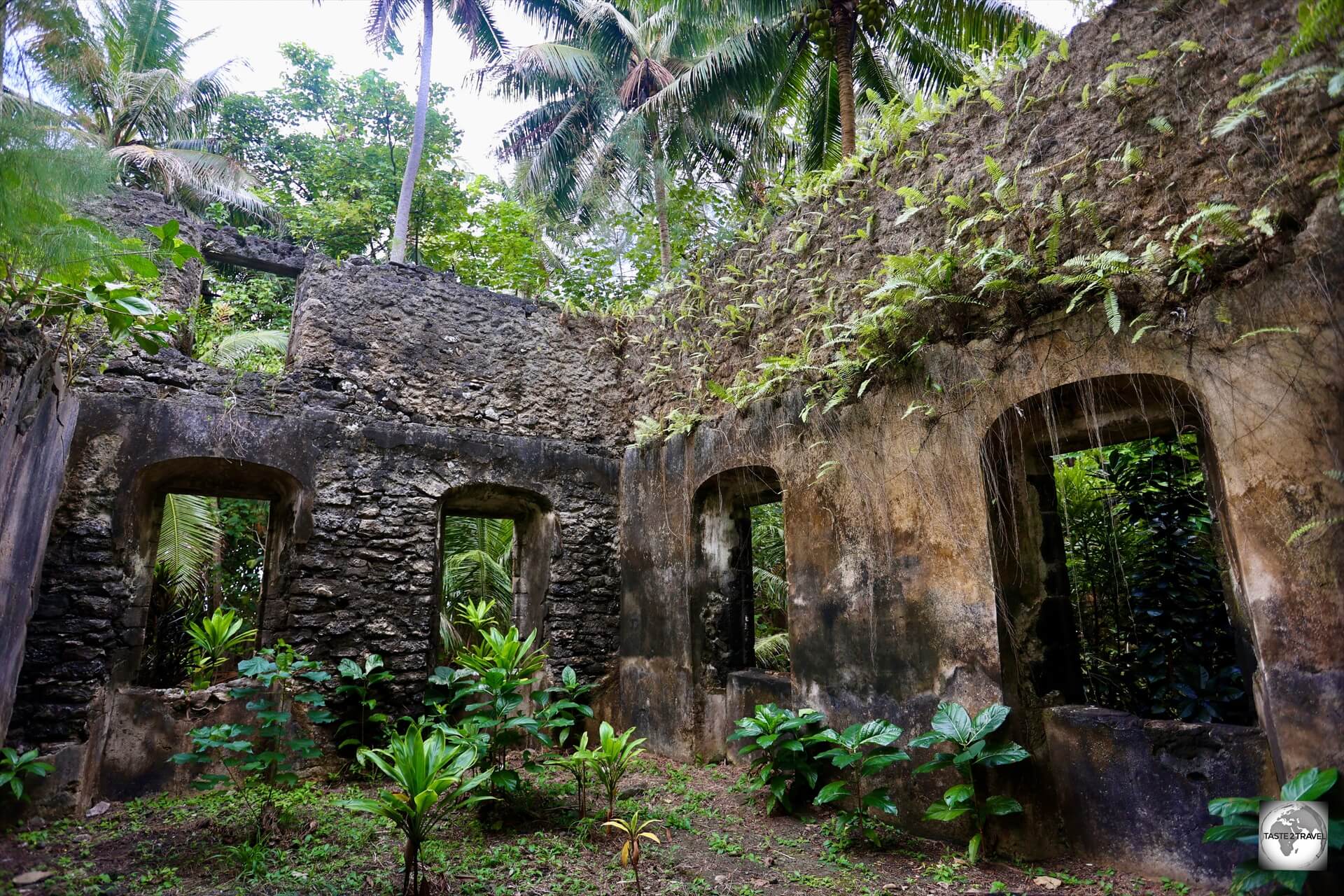
Ruins of Re’e Seminary College, the first college of French Polynesia, Aukena Island.
Ruins of the Re’e Seminary College on Aukena, one of the earliest institutions of higher learning in French Polynesia, where King Te Ma-puteoa received his education.
Due to the death of his father, Te Ma-puteoa became King at the age of just ten.
His mother Queen Maria Eutokia Toaputeitou assumed the regency, although the French missionary Father Laval had extensive control over the royal mother and son and was considered the true power behind the throne.
During most of his reign, the young king was educated by the French missionaries at the Re’e Seminary College on Aukena Island.
He only left Aukena Island to visit Mangareva on ceremonial occasions. The young King died at the age of 21!
Lime Kiln
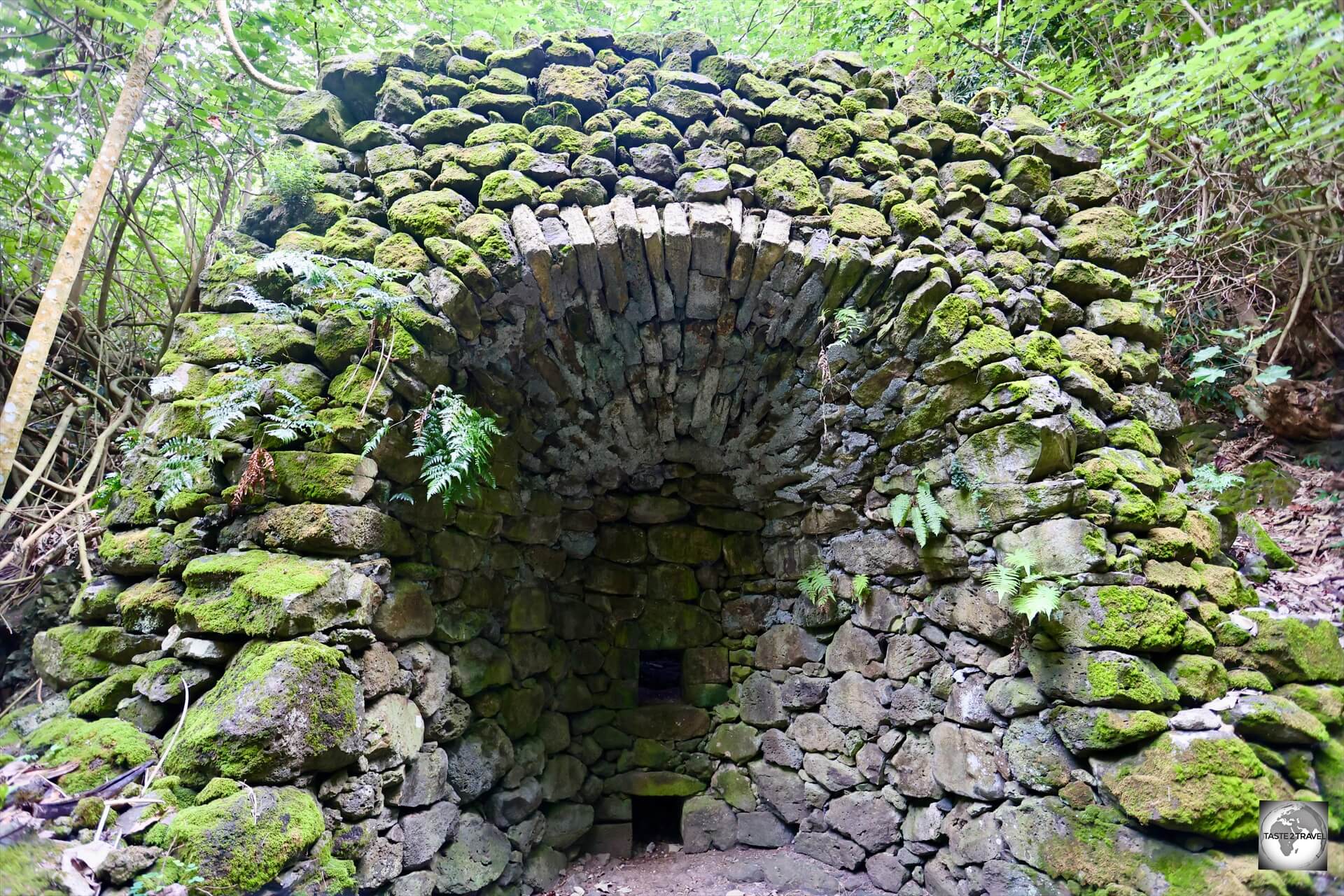
An old coral lime oven on Aukena Island.
A short walk from the abandoned seminary, hidden deep inside the tropical forest, is a huge lime kiln which was used to burn coral to produce the vast quantities of lime powder which was required for the construction of the many stone buildings which the French missionaries built.
Accommodation
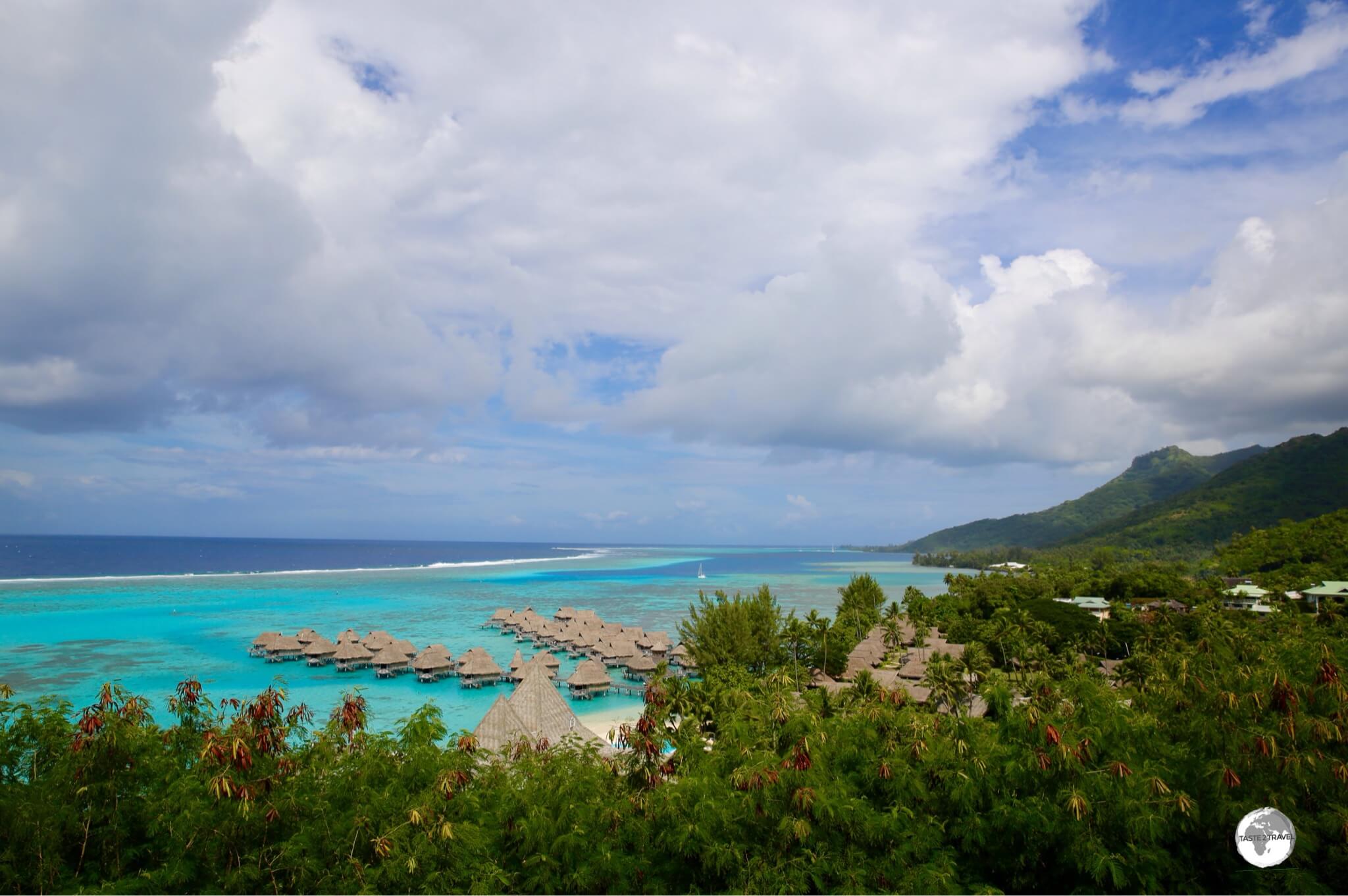
There’s no shortage of deluxe accommodation options in French Polynesia, including the Sofitel resort on the island of Moorea.
Tahiti
Papeete
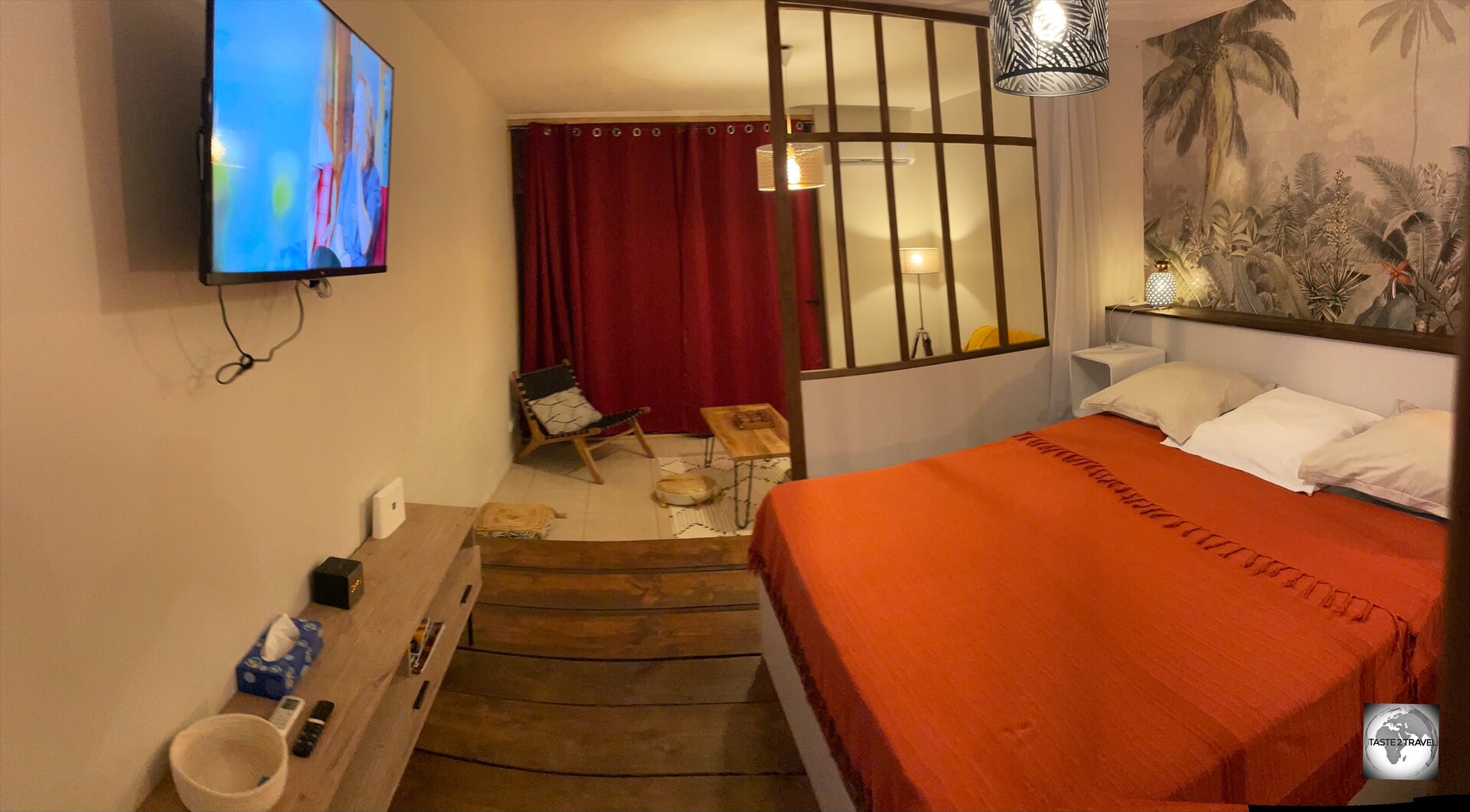
A view of the modern and stylish Studio Poe Rava in Papeete, my comfortable apartment during my last visit to Papeete.
Being home to almost 70% of the entire population, there’s no shortage of accommodation options on the main island and in the capital of Papeete.
Options range from the top-end Hilton Hotel Tahiti, where a standard room costs from US$330 per night, to a private apartment which will cost around US$100 per night.
I have yet to find a budget hostel in Papeete.
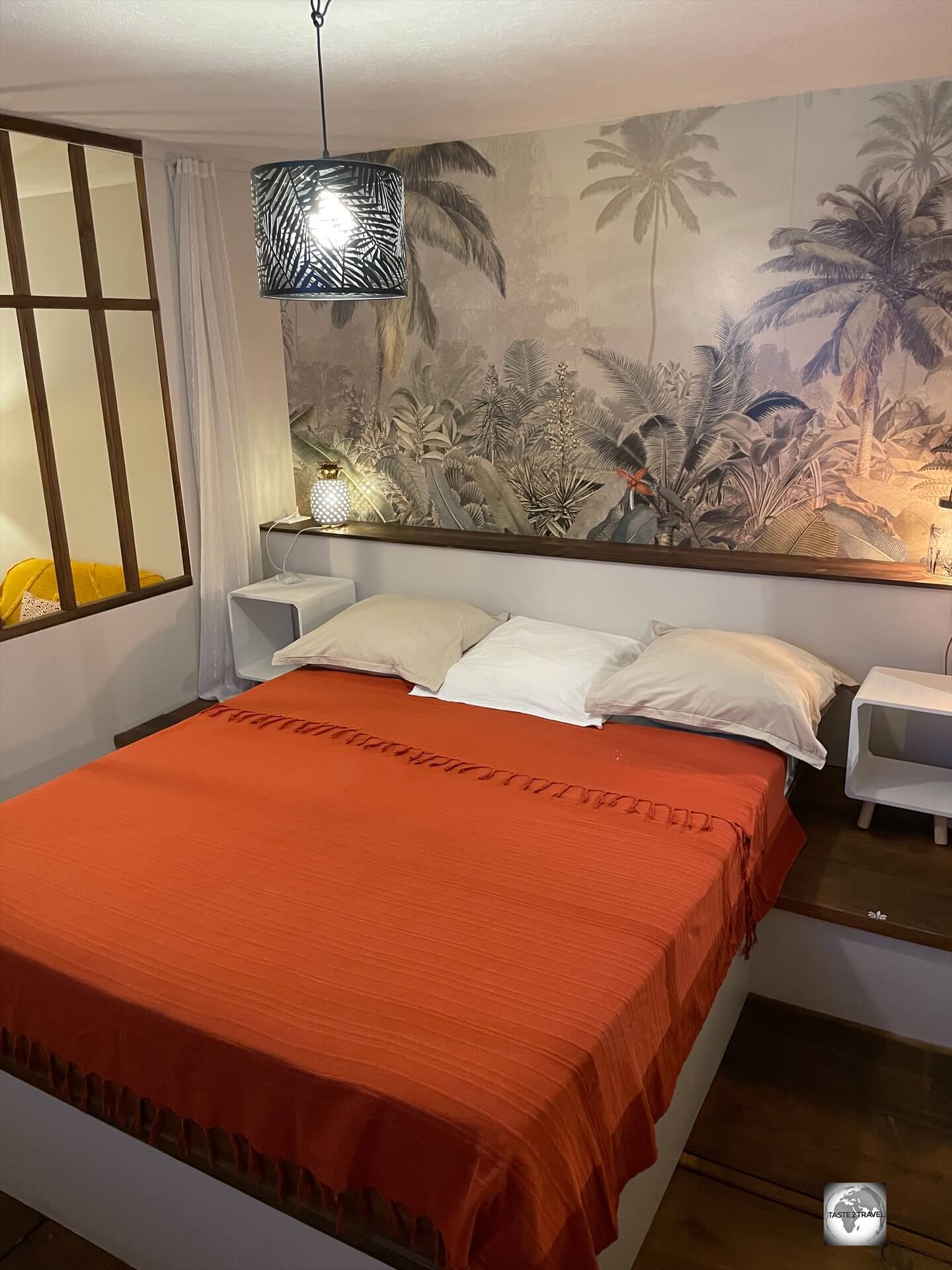
A view of my bedroom at Studio Poe Rava in Papeete.
On my last visit to Papeete (June 2024), I stayed at the beautiful and comfortable Studio Poe Rava which can be booked online on booking.com
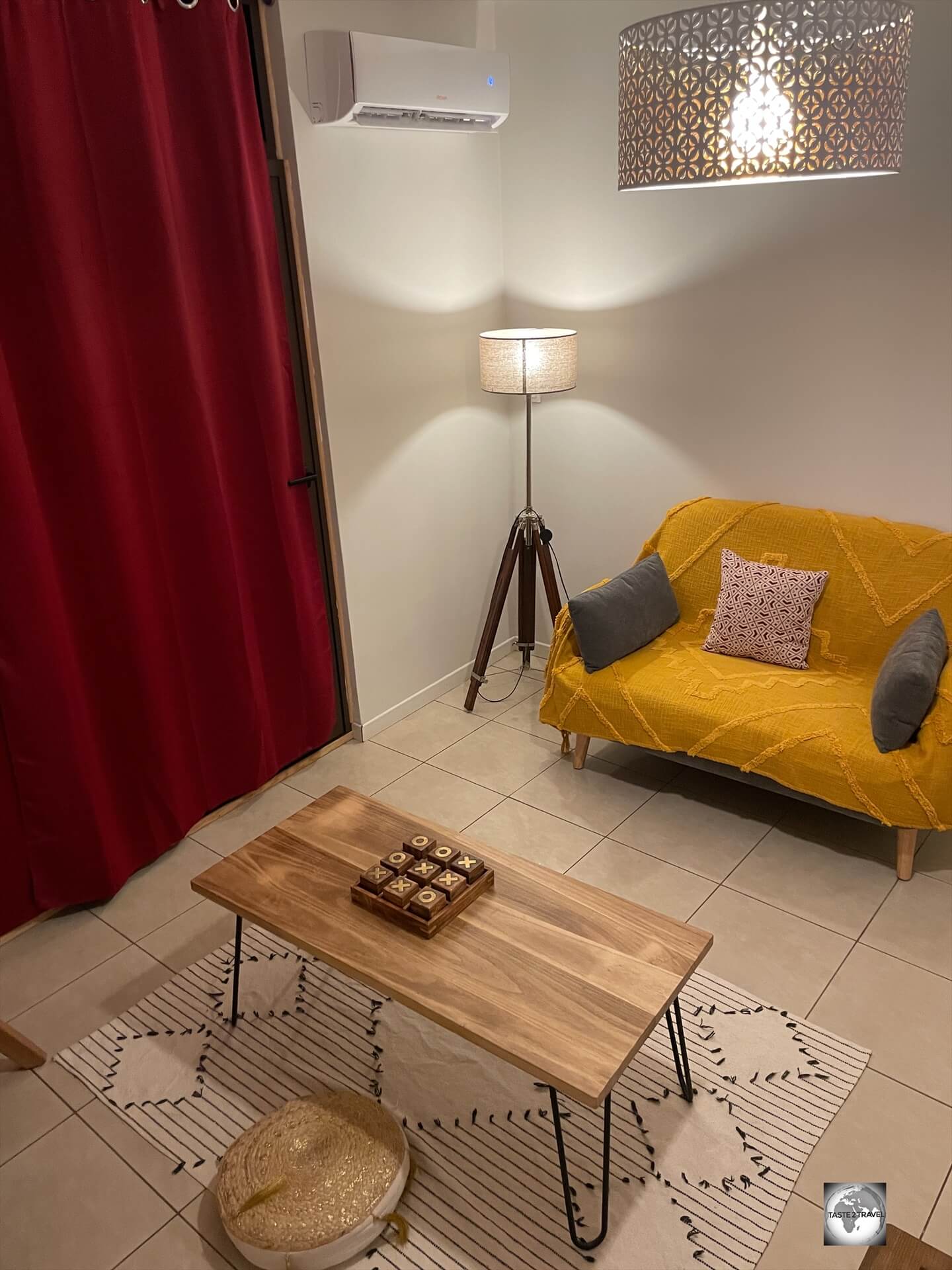
A view of the sitting room at Studio Poe Rava in Papeete.
The apartment costs US$100 per night and includes a washing machine, kitchen, sitting area, WiFi and all the features you’d expect from a modern apartment.
The only quirk with this apartment is that the owner, Dorothée – a wonderfully friendly French lady – excepts payment in the form of cash or bank transfer only.
Dorothée has several apartments for rent in Papeete and can be contacted directly on WhatsApp at: +689 87 77 25 80.
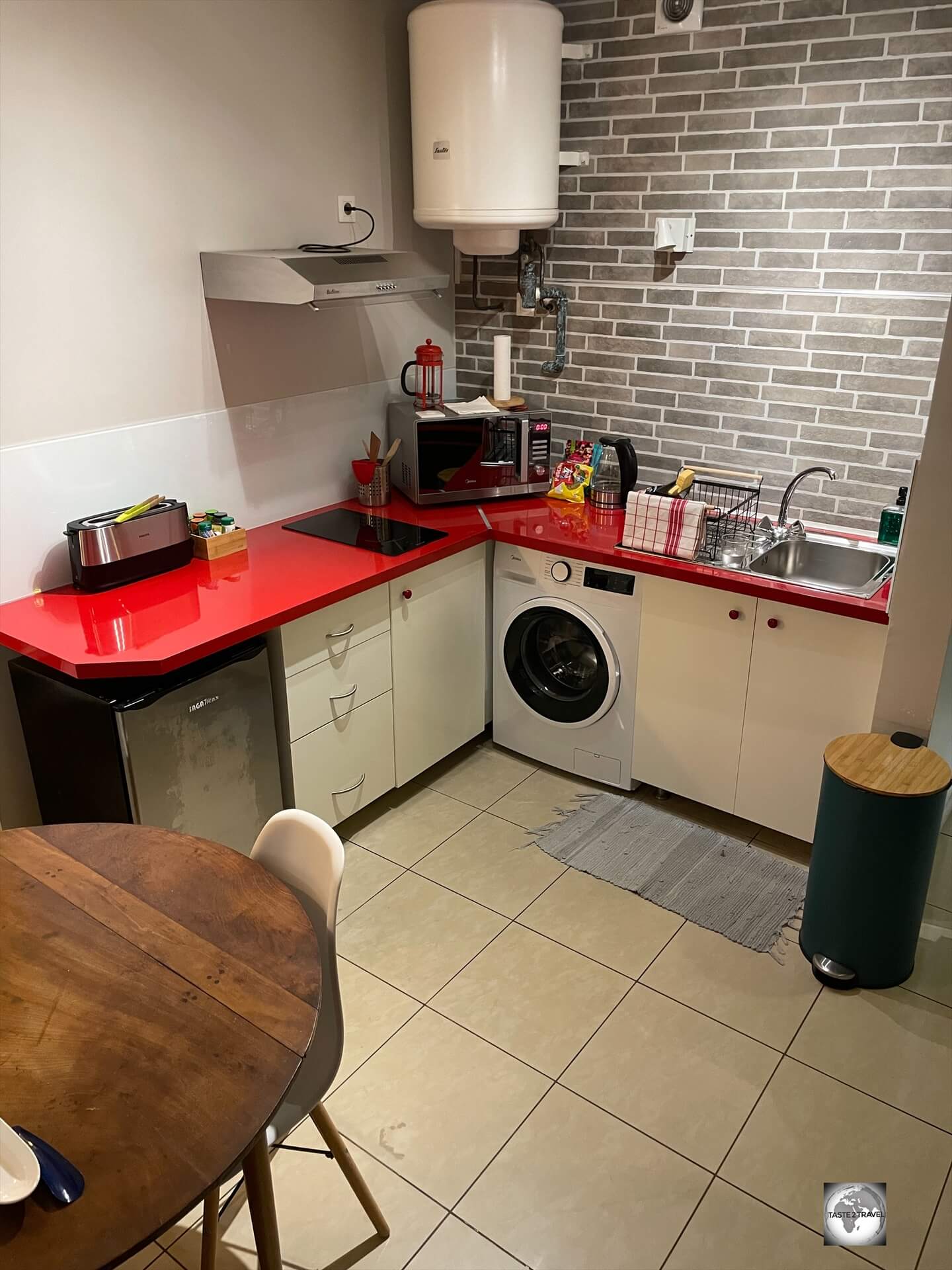
A view of the kitchen, which included a washing machine, at Studio Poe Rava in Papeete.
The apartment is located on the main road which runs along the waterfront, a short walk from downtown Papeete.
It’s totally convenient for exploring all the sights of the city and a short walk from restaurants and cafes.
Highly recommended is La Pizzeria which is located next door and serves delicious wood-fired pizzas and traditional pasta dishes.
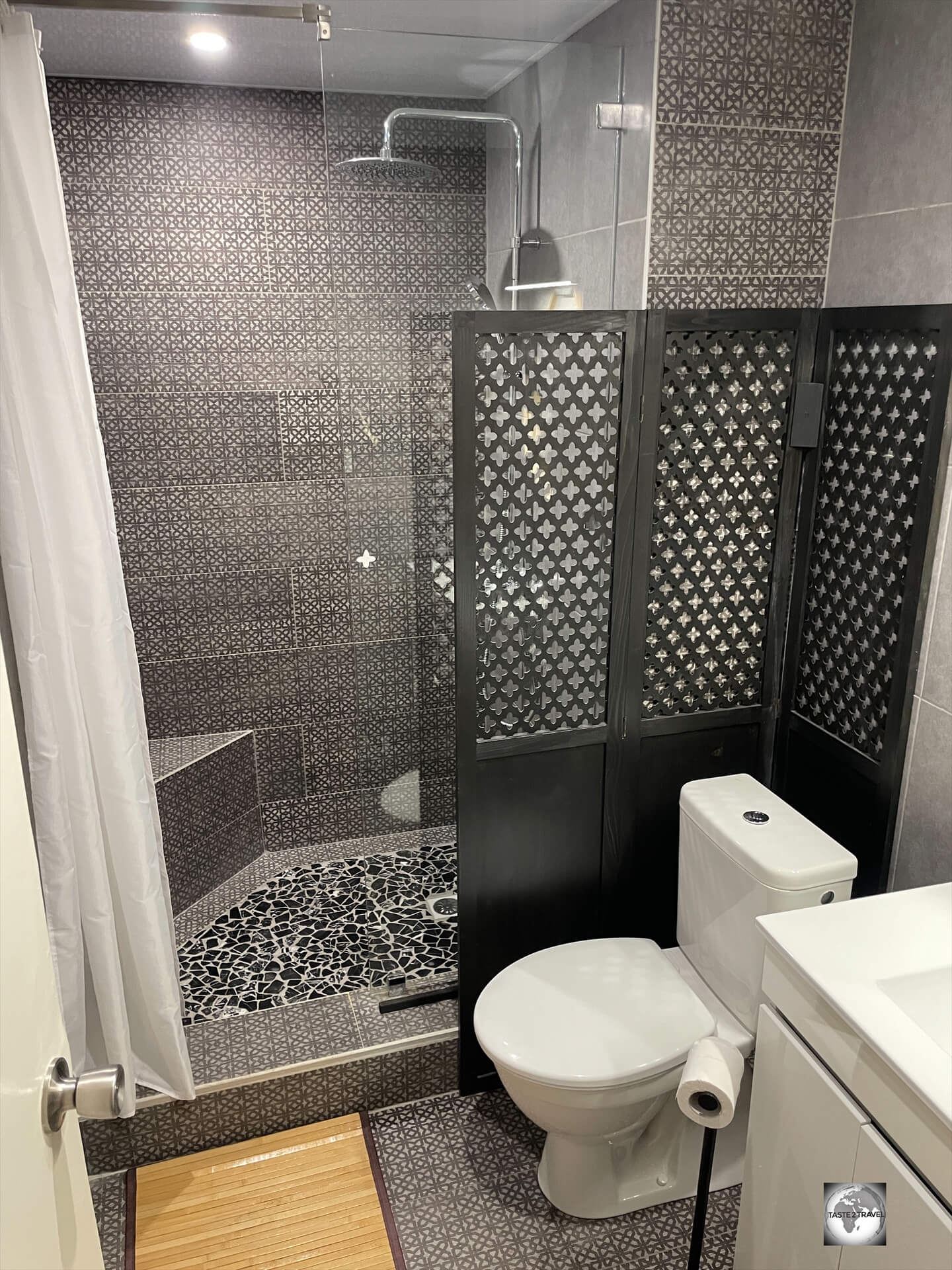
The bathroom at Studio Poe Rava in Papeete.
Studio Poe Rava is totally convenient for exploring all the sights of the city and a short walk from restaurants and cafes.
Highly recommended is La Pizzeria which is located next door and serves delicious wood-fired pizzas and traditional pasta dishes.
Moorea
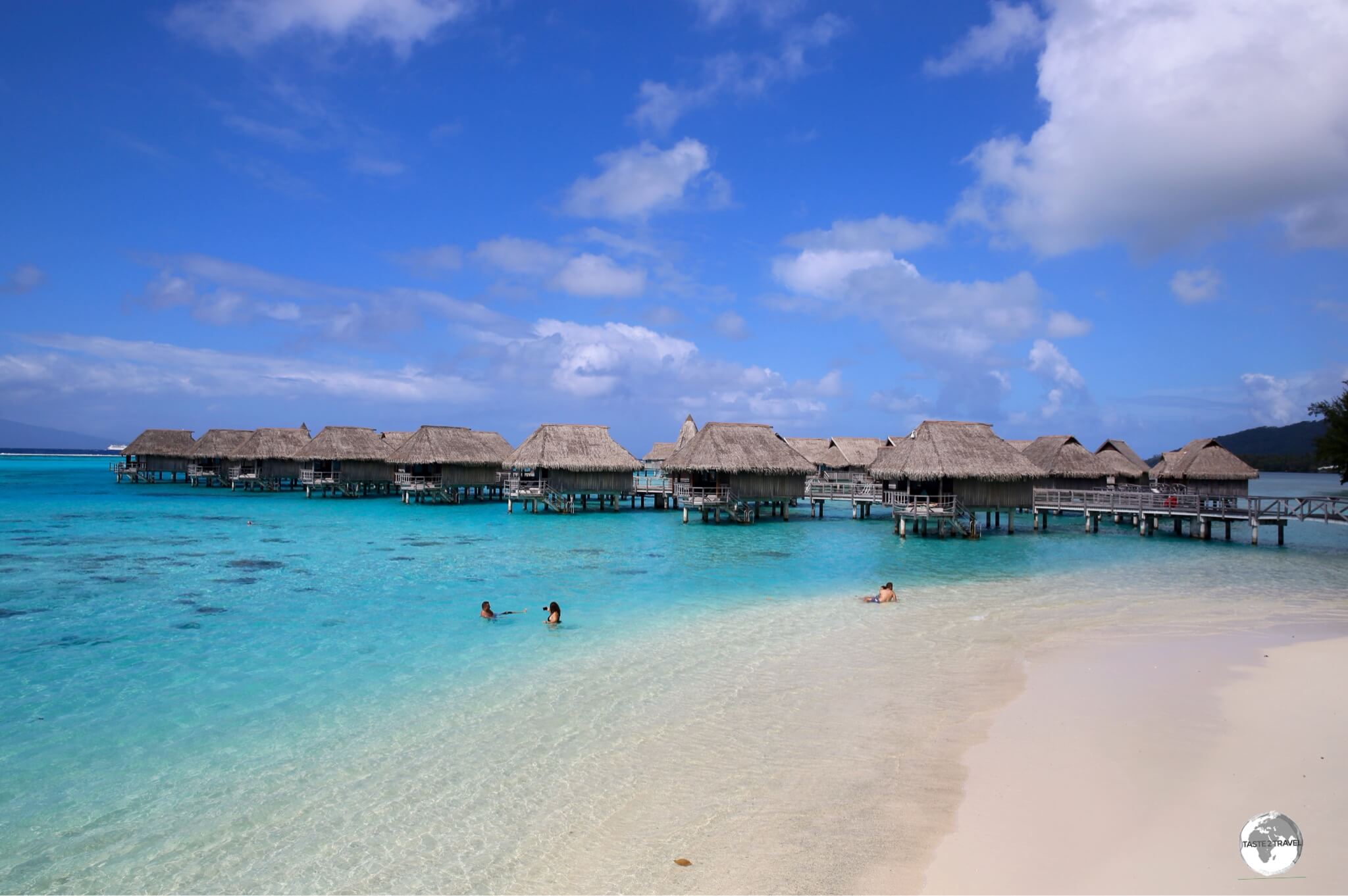
Both the Hilton and Sofitel offer ‘over-the-water’ bungalows at their Moorea resorts.
While there are more deluxe options on Moorea, I chose to stay at the relaxing and humbler Linareva Moorea Beach Resort which is a seaside lodge located in the remote west coast village of Haapiti.
If staying here, it’s best to have your own transport.
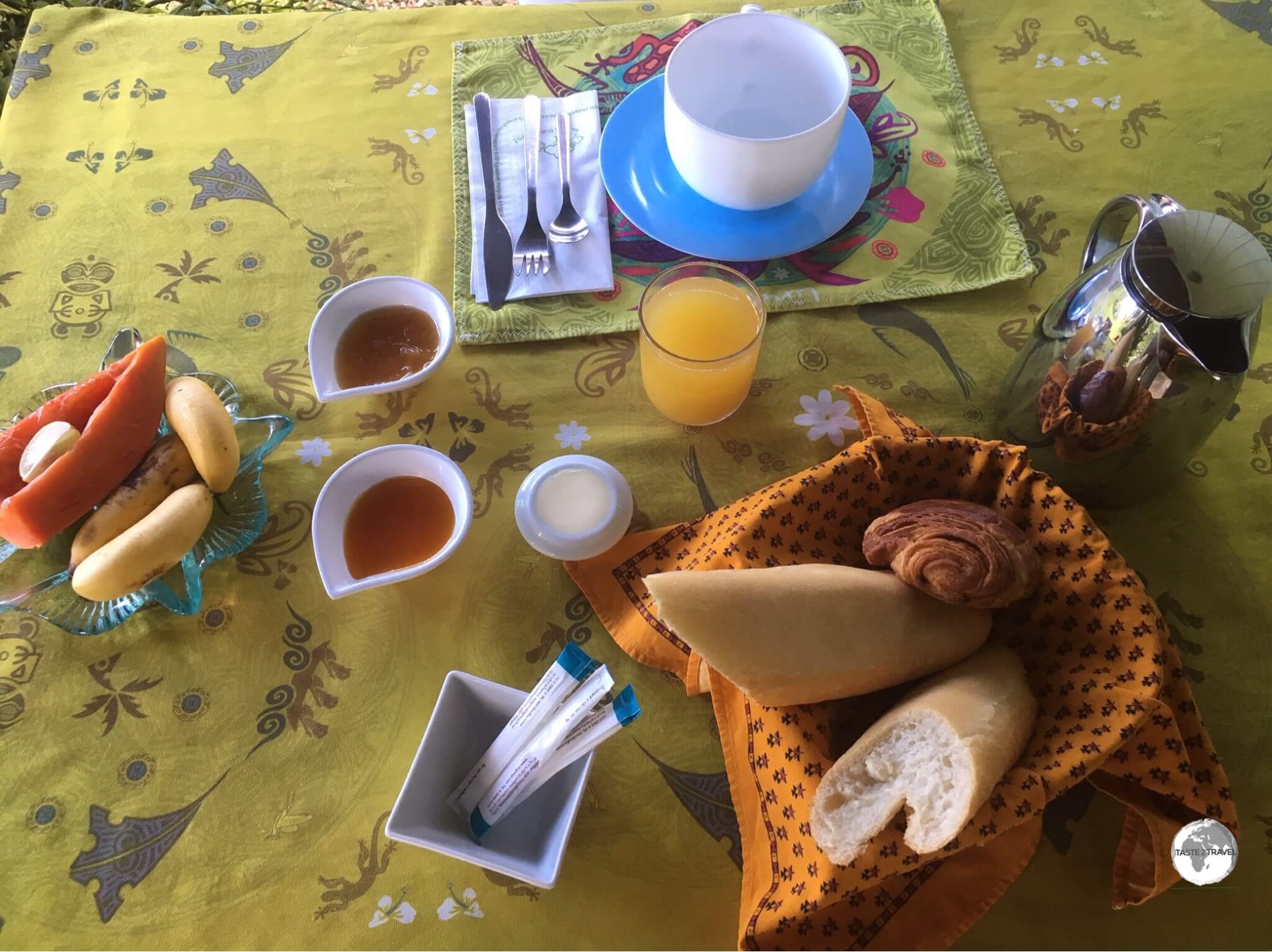
Breakfast at the Linareva Moorea Beach Resort.
Room rates are from USD$150 upwards, which is cheap for Moorea.
This doesn’t include breakfast which is available for an extra 1,500 CFP and includes fruit, coffee and a few pastries. A load of washing cost me USD$25.
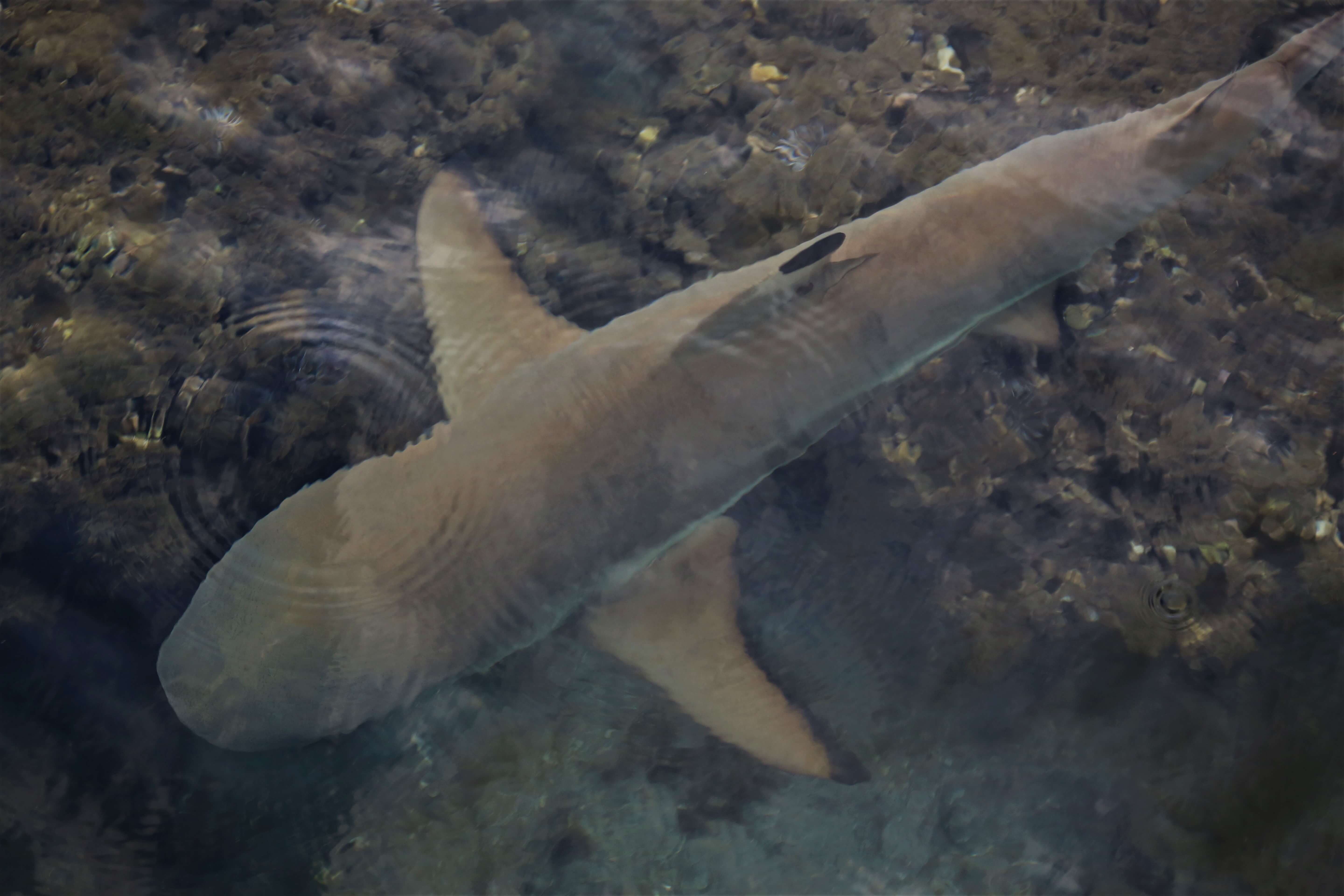
Just one of several large and friendly Nurse sharks which visited the jetty at Linareva Moorea Beach Resort each evening.
The owner of the resort, Roland, use to run the dive shop up the road and, over the years, has trained the local sharks to come to his wooden jetty (a little food doesn’t hurt).
Each evening, (large) Lemon, (numerous) Black-tip and several (huge) Nurse sharks appear from the murky depths.
All are very friendly and don’t mind you swimming around them.
A great snorkeling experience!
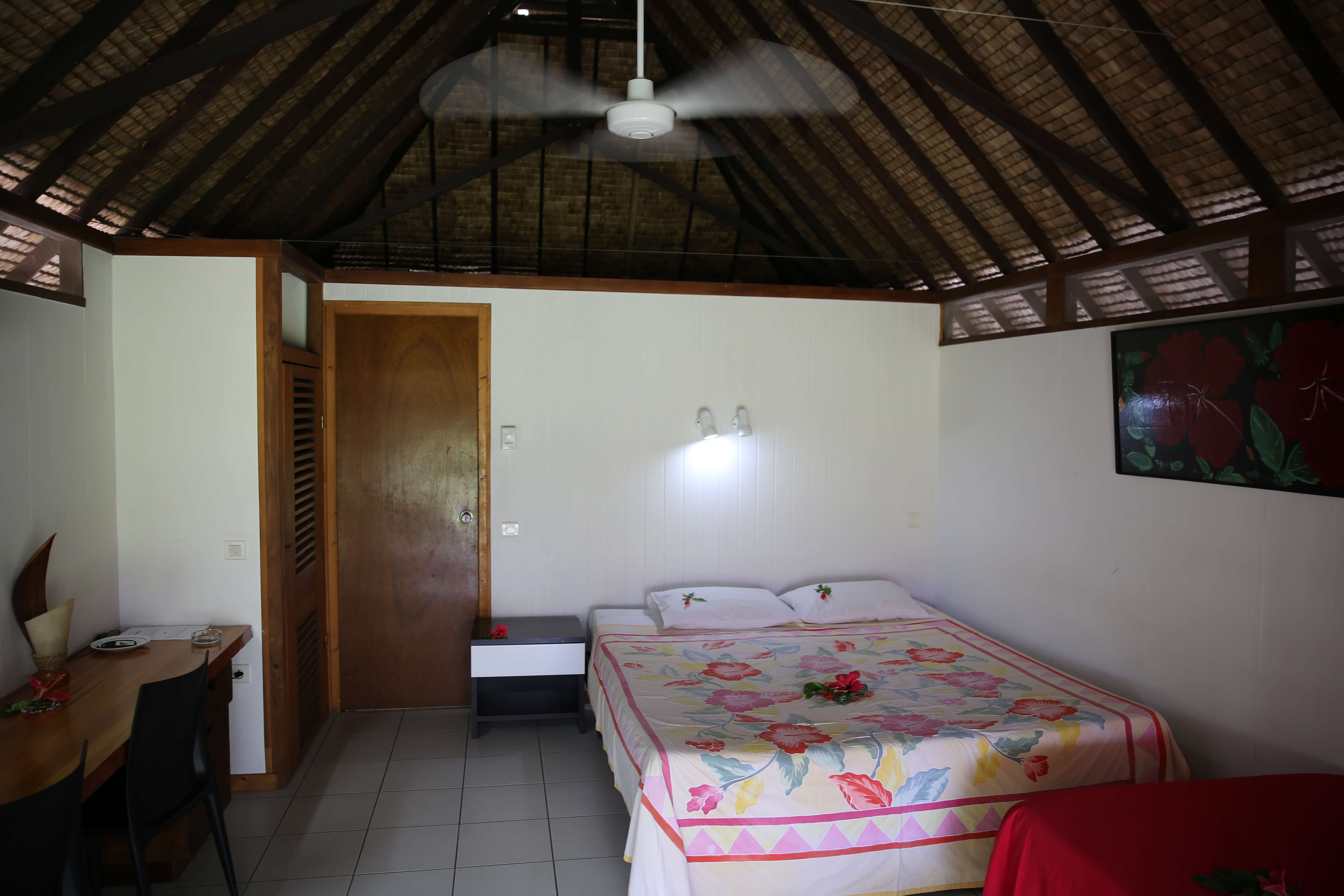
My bungalow at Hotel Hibiscus on Moorea.
Also on Moorea, I stayed at the Hotel Hibiscus which offers spacious bungalows arranged around a well-maintained garden (by the seaside) from USD$150.
The bungalows include a kitchenette which allow some self-catering and nearby restaurants offer free shuttle services for those wishing to dine.
Mangareva

The view of my very basic homestay on Mangareva.
While there are no hotels on Mangareva, several families rent out rooms in their homes.
These guesthouses can be found, and booked online, on Airbnb (click to view all guest houses), where the cost of a room averages around US$100 per night.
There are about 7 guesthouses listed on Airbnb!
I stayed in a very basic guesthouse which provided no meals – a real problem on an island without restaurants or cafes.
Recommendation: The best accommodation option on Mangareva is Pension Maro’i who do offer breakfast and dinner options and also operate a fantastic lagoon day trip each Thursday. Do not stay anywhere else on Mangareva!
Tip:
Since there are no banks or ATMs on Mangareva, and you need to carry enough cash from Papeete to cover your stay, it’s best to book and pay online in advance for your accommodation on Airbnb.
The advantage of booking online with Airbnb is that your biggest expense (accommodation) has been paid for – very important in a place where you have no access to cash!
You only need to ensure you carry enough CFP (Pacific Francs) to cover meals and other incidental costs – such as black pearls!
Eating Out
Tahiti
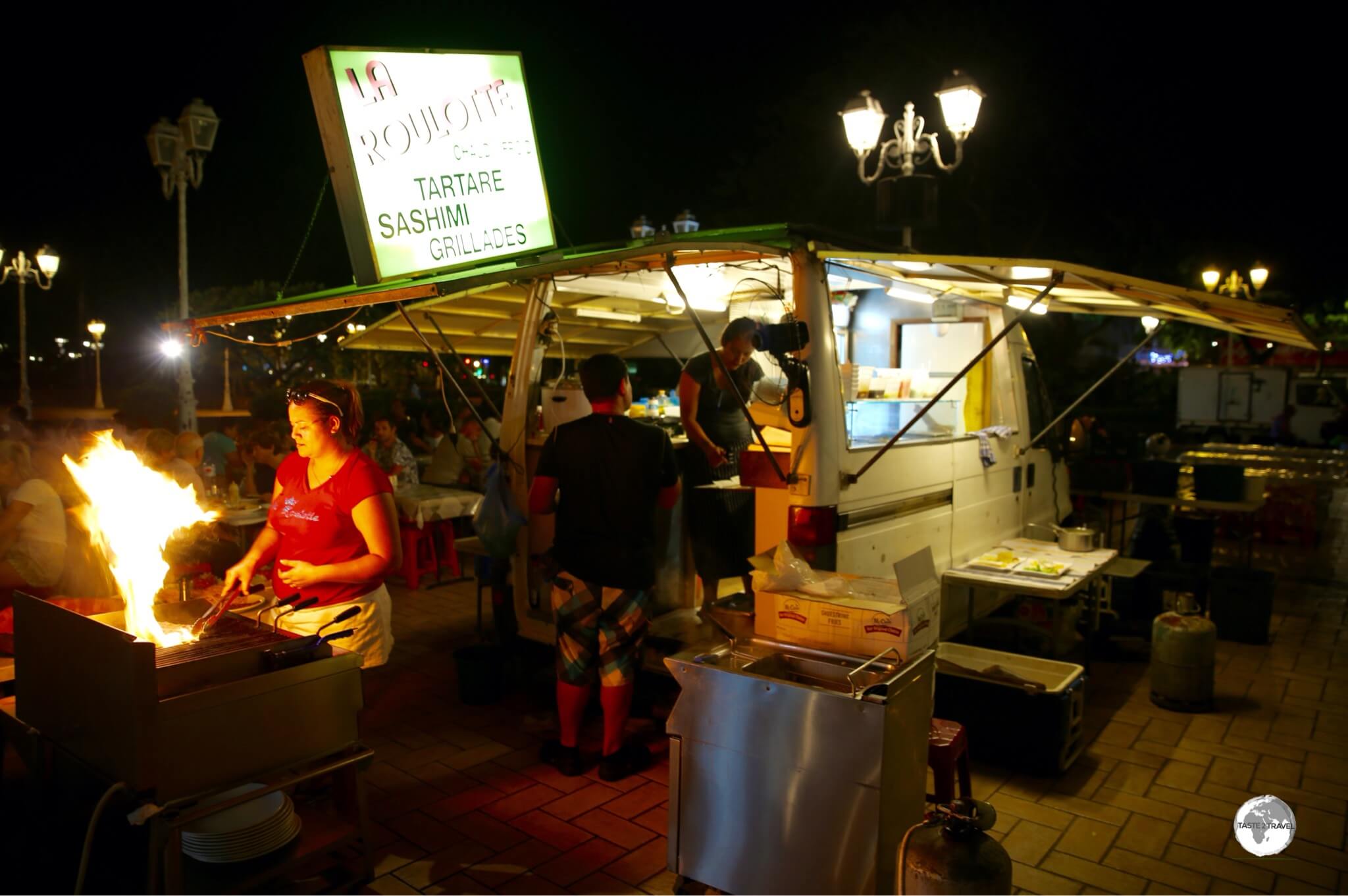
The budget-friendly meals served by the various Roulottes in Papeete each evening is the most popular dining experience in town.
Papeete is well endowed with cafes, bars and restaurants, offering plenty of opportunities to sample local and French cuisine.
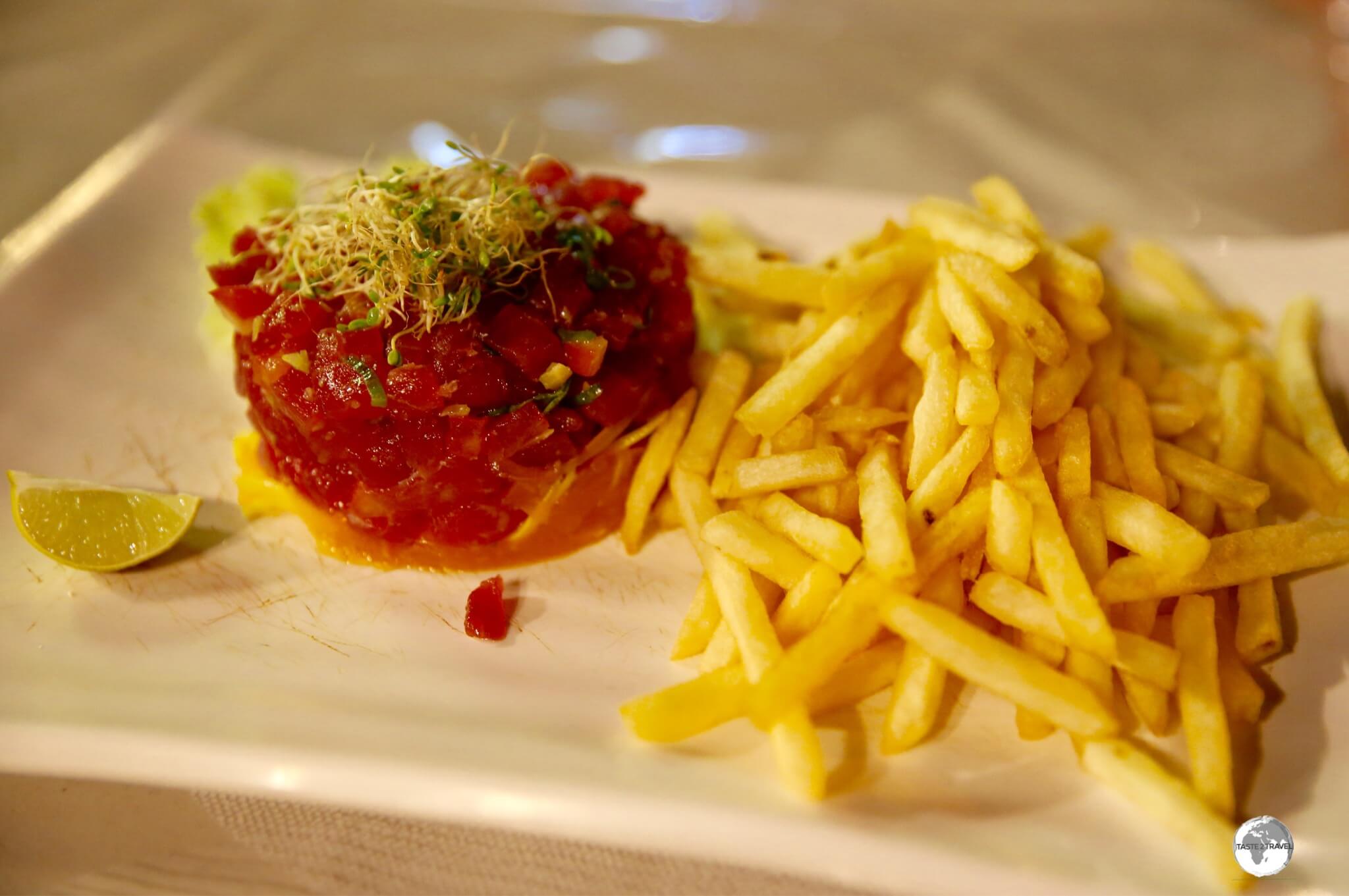
Tuna Tartare and French Fries, served up at a waterfront Roulotte in Papeete.
By far the most popular place for dinner is at Place Vaiete Roulottes, which is the public square in front of the Gare Maritime (ferry terminal).
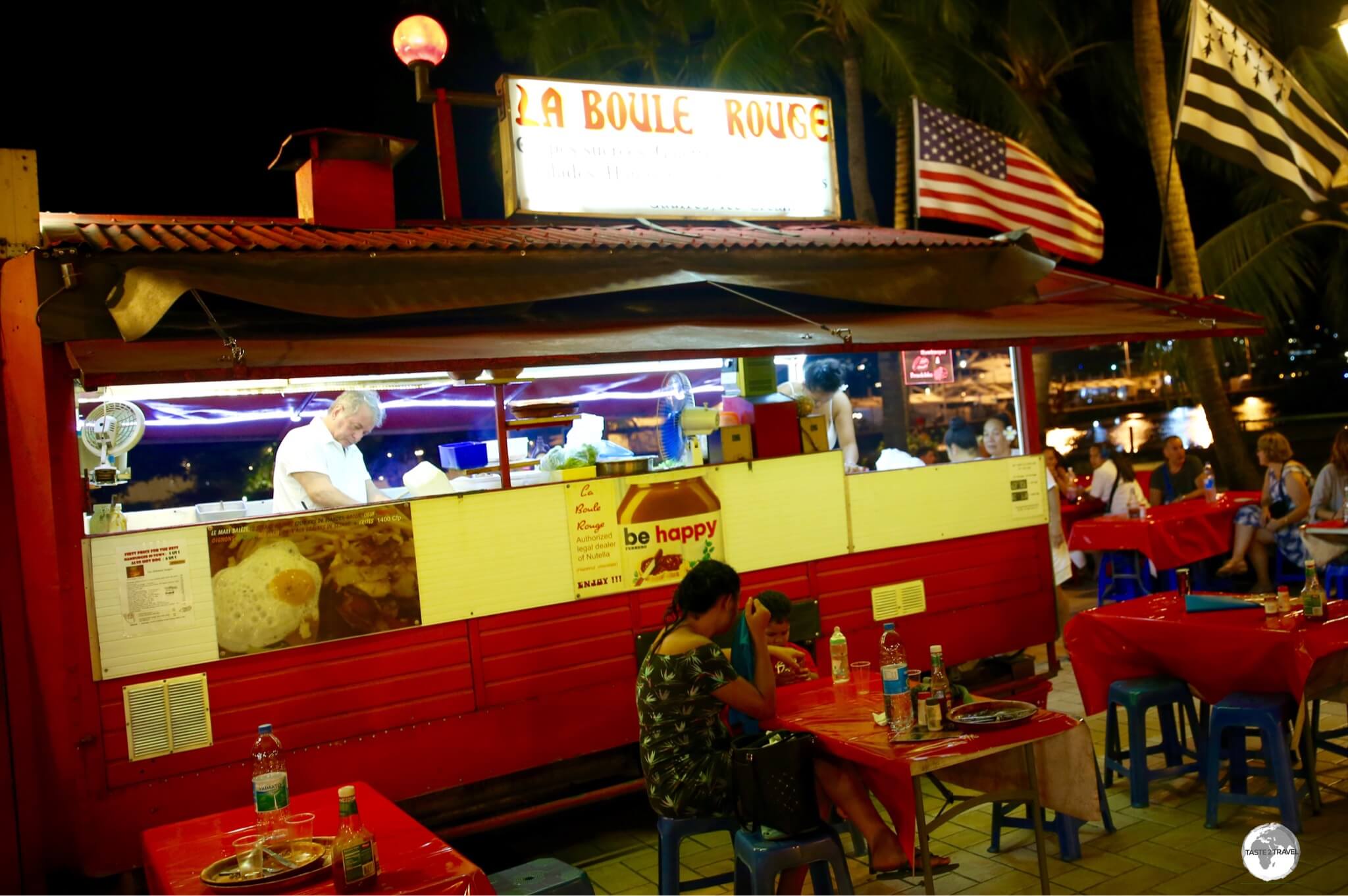
The Roulottes offer a choice of different cuisines from local, International, Chinese and Thai.
Each evening, the country’s famous roulottes (mobile food vans) set up their plastic stools and tables, fire up their BBQ and grills and serve up a veritable feast of cultural and gastronomic delights – all under the starry, night sky.
Update (July 2024):
During my recent visit to Papeete, it was disappointing to see that most of the roulottes had closed for business.
This was due to an ongoing dispute with the city council who have decided to increase the taxes on these once-successful businesses.
Hopefully this dispute will be settled at some stage and the iconic roulottes will once again return.
Hinano Beer
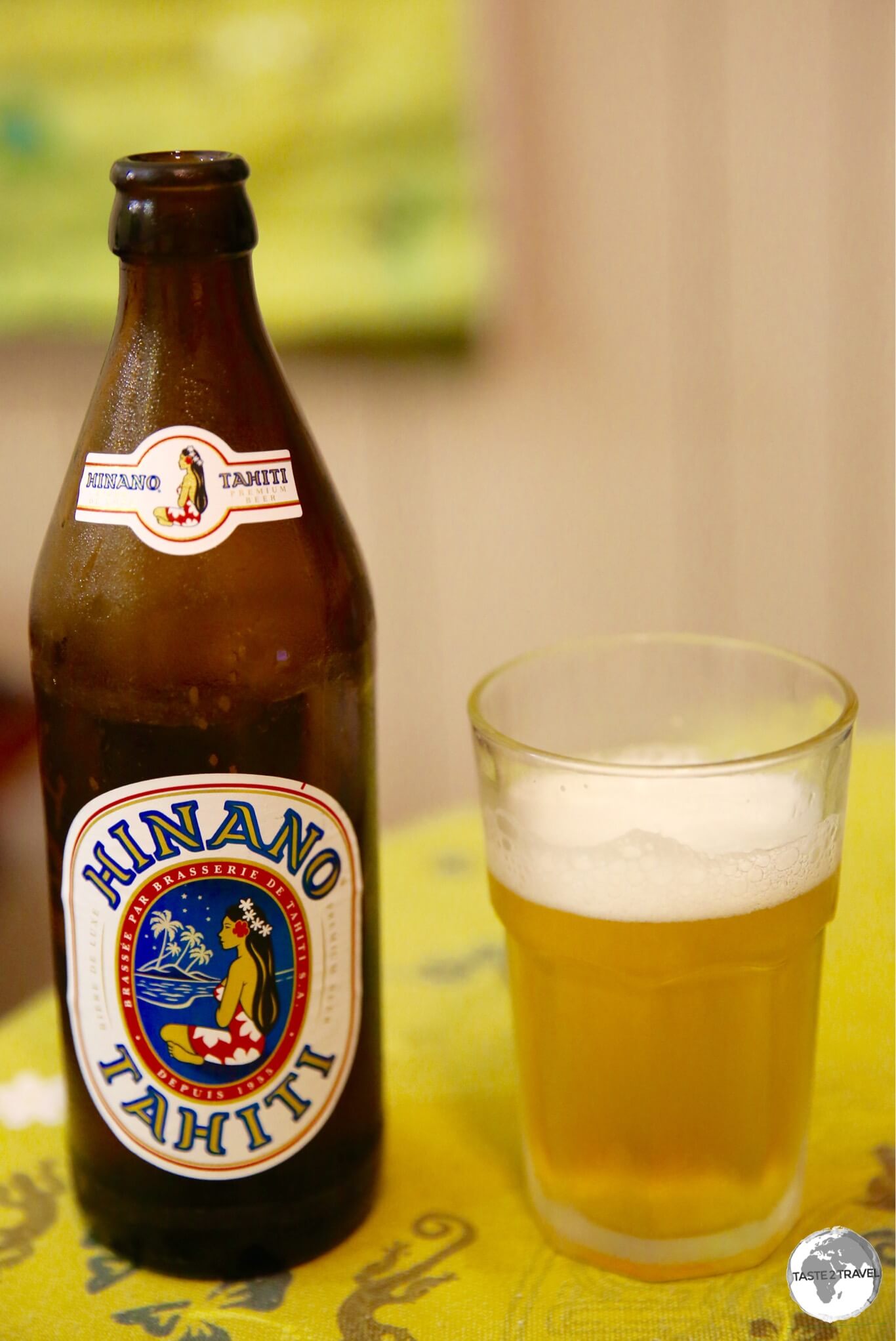
Hinano Beer has a wonderfully, light, delicate flavour.
Brewed by La Brasserie de Tahiti (owned by Heineken), the local beer is the perfect match for any meal served at the roulottes.
The beer is brewed longer than most, giving it a more delicate, distinct flavour.
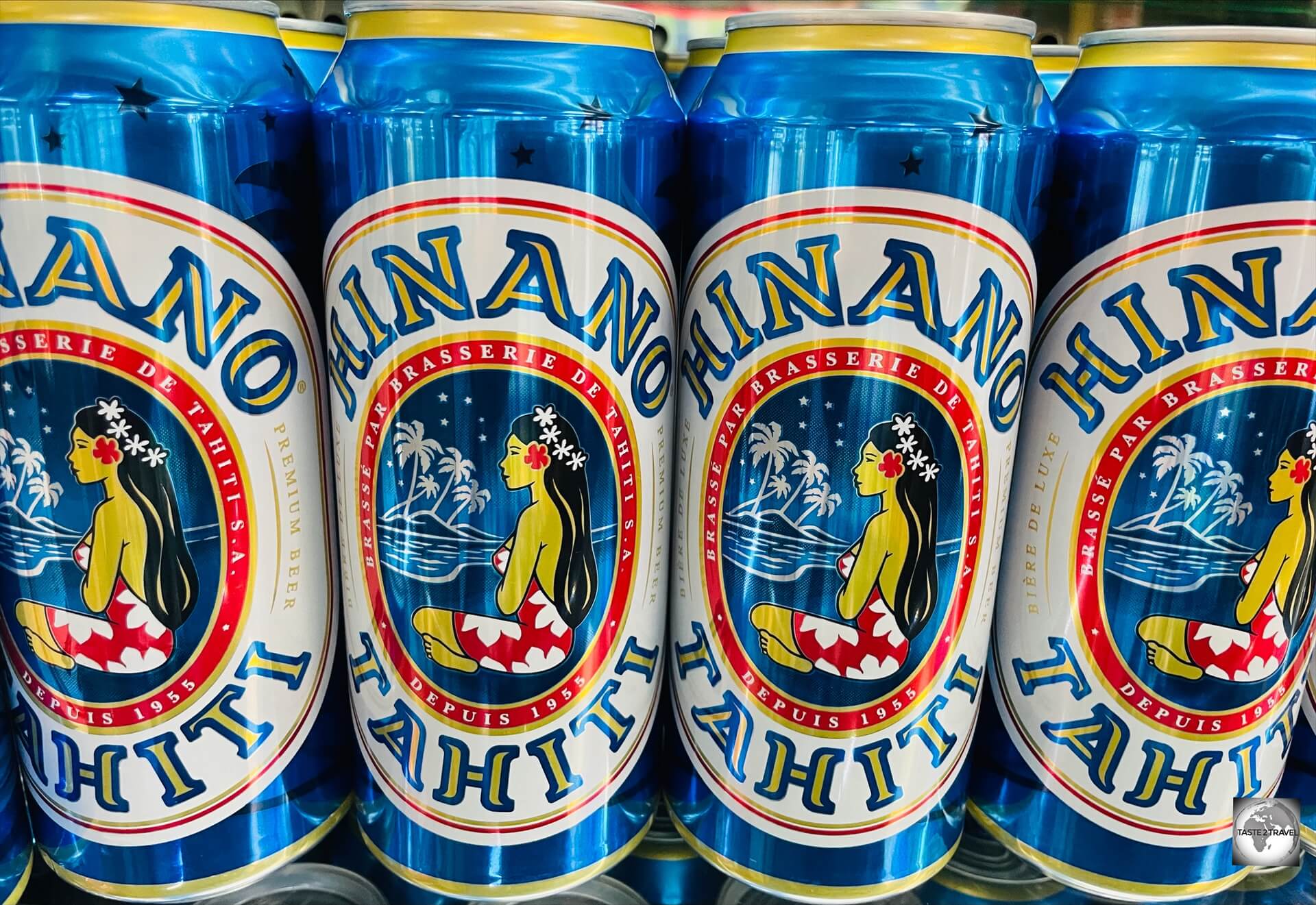
The very quaffable – Hinano Beer – the beer of Tahiti.
It is possibly my number one favourite beer in the Pacific region and certainly very quaffable.
Moorea
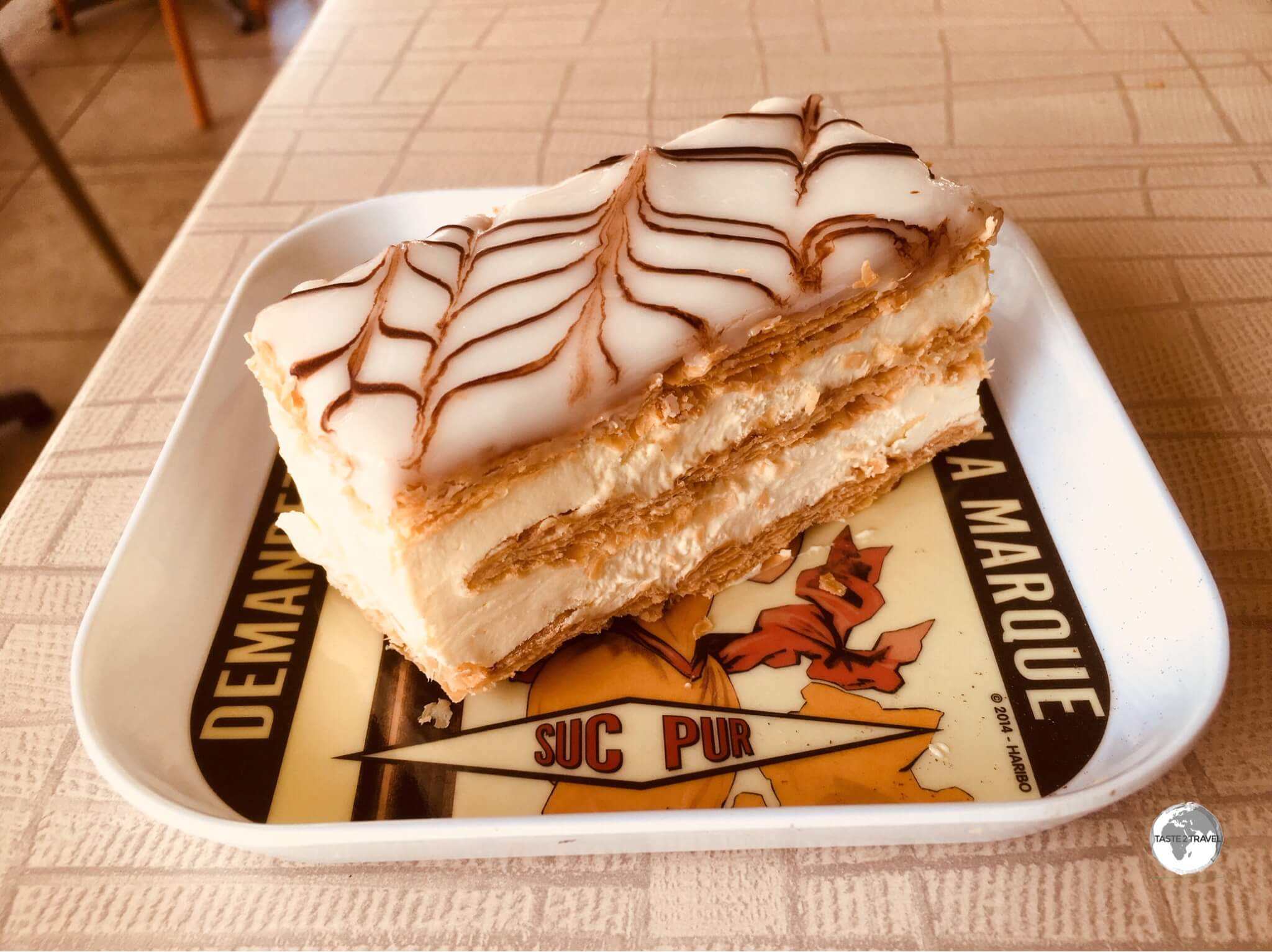
The best ‘mille-feuille’ on Moorea is served at Café Caraméline.
Where will you find the best mille–feuille on Moorea?
Café Caraméline of course!
Located in a small shopping centre in the village of Maharepa, the always busy, Caraméline is renowned for its all-day American, French or Tahitian breakfasts and lunch menu which features burgers, pizzas, salads and fresh seafood.
The fine French pastries are the speciality of the house and are the perfect accompaniment to one of their freshly brewed coffees.
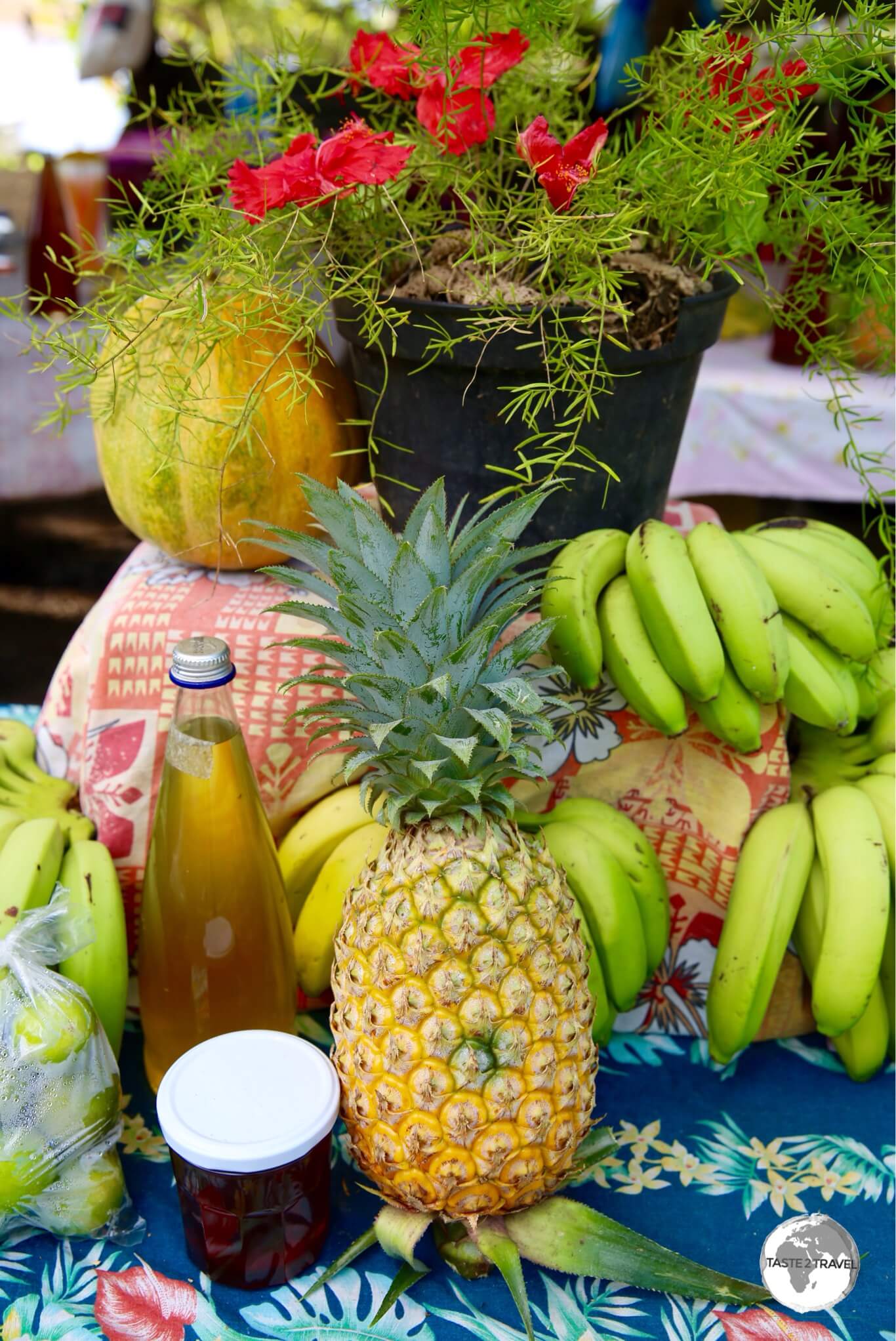
A roadside food stall on Moorea.
Mangareva
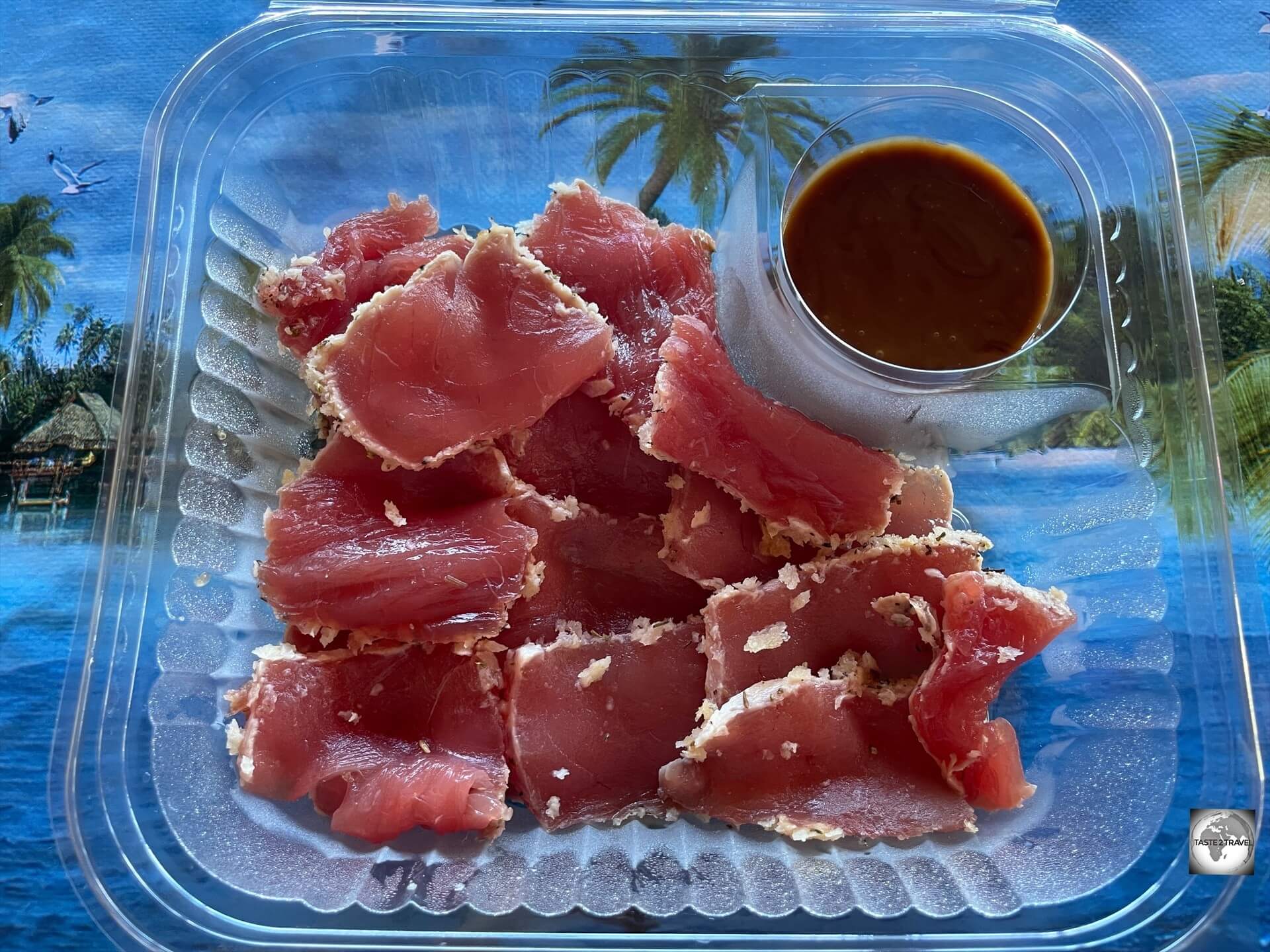
Delicious Tuna Tataki, served at the snack shop, opposite the Gendarmerie office on Mangareva.
There is no dining-out scene on tiny Mangareva!
Locals either eat at home or grab takeaway meals at one of the two snack shops.
The two snack shops, which are open until around 1 pm most days, provide breakfast and lunch and can provide a take-away evening meal if required.
Of the two snack shops, Snack Jojo is the best, offering a good selection of food and the only espresso coffee on the island.
The other snack shop is located opposite the Gendarmerie office.
Note:
There are no options for food during most evenings on Mangareva.
If you wish to eat something in the evening, you will need to buy a takeaway meal from one of the snack shops before they close at 1pm.
Pension Maro’i
The one accommodation which does provide meals on sleepy Mangareva is Pension Maro’i which is located on the other side of the island, a short drive over the hill from Rikitea.
Visa Requirements

While French Polynesia is an overseas collectivity of France, it is not part of the Schengen Area and as such applies its own visa policy (which largely mirrors the Schengen Area policy).
Generally, EU citizens are free to enter and reside indefinitely while many other passport holders are granted a 3-month stay.
To check your requirements, you should check the Visa Policies of Overseas France.
Immigration
Immigration in the French territories is the breeziest of anywhere in the Pacific. No questions asked, no need to show a return ticket, nothing! Most visitors are processed in a matter of seconds – the way travel should be!
Getting There
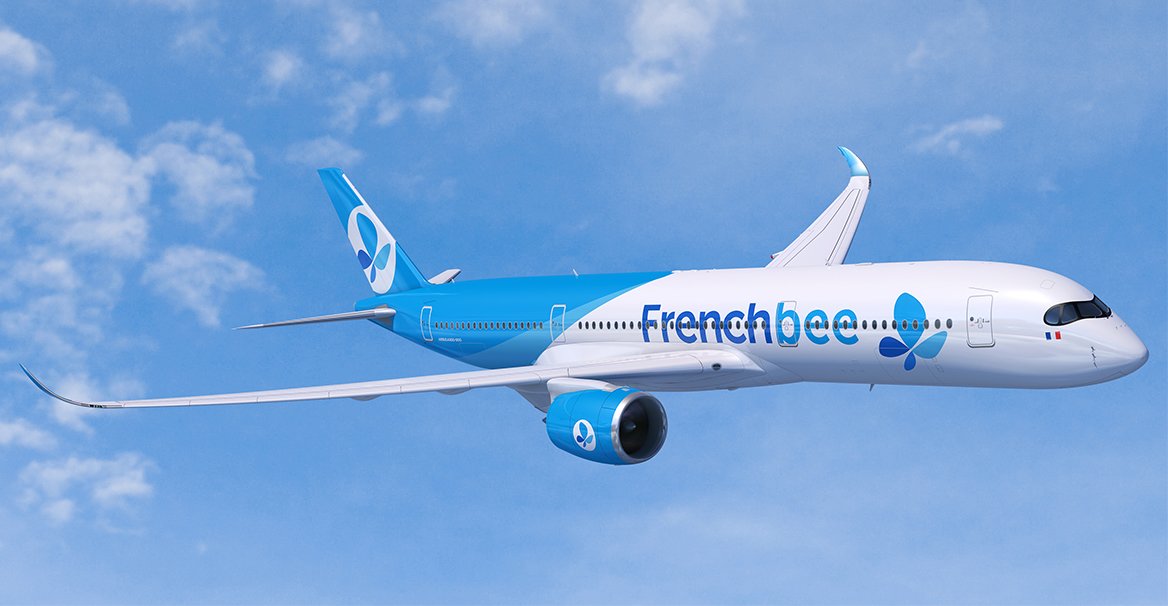
French Bee have finally made flights to French Polynesia affordable.
Air
International flights to French Polynesia arrive at Faa’a International Airport (IATA: PPT), which is located in the municipality of Faa’a, 5 km (3.1 miles) southwest of the capital, Papeete.
The airport serves as the base for the domestic carrier, Air Tahiti, and the international carrier, Air Tahiti Nui.
Flights to French Polynesia are never cheap but, thanks to the recent introduction of thrice weekly (Sunday, Wednesday and Friday) flights from Paris (Orly) to Papeete via San Francisco by the excellent French low-cost carrier, French Bee, reaching paradise is now much more affordable.
Important Note:
French Bee flights from Paris to Papeete make a short transit stop in San Francisco.
Although transit passengers do not alight the aircraft, all passengers are required to have valid entry documents for the United States.
This exceptional requirement by the US government is due to the fact that airports in the United States do not have ‘sterile’ transit areas.
If you do not hold a valid ESTA or a valid US Visa, you will be denied boarding in Paris.
One-way fares from San Francisco start at US$375, which has forced other airlines flying from San Francisco and Los Angeles to drastically reduce their tickets prices in order to compete – a boon for travelers.
Despite being a low-cost carrier, French Bee are a slick operation which feels more like a full-service carrier, providing a comfortable seat on a brand-new Airbus A-350 with excellent service, tasty meals and a professional crew.
The following airlines provide connections to/ from Papeete:
- Air France – flies to/ from Los Angeles, Paris–Charles de Gaulle
- Air New Zealand – flies to/ from Auckland
- Air Tahiti Nui – flies to/ from Auckland, Los Angeles, Paris–Charles de Gaulle, Tokyo–Narita
- Aircalin – flies to/ from Nouméa
- French Bee – flies to/ from Paris–Orly, San Francisco
- Hawaiian Airlines – flies to/ from Honolulu
- LATAM Chile – flies to/ from Easter Island, Santiago de Chile
Airport Transport
Taxis to downtown Papeete cost approximately 1,900 CFP (USD$19) while bus #3 and #7 pass by the airport, stopping at the stop on the main road, before continuing to Papeete.
Onward Air Travel
New Caledonia
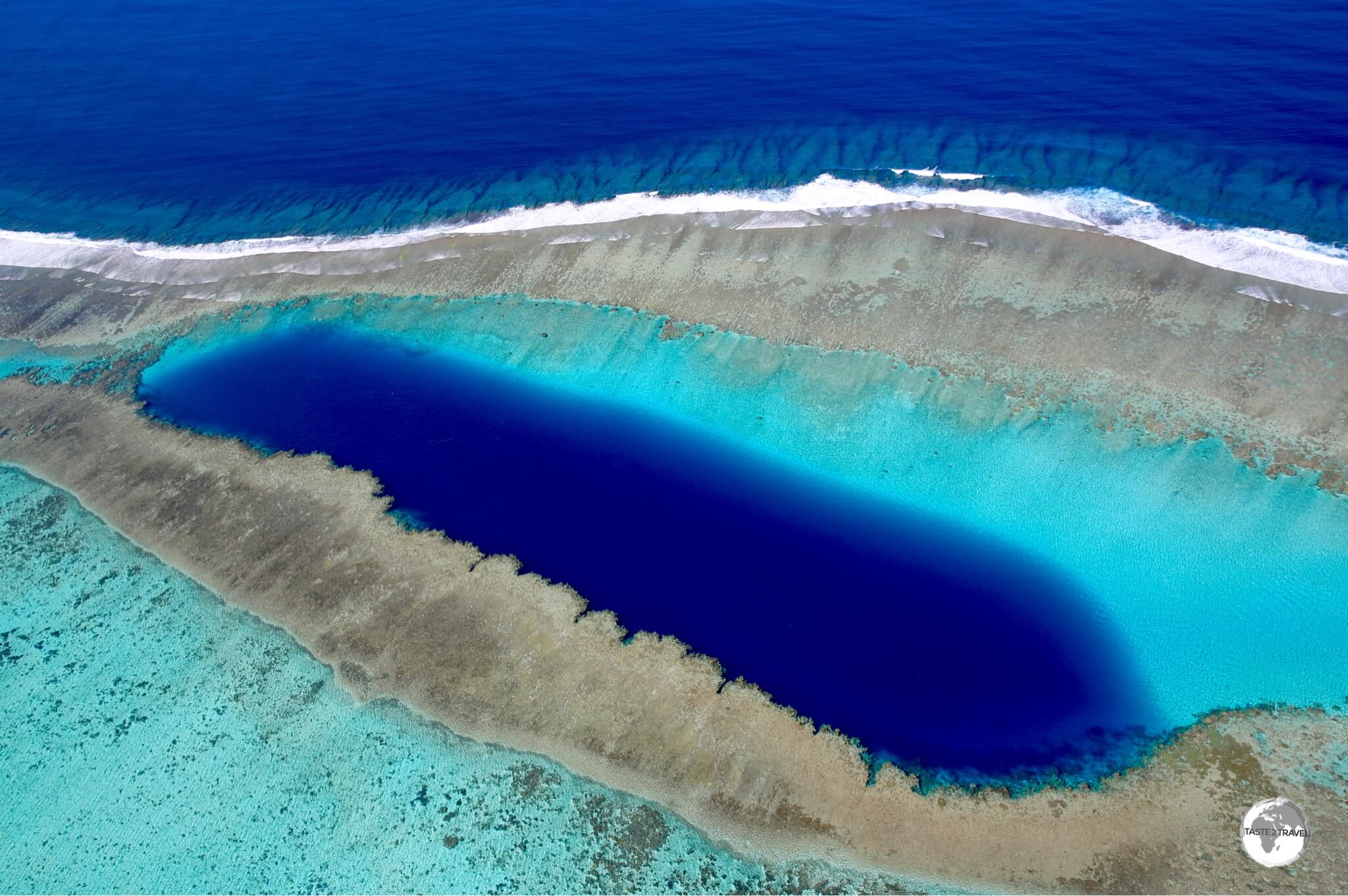
The Blue Hole of Voh, a highlight of New Caledonia.
The national carrier of New Caledonia, Aircalin, connects Papeete with Noumea every Friday and Monday, providing a useful (and sometimes affordable) connection between two far-flung French Pacific territories.
I paid just €350 for a one-way ticket between the two territories, a flight of 4,717 km (2,931 mi).
You can read more about this other Pacific French territory in my New Caledonia Travel Guide.
Sea
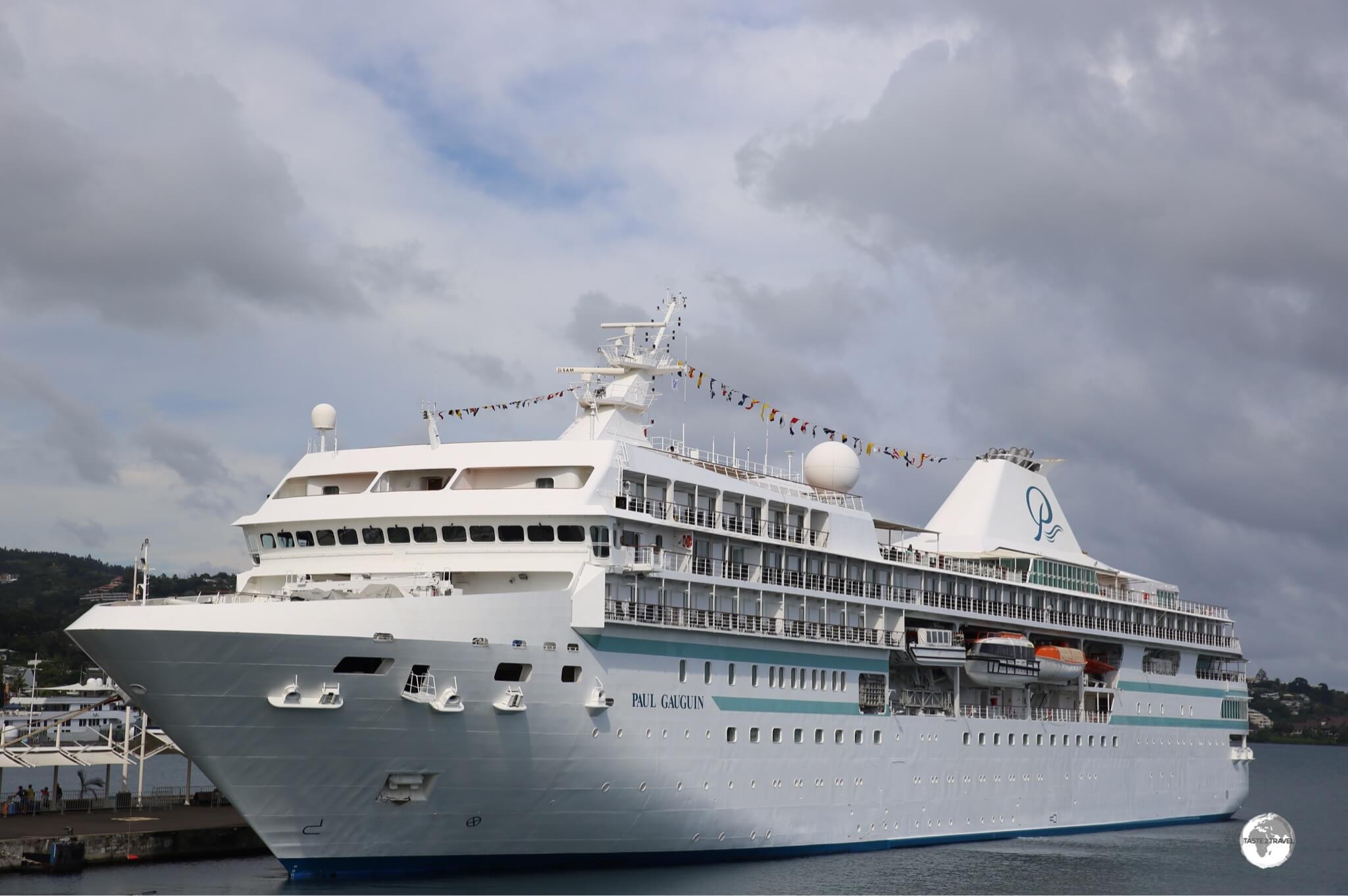
The ‘Paul Gauguin’ cruise ship in Papeete harbour.
Tahiti and Moorea are popular ports of call for visiting Cruise ships with ships visiting the islands several times a month.
You can view the current schedule here.
Getting Around
Air
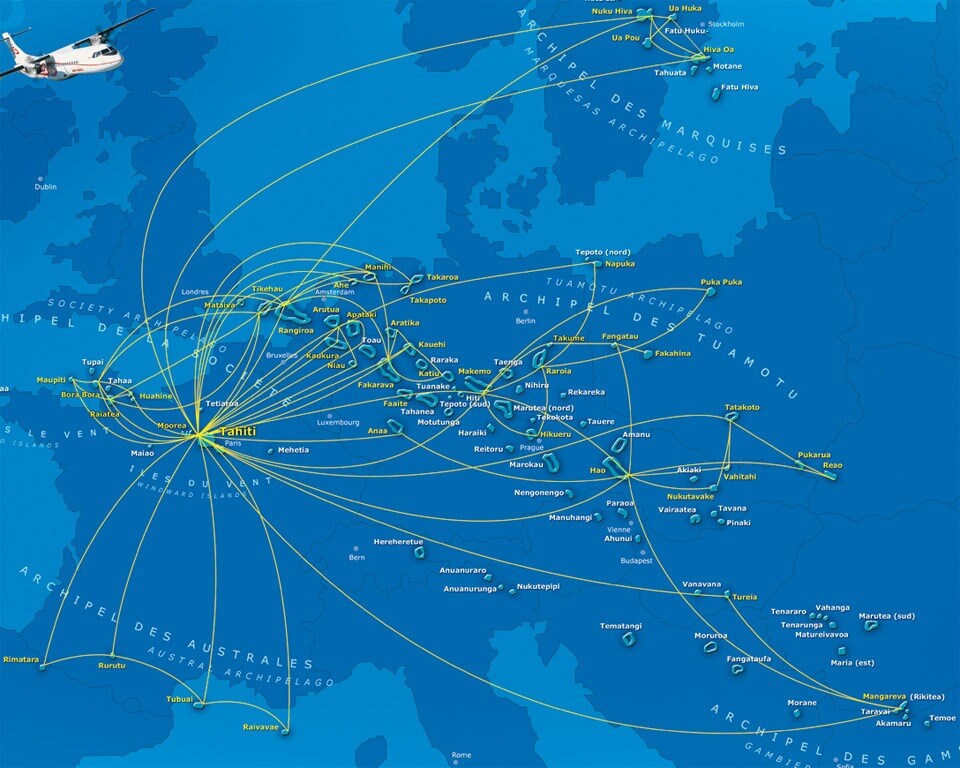
The Air Tahiti Route Map, superimposed on a map of Europe, illustrates the vastness of the territory.
Tahiti
French Polynesia covers a vast area of the Pacific – 4,167 sq km (1,609 sq mi) to be exact.
Domestic flights throughout this sprawling territory are operated by Air Tahiti, who operate from their base at Faa’a International Airport in Papeete.
The route map of Air Tahiti (shown above) is super-imposed on a map of Europe to show the vast extent of the territory.
Due to it being a monopoly operator, airfares on Air Tahiti are never cheap.
Air Tahiti offers services from Faa’a International airport to:
- Ahe
- Anaa
- Arutua
- Atuona
- Bora Bora
- Fakarava
- Hao
- Huahine–Fare
- Kaukura
- Makemo
- Manihi
- Mataiva
- Maupiti
- Moorea
- Niau
- Nuku Hiva
- Papeete (hub)
- Raiatea
- Raivavae
- Rangiroa
- Rarotonga (Cook Islands)
- Rimatara
- Rurutu
- Takaroa
- Tatakoto
- Tikehau
- Totegegie (Mangareva)
- Tubuai–Mataura
Mangareva
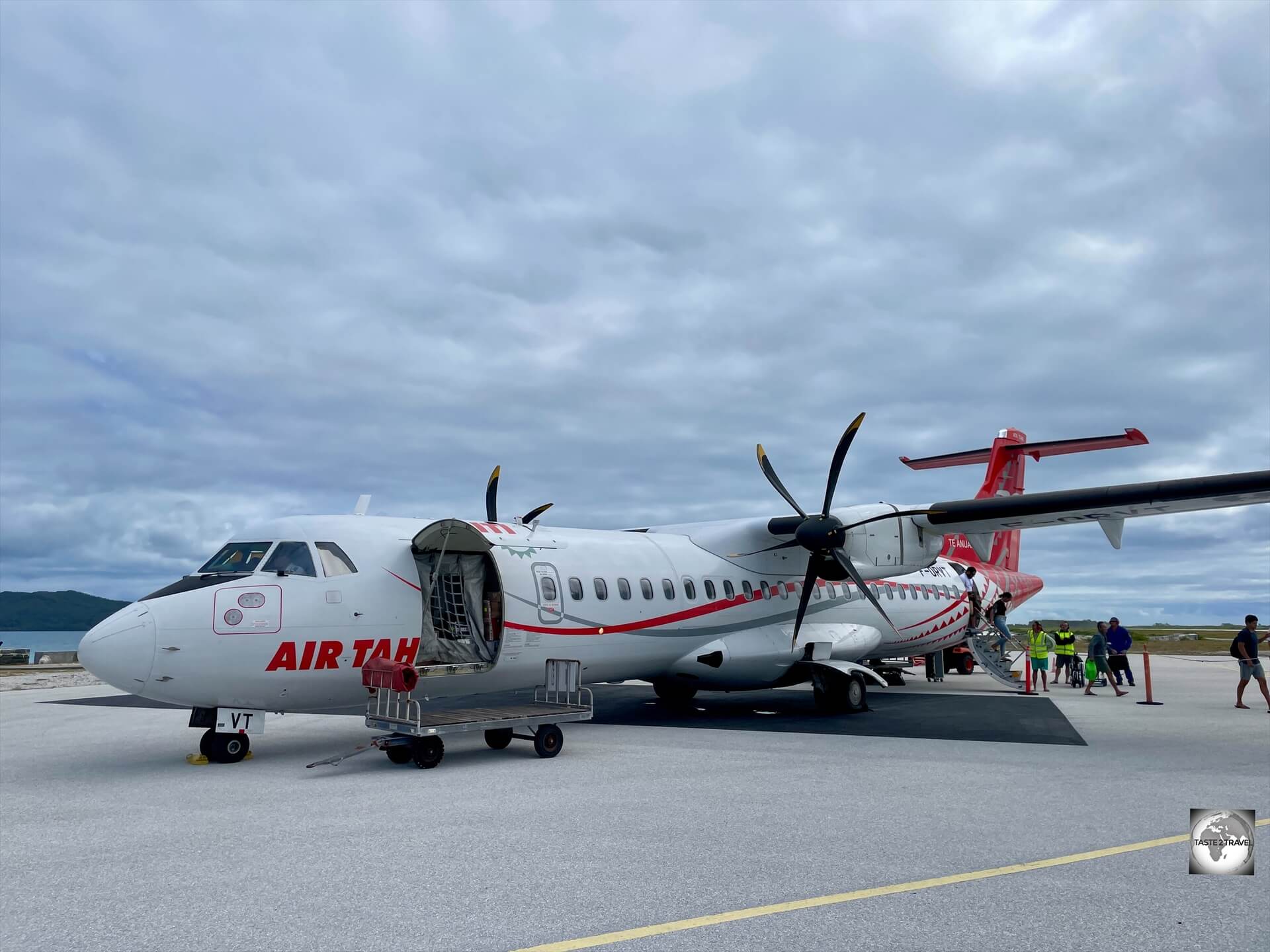
My Air Tahiti flight at Mangareva.
Air Tahiti connect Mangareva to Papeete twice a week – on Tuesdays and Saturdays.
Flights land at Totegegie Airport (IATA: GMR) which is an uninhabited coral atoll, 9 km across the lagoon from Mangareva.
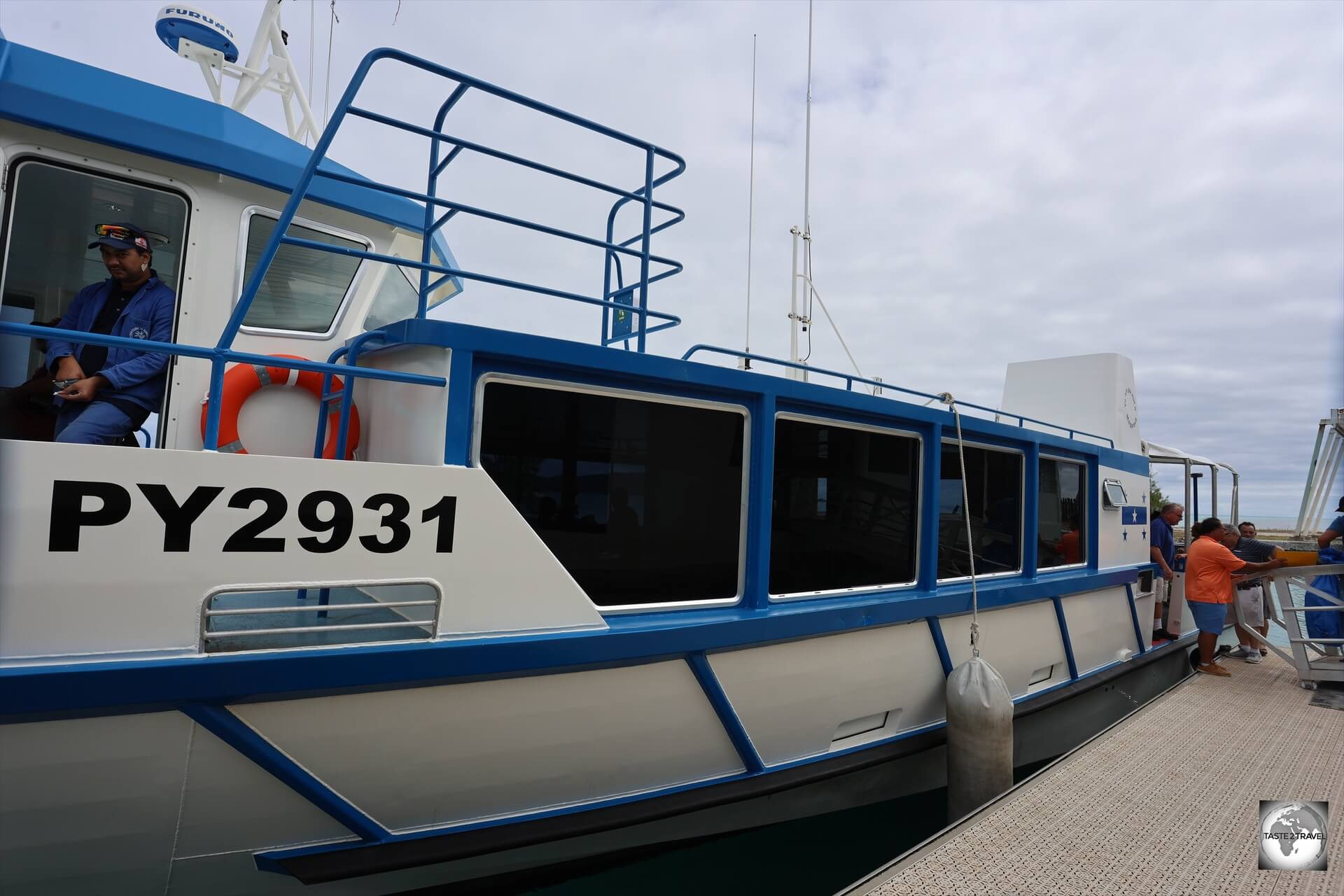
The municipal ferry which connects airport to Mangareva.
A municipal ferry, which meets all flights, provides the only transport service between the airport and Mangareva, with a ticket costing 1,000 CFP.
The ferry journey time to Mangareva is 40 minutes.
Pitcairn Island
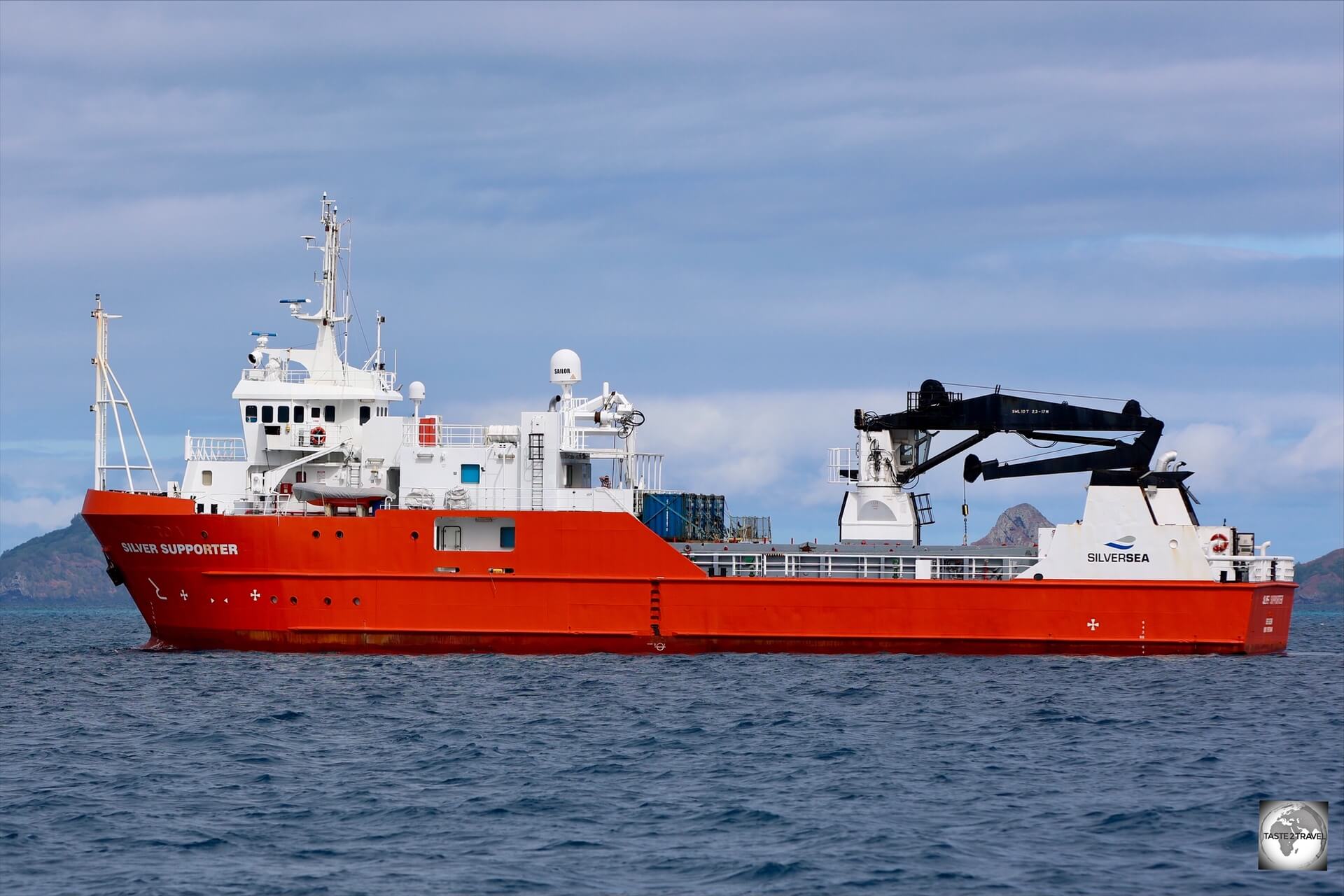
The MV Silver Supporter is a dedicated passenger and cargo supply ship chartered by the Pitcairn Island government.
Mangareva is an important travel link to Pitcairn Island and many visitors to this remote corner to French Polynesia are heading to the even remoter Pitcairn Island.
Pitcairn Island lies 540 km (335 mi) south-east of Mangareva, a sea voyage of 35-hours on board the MV Silver Supporter, the supply ship for Pitcairn Island.
The supply ship operates its schedule to coincide with the Air Tahiti Tuesday flight from Papeete.
The ship departs Mangareva each Tuesday afternoon, and returns the following Monday evening so that passengers can board the Tuesday flight back to Papeete.
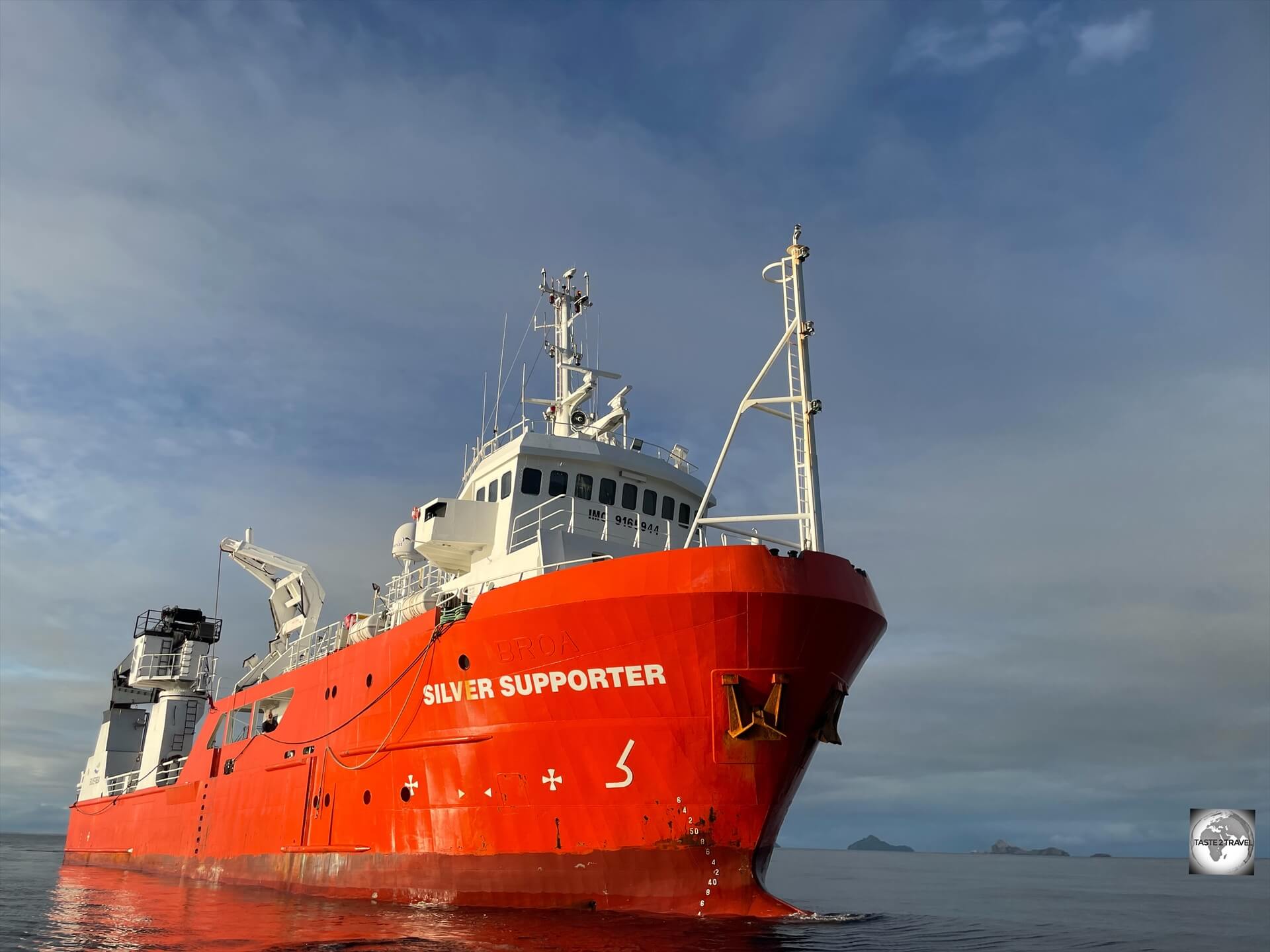
The MV Silver Supporter is the dedicated supply and passenger ship for Pitcairn Islands.
There is a one-hour time difference between the Gambier Islands (UTC-9) and Pitcairn Island (UTC -8).
For those boarding the MV Silver Supporter, the crew will be waiting for you at the dock in Rikitea when you alight from the ferry.
You must first visit the Gendarmerie office in Rikitea where you’ll receive a French Polynesia exit stamp in your passport.
The Gendarmerie office is a 200-metre walk along the main road (turn left) when you exit the port.
Like everything in the French world, the office is closed for lunch from 12 noon until 2 pm.
Once all passports have been processed, all passengers will be transferred to the MV Silver Supporter, which is always moored offshore in the lagoon.
Upon arrival back at Mangareva, all passengers must again attend the Gendarmerie office to receive an entry stamp back into French Polynesia.

You can read all about Pitcairn Island in my Pitcairn Islands Travel Guide.
Public Transport
Public buses provide services from Papeete to points around the main island with bus #3 and #7 passing the airport.
Taxi
Tahiti
There’s no shortage of taxis in and around Papeete during business hours, but after-hours it’s best to book a taxi through your hotel. Meters are unheard of, so it’s best to confirm the fare (in French, if possible) before getting into a taxi. Current taxi tariffs are published here.
Papeete is very small and easily covered on foot so there’s no need to take a taxi anywhere downtown, however to the airport, the fare is about 1,900 CFP (USD$19).
Moorea
There are very few taxi services on Moorea. One operator who has a published schedule of fares is Jo Faua of Moorea Jo Tours.
Mangareva
There are no taxis on Mangareva but guest houses will collect visitors from the port.
Rental Car
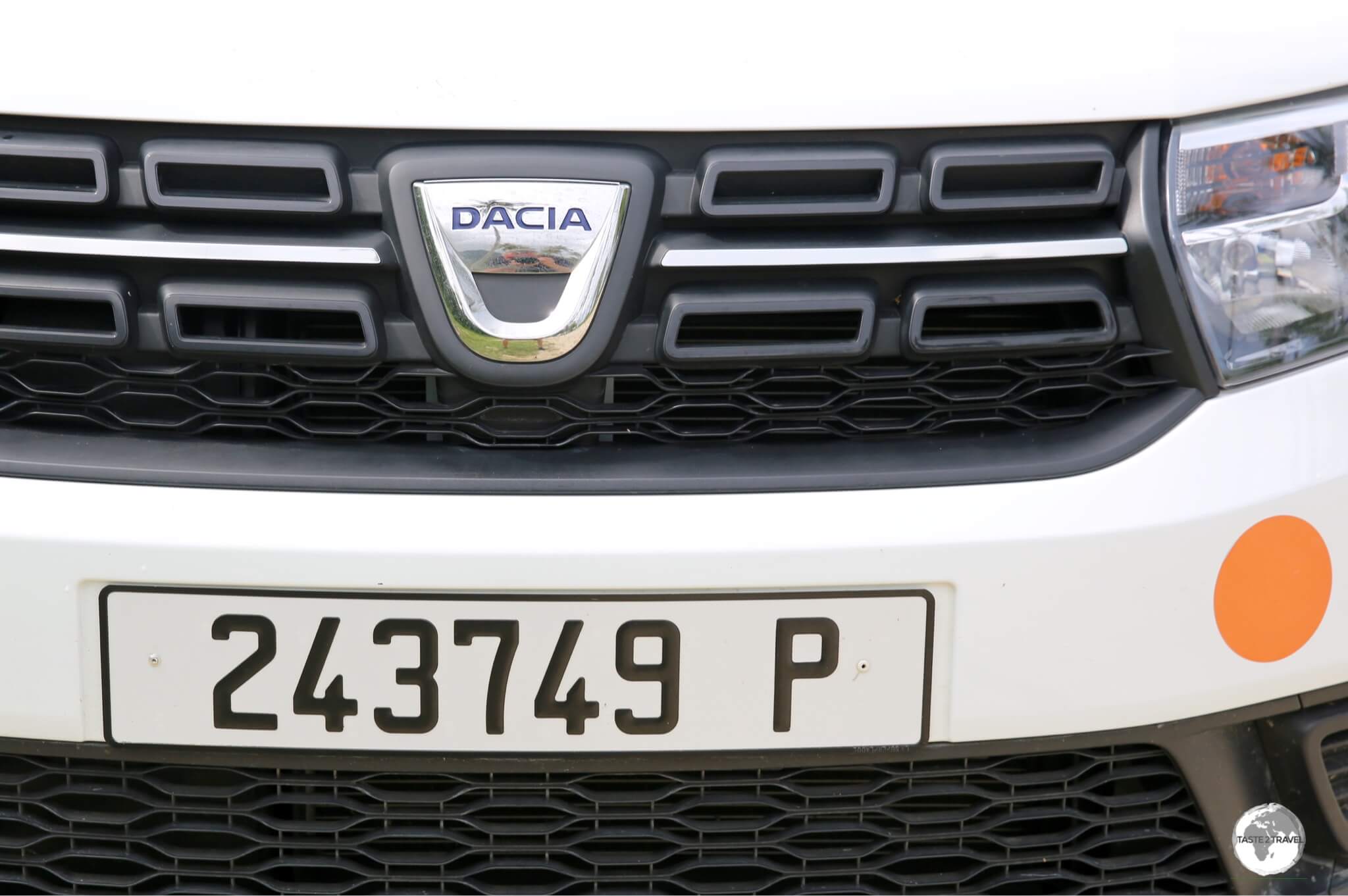
License plate from my rental car on Moorea.
Tahiti
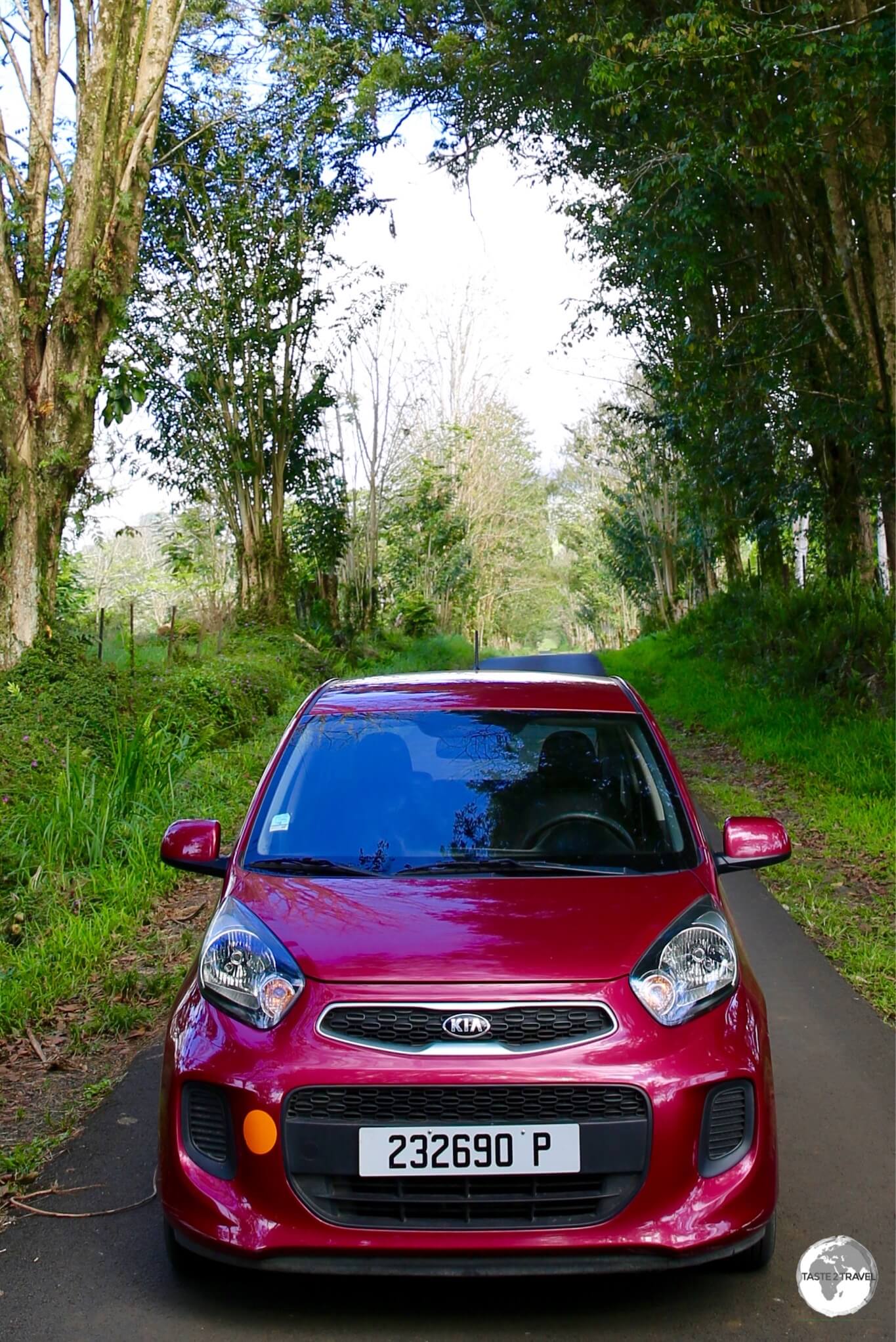
My rental car on Tahiti.
Cars on the main island can be rented from downtown offices in Papeete or from the airport. I comfortably circumnavigated the main island in 2 days (stopping at all sights) using a rental car.
Note: When renting in French Polynesia, you should check the fine print as some companies (Hertz) have very low daily kilometre limits with a high charge for excess kilometres. I booked a car through Rentalcars.com and was informed upon collecting the car that I had a limit of 45 km per day. I changed this to ‘Unlimited kilometres’ which tripled the cost of the rental! Ouch!
The following rental agents maintain and office at Faa’a International Airport:
- Avis (Tel: +689 40 85 02 04)
- Europcar (Tel: +689 86 61 96 )
- Hertz (Tel: +689 82 55 86)
- Tahiti Easy Car (Tel: +689 86 96 32)
Moorea
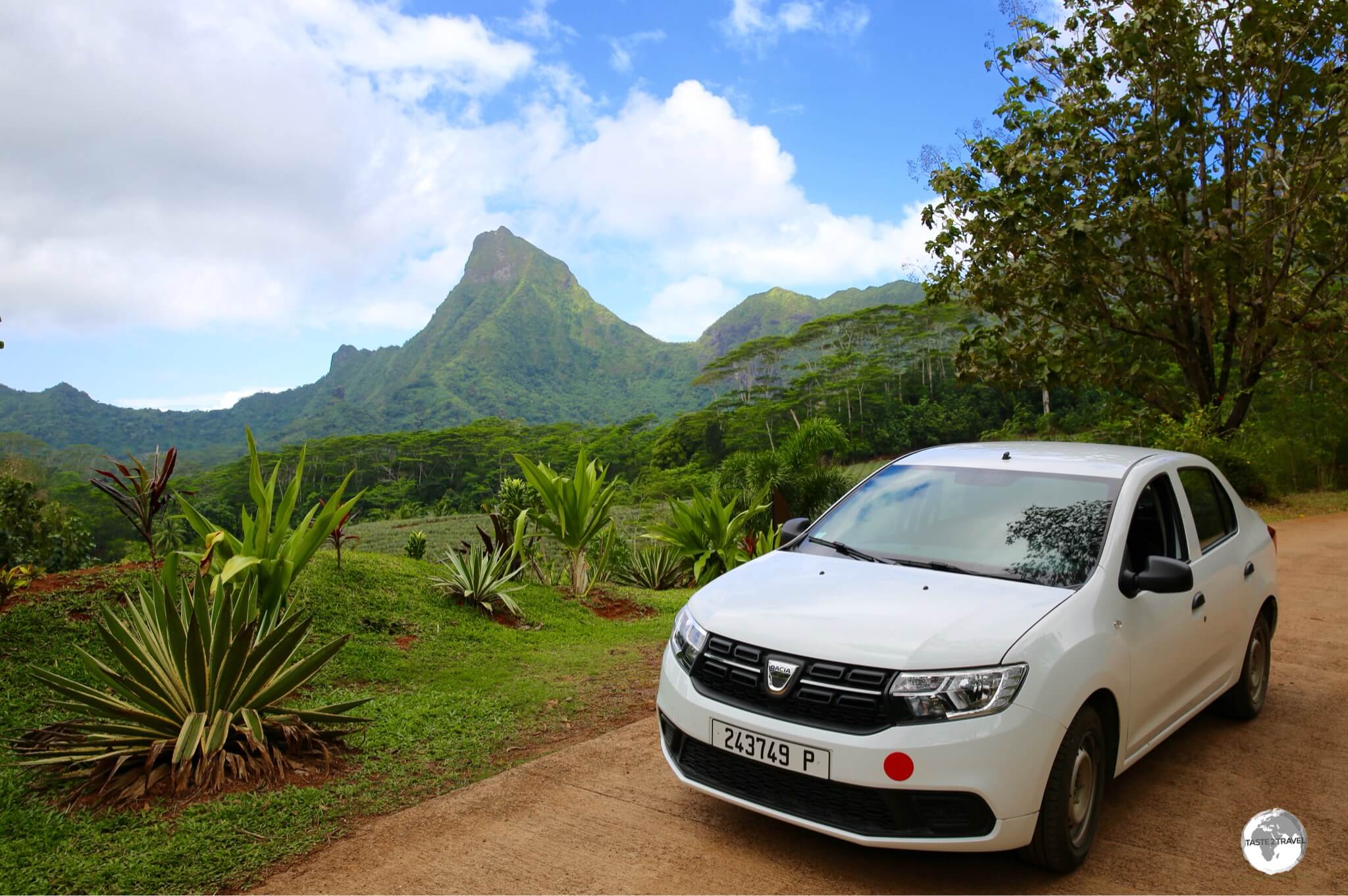
Exploring the beautiful landscapes of Moorea in my rental car.
There are very few rental car agents on Moorea and, as can be expected in such a closed market, rates are not cheap with an economy-size car costing from 10,900 CFP (USD$100) per day.
Both Avis and Europcar have branches conveniently located opposite the wharf in Vai’are but vehicles are limited so best to book in advance. Avis also have branches at Moorea airport and the Intercontinental resort which have limited operating hours.
On the northwest coast, a few companies rent out roadsters with a 4-hour rental from Moorea Fun Roadsters costing an eye-watering 15,000 CFP (US$150).
Mangareva
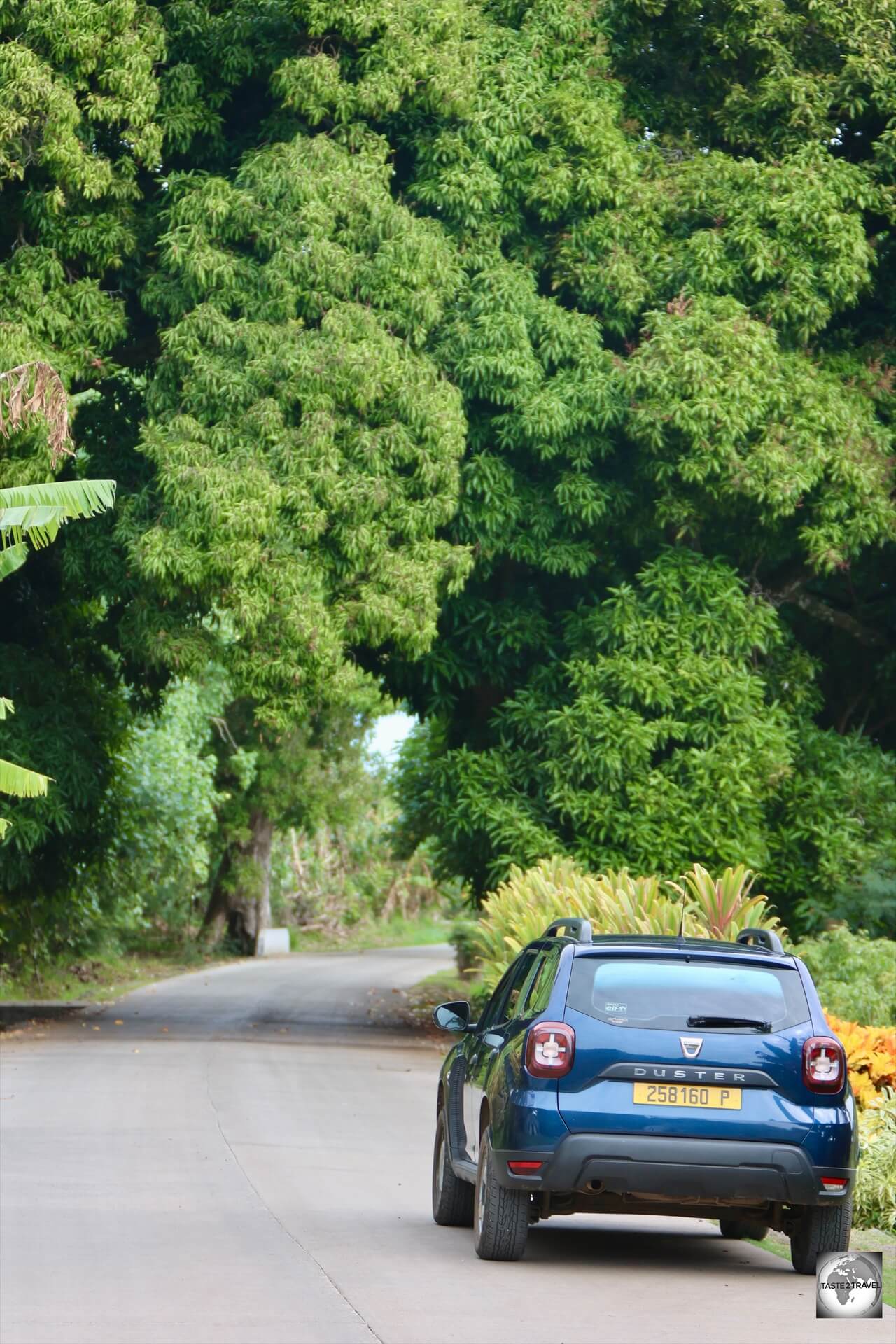
Exploring Mangareva in my rental car which i hired from my guest house.
The road around Mangareva runs along most of the coast, covering a distance of 28 kilometres (17 mi).
Most of the road is concrete, with a few unsealed, but completely passable, sections at the far eastern end of the island.
Rental cars can be hired through some of the guest houses on Mangareva for €50 per day, which includes the small amount of fuel which is needed to circumnavigate the island.

A one day rental is more than enough time to explore tiny Mangareva.
I rented my Dacia Duster rental car through my guest house.
A one-day rental is more than enough time to cover the sights on the island.
Ferry

The Aremiti car ferry at the ‘Gare Maritime’ in Papeete.
Papeete to Moorea
The Aremiti ferry company has regular sailings from the ‘Gare Maritime‘ (ferry terminal) in Papeete to Moorea (1,500 CFP one way), a distance of 17 km with a crossing time of 40 minutes.
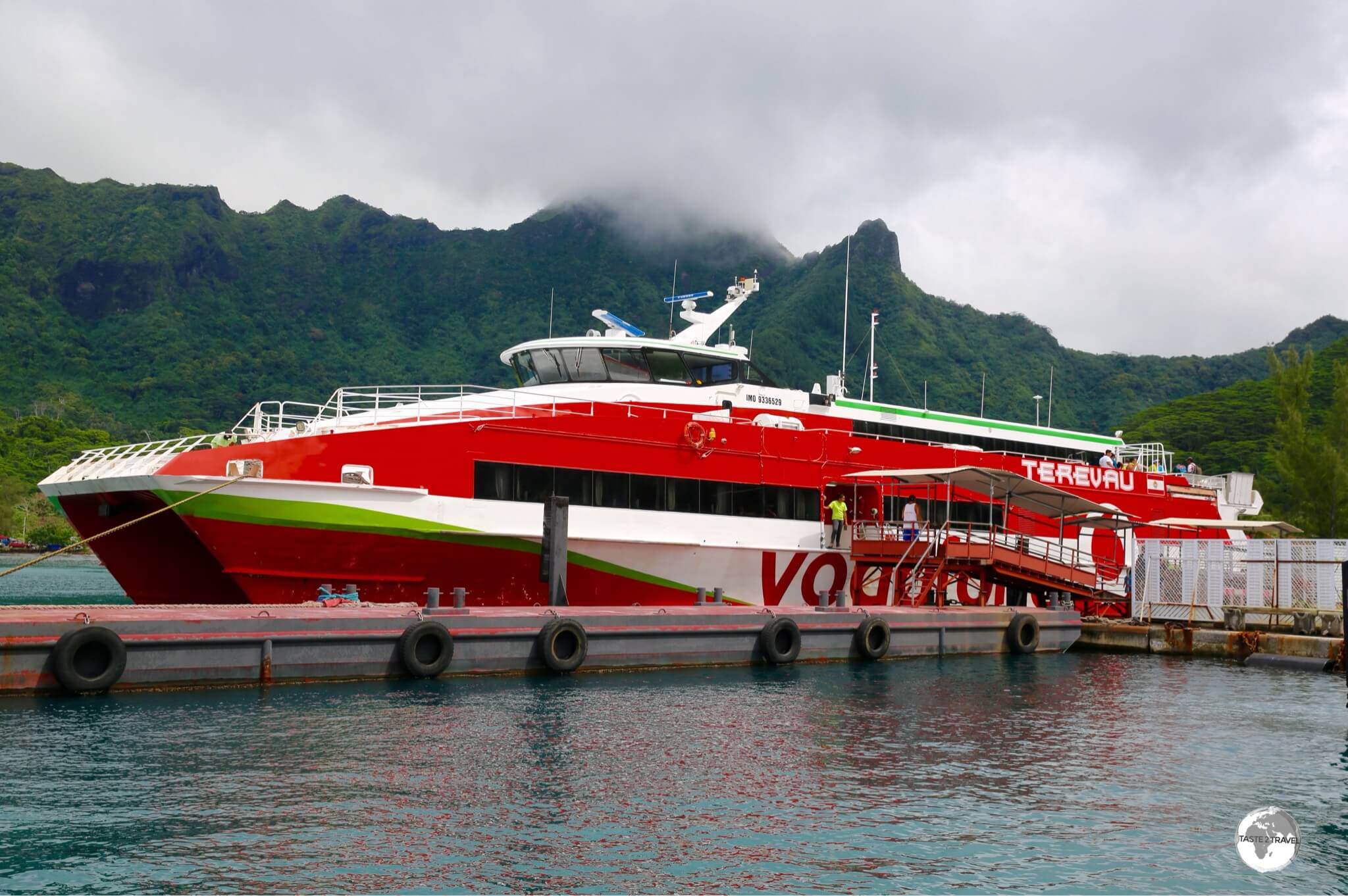
Ferry boat ready to depart Moorea.
You can book tickets online and view the current sailing schedule here.
That’s the end of my French Polynesia Travel Guide.
Please feel free to leave a comment using the form below.
Safe Travels!
Darren
Follow me on Instagram:
[instagram-feed feed=1]
Further Reading
Other travel reports from the Pacific region:
French Polynesia Travel Guide French Polynesia Travel Guide French Polynesia Travel Guide French Polynesia Travel Guide French Polynesia Travel Guide French Polynesia Travel Guide French Polynesia Travel Guide French Polynesia Travel Guide French Polynesia Travel Guide French Polynesia Travel Guide French Polynesia Travel Guide French Polynesia Travel Guide French Polynesia Travel Guide
Author: Darren McLean
Darren McLean is an Australian, full-time, digital nomad who has spent 37 years on a slow meander around the globe, visiting all seven continents, 192/ 193 UN countries and 245/ 251 UN+ countries and territories.
He founded taste2travel to pique one’s curiosity and inspire wanderlust.



